
Home » Travel Guides » Germany » 15 Best Things to Do in Nuremberg (Germany)

15 Best Things to Do in Nuremberg (Germany)
The capital of Franconia is a city that has lived through momentous world events, from the time of the Holy Roman Empire to the 20th century. The Altstadt (Old Town) is still encircled by walls, and is watched by the Kasierburg castle from a promontory on the north side.
Nuremberg was an unofficial capital of the Holy Roman Empire, and the castle was paid host to official ceremonies for hundreds of years. Nuremberg is also a name associated with the Nazis, for the Nuremberg Rallies, racist Laws and Trials after the war. At the Nazi congress hall on the rally grounds is a powerful museum about Nazi regime, and Courtroom 600 at the Palace of Justice is where figures like Hermann Göring were tried.
Let’s explore the best things to do in Nuremberg :
1. Kaiserburg
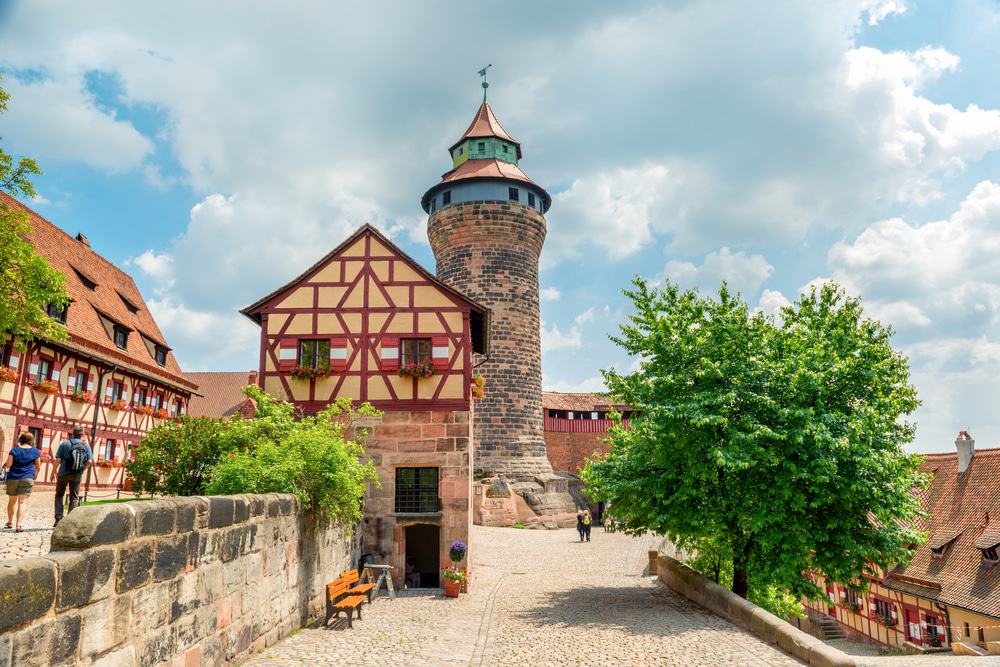
On the steep sandstone cliffs over the north side of Nuremberg’s Altstadt is a castle that carried real power in the times of the Holy Roman Empire.
The imperial courts met here, and every newly elected emperor was obligated by decree to hold his first Imperial Diet at Kaiserburg.
The castle keep at the circular Sinwell Tower dates to the 14th century and is always a highlight.
There’s an observation platform at the top floor where you can marvel at the best panorama of the city.
Sheltered in half-timbered houses in the courtyard below is the Tiefer Brunnen (Deep Well), which bores 50 metres into the sandstone.
The Palas, which was used for the castle’s official functions, has been reworked several times since the Middle Ages and has a museum filling you in on Kaiserburg’s elevated position in the Holy Roman Empire.
2. Documentation Center Nazi Party Rally Grounds

Nuremburg was important to the National Socialist regime because of its status in the Holy Roman Empire, and its central location in the German-speaking world.
Even before they rose to power in 1933 they had chosen Nuremberg for their annual mass propaganda rallies.
During the 30s they went about building a congress hall, one element of an unrealised master plan for the city.
That hall, which is pierced on the north side by a modern metal-framed glass stake, contains the exhibition, “Fascination and Terror”. You’ll be walked through the causes, reality and aftermath of the Nazi regime.
There’s extra depth on the Nuremberg Rallies, and the architectural plans for the city.
Context is provided by eyewitness interviews, photographs, official documents and computer graphics.
3. Nuremberg Trials Memorial

Courtroom 600 at the Justizpalast, where high-ranking Nazis were brought to justice between 1945 and 1949, is a still a working courtroom.
It can be tricky to visit during the week unless you come between sessions.
The best time of all is Saturdays, out of session, when English speakers can take a sobering audio tour of a room that resonates with history.
The top floor of the courthouse has been turned into a museum about the Nuremberg Trials, explaining the defendants and their crimes, and recording the lasting impact that the process had on international criminal law.
4. Germanisches Nationalmuseum

The Germanic National Museum is a sort of treasury for the German speaking world, mapping its cultural past with over 25,000 exhibits.
The galleries are in a complex partly made up of the Nuremberg Charterhouse, and are endowed with art going back to the medieval period, as well as decorative items, toys, armour, books, scientific instruments, clothing, musical instruments, liturgical treasures, prehistoric and ancient archaeology, toys, and that’s only a brief summary.
Fair to say that you’re going to need to plan ahead if you want to do this museum in a few hours or even a day.
Some art exhibits you can’t leave without seeing are Albrecht Dürer’s portrait of his mother, Dürer’s rhinoceros, Lucas Cranach the Elder’s portrait of Martin Luther and Rembrandt’s famed Wide-Eyed Self-Portrait.
5. St. Sebaldus Church

Looking at it from the north side you can tell how St. Sebaldus Church is in two halves.
The west side, including the naves and towers is Romanesque and early Gothic, from the 13th century.
The east side made up of the hall chancel is Late Gothic and was built around 100 years later.
The 8th-century Saint Sebald is Nuremburg’s patron saint, and in the chancel you can view his tomb, designed in the 1510s by Peter Vischer the Elder, with Early-Renaissance bronze figurines depicting scenes from his life.
That is one of many works of art in the church, like the Tucher family epitaph, stained glass windows and wood sculpture by the Renaissance virtuoso Veit Stoss.
6. St. Lorenz Church

Like St. Sebaldus, this church, which was started in the 13th century was later given a hall chancel.
That eastern section went up during the 15th century and is in the German Late Gothic style known as “Sondergotik”. St Lorenz Church was one of the first to become Lutheran, converting in 1525. But fortunately for us, it escaped the iconoclasm of the time, most likely because its wealthy patrons helped look after that art as it had been funded by their ancestors.
The most valuable piece is Veit Stoss’ Renaissance carving of the Angelic Salutation and a beautiful tabernacle crafted by another eminent sculptor of the time, Adam Kraft.
7. German National Railways Museum

Nuremberg was the scene of the first German railway, the Bavarian Ludwigsbahn which ran from here to Fürth close by.
So it makes sense that the city should have the national museum on this topic.
The attraction is also the oldest in the country and opened as the Bavarian Railway Museum in 1899. Some of the many captivating exhibits are sections from King Ludwig II’s royal train, the Nordgau locomotive from 1853 and a 1930s DRG Class SVT 877 from the Hamburg-Berlin line, the fastest rail connection in the world at the time.
The first and second floors are for exhibits detailing bridge and tunnel construction, as well as 160 models dating back to 1882. On the stroke of the half hour you can watch a ten-minute demonstration of the 80-square-metre model railway.
8. Albrecht Dürer’s House

Arguably Germany’s greatest painter lived and worked at this timber framed townhouse in Nuremberg from 1509 to his death in 1528. As a historical document Albrecht Dürer’s House is unrivalled, as there are no other examples of a 15th-century artist’s house in Europe.
The building suffered some damage in the war but was soon restored and the reopening was delayed until 1971, Dürer’s 500th birthday.
Five storeys high, the house is one of the few burgher houses left from Nuremberg’s 15th-century golden age.
The rooms are decorated with period furniture and a rotating exhibition of drawings by Dürer.
A reconstruction of Dürer studio also demonstrates the printmaking techniques of the time.
9. Schöner Brunnen

One of the wonders of medieval Nuremberg is a 19-metre Gothic fountain on the edge of the main market square.
The fountain was crafted in 1385-1396 and was the work of architect and stonemason Heinrich Beheim.
It was designed like a Gothic church spire and has forty polychrome figures on four levels, all evoking the “worldview” of the Holy Roman Empire.
The statues at the bottom represent philosophy and the seven liberal arts, below the four evangelists and the four church fathers.
Above these are the seven Holy Roman electors, and the Nine Worthies, who were idealised historical and legendary personages.
And finally, at the top sits Moses and the seven prophets.
In the Second World War the monument was wrapped in a concrete shell and came through unscathed.
10. City Walls

In the long history of Nuremberg’s fortifications, the city was only ever captured once: In 1945 by the Americans.
These walls were first put up in the 1000s and got their current, streamlined appearance when they were modified for canons in the 1500s.
Some four kilometres of the Medieval walls are still standing, and they incorporate the castle to the north and 67 defensive towers.
The parapet is mostly open to visitors, looks out on the Altstadt and is covered by a timber-framed roof.
That wall is also traced by a wide ditch, the Stadtgraben, one of the longest surviving in Europe and kept as gardens that you can also walk through.
11. Nuremberg Toy Museum

One of the finest houses in the Altstadt, and another stop in the Historical Mile is the Renaissance Hallersches Haus.
The Burgher House is named for the family that established it in 1517, and has a gabled facade and timber-framed gallery around a courtyard.
The museum inside celebrates Nuremberg’s status as a traditional toy-making capital in Germany and also opened on Dürer’s 500th anniversary in 1971. On the first three floors are pre-War games and toys like dolls, dollhouses, magic lanterns, wind-up figures and another model railway of impressive proportions.
The top floor is all about toys since 1945 like Lego, Playmobil and Barbie, and has an interactive’ “Kids on Top” zone with building sets, table football and all kinds of other toys and games.
12. Nuremberg Zoo

At 70 hectares, Nuremberg Zoo is one of the largest in Europe, and like the best zoos is always introducing new enclosures.
The setting is a former sandstone quarry a few kilometres east of the Altstadt.
Many of the old stone pits have been left as they are, as they serve as natural enclosures for species like Siberian and Bengal tigers.
There are also large, landscaped environments where bison, giraffes, deer and zebras live in semi-freedom, and generous outdoor areas for snow leopards and maned wolves.
One of the newer attractions is a bearded vulture enclosure with a 17-metre-high walkway, and the various indoor exhibits have poison dart frogs, caimans and a green tree python.
13. Stadtmuseum Fembohaus

On Burgstraße, Fembohaus is a city museum in beautiful five-storey edifice going back to the end of the 16th century.
The Fembohaus was a family home and map-printing workshop, and is now a shortcut to the culture, customs and trades that flourished in Nuremberg over 950 years.
There’s a listening station where you can hear three centuries of music composed in the city, a gallery of eminent artists and intellectuals, maps printed in the Fembohaus in the 17th century, while the entire second floor has rooms furnished in the period style of the 1600s.
On the fourth floor is maybe the best piece of all, a hand-carved scale model of Nuremberg’s Altstadt as it would have looked when this house was built.
14. Nürnberger Felsengänge

Over the course of centuries Nurembergers tunnelled into the sandstone bedrock in the north of the Altstadt to create a warren of passageways, cellars and water conduits.
These add up to 20,000 square metres, and are mostly anchored in the city’s beer brewing industry.
There were over 40 breweries in the city in the Middle Ages, and each one had its own cellar cut from the sandstone.
As production increased the cellars grew and were joined up, and even today the Hausbrauerei Altstadthof still stores barrels of its Rotbier down here . Tours are available throughout the day in German, and once a week on Sundays in English, and finish with a Rotbier tasting session.
15. Nürnberger Bratwurst

The local sausage is protected under EU law, so can only be produced in Nuremberg.
Nürnberger Bratwurst has been produced in the city since 1567 and if you’re used to chunky German sausage, you may be surprised by how small they are.
They’re usually about eight centimetres long and so you may get as many as six in a serving.
The flavour is also like no other German sausage as they’re seasoned with fresh marjoram.
Nürnberger Rostbratwurst is grilled over a beech-wood fire and then comes with sauerkraut, potato salad, horseradish, and don’t forget a generous pouring of Rotbier, or one of the hundreds of other Franconian beers.
15 Best Things to Do in Nuremberg (Germany):
- Documentation Center Nazi Party Rally Grounds
- Nuremberg Trials Memorial
- Germanisches Nationalmuseum
- St. Sebaldus Church
- St. Lorenz Church
- German National Railways Museum
- Albrecht Dürer's House
- Schöner Brunnen
- Nuremberg Toy Museum
- Nuremberg Zoo
- Stadtmuseum Fembohaus
- Nürnberger Felsengänge
- Nürnberger Bratwurst

19 Top Attractions & Things to Do in Nuremberg
Written by Bryan Dearsley Updated Dec 25, 2023 We may earn a commission from affiliate links ( )
The historic medieval city of Nuremberg (Nürnberg) is one of Germany's most important centers for arts and culture, and one of the country's most popular tourist destinations .
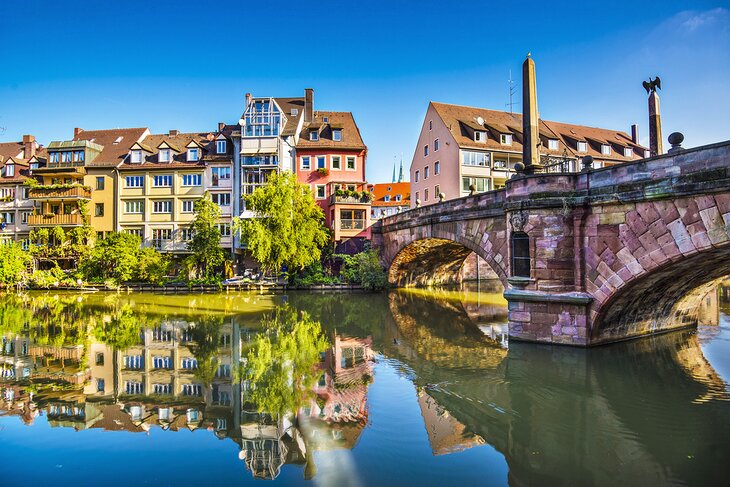
The second-largest city in the beautiful state of Bavaria , Nuremberg has long been associated with advances in science and technology, particularly in printing. Home to Europe's first printing press and a center for the study of astronomy, these and other important technological advances are today celebrated in the city's world-class museums and attractions.
Despite having been severely damaged in WW2, many of the medieval buildings in the Old Town (Altstadt) have been painstakingly restored to their former glory. In fact, most of the top attractions in Nuremberg are located within the city's historic city walls, which extend some five kilometers around the Old Town, making it extremely fun to explore on foot.
An easy day trip away from Munich , if you can, you may want to plan your visit to coincide with one of Nuremberg's many festivals. Two favorites are the famous two-week-long Old Town Festival musical and folk event, and International Organ Week , which runs from late June to mid-July.
To learn more about these and many other fun places to visit in a city, be sure to read through our comprehensive list of the top attractions and things to do in Nuremberg.
See also: Where to Stay in Nuremberg
1. Take a Walking Tour of Nuremberg Castle
2. get your bearings at the hauptmarkt, 3. walk nuremburg's historic city walls, 4. learn your history at the germanic national museum, 5. take a tour of the nuremberg transport museum, 6. marvel at the architecture of st. lawrence's church (st. lorenz), 7. frauenkirche: the church of our lady, 8. visit st. sebaldus church, 9. meet the artist: albrecht dürer's house, 10. documentation center nazi party rally grounds, 11. explore königstrasse and the st. lawrence side, 12. for the kids: the toy museum, 13. go wild at nuremberg zoo, 14. neues museum nürnberg, 15. city museum at fembo house, 16. museum of industrial culture, 17. have some fun at playmobil funpark, 18. schloss neunhof, 19. take a drive to erlangen schloss, where to stay in nuremberg for sightseeing.
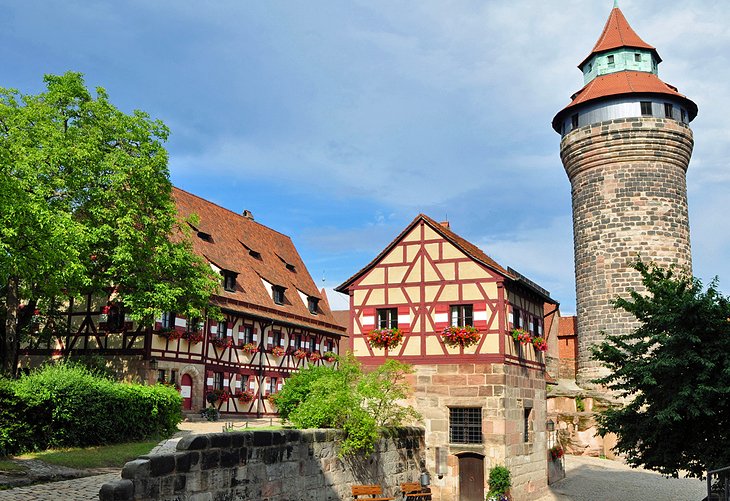
Dominating the skyline of the northwestern section of the Old Town (Altstadt) rises the cluster of historic structures that together comprise Nuremberg Castle.
The Imperial Castle of Nuremberg (Nürnberger Burg), is an impressive 351-meter-tall fortification that dominates the Old Town's skyline. One of the most important surviving medieval fortresses in all of Europe, it was once the residence of all legitimate German kings and emperors from 1050 to 1571.
A great way to get the most out of a castle visit is to join a fun walking tour of Nuremberg Old Town . These informative two-hour English-language tours also take in other important landmarks along the way such as the city walls, the famous Hauptmarkt, the historic Albrecht Dürer House, and St. Lawrence Church.
At the lower end of the castle are the imperial stables built in 1495 (now a youth hostel), and the Pentagonal Tower, dating from 1040. Higher up is the Kaiserburg, built in the 11th century although much altered in later centuries, along with the Sinwell Tower with its wonderful panoramic views. Be sure to spend time exploring the Palas quarters with its unique double chapel, both of which date from the early 13th century.
English-language audio tours are also available for a small fee and are well worth it for those not participating in an organized tour. Many surviving artifacts from the castle's long history can be viewed in the Imperial Castle Museum, the Bower. Here, you'll find an impressive collection of medieval weapons and suits of armor, along with saddles and harnesses.
Another of the castle's top must-sees is the famous Deep Well . Located in the attractive old two-story Well House built in 1563, this even older manmade structure plummets to a depth of 50 meters, and can only be visited with a tour guide available every half hour. Be sure to also explore the impressive Castle Gardens . An attractive place for a stroll, it can trace its roots all the way back to 1525.
Address: Burg 17, 90403 Nürnberg
Read More: Top-Rated Castles in Germany
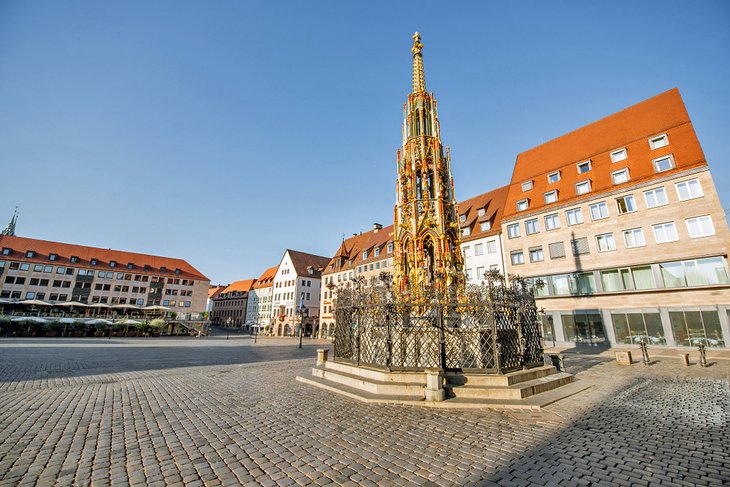
After your walking tour of Nuremberg Castle, spend time exploring the city's Hauptmarkt, or "Main Market." Regarded as one of the top tourist attractions in Germany , it has for centuries been the scene of a daily market, the Wochenmarkt, a tradition that continues to this day. It's also here that you'll find St. Giles' Church , the city's only Baroque church.
The traditional city center, the Hauptmarkt is home to the aptly named 14th-century "Beautiful Fountain." With its ornate decorations and figures, it makes for a picture-perfect selfie location. While you're there, be sure to touch the fountain's famous gold ring for a spot of good luck.
The Hauptmarkt is also where you'll find the Old Town Hall (Nurnberger Rathaus), along with its much newer 20th-century counterpart. Built in 1616, the original municipal offices are notable for their magnificent doorways, dungeons, and torture chamber.
Between these two buildings is another famous fountain, the Gänsemännchen. Built in 1555, it depicts a Franconian peasant carrying two geese with water flowing from their beaks.
If you are planning on visiting in December , you're in luck. It's in the Hauptmarkt that Nuremberg's famous Christmas Market (Nürnberg Christkindlesmarkt) is held.
One of the most popular Christmas markets in Europe , this two-week extravaganza is attended by more than a million visitors every year, and sees the marketplace transformed by festivities and lighting. It's also a shopper's paradise. As well as stands selling ornaments, Christmas foods, and gifts, exploring its many stalls at night is a particularly fun thing to do.
Another great way to get your bearings is to book a fun city tour of Nuremberg aboard the "Bimmelbahn ." This railway-themed people-mover starts in the Hauptmarkt, taking in such sites as St. Lorenz church and the Kaiserburg during its 40-minute orientation. Along the way, your professional guide provides fascinating commentary on the history of landmarks that you can then visit later at your own pace.
Read More: Top-Rated Christmas Markets in Germany
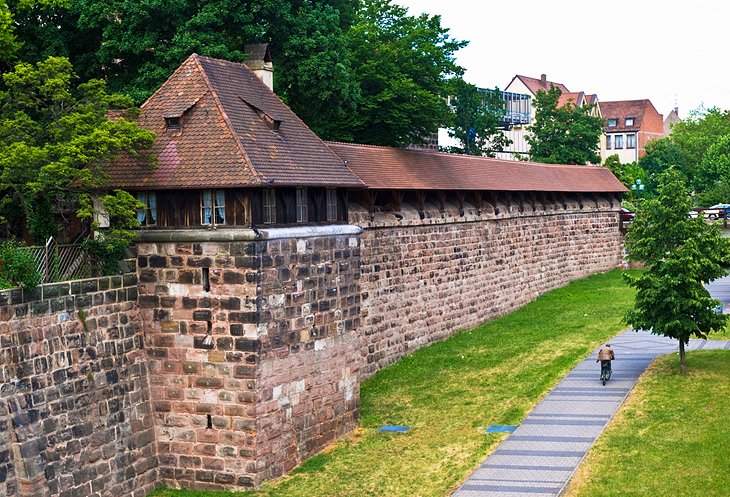
Nuremberg has the unique distinction of having preserved most of its circuit of old city walls, many sections of which date from the 14th to 15th centuries, and later strengthened in the 16th and 17th centuries.
In fact, one of the best places to visit in Nuremberg for those wanting to find their way about this fascinating medieval city is to walk the nearly five kilometers of paths that follow the walls, leading you to numerous gates and towers, many of which can be explored.
The finest stretch of walls is located on the west side of the Old Town, between the massive Spittlertor and the historic Maxtor. For the best views of the walls, the Old Town, and the Burg, make your way to the impressive Fürther Tor, the medieval gateway located in the southwestern corner of the city.
For a completely different tourist attraction, be sure to visit the nearby Medieval Dungeons . Known as Lochgefängnisse, this old prison features 12 prison cells and a torture chamber. English-language guided tours are available.
Address: Rathauspl. 2, 90403 Nürnberg
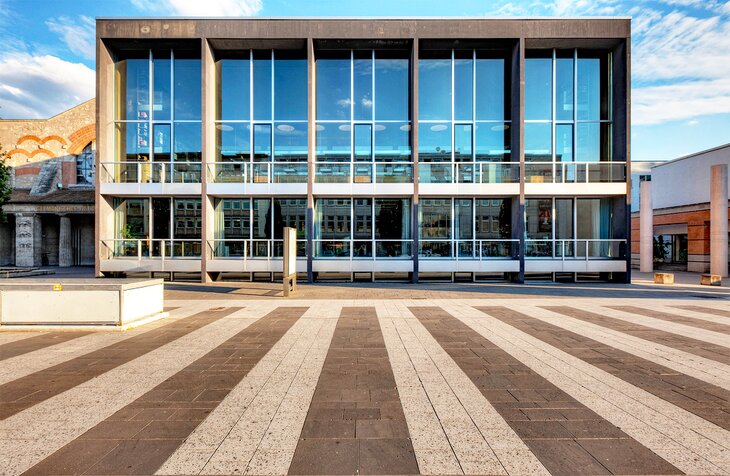
The Germanic National Museum (Germanisches Nationalmuseum) is home to the country's largest collection related to German art and culture. The museum has more than 1.3 million items relating to the region's artistic and cultural history, including historical documents on parchment, a collection of 17,000 seals, and a superb fine arts archive.
Other notable highlights include a collection of 300,000 prints, drawings, and paintings representing all the major schools of art. There's also an impressive collection of historical musical instruments, a sculpture collection, and a fascinating display of antique toys and dollhouses.
Part of the fun of exploring this vast museum is taking in its many unique architectural features as it incorporates an interesting mix of historic and modern buildings, including parts of a 16th-century charter house and a former abbey. Guided tours are available, and a gift shop and café are located on-site.
This museum is also worth visiting as it's located on Kartäusergasse. Here you'll find The Way of Human Rights (Straße der Menschenrechte), a street-long monument dedicated to world peace. Another notable art-related attraction is Kunsthalle Nürnberg , a popular gallery that features exhibits of work by contemporary international artists.
Address: Kartäusergasse 1, D-90402 Nürnberg
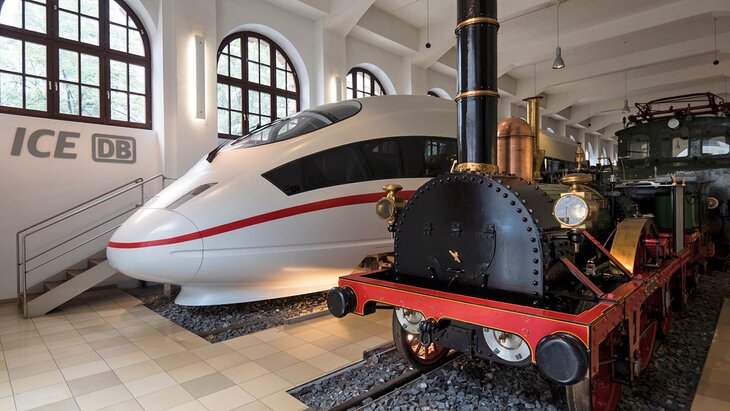
Just outside the old town walls is the superb Nuremberg Transport Museum (Verkehrsmuseum Nürnberg). Consisting of a number of museums, including one dedicated to Deutsche Bahn, the country's railway, known as the DB Museum; and the Museum of Communications. It's a wonderful attraction to explore with kids due to its many displays relating to the country's railroads.
Highlights include numerous scale models, including a massive model railway that's been built up for over 100 years, as well as a variety of fun interactive displays. One of the oldest such museums in Europe, it can trace its roots back to 1899 and boasts a rich collection that also includes royal trains and perfectly restored steam and diesel engines. There's even a working replica of Germany's very first train.
The museum also offers a varied program of tourist and charter trips on mainline rails, so be sure to check for such opportunities prior to your visit. And for a truly memorable oracle experience, check the availability of one of the excellent tourist charter trains, which run regularly.
Another transportation-related museum to check out is the Merks Motor Museum . This fun attraction houses a fine collection of some 90 vintage cars.
Address: Lessingstraße 6, 90443 Nürnberg
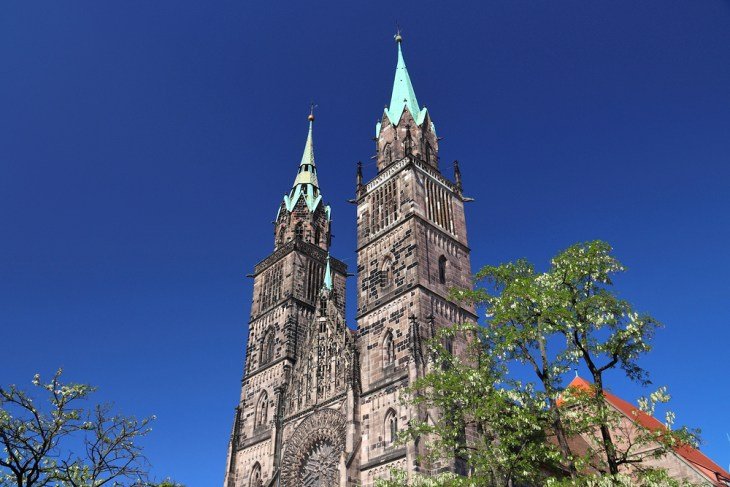
Overlooking Lorenzer Platz, the spectacular twin-towered 14th-century Gothic church of St. Lawrence (St. Lorenz, or Lorenzkirche) is the city's largest church. One of its many notable features is a large rose window, nine meters in diameter, situated above the beautiful west doorway.
Inside, its many lavish works of art, most of them provided by the city's richer classes over the centuries, include the Annunciation by sculptor Veit Stoss from 1517 in the choir. Other highlights include its late 15th-century tabernacle; the crucifix on the high altar; the Krell Altar, with the oldest surviving representation of the town; and the superb stained-glass in the choir dating from 1477.
Other notable features include a unique three-part organ boasting over 12,000 pipes, which is said to be one of the largest such instruments in the world, and a set of 16 bells, the oldest of which dates back to the 1300s. Nearby highlights include the Fountain of Virtue from 1589 and the 13th-century tower-like Nassauer Haus .
Address: Lorenzer Pl. 1, 90402 Nürnberg
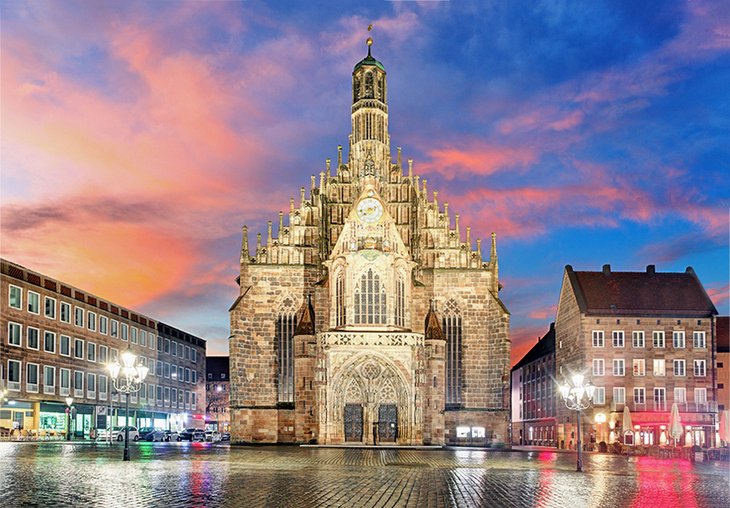
The Roman Catholic Frauenkirche (Church of Our Lady) dates back to 1352 and is a must-see Gothic landmark. You can't miss it when visiting Nuremberg's Hauptmarkt, as the building's stunning façade is rich with detail.
For example, above the porch with its rich sculptural decoration is the Männleinlaufen, a beautiful old clock that was installed in 1506 with mechanical figures representing the seven Electors pacing around Emperor Charles IV. It performs daily at noon.
Notable features of the interior, which was designed with attendance by the Emperor in mind, are the Tucher Altar from 1440 and two handsome monuments by Adam Kraft. Visitors are welcome to attend daily mass here, too. In the pedestrian-friendly Jakobsplatz is another interesting old Roman Catholic edifice, the domed St. Elizabeth's Church built between 1785 and 1806.
Address: Hauptmarkt 14, 90403 Nürnberg
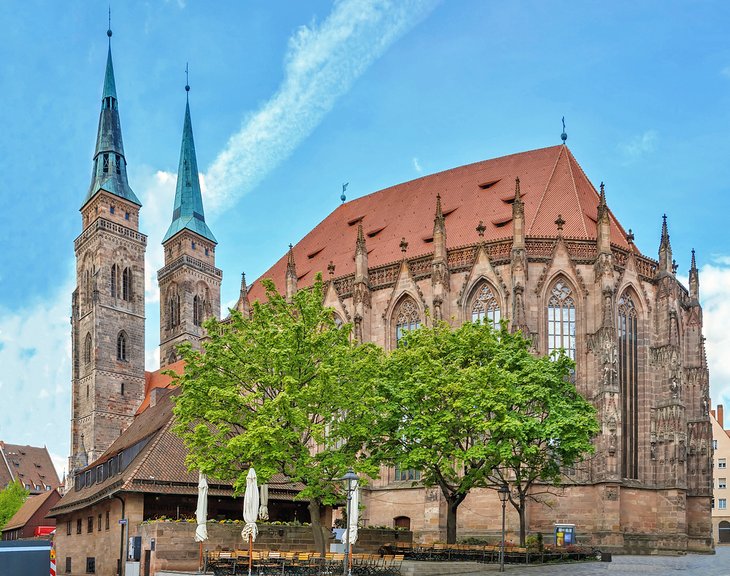
Protestant St. Sebaldus Church (Sebalduskirche), built from 1225-73, boasts a magnificent Gothic east choir dating from 1379 featuring the Schreyer-Landauer tomb, the work of Adam Kraft. Inside, on a pillar in the north aisle, is the Madonna in an Aureole dating from 1420, while in the east choir is the famous tomb of St. Sebaldus from 1508, a masterpiece in bronze by Peter Vischer and his sons.
A silver sarcophagus from 1397 contains the saint's remains, and Vischer himself is depicted with his leather apron and chisel. Other church highlights include a Crucifixion group by Veit Stoss dating from 1507 and a huge organ with 6,000 pipes.
A great experience if you're able to squeeze it into your Nuremberg itinerary is to participate in a private 1.5-hour tour of the church's towers; spaces are limited for this twice-weekly event. Be sure to arrive early to purchase your tickets.
Another protestant church of note is the 14th-century St. James's Church (Jakobskirche) in the Jakobsplatz pedestrian area.
Address: Winklerstraße 26, 90403 Nürnberg
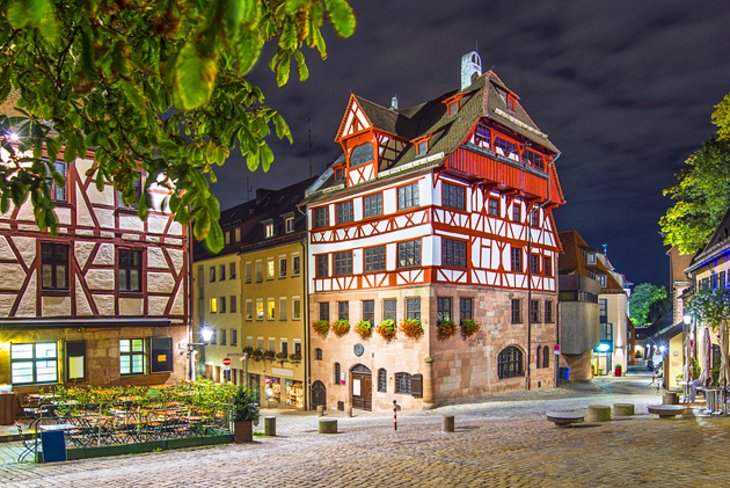
Just a stone's throw from Nuremberg Castle is the 15th-century Albrecht Dürer's House (Albrecht-Dürer-Haus). It was here the famous German Renaissance artist lived from 1509 until his death in 1528. This five-story house itself dates back to 1420 and now serves as a museum, founded in 1871 and dedicated to Dürer's life and work. He's especially famous for his printed maps.
In addition to its many fine displays of some of his best-known creations, the museum houses displays of authentic period furniture and a reproduction of Dürer's studio workshop, where demonstrations of traditional printing can be enjoyed. Also of interest is the kitchen with its original fireplace plus living quarters, which can be viewed. Guided tours are available.
Also of note is the nearby Tiergärtner Tor , a perfectly preserved little medieval square. Another famous old home is the late 16th-century Fembohaus , the town's best preserved old merchant's house now occupied by the Heimatmuseum with its domestic interiors and displays relating to the town's history.
Address: Albrecht-Dürer-Straße 39, 90403 Nürnberg
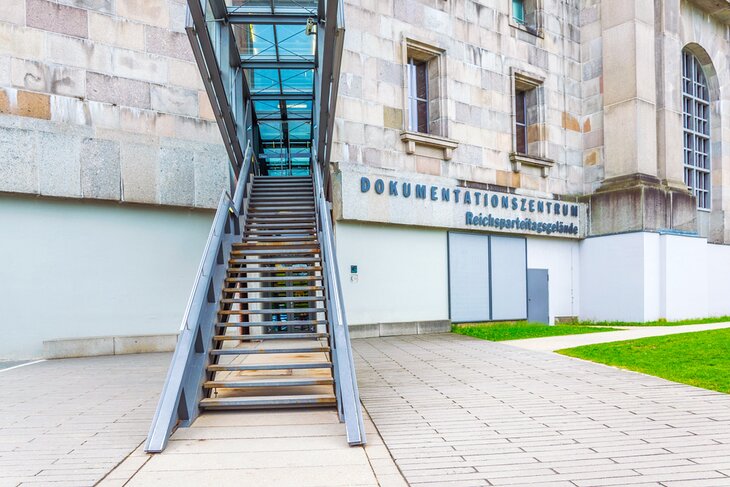
The Documentation Center Nazi Party Rally Grounds (Dokumentationszentrum Reichsparteitagsgelände) is one of Germany's most important museums, dedicated to the bleakest chapters in the country's history. Located in a wing of the Congress Hall where Nazi Party rallies were held, its most notable exhibit is called Fascination and Terror and deals with many facets of the Nazi regime's brutal time in power.
Covering an area of 1,300 square meters, it deals specifically with the impact of the regime on Nuremberg, as the Congress Hall was part of a vast 11-square-kilometer site. It was also here that the Nuremberg Trials that took place after the war.
Guided tours are available in English with advance notice, and English-language audio tours and video displays are provided. You can also pick up details of a self-guided tour of the complete rally grounds.
Another point of interest related to this dark period of German history is Memorium Nuremberg Trials . This fascinating exhibition concerns the war trials that took place here after WW2, and it's located above the actual court used at the time.
If you're on a tight schedule, consider joining an organized walking tour of the Nuremberg Nazi Rally Sites that also takes in the best of the top Old Town (Altstadt) attractions. In addition to learning the remarkable history of this medieval city, both ancient and modern, you'll see points of interest such as the Imperial Castle courtyards, Albrecht Dürer's house, and St. Lawrence Church during this informative four-hour tour.
Address: Bayernstraße 110, 90478 Nuremberg
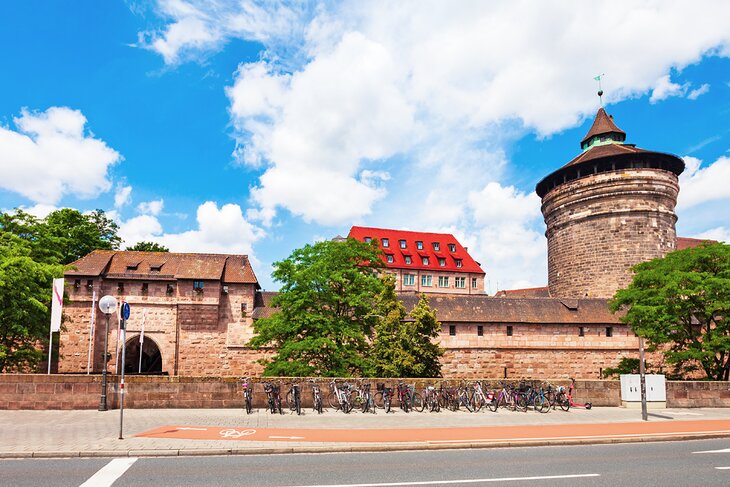
Nuremberg's St. Lawrence Side, or Lorenzer Seite, is named after its principal church, St. Lorenz, and lies in the section of the Old Town (Altstadt) that's located on the south bank of the river Pegnitz.
One of the busiest parts of the city, it's worth exploring for its famous Frauentorturm and Handwerkerhof Alt Nürnberg districts, two small enclaves of wonderful, old half-timbered houses renowned for their traditional craft workshops.
From Bahnhofsplatz , the busy Königstrasse runs northwest into the old town of Nuremberg. Highlights of this historic old street include the 14th-century St. Martha's Church (Marthakirche) with its fine stained glass.
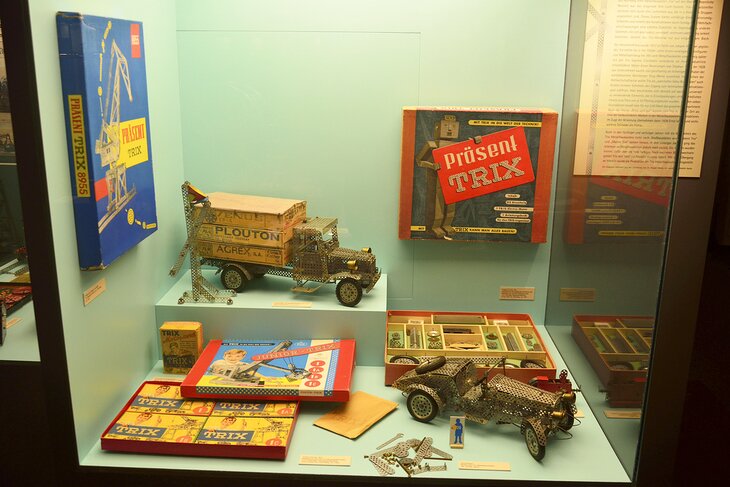
Nuremberg's excellent Toy Museum (Spielzeugmuseum), widely regarded as the leading museum of its kind in the world, is a fun attraction for kids of all ages, as well as adults. It's located in a historic old home dating from 1517. Highlights of a visit include fascinating details of the cultural significance of the many unique toys on display from different countries and periods.
Many of the older toys, some of which date back to medieval times, were made in the town, which was famous for centuries for its doll makers. Also of note is the world's largest collection of toys made by EP Lehmann, one of the country's best-known toy manufacturers, famous for their line of model trains, some of which can be seen traveling along the museum's large model railroad layout.
The Toy Museum is also home to the German Games Archive, a vast collection of board games and other related materials. On-site amenities include a well-stocked toy store, an outdoor play area including a labyrinth, plus an indoor play and craft area.
For those with an interest in the stars, a visit to the Nicolai Copernicus Planetarium is another fun thing to do with the kids.
Address: Karlstrasse 13-15, D-90403 Nuremberg

Traveling to Nuremburg with kids? Then you'll want to pay a visit to the Nuremberg Zoo (Tiergarten Nürnberg). Home to more than 2,000 animals from some 300 or so different species, this world-class attraction was opened in 1912 but can trace its roots back to medieval times, when exotic animals from around the world were kept for entertainment by local aristocracy.
Covering an area of 170 acres, it's one of the largest and oldest zoos in Europe and boasts numerous displays of animals, including Siberian tigers, Asiatic lions, snow leopards, lowland gorillas, and African buffalo. It's certainly a fun attraction to stroll around, due largely to the care and attention paid to the enclosures, which are spacious and reflect natural habitats and landscapes.
As well as the lush greenery, there are also many life-size bronze animal sculptures sprinkled throughout the facility. Other notable features include a popular dolphin lagoon with regular shows. If possible, try to plan your visit to coincide with the chance to see animals being fed. English-language guided tours are also available.
Address: Am Tiergarten 30, 90480 Nürnberg
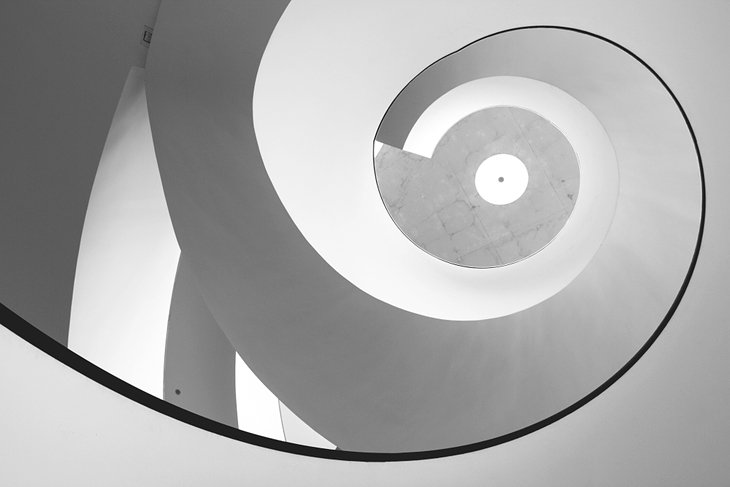
For art lovers, the excellent Neues Museum Nürnberg is a must-visit for its large and impressive collection of modern and contemporary art. Located in a very stylish modern building, this world-class museum opened in 2000 and is in fact something of a work of art itself, boasting bright open spaces, clean lines, and interesting architectural features such as its exquisite spiral staircase.
The artwork covers the period from 1950 to today, with notable exhibits of applied art and fine art often displayed side by side to add a unique perspective to the experience. Numerous temporary exhibits are hosted throughout the year featuring works by both local and international artists.
A variety of educational opportunities are also on offer, including workshops and lectures, as well as events such as music concerts and performances. Guided tours are also available and can be customized to suit your interests.
Address: Luitpoldstraße 5, 90402 Nürnberg
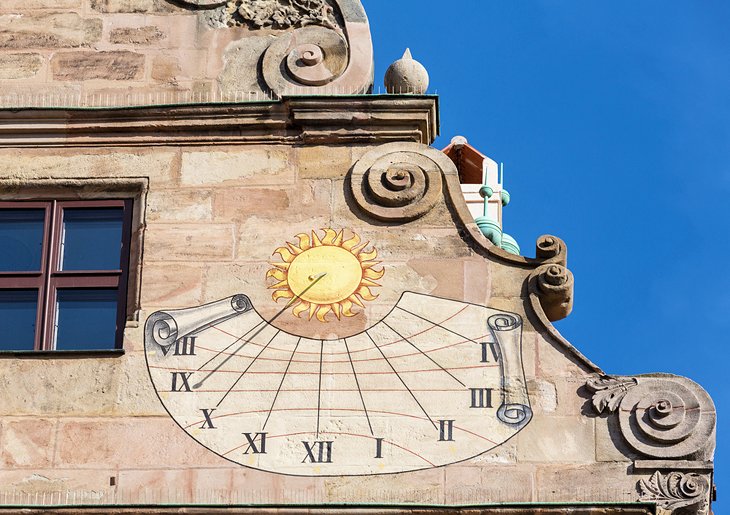
After spending time exploring beautiful Nuremberg, or possibly even before you venture too far, you'll no doubt want to know more about the city's rise to prominence over the years and how it came to be home to so many important historic attractions. If so, be sure to make time for a visit to the superb City Museum at Fembo House (Stadtmuseum im Fembo-Haus).
Situated in the city's last remaining Late Renaissance merchant house, this museum provides an in-depth look at life in Nuremberg and its residents over the centuries. Highlights include a chance to see a variety of original rooms, from medieval times to the 18th century, complete with authentic furnishings and artwork, as well as one of the finest surviving stucco ceilings in Germany.
Also of note is the excellent wooden scale model of Nuremberg's Old Town (Altstadt), and a recreation of a traditional map printing workshop. Be sure to tune into the well-produced and informative "audio plays" put together by the museum, which use real-life experiences of city folk through the years to paint a fascinating aural picture of Nuremberg's rich history.
Address: Burgstraße 15, 90403 Nürnberg
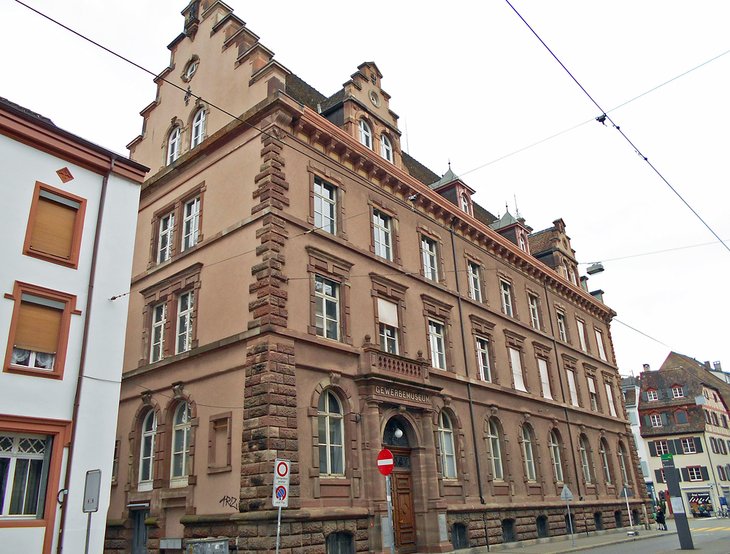
Located just steps away from the German National Museum is the Museum of Industrial Culture (Gewerbemuseum). Focusing on the city's industrial past and housed in a former 19th-century ironworks, this museum takes a unique look at how the various industries based here through the centuries impacted Nuremberg culturally and socially.
Highlights of this large facility are displays of old machinery and manufactured goods, including domestic appliances and vehicles, along with a cinema.
The same building also houses the Motorcycle Museum , which celebrates an industry that started in Nuremberg in 1901. A particular focus is placed on the local Zündapp brand, which came to prominence in the 1920s with one of the first affordable models on the market. Other highlights include displays of historic racing bikes and customized machines.
Address: Äußere Sulzbacher Str. 62, 90491 Nürnberg
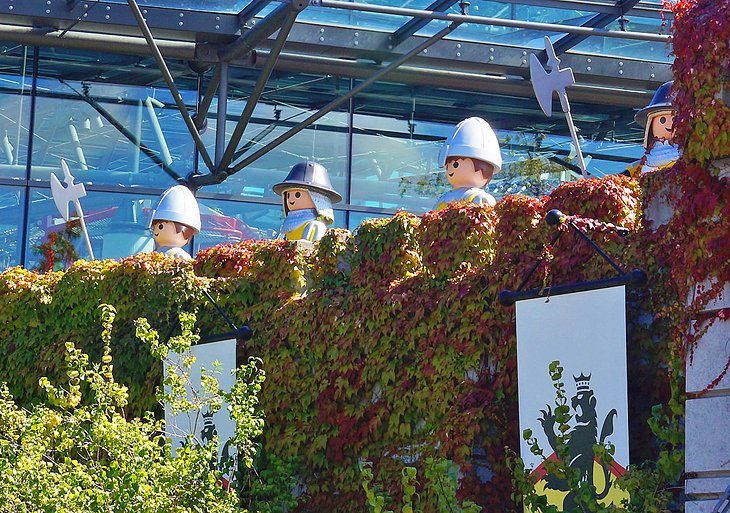
There are plenty of fun attractions suitable for kids within a short drive of Nuremberg. One of the most popular is Playmobil FunPark . Tucked away in the town of Zirndorf, an easy drive west of Nuremberg, this indoor/outdoor theme park is suitable for ages three and up.
Highlights include full-size (kid-size!) replicas of the toy company's many famous play characters and accessories, from a giant pirate ship to a large castle, that can be explored. Other notable features include an American Indian village, a Wild West themed area, a farm, a gold mine, and even a dinosaur display.
Many of the exhibits are there to be played with and climbed over, such as the ropes course, a labyrinth, and powered paddleboats, which really add to the enjoyment factor. Numerous seasonal events and mini-festivals are held here, too, so be sure to check the site's website for details.
And after all that fun playing, head over to Kristall Palm Beach waterpark in nearby Stein, a popular spot for its many swimming pools and slides. Facilities for parents include spas and hot tubs.
Address: Brandstätterstraße 2-10, 90513 Zirndorf
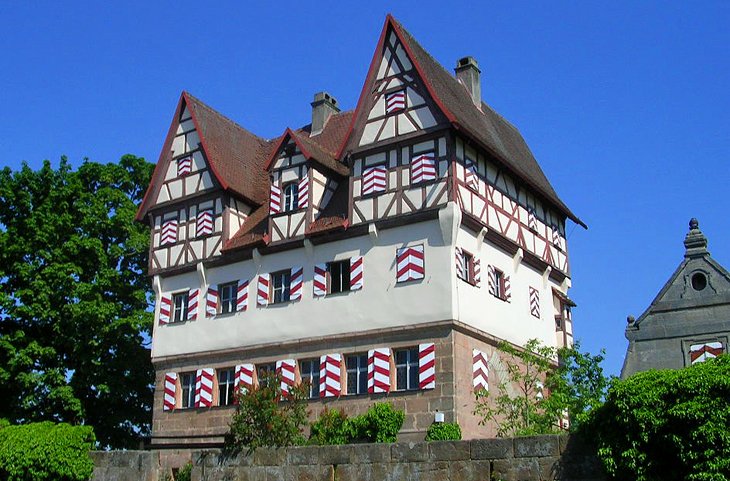
Located just nine kilometers north of Nuremberg, Schloss Neunhof is a lovely old fortified manor house that was first mentioned in historical documents in 1246. One of the best-preserved mansions of the Nuremberg patricians, it is one of 60 such structures dotted around the city as a defensive line.
This well-preserved building boasts a moat and drawbridge, lovely decorated interiors, as well as a splendid garden. Remodeled 50 years ago and based on drawings from the 1600s, it's a delight to explore; take your time, and pack a picnic.
Other notable highlights include its original gate, a variety of outbuildings including stables and gardens, and two kitchens. A later addition worth popping into is the 18th-century chapel.
Address: Neunhofer Schloßplatz 2, Nürnberg
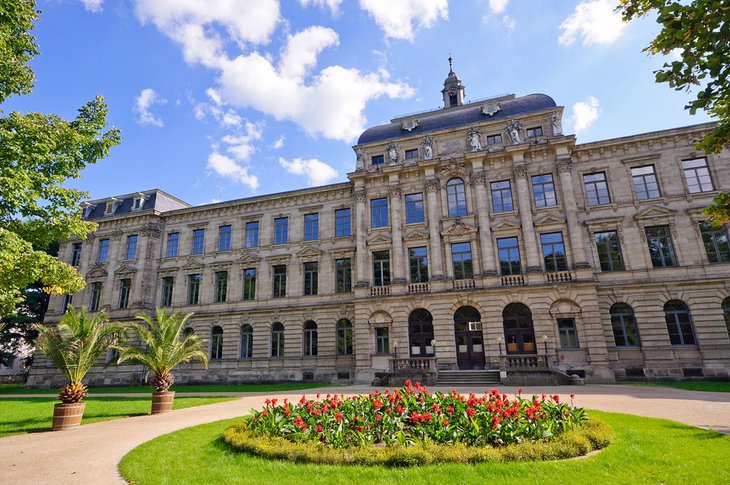
The small Baroque town of Erlangen lies a few kilometers north of Nuremberg and is famous for its university.
Its most notable building is Erlangen Schloss, built in 1704 and occupied since 1825 by the Friedrich Alexander University. To the rear of the building is the Schlossgarten, a delightful formal garden designed partly in French and partly in English styles, with its lovely yet curious Huguenot Fountain, and the beautiful Orangery dating from 1706.
On the north side of the gardens are the Botanic Garden and the Margravial Theater, as well the University Library. Here you'll find valuable manuscripts and works of graphic art, including self-portraits by Dürer and Grünewald.
Address: Postfach 3520, D-91023 Erlangen
If you're visiting Nuremberg for the first time and want to see the main sights, the best place to stay is in the Old Town (Altstadt), which lies within the old city walls. From here, you can easily walk to many of the city's top attractions, including the Hauptmarkt, the National Germanic Museum, and Nuremberg Castle. Here are some highly-rated hotels in this central and convenient location:
Luxury Hotels:
- Within the old town walls, near the main train station, the historic Hotel Victoria and the charming boutique Hotel Drei Raben are both steps away from the Hauptmarkt. In the latter hotel, each room is uniquely themed with a story that celebrates the city's heritage.
- If you prefer big hotels, the Sheraton Carlton Hotel Nuernberg is outside the walls of the Old Town but still within walking distance of the historic attractions and the main train station.
Mid-Range Hotels:
- In a fantastic location right on the Hauptmarkt, Sorat Hotel Saxx Nurnberg accommodates guests in cozy, contemporary rooms; it's a five-minute stroll to shops and restaurants and less than 10 minutes on foot to Nuremberg Castle.
- Another great-value boutique option is the Art Business Hotel Nichtraucherhotel, with bold, modern art and contemporary spaces, just outside the old town walls near the main train station.
- With a fitness center and a free hot breakfast, Hampton by Hilton Nuremberg City Centre is also outside the city walls, but still within walking distance of the Old Town's top attractions.
Budget Hotels:
- On a quiet side street within the old town walls, the family-owned PrivatHotel Probst offers clean, bright rooms with comfy beds and a wonderful cooked breakfast.
- A hop, skip, and a jump away, the Ibis Nuernberg Altstadt offers clean basic rooms in the heart of the Old Town, while the B&B Hotel Nuremberg-Hbf is less than 15 minutes on foot from the Hauptmarkt and a short stroll from the main train station.
More Related Articles on PlanetWare.com
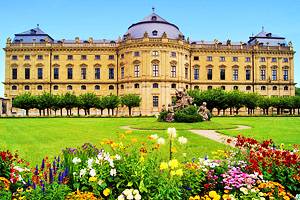
Go West : From Nuremberg, point your car northwest (or jump on a train) and you'll find yourself headed in an almost straight line to three equally interesting cities: Würzburg, Frankfurt, and Bonn.
The attractions of Würzburg are an easy hour's drive away in the Main valley and include elegant old architecture including the Würzburg Residenz, pleasant gardens (the Hofgarten), as well as a splendid cathedral.
Frankfurt , for its part, is a must-visit for its beautiful old city center, the Römerberg, one of the most picturesque such settings in all of Germany for its old timber-framed buildings overlooking wide public squares with their pleasing monuments and fountains.
Bonn , too, boasts an equally charming historic ambience, in particular around its old cathedral and nearby market square.
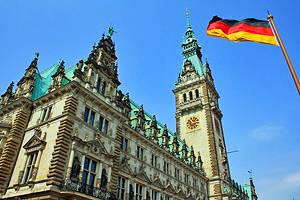
Germany's Big Cities : Thanks to its high-speed rail network and fast autobahns, Germany is an extremely easy country to get around. Use one of these methods to visit some of the country's largest cities, including Berlin, the capital , where you'll be inundated with opportunities to be entertained while enjoying cultural activities, including visits to some of the world's leading art galleries and museums , as well as having the chance to see what's left of the infamous Berlin Wall. Hamburg is Germany's second-biggest city, and is a popular destination for its magnificent port area, as well as the great family attraction, Miniatur Wunderland, the world's largest model railway. The city of Munich , the country's third-largest municipality in terms of population, is of course famous for its cathedral and churches, its many palaces, as well as its gardens, all of which are pleasant to explore.
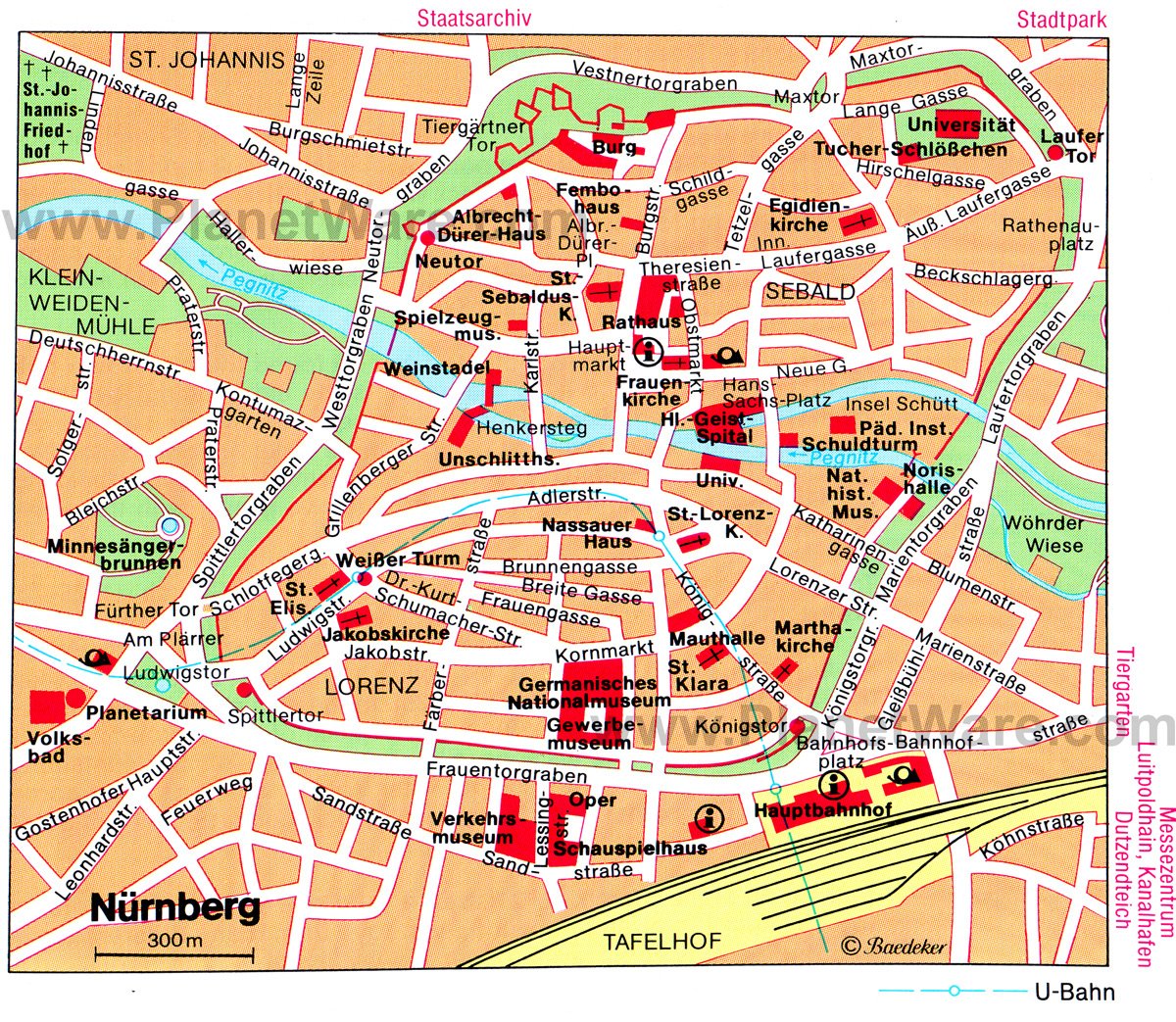
More on Germany

- Work with me
- Privacy policy

- Years in review
- United Kingdom
- Bosnia & Herzegovina
- North Macedonia
- Philippines
- South Korea
- South Africa
- Africa Overlanding
- Central America
- New Zealand
- Solo Travel
- Budget travel
- Travel tips
- Travel itineraries
- Hidden gems
- Bucket list
- Travel resources
- Digital nomadism
- Blogging tips
- Start a travel blog
32 Best Things To Do In Nuremberg By A Local (2024)
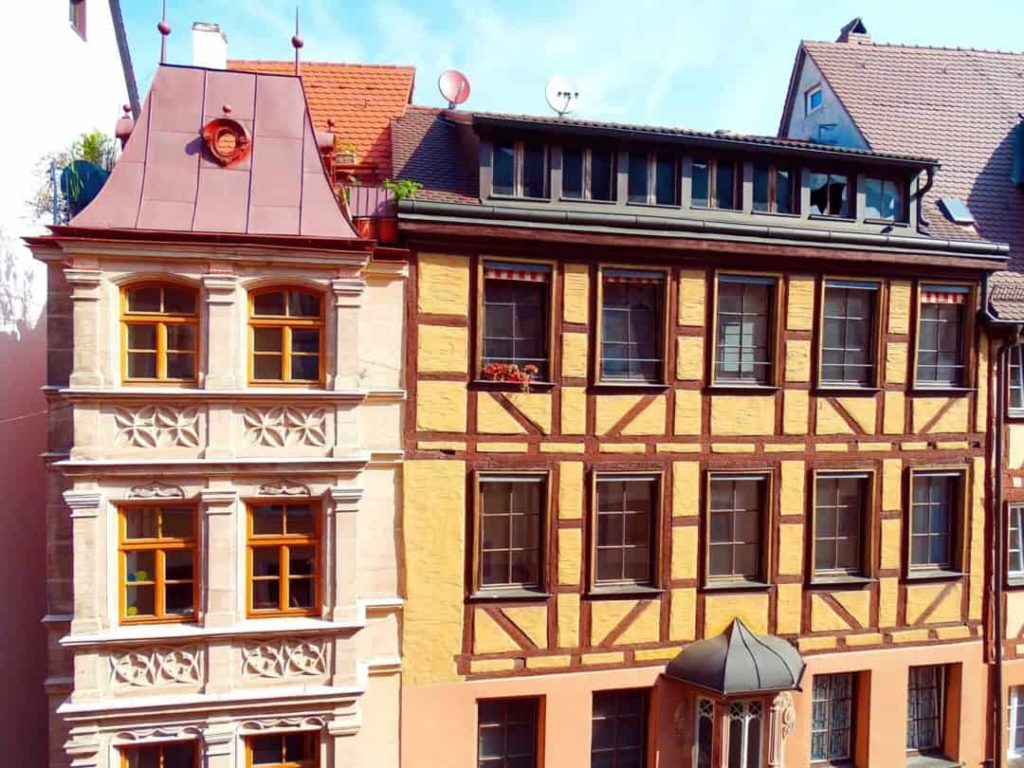
Table of Contents
This post may contain affiliate links to things like tours, hotels, Amazon associates and products. These help me earn a small commission at no additional charge to you.
Hello and welcome to Nuremberg, one of my favourite little cities in Germany . I’m going to sum up the best things to do in Nuremberg as well as the top eats, places to stay and ways to get there & away.
NUREMBERG ESSENTIALS Accommodation: Booking.com / Hostelworld Copy of Lonely Planet Germany Activities: GetYourGuide Getting there: Flight ( Skyscanner ) / Train ( RailEurope ) / Bus ( Flixbus )
This gem nestled between Munich and Frankfurt is straight out of a fairytale! The Old Town is characterised by traditional markets, timber-framed houses and balconies overflowing with flowers. With half a million residents, it’s a midsized city with a centre that can be easily explored in a day or two. After spending 2 days in Hamburg and finding the hidden gems of Berlin , I truly understand how different Bavaria is to the north of the country. Although Munich has similar vibes, I confess I found Munich a little boring. No other German city captures my heart quite like Nuremberg. It’s a lovely place to wander at your leisure, eat at food markets and try traditional German drinks including many types of regional beer.
Local’s guide to Nuremberg
I’ve had plenty of trips to Nuremberg now as my sister lived and worked there for 5 years. My entire extended family have visited countless times, gradually working through the best things to do in Nuremberg, not to mention the best German cuisine and beer!
Related read: the 30 best German dishes to try
With the help of my sister’s local tips, I’ve been able to put together this guide. Look out for her words of wisdom throughout the post.
Getting to Nuremberg
Fly: Flight prices begin at €15 to and from destinations including the UK, Italy, Spain, Hungary and more. From the city centre, the airport is just a 20-minute ride on the U-Bahn (underground train). I use Skyscanner to find the best-value flights, using the ‘search by month’ tool to find the cheapest dates. Train: Connections are good – you’re just 1 hour from Munich and 2 hours 20 minutes from Frankfurt. Use RailEurope to book trains in Germany and beyond. Search trains to Nuremberg . Bus: The FlixBus is your cheap and cheerful way to explore the rest of the country and cross the border – Germany has nine of them so you’re well placed for lots of European excursions. Search Flixbuses to Nuremberg . Top travel tip – I use Omio to compare the costs and duration of trains, buses and flights in one search.
How to get around Nuremberg
Nuremberg has an efficient U-Bahn (underground train) that connects all areas of the city. There are three lines (U1, U2 and U3) which run from 5am to midnight. You can buy single tickets, four-trip tickets, 10-trip tickets, day tickets and group tickets on the VGN website, app, or at any of the station ticket machines. There’s also a decent bus and tram network. Tickets are included in a day pass or can be purchased individually. Saying that, the city centre is easy to explore on foot so you don’t need public transport to see the main attractions. However, if you want to get to places like the Documentation Center, you will need to take the bus or U-Bahn.
Where to stay in Nuremberg
Budget hotel: close to the city centre, B&B Hotel Nürnberg-West is a clean, convenient base with heating in the winter and aircon in summer. Book from €75 . Midrange hotel: Hotel Victoria is right in the city centre and has lovely single and double rooms from €130. Another mid-range option with great reviews is the Leonardo Royal from €110 . Splash-out hotel: one of the best places to treat yourself is the 4* Karl August Hotel with a fitness centre, 24-hour reception and a kitchenette. Book from €150 . Hostel: Five Reasons Hotel & Hostel couldn’t be a better bet with clean and comfy dorm rooms from €30 a night. Apartment: for the convenience of your own apartment and kitchen, check out Aparthotel by dasPaul , Willkommen im Herzen Nürnberg s and Astoria Apartments from €70.
Check all hotels and apartments on Booking.com and hostels on Hostelworld .
Top experiences in Nuremberg
- Traditional gingerbread making class
- Old Town tour by bike
- Old Town & Nazi Rally Grounds Walking Tour
Is the Nuremberg Card worth it?
The Nuremberg Card costs €33 and includes all your public transport for 2 days, entry to various attractions (including Albrecht Dürer House, Imperial Castle, Germanisches Nationalmuseum and the Documentation Centre) and allows you to skip the line at paid-for attractions. It’s a good investment since the transport alone will cost €19.40 (for two day passes) otherwise. As long as you visit 2-3 paid-for attractions, you’ve made your money back. Purchase yours here .
15 things to do in Nuremberg
1. browse at the handwerkerhof market.
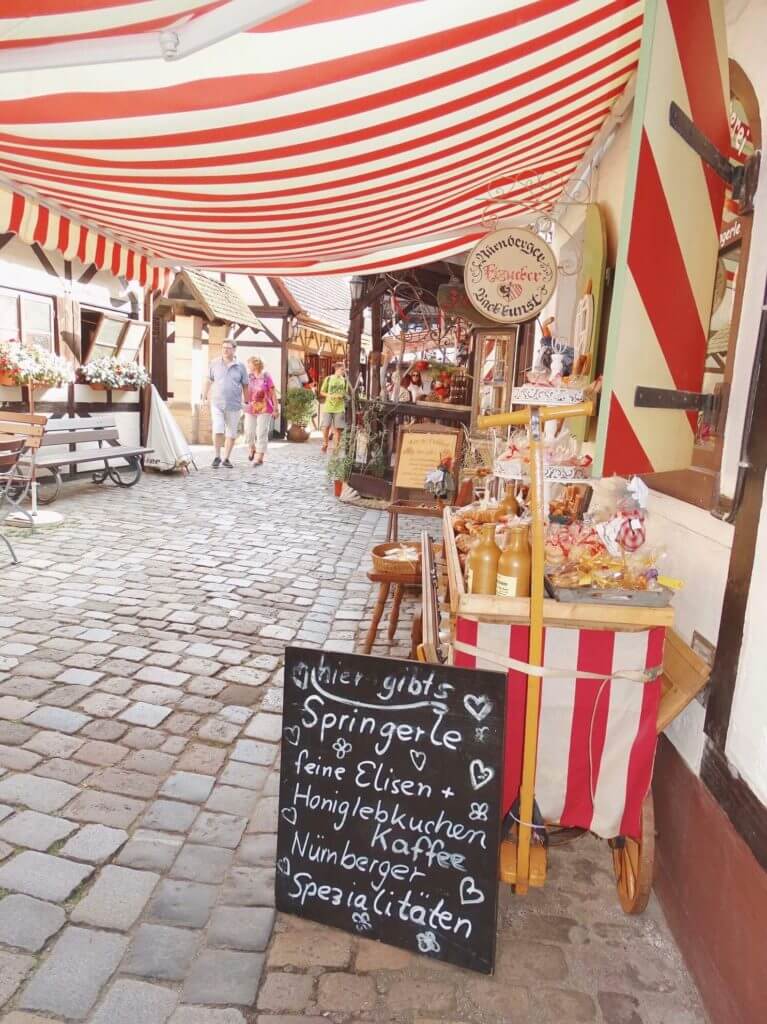
You should know before travelling to Germany just how pretty and idyllic the south of the country is. You’ll want your camera charged when exploring this medieval village within the Nuremberg city walls home to charming craft shops and rustic restaurants. Pick up your souvenirs, have a wander or sit and enjoy a beer whilst watching the world go by.
2. Walk Weißgerbergasse
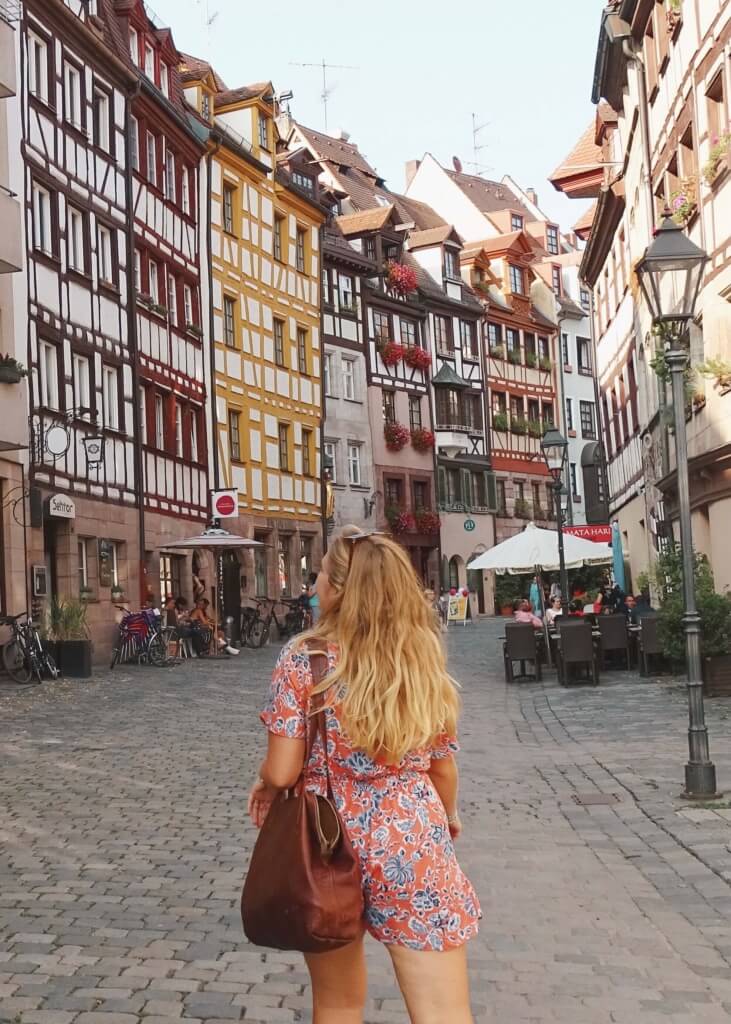
I’d seen loads of photos of this street online and it didn’t disappoint! Once you’ve walked Weißgerbergasse, you’ll have really felt the magic of Nuremberg. It’s home to lots of cafes and ice cream shops so it’s a good spot for coffee – or beer. When in Rome!
Local’s tip – visit early or late if you want to capture photos here. When the shops and cafes are open, the street gets very busy.
3. Visit Lorenzkirche
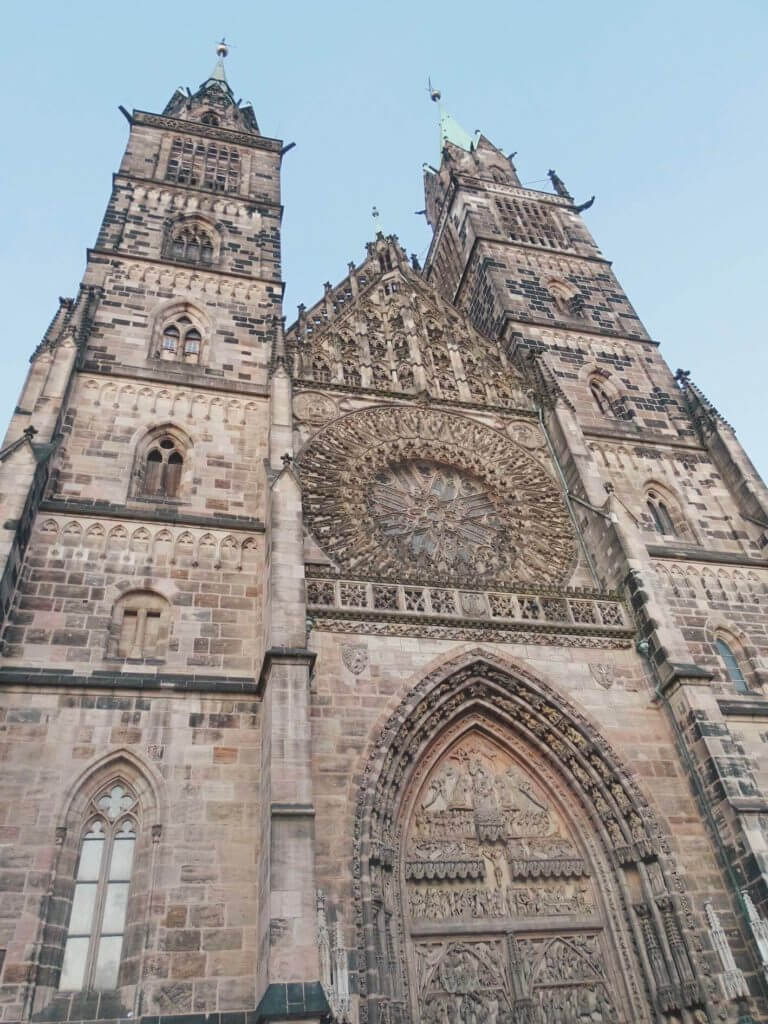
This gothic church in the centre of Nuremberg dates back to 1250. With 12,000 pipes, Lorenzkirche has one of the largest church organs in the world. See if your visit times with a concert.
4. Documentation Center Nazi Party Rally Grounds
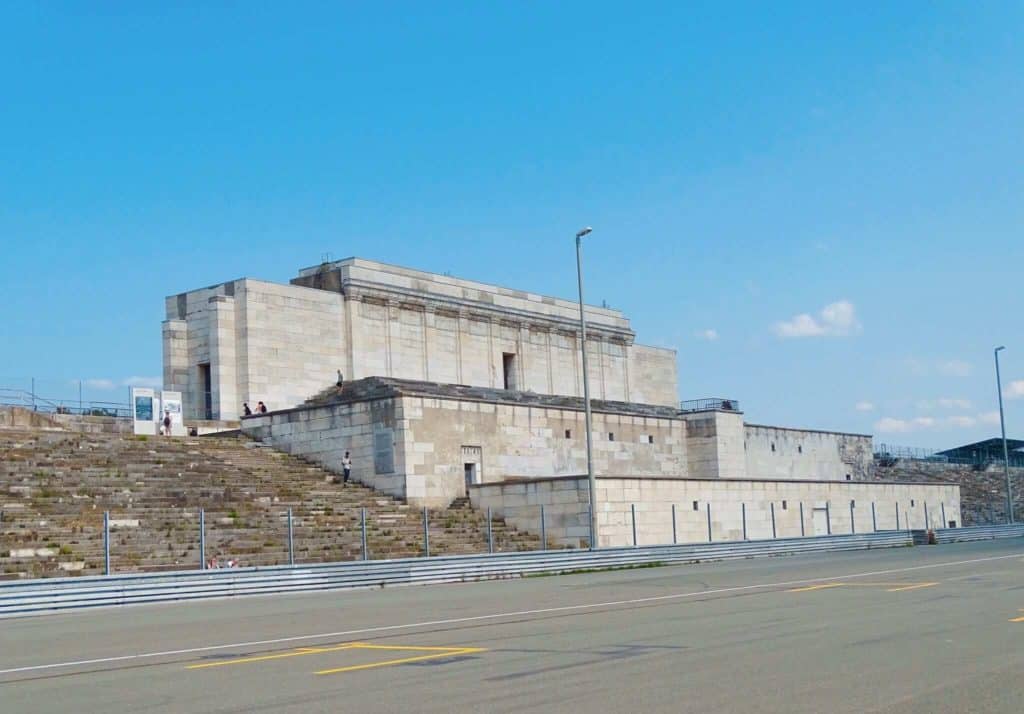
Now a museum, this area was once used by Hitler for his speeches and as a rally ground for the Nazis from 1933 to 1938. No, it’s not an upbeat excursion but it’s important. If you don’t fancy a full afternoon at the Documentation Center Museum (€6 entry), you can visit the rally ground for free. For after, there’s a gorgeous boating lake beside it.
5. Memorium Nuremberg Trials
Nuremberg is a place where you can see history turn full circle. After learning about the Nazi Party in its heyday at the Documentation Center, you can learn how justice was finally served at the Memorium Nuremberg Trials . This courtroom within the Nuremberg Palace of Justice is where Nazi leaders had to answer for their crimes between 1945 and 1946. Learn about the trials that changed history and tour Courtroom 600, still a working courtroom to this day.
6. Admire Weinstadel
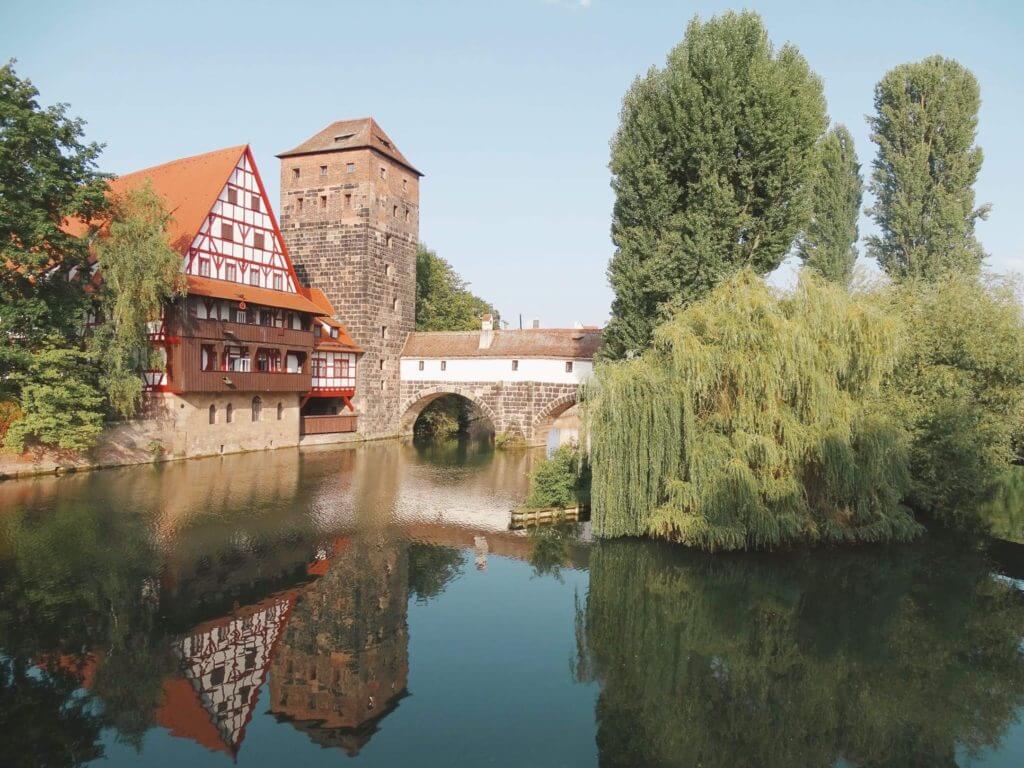
One of the most historic (and prettiest!) things to do in Nuremberg is visit this building. It’s had loads of uses over the years: it’s been a wine warehouse, a house for lepers who were only allowed in the city at Easter, and nowadays the tower to the side is used as student accommodation. It’s a great place to photograph from the nearby bridges.
7. Walk the City Walls
No less than 5km of paths circle the walls of Nuremberg’s old city. These walls dating back to the 14th century were built to protect the city from enemies. Start at the west side of Old Town and make your way to Fürther Tor towards the south of the city. As you explore sections of the medieval wall, you’ll soak up beautiful views of Nuremberg and its surroundings.
8. Go boating on the Großer Dutzendteich
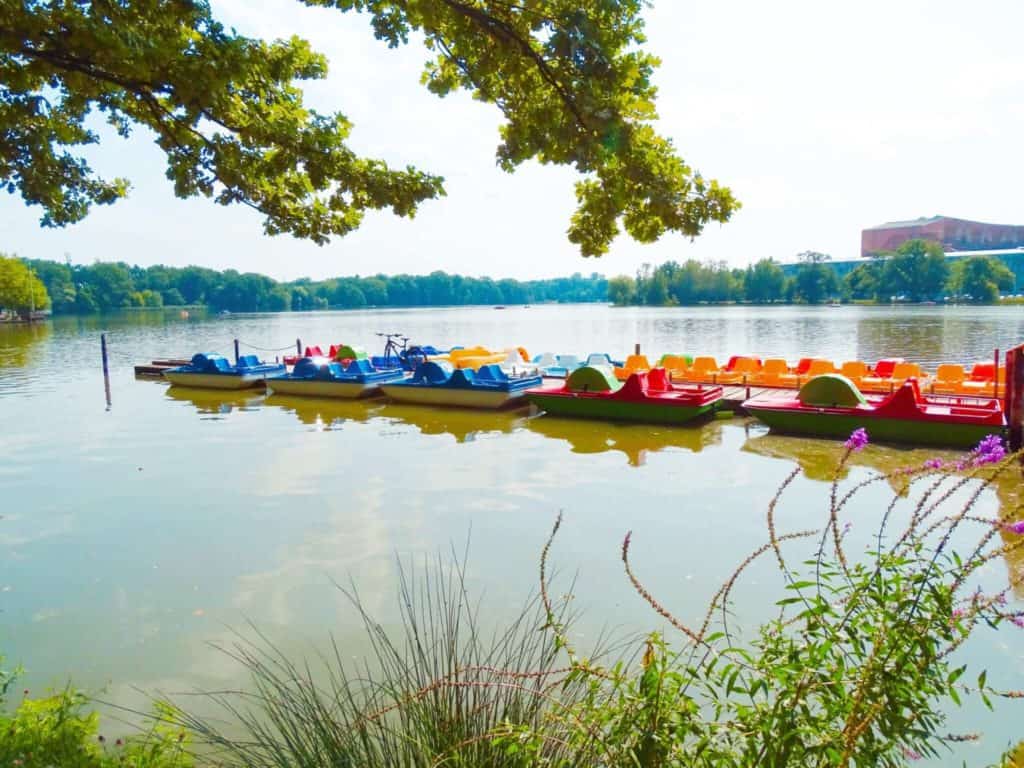
Right beside the Nazi Rally Grounds lies this pretty man-made lake. Spend an hour in a pedalo with a beer in hand as the perfect antidote to learning about the gruelling history nearby. Pedalo hire is €12 an hour.
Local’s tip – there aren’t any shops near the lake (only pricier restaurants) so grab some beers, snacks and water from a supermarket in town before. Remember that most things are closed Sundays so, if that’s when you’re visiting, visit Central Station where there’s a small supermarket open 7 days a week.
9. See the world’s oldest globe
I didn’t hear about this until after I’d left so on my list for my next Nuremberg trip is a visit to the Germanisches National Museum where it’s housed. The globe dates back to 1492 and is so ancient it doesn’t feature America (as Europeans hadn’t got their hands on it yet)…
10. Climb Nuremberg Castle & see the view
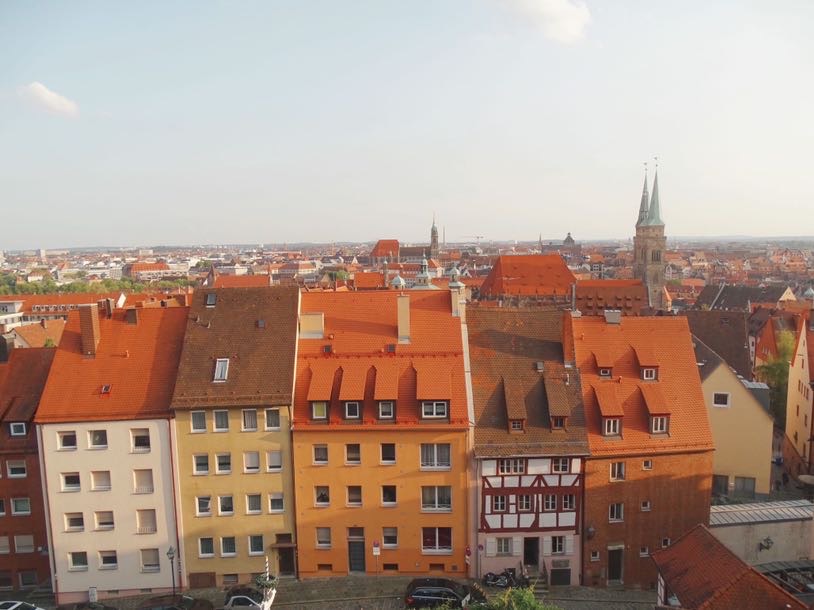
No Nuremberg travel guide would be complete without including Nuremberg Castle. Things to do at this royal residence dating back to 1050 include wandering the courtyard, visiting Castle Chapel, admiring the rose gardens, and exploring Sinwell Tower and the Deep Well.
Read next: a complete guide to visiting Nuremberg Castle
Local’s tip #1 – find the Castle Gardens hidden towards the back of the complex. Although they’re a little tricky to locate, it’s worth it to escape the crowds and relax in this peaceful oasis. #2 – find the covered walkway inside the old Castle Walls (accessible from the gardens). There’s a lovely viewpoint over Tiergärtnertor Square and Albrecht Dürer House.
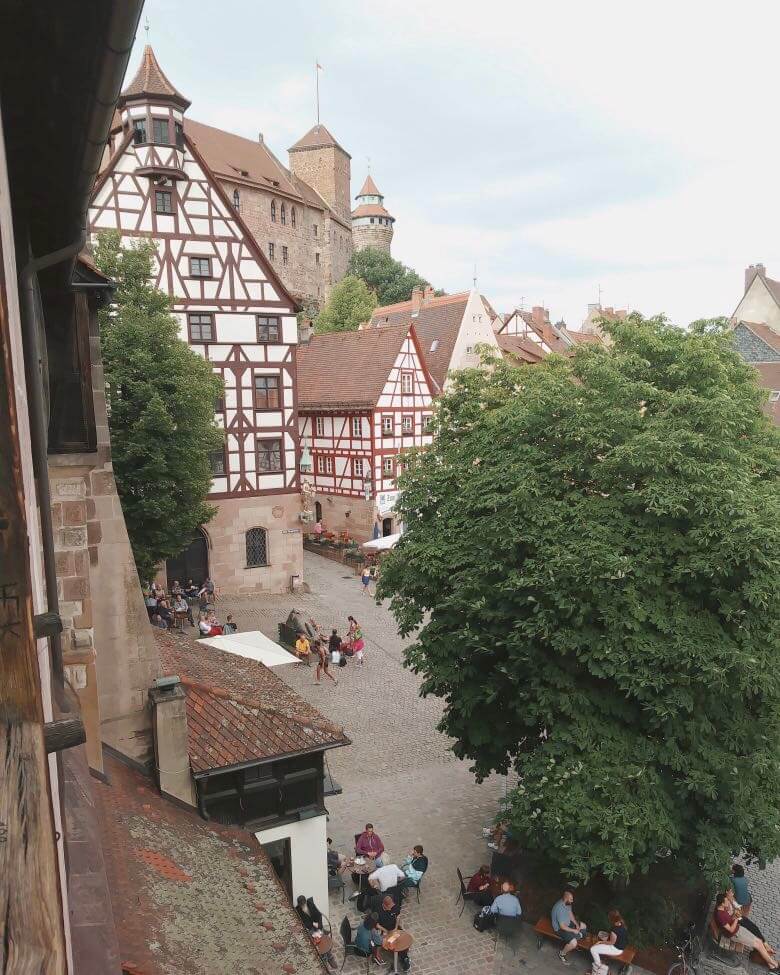
While at Nuremberg Castle, don’t miss the Imperial Castle Museum which contains all kinds of artefacts including medieval armour for horses.
A combo ticket for the Imperial Castle (Chapel, Deep Well, Sinwell Tower and Museum) costs €9 .
Finally, the only thing more photogenic than the Castle itself is the view from the top. I’d recommend a late afternoon visit so you can see Nuremberg bathed in golden light.
11. Sit in Tiergartnertor Platz in the evening
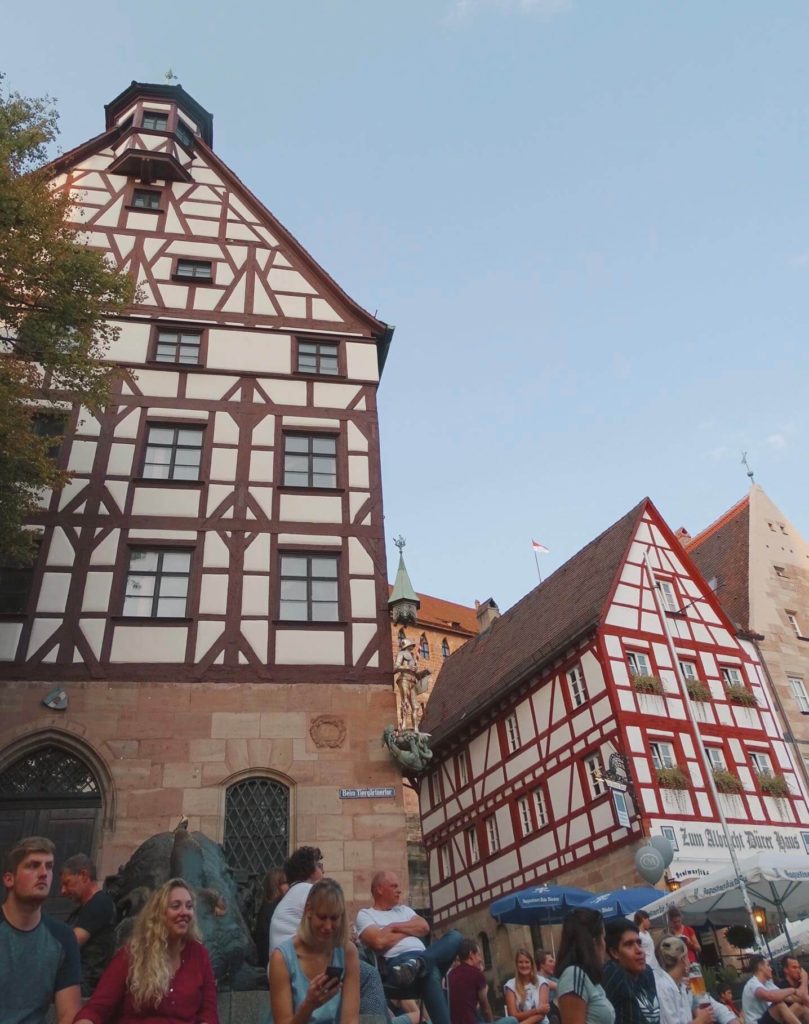
If you’re visiting Nuremberg in the summer, don’t miss Tiergartnertor Platz. The vibe here on a sunny evening is fantastic – people of all ages sit outside, drink and chat.
Local’s tip – Make sure to try a Hugo, my favourite cocktail. It’s a German staple made of Prosecco, elderflower and mint – so refreshing!
12. Browse Market Square
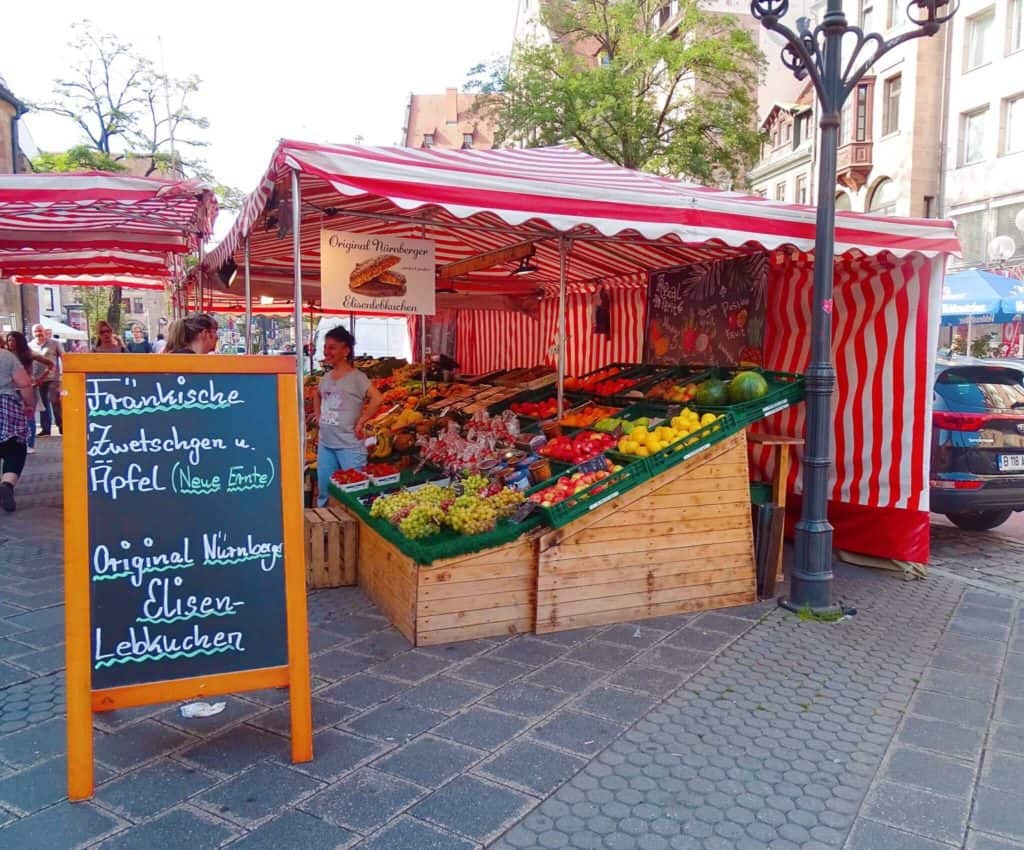
Known in German as the Hauptmarkt, these red and white stalls cover the city centre. Nuremberg is famous for its Christmas Markets but even if you visit outside of December, you’ll be able to stock up on German treats.
Local’s tip – the lebkuchen (gingerbread cookies) here are phenomenal.
13. Visit Albrecht Dürer House
Albrecht Dürer was one of Nuremberg’s most influential residents, central to the German Renaissance and remembered for his paintings and print works. The timbered house beside Tiergärtnerplatz that he lived in for almost 20 years from 1509 to 1528 has been converted into a museum dedicated to his work. It’s free with a Nuremberg Card or you can pay €6 to go inside.
14. Fembo House City Museum
Fans of history, art and culture will be in their element at the Fembo House City Museum (Stadtmuseum Fembohaus) in Central Nuremberg. Built in the 1590s, the only serving Renaissance merchant’s house in the city comprises beautifully preserved rooms that tell stories about Nuremberg through the ages.
Entry costs €7.50 (or free with the Nuremberg City Card). Listening to the audio guide is a must to learn about the relics and history of the city spanning almost 1,000 years.
15. Check out some museums
There are endless museums in Nuremberg , some of the best being the Germanic National Museum, Nuremberg Transport Museum, the Jewish Museum of Franconia (a quick Metro ride away in the next town of Fürth), the Deutsche Bahn Museum (German Train Museum) and the Toy Museum. These make for great rainy day activities in Nuremberg.
16. Rub the Schöner Brunnen ‘wish tower’
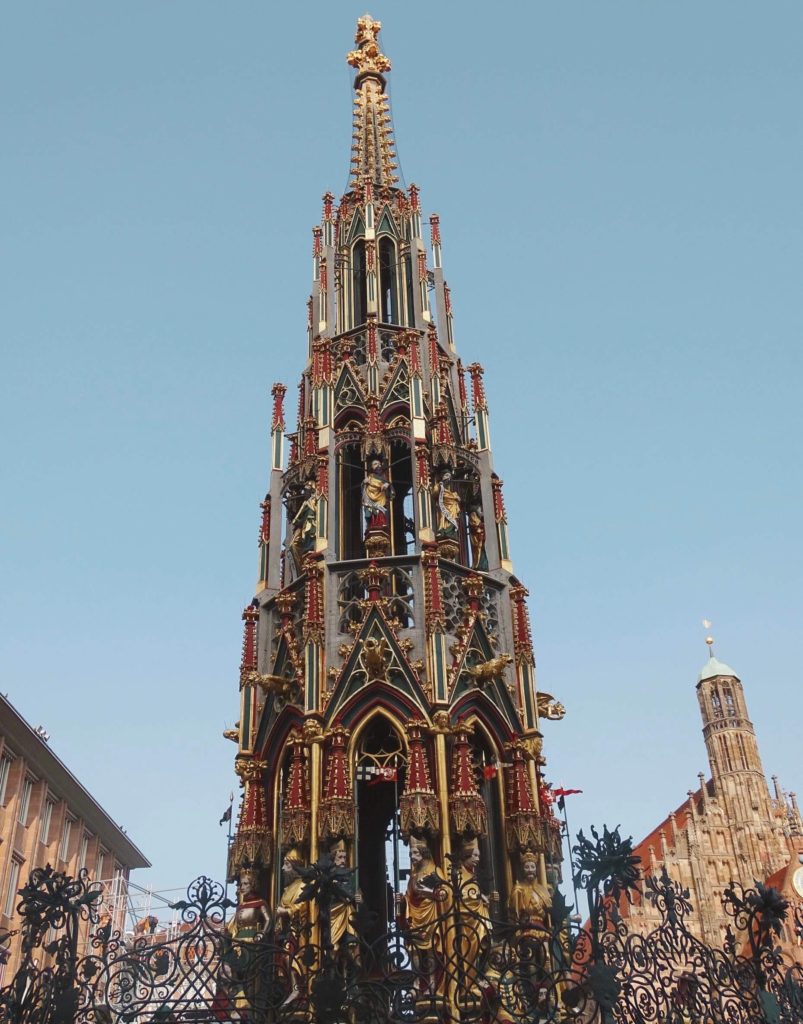
In Nuremberg’s central square, you’ll find the Schöner Brunnen which translates as ‘beautiful fountain’. It’s also thought to grant wishes if you turn the golden ring on the fountain grille three times whilst making your wish. Why not?
17. Tour the cellars
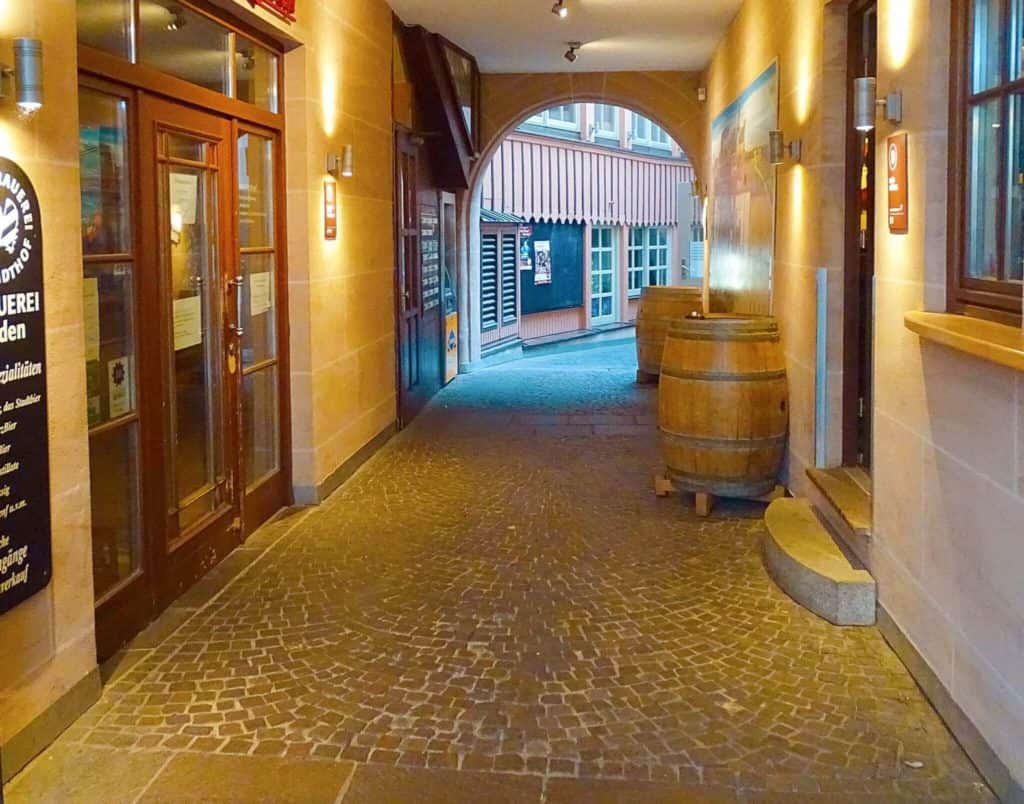
Back in the day, a law was passed that anyone who wanted to sell beer had to have their own cellar – thus, underneath Nuremberg is a maze of storage rooms. You can explore them during a rock-cut cellar beer tour where you’ll sample the different brews. During World War II, the cellars were also used as bunkers to keep people and treasures safe. This included paintings and artefacts from the churches.
18. Historischer Kunstbunker (Historic Art Bunker)
Another creative use of a historic bunker is the Kunstbunker or, in English, art bunker. Its history dates back to WWII when important paintings were hidden 24 metres below the castle to keep them safe. Not only was the mission successful but the bunker has become one of the top tourist attractions in Nuremberg.
The museum can be accessed only as part of a tour with a local guide which is a great way to learn more about the bunkers and wartime bombings of Germany that flattened 90% of Nuremberg but, thankfully, didn’t reach the art. English tours are daily at 3.30pm and cost €9.50, or get 50% off with the Nuremberg City Card.
19. Find the quirky statues
There are at least 25 unusual statues in Nuremberg . Keep your eyes peeled for rabbits, rhinos, chickens, bright blue horses and more. Some are based on ancient designs by Albrecht Durer, others make reference to Germany’s history of war and peace, and the modern art designs will require you to use your imagination!
20. Wander the bridges & the ‘love island’
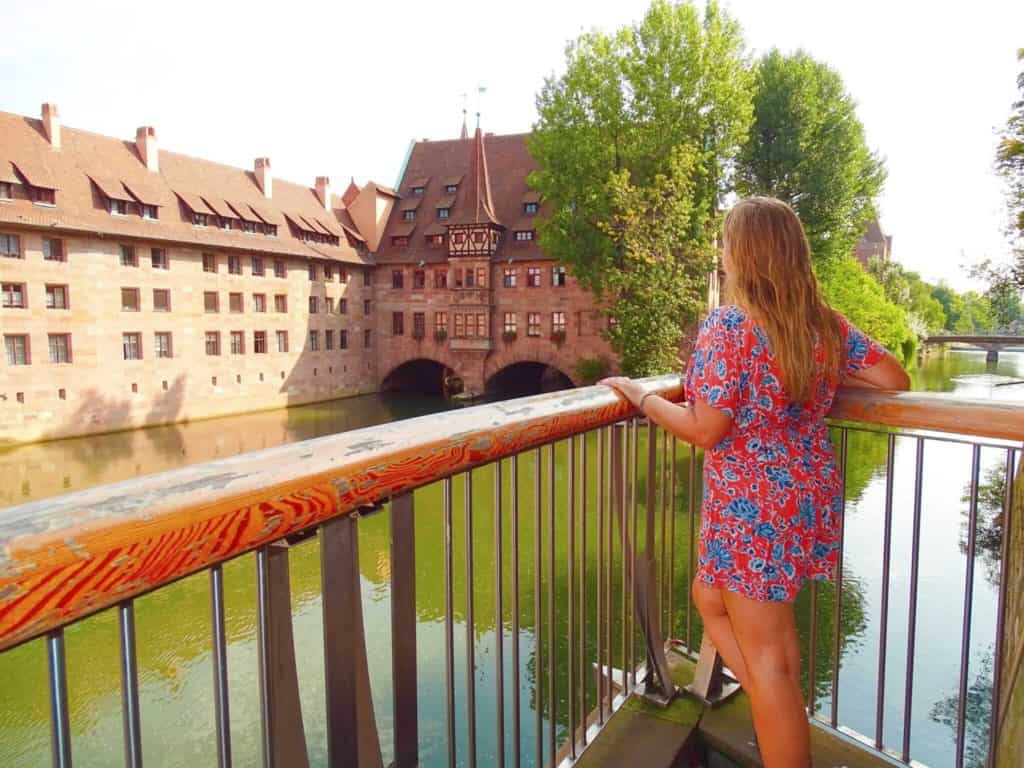
There seem to be endless bridges with exceptional views in Nuremberg. Above I’m looking over at Heilig Geist Spital building, an old 1300s hospital that’s since been restored. If a busy itinerary is getting to you, one of the best things to do in Nuremberg is relax on the ‘Liebesinse’ or ‘love island’ – a nearby island of grass reachable by bridge.
21. St. Sebaldus Church
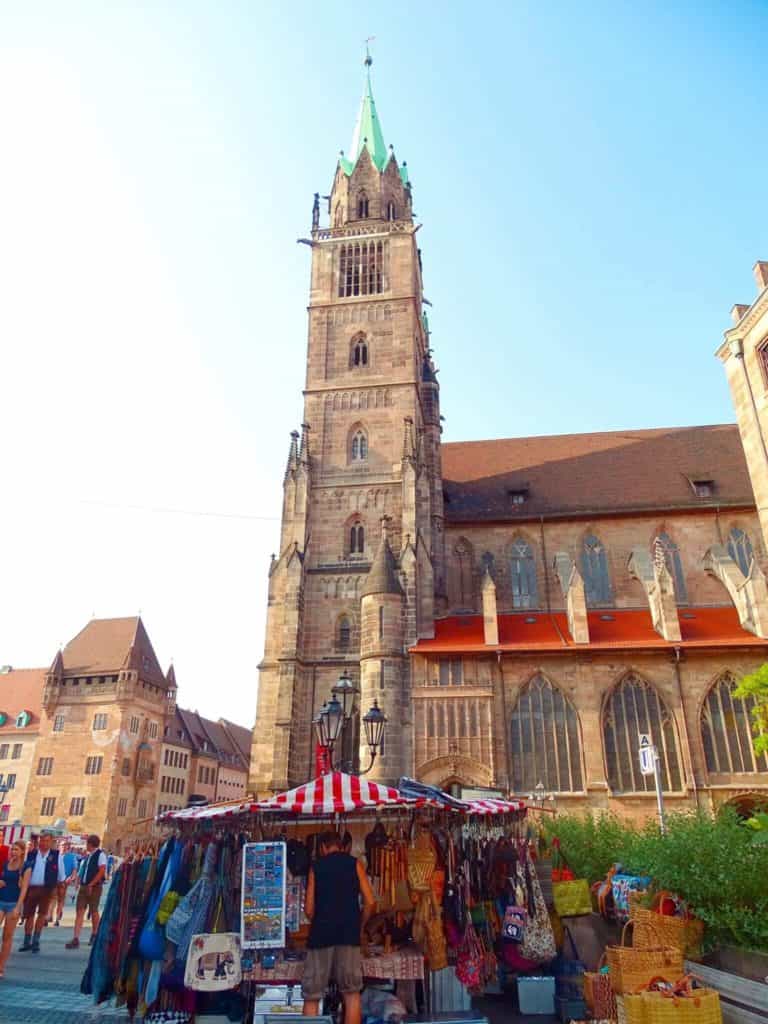
As well as the Frauenkirche and Lorenzkirche, this is the other important church in the city. Like the others, it’s pretty and gothic.
22. The Pigeon Museum
Nuremberg is awash with museums but the Pigeon Museum may be the quirkiest. There are an incredible 120,000 pigeon items to browse including 4,000 porcelain figures. You’ll also see paintings, stamps, postcards and more. Visiting is certainly an alternative thing to do in Nuremberg for a rainy day. Admission is free. It’s only open one weekend a month between May and August so check the details before visiting.
23. Nuremberg Christmas Market
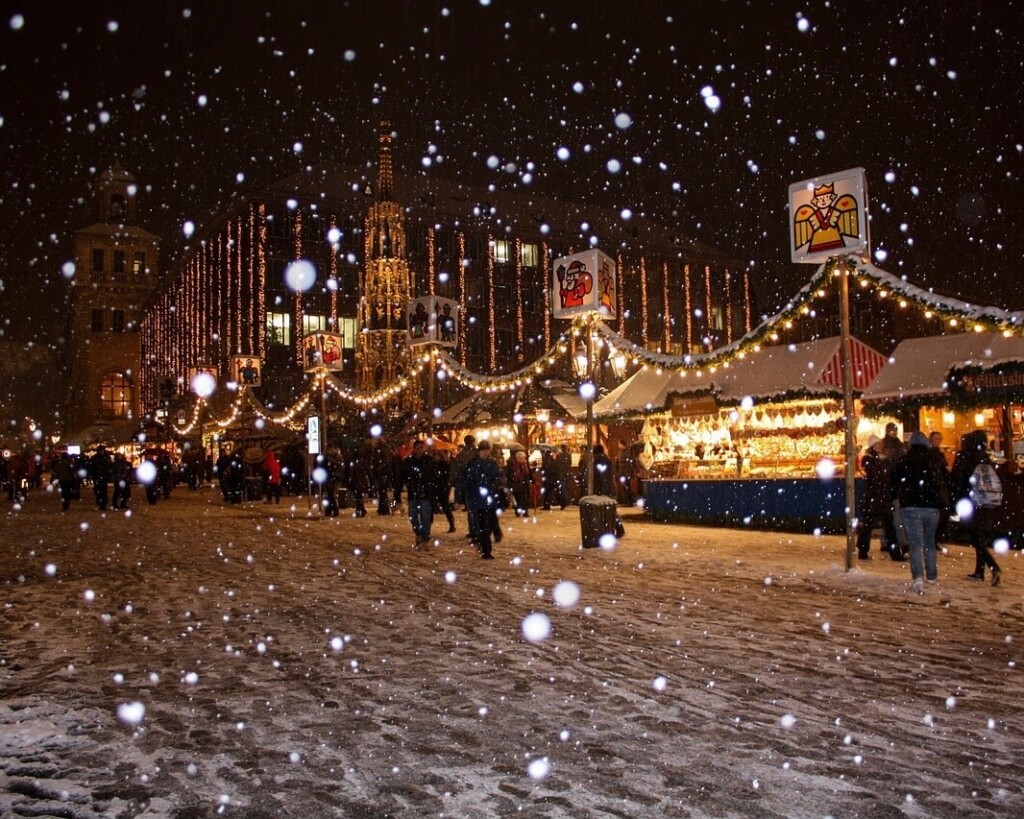
Of all the things to see in Nuremberg, there are few sights more iconic than Nuremberg Christkindlesmarkt illuminated in the winter. Steam rises from vats of gluhwein, people huddle together with their loved ones, and the sweet scent of lebkuchen and almond cookies fills the air. It usually runs from 26 November to 24 December although check the exact dates on the website prior to your visit. It’s one of the world’s most popular Christmas markets so it may be worth planning your trip around!
24. Try another festival
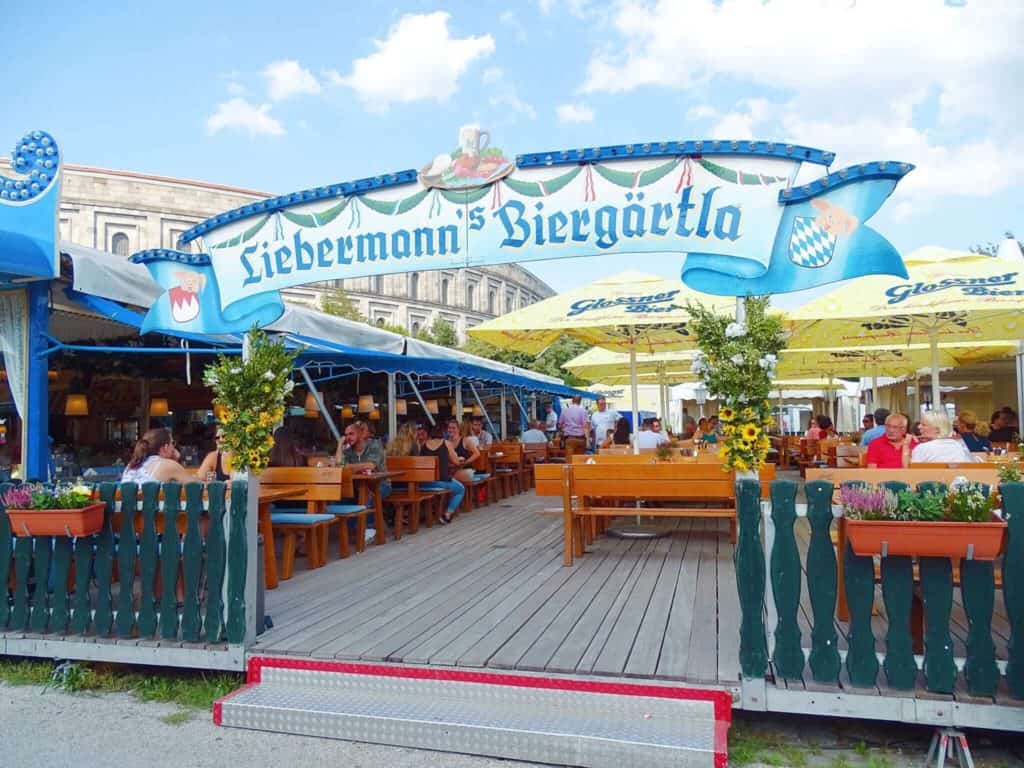
If your visit doesn’t coincide with the Christmas Market, don’t despair because there are events in Nuremberg year-round. There are a few recommended by my sister after her time living there:
- Volksfest (August-September) – visit for fair rides, food stands and beer tents
- Old Town Festival (September) – celebrating local traditions and regional food, this is the ideal place to sample Franconian classics like onion tart and pressed wine
- Franconian Beer Festival (May-June) – the Castle moat turns into one of the world’s biggest beer gardens. As well as locally-produced local beer, there’s excellent food and fun activities for kids
- Bergkirchweih Fair (May) – this beer festival may be smaller than the Munich Oktoberfest but it’s 55 years older! Almost a million visitors come each year to get merry on regional German beers
- The Nuremberg City Beach (May-September) – with 4,000sq meters of sand and over 1,500+ deckchairs, you can’t say Nuremberg does things by halves! Visit for beach games, bbqs, beers, live music and even a massage tent.
- Nuremberg Wine Festival – thought Germany just did beer well? Think again! Sadly, it tipped down with rain during our visit and we spent most of our time huddled under an umbrella trying to save our drinks from getting diluted with rainwater…
25. Take the 5 Seidla Steig beer hike
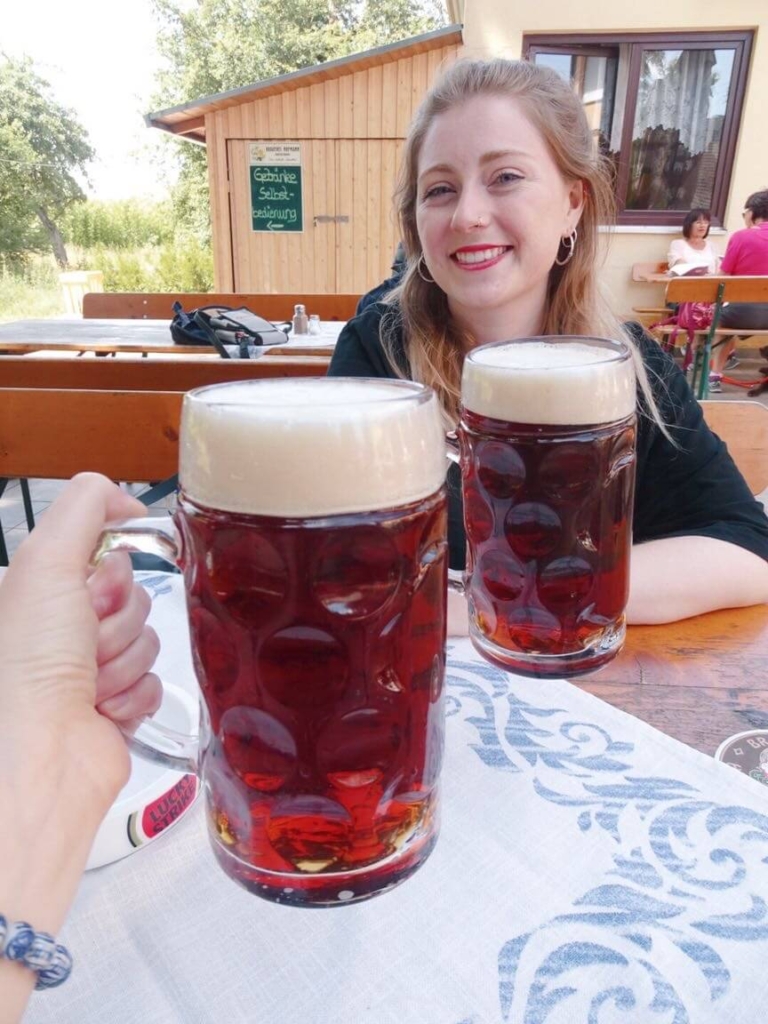
Although this might not make many lists of things to do in Nuremberg, it’s one of my favourite summer activities. If you’re a beer lover (if you’re coming to Germany you surely must be?), this is a fun way to spend a day. You’ll soak up the beauty of Nuremberg’s surrounds AND sink a few steins. The 5 Seidla Steig beer hike connects 5 breweries in the Franconia region of Bavaria. The full trail is 19km so you’d need to stay over in the area to visit them all. We did a condensed version as a day trip from Nuremberg, visiting just 2 breweries. To take the beer hike, catch the R21 regional train to Weissenohe to Weißenohe train station . The first brewery, Frankenweg, is just meters from the station. The other breweries to visit are:
- Brauerei Friedmann
- Brauerei Lindenbräu
- Brauerei Hofmann
After our hike, we managed to catch a local shuttle bus (that looked more like someone’s car) back to the station. It was a fun day out with fantastic German beer and beautiful scenery.
Local’s tip – pick up a stamp card at the first brewery. If you get all 5 stamps, you’ll be able to purchase a commemorative stein for €10 .
26. Tour the parks
To explore the greener side of Nuremberg without going as far afield as the beer hike, check out some of the city parks. There are nine main parks in Nuremberg , one of our family favourites being Wöhrder Lake and Wöhrder Meadow . The lower area is popular with walkers and cyclists while the upper meadows are home to rare plant and birdlife. Take a sunset walk through the meadows, stopping for a dinner picnic, game of frisbee, or refreshing beers beside the water. Another excellent park is Stadtpark , 10 minutes from the Central Station on the U2 line. Here you can visit the impressive Neptune Fountain, hire bicycles, and refuel at the farmer’s market and cafe by the lake.
27. See modern art at Neues Museum

Despite the name, Neues Museum is more of a gallery than anything else. It showcases art and design from the 1950s to the present day from paintings to sculptures, photography and video art. Entry is €7 or free to under 18s. It’s not far from the German National Museum (nearest station Lorenzkirche). Visit both to compare historic and modern Nuremberg.
28. Shop and eat in trendy Gostenhof (GOHO)
Named after SOHO, this quirky area of Nuremberg has lots of cool cafes and outside drinking areas. Although it’s not on many tourists’ radars, any local will know it – especially if they’re under 35! Gostenhof is an area with a conscience: browse vintage shops like bambiboom , upcycling stores like edi m , and no-waste shop, ZeroHero . Finish with hipster coffee at Machhörndl Kaffee.
Where & what to eat and drink in Nuremberg
There are some great eateries in Nuremberg where you’ll find a balance between traditional German food and world cuisine. Here are some of my top picks:
29. Pockets Nurnberg
This trendy cafe serves the best sweet and savoury baked goods in town as well as speciality coffee. You’ll find some German specialities as well as croissants, doughnuts and all the other coffee shop favourites. There are options for vegans including plant milks. Close to Lorenzkirche, Pockets is a central spot to refuel between sightseeing.
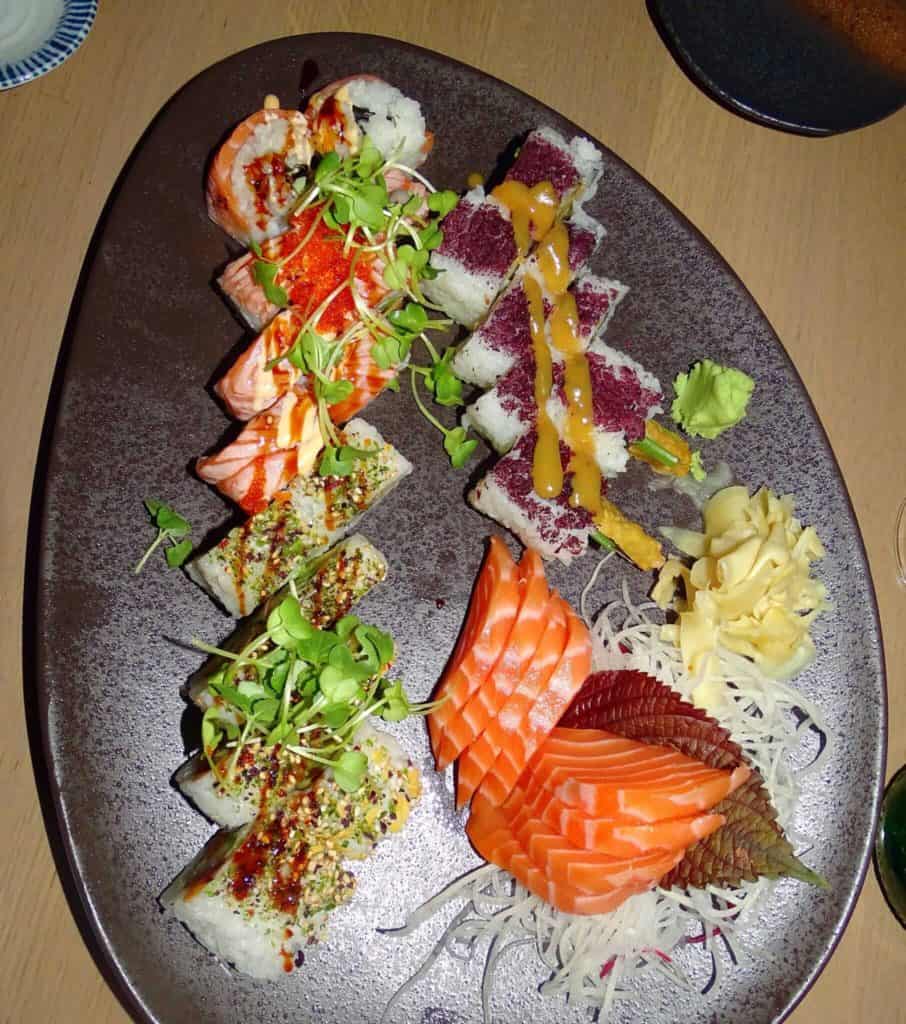
Kokoro is a Japanese restaurant with sushi to die for, as well as lots of other authentic Asian dishes. If it’s good weather you can sit outside by the fountains. Dinner for two with cocktails came to €50 so it wasn’t the cheapest, but was worth every penny.
31. Padelle d’Italia
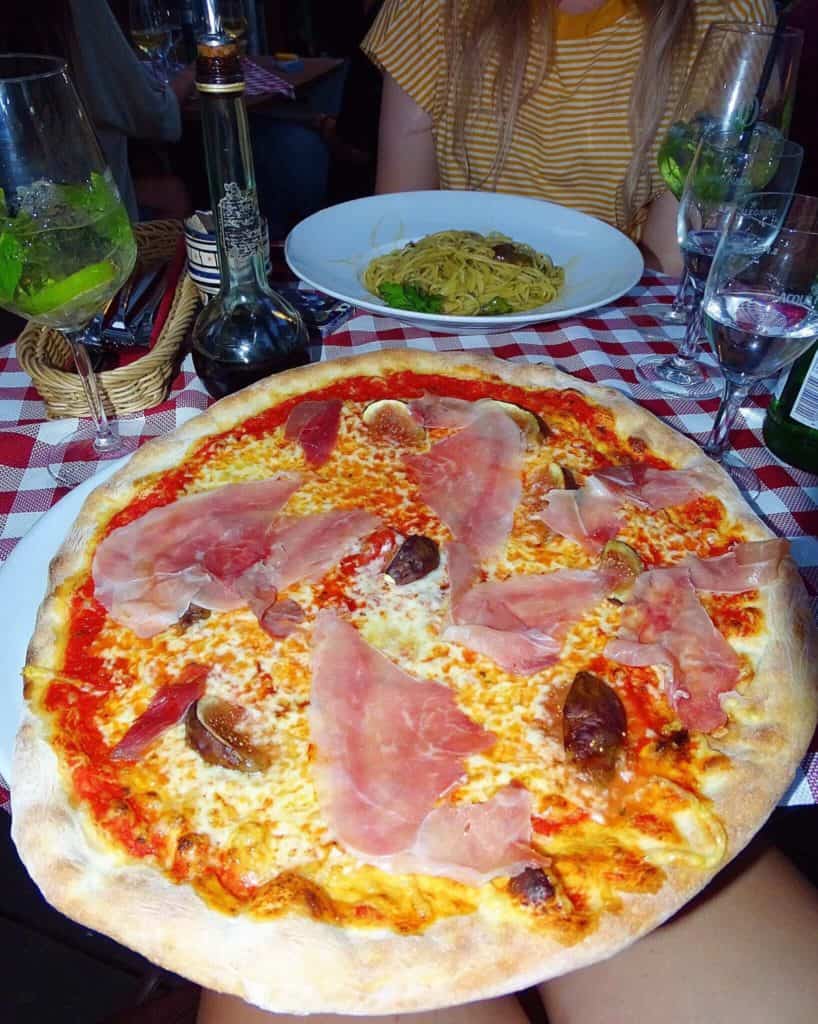
For about €10 per main dish, you’ll tuck into enormous pizzas as well as pasta dishes and Italian starters like tasty bruschetta. It’s a cute vibe at Padelle d’Italia with shelves stocked to the ceiling with wine bottles.
32. Sample Lebkuchen
Don’t leave Nuremberg (or Southern Germany for that matter) without trying lebkuchen. This is a type of German cookie flavoured with honey and spices. The making of lebkuchen has been traced back as early as the 1200s in Nuremberg. With this much practice, how could it be bad?
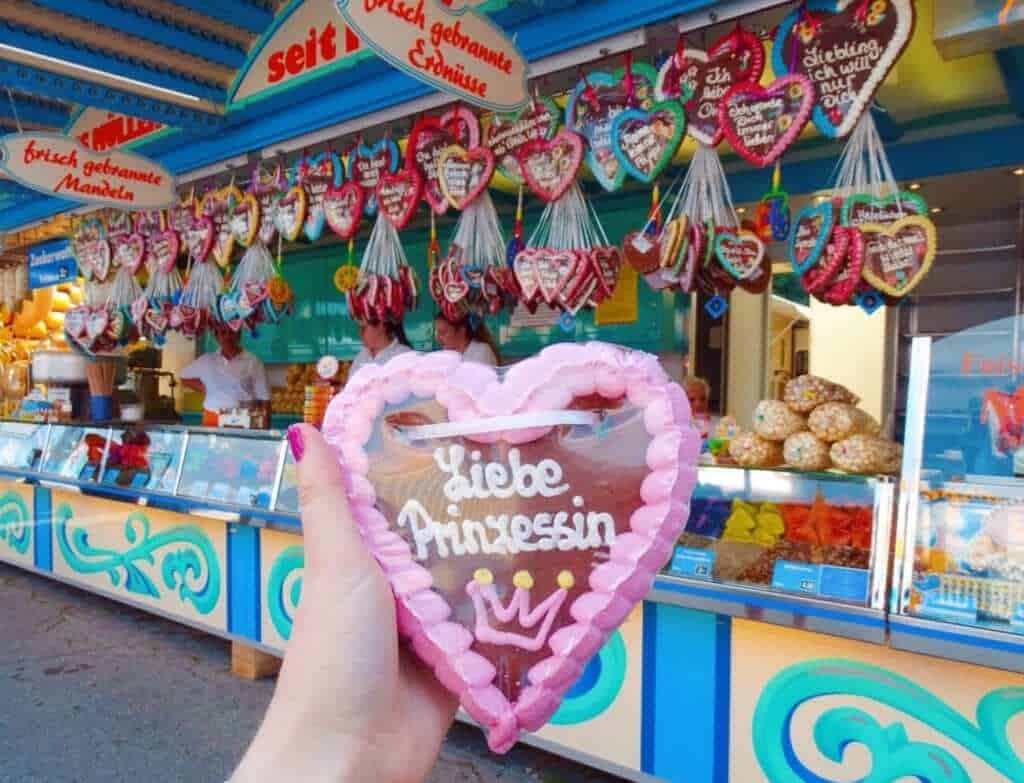
You’ll find lebkuchen sold in adorable Nuremberg shops and – the more touristic option – as heart-shaped cookies like the ones pictured above. After eating mine, I was told these are usually kept as souvenirs rather than eaten. Whoops!
Local tip – although Bavaria is generally not great for vegans, there’s actually quite a bit of plant-based food in Nuremberg. After 5 years living there as a vegan, my sister helped me put together this guide to vegan food in Nuremberg .
Take a day trip from Nuremberg
As well as it being easy to get to Munich in a day, you can also reach typical Bavarian towns from Nuremberg. These are all small enough to explore during a day. Some of the best are:
- Rothenberg ob der Tauber – 1.5 hours by train
- Bamburg – 38 minutes by train
- Regensburg – 1 hour by train
- Wurzburg – 1.5 hours by train.
Check out my Wurzburg itinerary here.
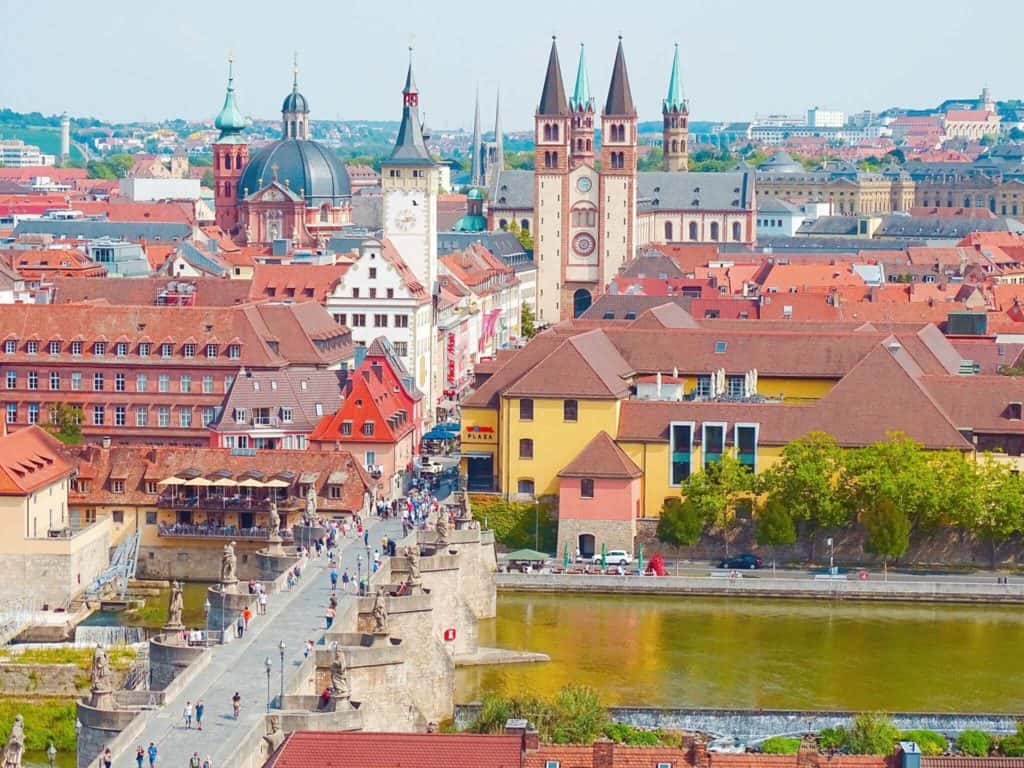
I hope my guide has filled you in on the best activities in Nuremberg! Have a fantastic trip – I know you’ll love your stay.
Thanks for reading my Nuremberg travel guide!
If you liked my guide to visiting Nuremberg, please share it 🙂
Check out my other Germany posts:
- A complete guide to Munich
- 2 day Hamburg itinerary
- Wurzburg travel guide
- The German food to try
- Best food in Hamburg
See you next time for more adventures,
Ps. Liked my Nuremberg travel guide? Pin it for later!
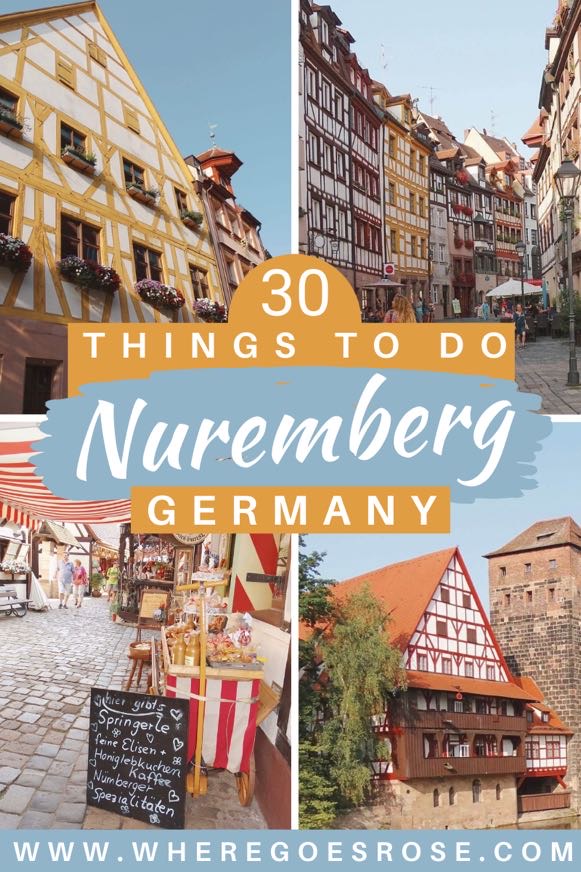
TRUSTED RESOURCES FOR VISITING GERMANY Getting around by air – I use Skyscanner to find the best-value flights, using the ‘search by month’ tool to find the cheapest dates. You can also use the ‘to anywhere’ feature if you’re flexible on where you’re going. Driving in Europe – use Rentalcars.com to compare car rentals in European countries (and all around the world). For trains, I use RailEurope . The search feature allows you to compare prices, and they show live departure times on the website. For buses, I use FlixBus . Find journeys between European countries from €1! Use Omio to compare trains and buses in one search. It’s so handy! For hotels and self-catering apartments, I use Booking.com . You can filter by review score and price to find the best-rated budget places. For hostels, I use Hostelworld . To save money on accommodation, I use Trusted Housesitters , a website that connects homeowners going away and travellers who can sit their homes & pets. Browse tours and activities on GetYourGuide . Need travel insurance ? I use True Traveller (for UK & Europe residents) since it’s some of the most affordable insurance out there but still covers everything you’d need including various activities, valuables and pre-existing conditions. Unlike some companies, they insure you if you’re already travelling / don’t yet have your flight home booked. Get a quote . For travel insurance for other nationalities, I recommend Hey Mundo and for long-term digital nomad travellers, I suggest Safety Wing . Check out my resources page for more travel discounts and budget tips from my 10+ years on the road!
Rose is a solo traveller from the UK who has been on the road since 2015. She wants to show other women that solo travel isn't scary and doesn't have to be expensive! Rose has lived in Mexico, Canada and all over Asia, seeking out food, bubble tea and street art wherever she goes!
11 thoughts on “ 32 Best Things To Do In Nuremberg By A Local (2024) ”
Love your photos! The colours are amazing! GLT ❤️❤️❤️
Thanks Georgia and sorry the late reply! Glad you enjoyed the blog. #GLTLove!
My boyfriend and I are going to Nuremberg in October so these tips will come in handy! It’s such a cute city.
Hey Sabina! So I just saw your comment but I hope you have/had a great trip. Let me know if you need any more tips!
Amazing blog! I’m obsessed with researching and doing little presentations whenever I have a trip planned and this one really helps me find all the information I need! The photos are so beautiful! Thank you for sharing it with us 🙂
Hi Martina, thanks for reading and commenting! Hope you have a lovely trip 🙂
Hi – I loved your blog. Do you have any insight into Rothenberg ob der Tauber ?
Hi Lisa! Thanks for reading & glad you enjoyed it. Sadly not: it’s still on my bucket list! I hope you can find some useful info before your trip 🙂
Quite a long article but informative 🙂 Just came from the city. Impressive.
These are great ideas, Rose. My siblings and I will be in Nuremberg in July and we will use your blog to decide where and how to spend our time. Thank you!
Enjoy your trip!
Leave a Reply Cancel reply
Your email address will not be published. Required fields are marked *
You can see how this popup was set up in our step-by-step guide: https://wppopupmaker.com/guides/auto-opening-announcement-popups/

Germany Footsteps
Top 30 Things To Do In Nuremberg [Don’t Miss Them!]
Going to Nuremberg (or considering it) and want to know all the top things to do in Nuremberg Germany? We have you covered! Below you will find our guide to all the best tourist attractions in Nuremberg Germany to plan your ultimate trip.
Nuremberg, or Nürnberg as it’s known in German, is Bavaria’s second largest city and I think underrated as a tourist destination. I somehow had never even heard of it beyond the Nuremberg Trials before researching my first trip to Germany!
But this makes it all the better when you arrive in this city. There’s a fabulous range of places to visit around Nuremberg and you definitely won’t be bored. From top museums (I’m looking at you German National Museum) to learning more about the famous Nuremberg trials or seeing the Nazi Party Rally Grounds to enjoying one of the top Old Towns anywhere, you’ll have plenty to do.
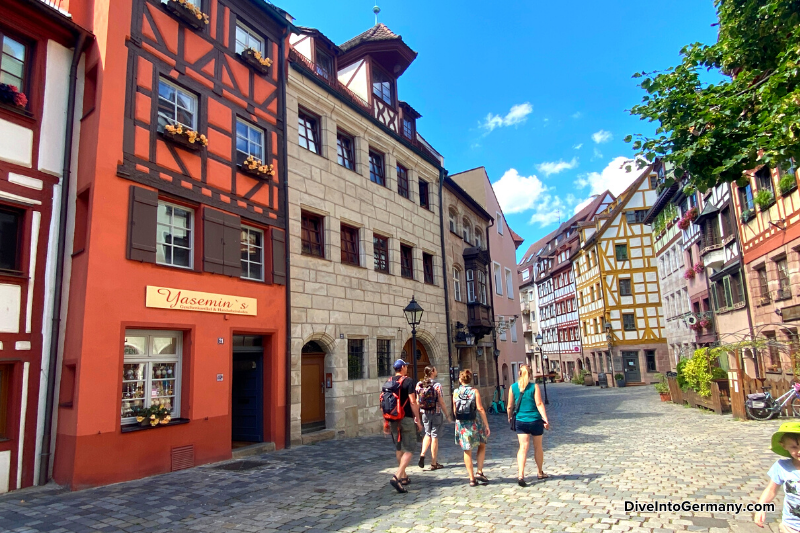
If you have kids, there are also great fun things to do in Nuremberg Germany that they will love.
Nuremberg has a long and fascinating history and, in my opinion, there really is nothing better than strolling around the Old Town, looking out for the gorgeous half-timbered houses, churches and more while taking in many of the sights and attractions that call this area home.
Below, you will find our Nuremberg travel blog with everything you need to know about the best things to do Nuremberg Germany offers as well as the best places to stay for your ultimate vacation in Nuremberg! There is also a handy map of the places to visit in Nuremberg Germany and a one day in Nuremberg itinerary for people short on time.
Let’s start!
Traveling to Germany? Click here to download your free Germany Trip Planning checklist . We’ll help you get ready for your trip!
Table of Contents
An Introduction To Nuremberg
Nuremburg is the state of Bavaria’s second largest city (after Munich) with over half a million people. It’s located in the northern part of Germany’s biggest state and there is a huge array of places to see in Nuremberg that appeal to tourists.
Called Nürnberg in German, Nuremburg has a long and interesting history. First mentioned in official records in 1050, the city started earlier when the Kaiserburg (Imperial Castle) was built about ten years earlier by Henry III, the German king. A settlement started around the castle and this was the beginnings of Nuremberg.
Henry III became the Holy Roman Emperor in 1046 and Nuremberg started its reign of being the unofficial capital of the Holy Roman Empire, and the preferred home of most German Kings. Their crown jewels were kept here and many wonderful buildings were built here making it quite the treasure trove. This made it an attractive place to live for artists which helped further increase Nuremberg’s treasures.

The city became a free imperial city in the 13th century and it had a few hundred years of financial and cultural growth. By 1806, however, it had stopped being an imperial city and became part of the Kingdom of Bavaria.
Later in the 19th century, Nuremberg began to prosper again thanks to the industrial revolution and becoming home to Germany’s first railway. Their working class became a powerful breeding ground for the Nazi Party years later.
If you’ve ever seen those old black and white films of fanatical Nazi supporters hailing Hitler, most probably the film was taken in Nuremberg. Thanks to this, Nuremberg became the starting point for atrocities such as the boycotting of Jewish businesses and removing German citizenship for Jewish people.
In 1945, the allies bombed the city to basically nothing – it’s estimated over 90% of the city was destroyed.
After World War II, Nuremberg was home to the war crimes tribunal known as the Nuremberg Trials. Reconstruction took place as well using original stones and the Old Town looks amazing today.
Today, Nuremberg is a major commercial centre in Germany with many successful industries. Its position somewhat centrally in Germany means it’s well connected to the rest of the country and there is much to love about a visit here.
You can read more about Nuremberg’s past here.
Top 24 Things To Do In Nuremberg Germany
Here are the best Nuremberg tourist attractions. Read through and select the ones that fit your interests and timeframe. If you only have one day to visit the best things to see in Nuremberg Germany, find our what to do in Nuremberg in one day itinerary below.
I also split the cool things to do in Nuremberg with kids and the things to do in Nuremberg during Christmas into their own sections.
Altstadt (Old Town)

The place to definitely head first when you are looking for things to do around Nuremberg is the Old Town. This area, circled by walls and with the Pegnitz River running through the middle, is definitely my favourite part of Nuremberg. Most of the Nuremberg Germany things to do listed below can be found here.
At the very least, you’ll want to take a long stroll through here.
As mentioned above, much of Nuremberg was reduced to rubble in World War II. However, it’s been rebuilt in a manner fitting of such an old and interesting place. There are many gorgeous half-timbered houses and huge churches, an impressive castle and what can feel like another city underground.

Weißgerbergasse is a particularly pretty street to walk so make sure you include it in your plans. It was also blissfully people free when we visited here, even though the rest of the city was busy.
Kaiserburg (Imperial Castle)
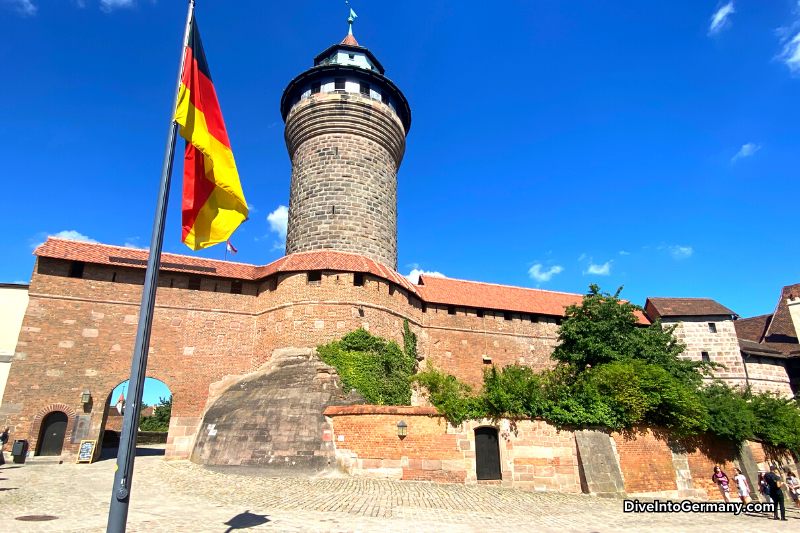
Also referred to as Nuremberg Castle or the Imperial Castle, Kaiserburg is a big castle complex above the Old Town that should be one of your top Nuremberg places to visit.
Always the heart of Nuremberg, this castle once was the centre of power in this region of the Holy Roman Empire. It was the home of the crown jewels and the place where every elected ruler had to hold their first Imperial Diet
Today, this is a great place to explore to learn more about Nuremberg’s past as well as to see more of this city.
Highlights include a tour of the residential wing (Palas) where you can see the renovated knights and Imperial Hall as well as the double chapel. There is also an exhibit here where you can learn more about how the Holy Roman Empire worked as well as the history of the castle until the 19th century.
There is also the Kaiserburg (Imperial Castle) Museum which explains the military history of the museum.
A must do in Nuremberg while you are here is visiting the Sinwell Tower which was built in the second half of the 13th century. It’s built on the most elevated part of the site and gives great views over the Old Town from an observation platform at the top. It’s worth all the stairs

It also is home to photos that show the castle and Nuremberg after World War II ended.
Another popular one of the Nuremberg Germany attractions in the castle complex is the Tiefer Brunnen (Deep Well) which has a shaft that is 50 metres down into the sandstone so that if the castle was under siege, the occupants had access to water. On castle tours, they’ll even prove this to you. You can only visit this via a quick tour.
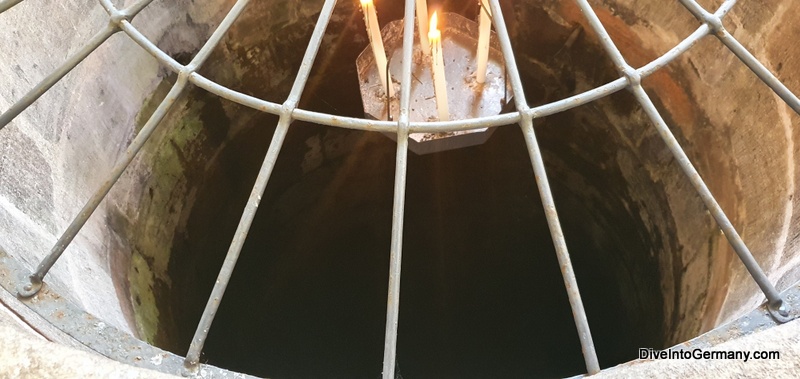
Make sure you also factor in time to enjoy walking around the castle gardens.
The gardens are free and there are small fees for adults (kids free) for the other castle attractions. You can choose just to visit a couple or all attractions.
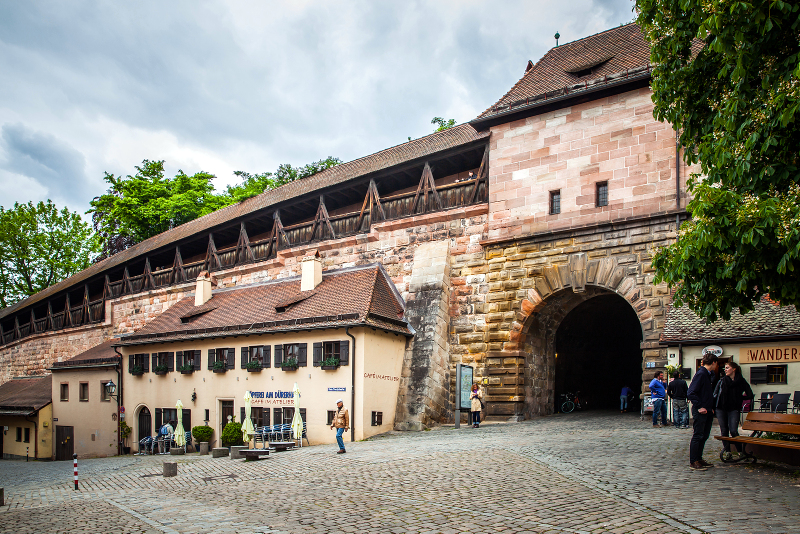
Four kilometres of the original five kilometres of the walls that encircle Nuremberg’s Old Town still stand today incorporating the Kaiserburg and many defensive towers. Four gate towers exist at each of its corner points. All up, it makes for one of Europe’s biggest medieval defensive systems.
Building started in 12th century (although the first fortifcations are believed to have been built here in the 11th century) and ended in the 16th. A huge moat was built around it as well although this was never filled with water.
The walls, in general, have been well preserved and restored and visiting them is a great way to explore Nuremberg.
Finding them is not hard – I recommend you start your visit of Nuremberg’s Old Town at the main train station. From here, you can walk through the walls by the Frauentorturm (“Women’s tower”) which is an old medieval defense tower. It’s a great way to feel like you are going back in time when entering the Old Town.
You can also easily see more of the walls when exploring Kaiserburg and while walking around the Old Town. You can walk on some sections of the walls but not all the way around.
Historischer Kunstbunker (Historic Art Bunker)

The Historischer Kunstbunker is a bomb shelter where priceless art pieces were stored during World War II which worked to keep them safe. Located under Kaiserburg, this shelter was made in one of the existing Medieval rock-cut cellars. Climate control was added to help keep the art in good condition.
Interestingly, this bunker started being built a year before the war started. The opening is hidden inside a home at Obere Schmiedgasse #52 which is where the tours start from today.

You can take a 60-minute tour to explore this one of the Nuremberg things to see and learn how this bunker was built and how the art was kept safe. There’s also information on how Nuremberg was destroyed and rebuilt.
It’s also possible to take tours of more of the underground passages under the Kaiserburg that were built for Medieval defensive purposes.
Find more information here.
Albrecht-Dürer-Haus

One of Germany’s most famous Renaissance painters, Albrecht Dürer, lived and worked at this gorgeous timber-framed house in Nuremberg’s Old Town from 1509 until his death in 1528. It’s the only 16th century artist’s house remaining in Northern Europe.
Five storeys high, this Nuremberg to do has been beautifully restored and is worth checking out even if you aren’t interested in Dürer’s art. The rooms contain period furniture and exhibits of Dürer’s drawings, and you can also see a demonstration of the printing techniques used at the time.
Stadtmuseum Fembohaus (Fembo House City Museum)

This 16th century merchant’s house is the perfect place to learn more about the city’s history. It’s the only surviving large merchant’s house from the late Renaissance period.
This tall building makes for quite a sight from the outside, but it’s what is inside that landed it on this list of the best things to do in Nuremberg. There are over 30 rooms on four levels to explore with original rooms, period furniture and informative exhibits to tell the history and art and culture of Nuremberg over 950 years focusing on the Middle Ages to the 1800s.
There is also a replica of the Imperial Crown and Jewels which used to live in Nuremberg but are now in Vienna.
It’s a beautiful building with some rooms more or less as they were from centuries ago. Spared damage from WWII, it’s worth checking out.
There is an audioguide available for the special exhibition and you can get audioguides on your phone for the main exhibits. Most of the exhibits are captioned in German, with only limited English so the audio guides are strongly recommended.
Felsengänge (Undergound Cellars)

Explore a different part of the city on this one of the top things to do in Nuremberg. Located underneath Albrecht-Dürer-Platz, the Felsengänge is a collection of subterranean passages over four storeys underground. They date back to the 14th century.
They used to house a brewery and beer cellar and then became an air-raid shelter in World War II.
Many of these passages were built under Nuremberg, adding up to 20,000 square metres.
Mostly this was done for breweries in Nuremberg as it used to be law that if you wanted to sell beer, you needed your own beer cellar. With over 40 breweries in Nuremberg in the Middle Ages, that is a lot of cellars. Many joined together and lead to the huge passages existing today.
You can take a guided tour of the passages. Most are in German, but check for English-speaking times . Take a jacket as it can be cold down there.
St Sebalduskirche
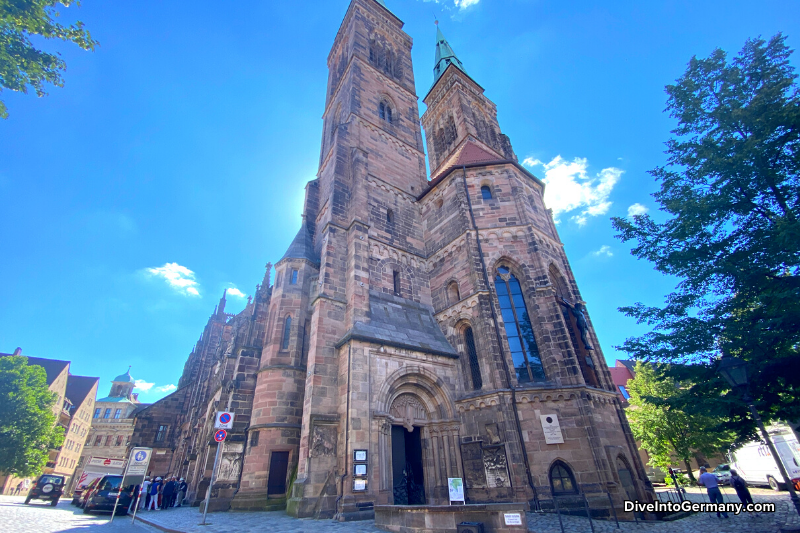
There are many churches in Nuremberg, St Sebalduskirche is the oldest having being built in the 13th century.
Its outside is home to religious sculptures, carvings and symbols. It has quite a unique look thanks to the additions made to this church over the years.

The initial building on the west side is in a Romanesque and early Gothic style whereas the east side was built around 100 years later in late Gothic style. In 1361 when Emperor Charles IV’s son was baptised here, Medieval glass windows were added which are some of the best preserved (and oldest) in Germany.
The church is named in honour of Saint Sebald who is entombed here. You can see his bronze tomb which took 11 years to make in the 1500s.
Visiting here is one of the free things to do in Nuremberg.
Mittelalterliche Lochgefängnisse (Medieval Dungeons)

For a more macabre underground experience, add the Mittelalterliche Lochgefängnisse to your list of Nuremberg Germany tourist attractions. Located in the cellar of the old Nuremberg town hall, you’ll find 12 cells and a torture chamber which were used from 1340-1806.
If you want to know all about the Medieval justice system, come here! All visits are via guide or audio tour and it’s interesting learning how easy it was to torture a confession, send you upstairs to court for a judgement and then you are back for imprisonment or death.
Tours start in a restored Gothic hall in the Old Town Hall. Once downstairs, you can explore the (small and daunting) cells and see torture devices from the time.
From the corridor with the cells, you can actually see the original street level of the road of which this building had been built on top of in the 14th century.
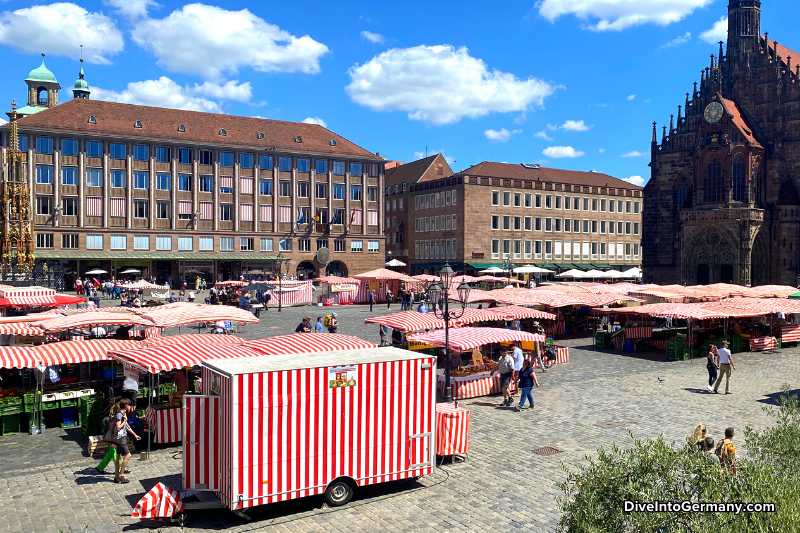
This big main square is in the heart of the Old Town and is definitely one of Nuremberg top attractions. Originally the site of Jewish community, it was built after the Jewish community left or were executed after rounds of Jewish persecution.
In Medieval times, it was ringed with market stalls and today, markets are still held here most notably the massive Christmas Market which fills the entire 5,000 square metres as well as the neighbouring area. It’s reputedly the largest in Europe. It’s been held here since the 1600s.
There was plenty of good looking fruit and vegetables on sale here when we visited.

This square is also home to Frauenkirche, coming up next on our list of things to visit in Nuremberg, and the large Schöner Brunnen (Beautiful Fountain).
For good luck, make sure you touch the golden ring in the wrought-iron gate that surround the fountain. It can be tricky to find. Look for the crowds or look up – it’s quite high and going to be above your head unless you’re very tall. It’s also small.
Hauptmarkt is a great place to wander and hang out absorbing some Old Town atmosphere.
Frauenkirche (Church Of Our Lady)
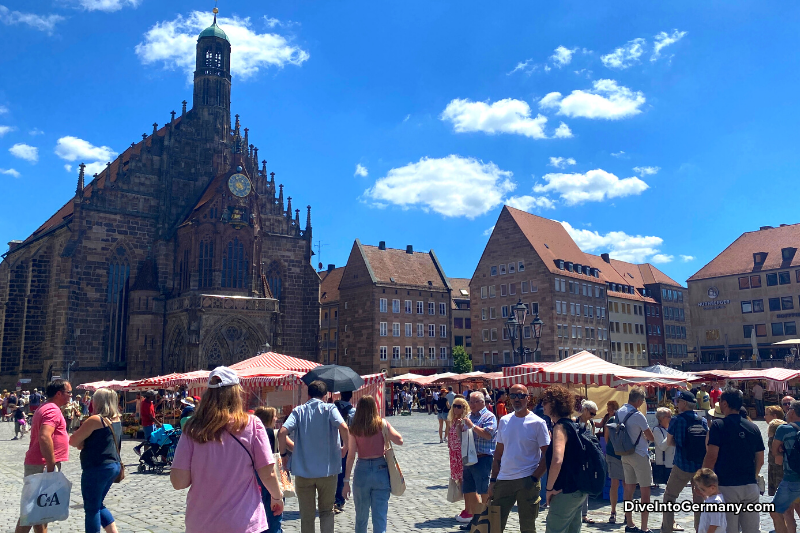
This ornate Gothic church is located at the eastern end of Hauptmarkt and makes for quite a sight. It was built from 1352 to 1362 on the foundations of a Jewish synagogue.
The time to be here is at noon when you can watch the Männleinlaufen which means little men dancing. At this time, on the clock on the facade of the church, little figures come to life playing instruments, ringing bells and seven Prince-Electors strut around Emperor Charles IV. While I wouldn’t call it dancing, it is fun to watch.
This glockenspiel clock was created in the early 16th century and was kept safe during World War II in the art bunker mentioned above.

There is an interesting mix of items inside the church thanks to it switching between Catholic and Lutheran during its time (and then back again).
There are some stone sculptures inside the church from the 1300s as well as some impressive stained glass windows – some of which date back to 1358.
It’s my favourite of the churches on this list because it was a little more compact and felt more welcoming. They are all gorgeous.
Weinstadel (Wine Depot)

By the Pegnitz River, which runs through Nuremberg, sits the gorgeous half-timbered Weinstadel. Meaning wine depot, this building has had many lives including initially as a leprosy hospital when it was built in 1446. At this time, lepers were allowed to enter Nuremberg for just three days at Easter. From 1571, it was a place to store wine and later as housing for poor families.
These days, it is university student housing but it’s still worth wandering by this one of the top things to see in Nuremberg Germany as it’s just so pretty next to the river and surrounding buildings. You’ll forget you’re in a big city.
It’s also quite a striking sight. At 48 metres long, it’s the largest half-timbered building in Germany.
Henkersteg (Hangman’s Bridge)

Next to the Weinstadel, you’ll find a stone tower and Henkersteg, the hangman’s bridge. This tower is what Nuremberg’s hangman called home in Medieval times.
The tower was built in 1320, at what was once the edge of the original city walls by the river. This is because, at the time, the town’s executioner was not allowed to have contact with the “honorable” citizens.
In 1457, a bridge was built between the tower and the opposite side of the river so the executioner could exit his house and cross the river without contact with the rest of the population. Floods destroyed this bridge and it was replaced with the Henkersteg we see today in 1595.
You can walk across this bridge and the tower is now a museum (Henker Haus) detailing the history of law and crime in Nuremberg particularly in the Middle Ages.
Note that the tower that the museum is in is the smaller one pictured above. We tried to visit it on the opposite side of the river at the taller one and that is student residences 🙂

You have to enter Henker Haus to be able to cross the bridge.
The opening hours for Henker Haus (Hangman House) are limited so I recommend you check their site here for the latest hours before visiting.
I found it quite interesting. It’s small, but informative, and does a great job of describing the history of what the executioner used to get up to here. It’s not recommended for children as there are plenty of gory pictures. I went in alone which was the right choice.
Henkersteg has a middle point on an island called Trödelmarkt (Flea Market Island) which was home to a pig market and “junk shops” in the Middle Ages. Today, you can find boutique stores here and this is where you enter Henker Haus from.
Ehekarussell Brunnen (Marriage Carousel Fountain)

Located by the White Tower (a Medieval watch tower built in 1250 which is no longer white), the Ehekarussell Brunnen is a large and interesting sculpture that you’re probably going to love or hate 🙂
This one of the unusual things to do in Nuremberg displays different aspects of marriage over six scenes from falling in love until death. It was cast from bronze in 1984 by Jürgen Weber based on lines by the Medieval poet, Hans Sachs. His original poem can be found chiselled into the work on the tower side.

I definitely love this fountain. It’s interesting and gave us much more to talk about than most fountains. Make sure you check out each individual scene as you walk around it. I don’t recommend it if you are currently contemplating getting married as it doesn’t paint the best picture of it!
Lorenzkirche (St Lawrence Church)

Another one of the religious places to go in Nuremberg, Lorenzkirche is a huge, twin-towered church with the towers measuring 80 and 81 metres from the ground. First built in 1250, the church was rebuilt in a Gothic style from 1439-1477.
While much was repaired after World War II, many of the Gothic elements and artworks were preserved.

While it looks mighty impressive from the outside, it’s also impressive on the inside. It’s quite atmospheric with its sooty ceiling, down lit pillars and more. There are also impressive Medieval stained glass windows including a 9 metre diameter rose window.
There is plenty to enjoy and appreciate in Lorenzkirche. If you speak German, there are free tours that can take you up into the towers.
Germanisches Nationalmuseum (German National Museum)

When you’re ready for some serious museum time, make your way to the German National Museum. Founded in the mid 19 th century to be an authoritative collection of historical artifacts from German speaking people, there is a lot here.
There’s archaeological finds, scientific instruments, arms, armour, books, musical instruments, clothing, toys and basically anything related to German culture and background. Part of the museum is housed in an old monastery which is neatly woven into the museum as an exhibit in its own right.
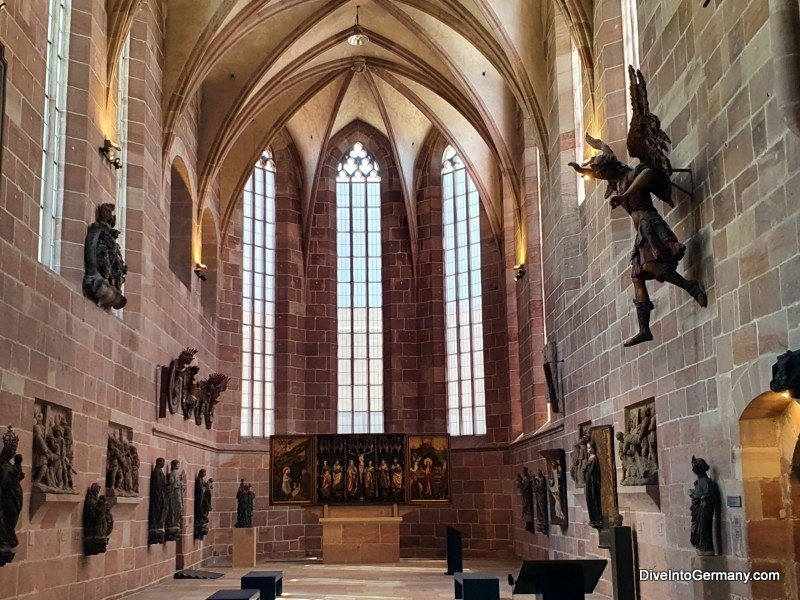
There is so much here that I recommend you visit the info centre on arrival and work out which parts are most of interest for you. You can find the museum’s website here .
Straße der Menschenrechte (Way Of Human Rights)

Next to the German National Museum is the Way Of Human Rights consisting of 30 x 8 metre tall columns along Kartäusergasse. Each column has an article of the Universal Declaration of Human Rights in a different language.
It’s dedicated to both rejecting the things that have happened in Nuremberg in the past (primarily how Nuremberg played such an important role for the Nazi party) and as a reminder that human rights are still regularly ignored in parts of the world.
Neues Museum
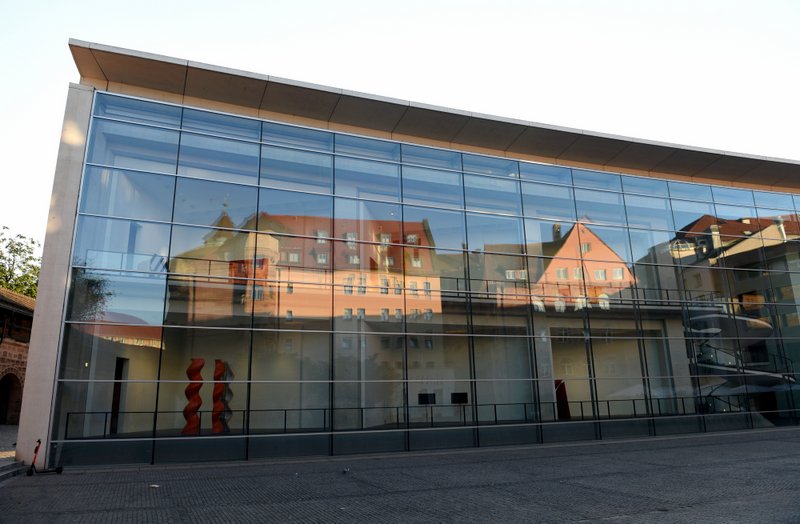
Art lovers will definitely want to add the Neues Museum to their list of must see places in Nuremberg. Located at the southern end of the Old Town opposite the city walls, its known for its 100 metre curved glass exterior that reflects the stone city wall.
Inside, you’ll find a gallery with an impressive collection of contemporary and modern art. Opened in 2000, the building itself is a work of art with its glass exterior, open spaces and a cool spiral staircase.
The art itself is from the 1950s until today. There is a wide range on offer from paintings to sculptures to photography and video art. There is a great range of temporary exhibits too so you can always see something new.
Deutsche Bahn Museum

If you are a railway buff or travelling with kids, this should be right at the top of your list of Nuremberg best places to visit. While I didn’t list this attraction in the kids section below because it will also appeal to adults, this was our kids #2 choice of the best things to do in Nuremberg Germany (after Playmobil FunPark).
Nuremberg was the site of the first passenger train journey in Germany between here and Fürth so this is the perfect location for this thorough and engaging transport museum centred on trains and railways.
Located just outside the Old Town to the south, this is a big museum. The main exhibit centres on the history of Germany’s railway system with plenty of information and items like an 1835 railway carriage (Germany’s oldest as this is when the railway opened between Nuremberg and Fürth). But note that a big chunk of this main exhibit is only in German.
What you’ll probably enjoy are the old trains, carriages and engines. We especially enjoyed the state coaches of the Bavarian King Ludwig II. So fancy!
There is much more to enjoy though. The first floor has a great model railway. The top floor is full of interactive attractions and rail-based play areas that kids will love.
Find the latest opening hours (they do vary) and ticket prices on their site here . You can also read our full review here which I highly recommend. We were a little disappointed by our visit as we didn’t have the right expectations. This will make sure you do!
Memorium Nuremberg Trials

The Palace of Justice (Justizpalast) is home to maybe the best known event to take place in Nuremberg, the Nuremberg Trials.
Courtroom 600 is where the trials took place. Between 1945-1949, 13 trials took place with 199 defendants. 161 were convicted with 37 sentenced to death.
This courtroom was still in use until 2020 but now is part of the centre dedicated to the trials. The main part of the memorial is on the floor above the courtroom. This centre is all about the Nuremberg Trials which details the crimes, defendants and the impact these trials have had on international law.
Most of the information displayed is in German only but a free audio guide is available that covers everything. If you plan on seeing/listening to all of it allow at least 90 minutes (as there’s a lot of sections).

For the courtroom itself, you can see it from the visitors section which matches the vistors and press area for the original Nuremberg trials. The court is still configured as it was when it ceased being a regular court again in 2020. Now it is unused, there are plans to remodel it as it was in 1945.
Do note that the courtroom can be closed during the museum’s opening hours so if it’s important to you to walk inside here, it’s best to check with the museum before going if it will be open for your visit.
It’s well worth a visit to learn more about this historic event. You can find more information on their site here .
Reichsparteitagsgelände (Nazi Party Rally Grounds)
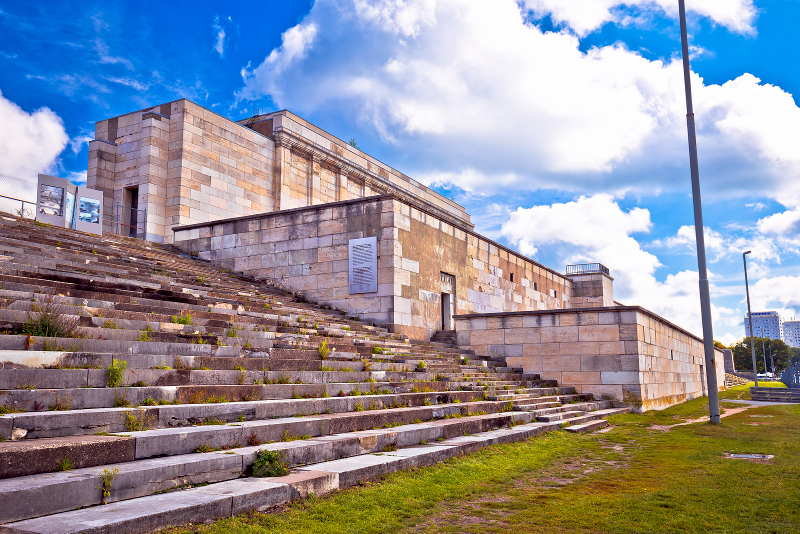
For a big contrast with the last Nuremberg places to see on this list, visit where the Nazi Party was at its peak at its rally grounds.
You’ve probably seen this place before – if you’ve ever see the black and white videos of crowds hailing Hitler, it was here in Nuremberg that these were filmed.
Nuremberg was an important place in Germany thanks to its central location and its status in the Holy Rome Empire which made it important to the Nazi Party who held their annual propaganda rallies here even before they were in power. A congress hall was built here in the 1930s which is now home to the Documentation Centre.
Just to the east is Zeppelinfeld which is where the big Nazi parades and events took place. There is also a 350 metre long grandstand here as well as the balcony where Hitler stood talking to the masses.
The two kilometre long Große Strasse was planned for military parades.
Much of these grounds were destroyed during World War II but enough remains to give you a good idea of the scale of things here.
The Documentation Centre is definitely the place to head to learn more about the history of this area and how it was used by the Nazi Party. It will also give you a great understanding of how the Nazi party came to power and managed to do everything they did.
Once you have finished at the Documentation Centre, you can walk around the grounds where there are information boards telling the history of different parts of the site. It is a decent sized site so get ready for lots of walking.

Note that at the time of publishing, the main Documentation Centre museum is shut and there is an interim exhibit which talks through the various uses of the grounds as well as some brief information on the events that lead to World War II in Germany.
Sometimes, the Zeppelinfeld is closed for events and I suggest you ask when you buy your tickets for the Documentation Centre if this is open – or even better, ring beforehand. We were frustrated on our visit that we walked around for quite awhile in the rain with all the approaches we could find to the Zeppelinfeld closed.
We went back to the ticket office and asked and were told we should have known that it was shut!! This was not anywhere on their website or at the actual site. Hopefully, you have a better experience than us.
If there is only the interim exhibit to see, I don’t think this is worth the entry or the journey here.
There is parking at the site which we didn’t have problems accessing.
Schloss Neunhof
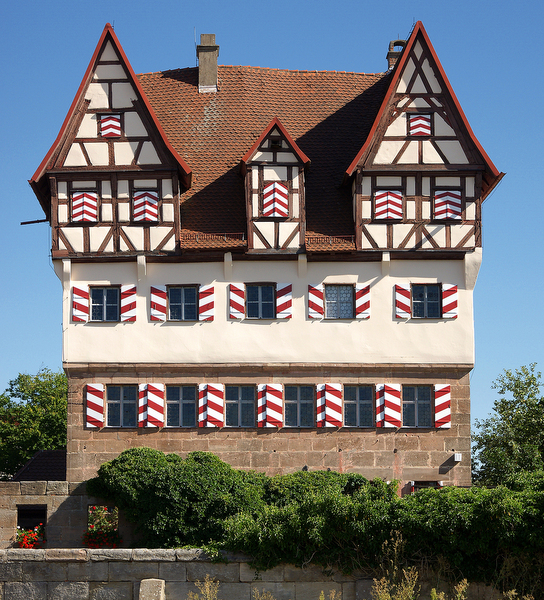
If you are looking for the best places to visit near Nuremberg, Schloss Neunhof is a completely different attraction in this area.
Schloss Neunhof is a well preserved suburban estate which helps tell the story of what summer was like for the city’s noble families from the 16th – 19th century.
This manor house is not just picturesque but has fortifications, a gate, moat and drawbridge. It also has big gardens with stables and more. Inside the house is a castle and hunting museum.
Located about a 20 minute drive from Kaiserburg, this attraction is best for people with their own wheels. At the time of publishing, the building was shut due to renovation works but you can visit the gardens. You can find more details on their site .
Jüdisches Museum Franken (Jewish Museum Franken)
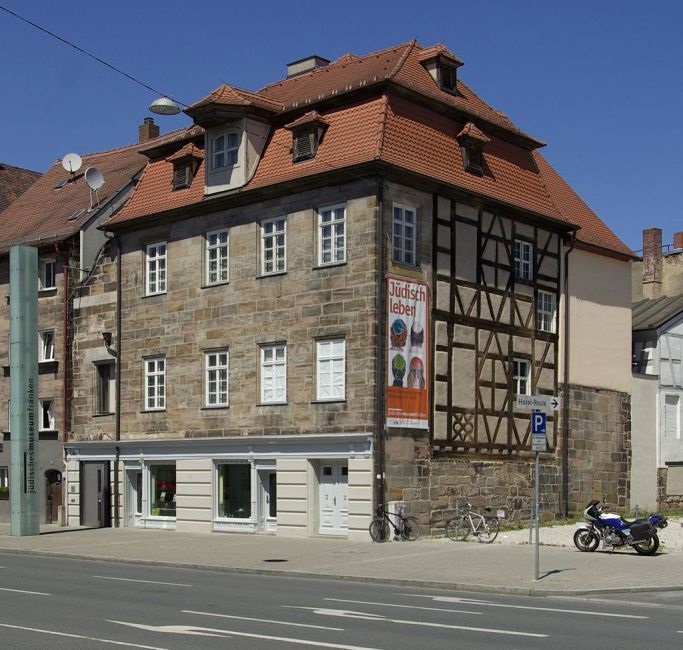
In the adjoining town of Fürth, just a quick train ride away, is this one of the best things to do near Nuremberg Germany, the Jewish Museum Franken.
Fürth used to have the largest Jewish population in southern Germany. In this museum, you can learn the history of Jewish life in this region from the Middle Ages until today.
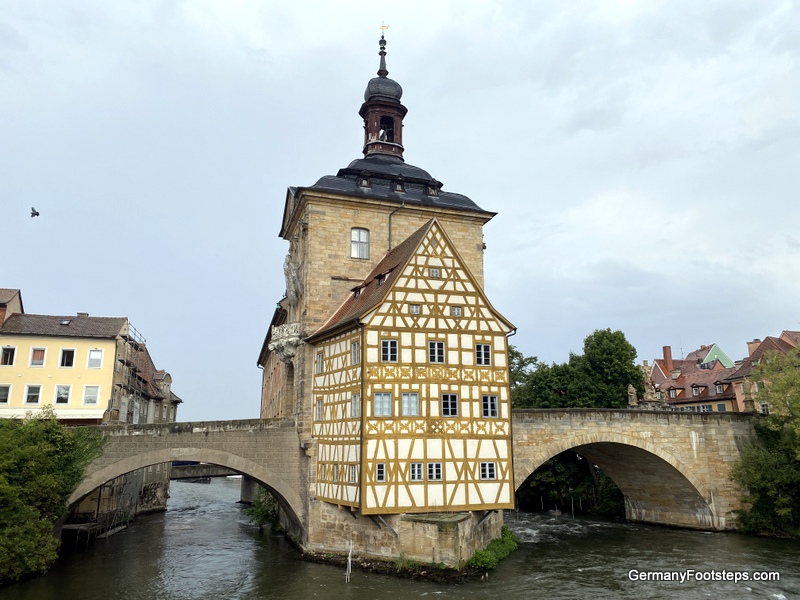
If you are looking for a fantastic day trip from Nuremberg, look no further! Bamberg is a fantastic option. About an hour’s drive or train trip away, it makes for an easy option.
Bamberg’s Old Town is UNESCO World Heritage listed and is full of original buildings. If you love narrow Medieval streets, tall historic buildings and centuries old churches then this is the place for you.
There are some great museums and churches to explore as you walk around the Old Town including the incredibly picturesque Altes Rathaus (Old Town Hall). In a day, you can see the top attractions in this city and have a fabulous time.
Click here to read our full guide to Bamberg including a one day itinerary .
Things To Do In Nuremberg With Kids
Nuremberg is a great place to visit with kids. We know because we visited with our three kids aged 6 – 12. While the majority of the Nuremberg visiting places above work fine with kids – ours enjoyed exploring the Old Town as much as us – there are some great Nuremberg attractions especially for kids which you will find in this section.
I do want to reiterate that the Deutsche Bahn Museum above was our absolute favourite place with kids in Nuremberg so 100% this should be on your itinerary.
Kindermuseum (Children’s Museum)
If your kids want stuff to do in Nuremberg, this highly regarded children’s museum could be just the place to head. With many exhibits full of hands-on interactive things to do, they won’t be bored while they learn.
Permanent exhibits focus on learning more about the earth and the environment and on how people have lived at different times and the way technology has evolved how we live. This sounds like lots of fun with the opportunity to even bake pastries and wash clothes the old-fashioned way.
It’s suitable for kids in grades 1 – 10 as well as preschoolers but is focused on being most interesting for primary school kids.
Unfortunately, we did not make it to this museum ourselves due to the fact that it doesn’t open over the summer vacation period. But it does sound like a lot of fun!
Spielzeugmuseum (Toy Museum)

Nuremberg has a long history (600 years!) of making toys so what better way to celebrate this than at a toy museum! In fact, Nuremberg is a hub for toy makers today as well with the biggest international toy fair held here regularly.
Located in the Old Town, it’s also a great way to break up more adult-focused attractions and to keep your kids interested in exploring.
The history of toys is on display here and as you move up the levels, you move forward in time as far as the toys displayed. It starts with wooden toys on the ground floor, doll houses and tin toys on the first floor and then construction sets and wind up toys on the second floor. There are also model trains.
The third floor has toys built since 1945 – there are so many things here! I may have enjoyed this more than the kids as I reminisced about my old toys.
While most of this museum is a museum – meaning you can’t play with the toys – the kids will enjoy the top floor where there is a play area with toys, games and books.
Nuremberg Zoo
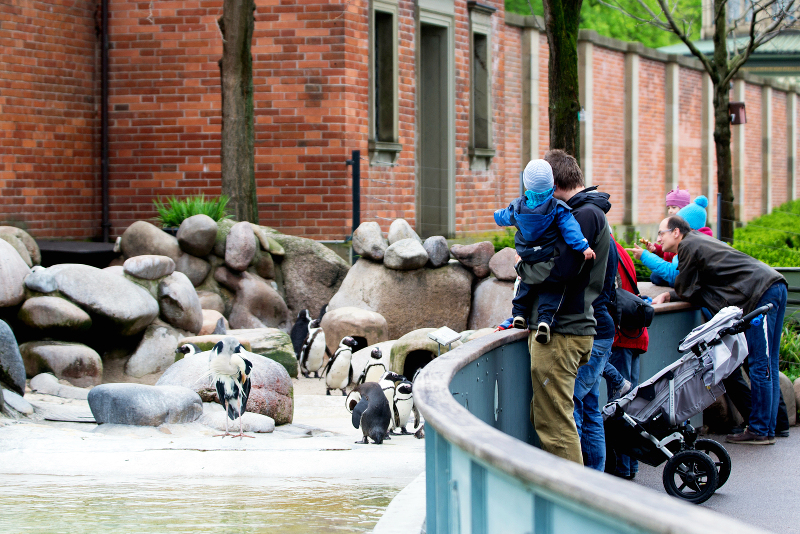
The Nuremberg Zoo is one of the largest in Europe and has some great enclosures and animals on site. If you like zoos, you are sure to love Nuremberg Zoo.
It’s about six kilometres east of the Old Town in an old sandstone quarry which makes for some great enclosures when it’s been left how it was for animals where this makes sense.
There are many animals here (292 different species) and your kids are highly likely to find their favourites.
Playmobil FunPark
Kids 10 and under may think that Playmobil FunPark is the winner when it comes to places to see near Nuremberg.
This low key amusement park with Playmobil theming was a total winner for our six and ten year olds with amazing playgrounds, pedal boats, water play area, castle area, go karts and more. What I liked about it is nothing is that fancy (think cool playgrounds rather than rides) so it actually works incredibly well for younger kids.

If it’s warm, make sure you take your swim suit for the wet areas.
Honestly, you could easily spend all day here. We went for six hours and rushed quite a few hours. Just so much fun.
You can read my full review of Playmobil FunPark here .
Things To Do In Nuremberg At Christmas
While most of the Nuremberg things to do listed above are possible in winter time, there are also some fun things to do in Nuremberg in winter.
Nuremberg Christmas Market
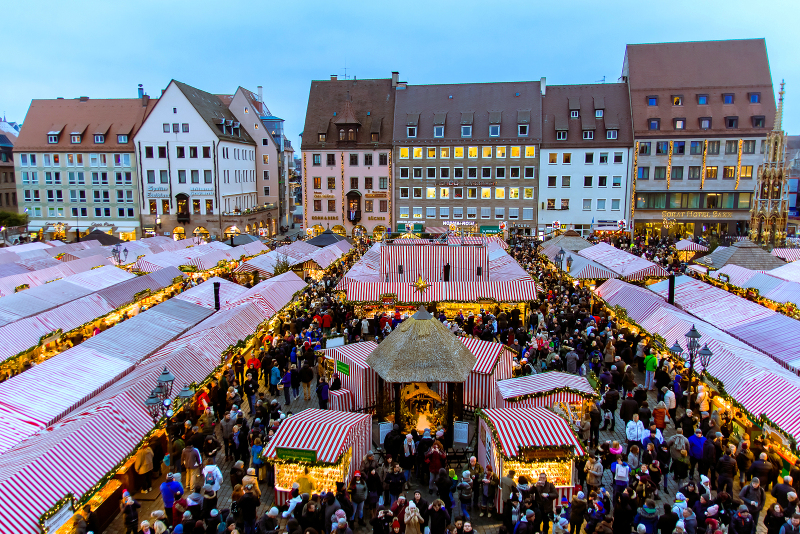
Running for about a month before Christmas, Nuremberg Christmas Market is definitely the #1 place to head if you are looking for things to do in Nuremberg in December. This Christmas Market is one of the oldest and best options in Europe.
Located in Hauptmarkt, this market is big with around 180 stalls. It was first mentioned in 1628, but it’s suspected that markets were held here for around 100 years before this.
This area is famous for its gingerbread (lebkuchen in German) and this is a great time to try some along with an “Original Nuremberger” sausage and some blueberry glühwein. These sausages are made with pork and spiced with marjoram. They are only 23 grams each and about the size of a little finger. They are usually sold with multiple pieces.
For families, there’s also a Children’s Christmas Market on Hans-Sachs-Platz with a special family program and rides. The carousel looks amazing and it’s fun to walk around here as well.
The downside of all of this is that this market can get busy on weekends so go on a weekday if possible.
Staatstheater Nuremberg (State Theatre)

The art nouveau Staatstheater is just to the south of the Old Town and is a magnificent place to take in an opera, ballet or to listen to the Nuremberg Philharmonic Orchestra.
While you can attend a show here year around, it can be an extra good choice in winter when you’d rather keep indoors.
What To Do In Nuremberg In One Day
Only have one day in Nuremberg? 😮 What a shame!
But it’s ok, it’s still worth going to Nuremberg if you only have one day.
With one day, I recommend you stick to the attractions in and around the Old Town. The following is a base for your itinerary but switch things around after reading the above so you spend more time at the attractions that most interest you.
- Start the day at Kaiserburg. Check out the views at Sinwell Tower and consider visiting the other museums and Tiefer Brunnen (Deep Well) if time allows
- Look at the map above and try to walk past everything mentioned in the Old Town. Even if you don’t want to go inside the attractions, the outsides are usually amazing. Also make sure you walk along the very picturesque Weißgerbergasse
- Do one of the underground tours. Pick whichever interests you most from the Historischer Kunstbunker (Historic Art Bunker), Felsengänge (Undergound Cellars) and Mittelalterliche Lochgefängnisse (Medieval Dungeons)
- Go inside at least one of the main churches: St Sebalduskirche, Frauenkirche (Church Of Our Lady) and Lorenzkirche (St Lawrence Church)
- Have lunch somewhere picturesque in the Old Town
- Spend the afternoon at either the Germanisches Nationalmuseum (German National Museum), Neues Museum or Stadtmuseum Fembohaus – whichever interests you the most
The only exception to this is if you are particularly interested in World War II history. In this case, split your time between the Reichsparteitagsgelände, Nuremberg Trials Memorial and Kaiserburg for a touch of the Old Town. Eat dinner in the middle of the Old Town too so you have a chance to soak up some of the ambience.
Best Place To Stay In Nuremberg Germany
When it comes to where to stay in Nuremberg, there is a great range of hotels and other accommodation options. You won’t have any problem finding somewhere to stay.
Below, I’ve listed a few different places to consider depending on what type of accommodation you are looking for.
If you want more options, you can use this map to help you find hotels and home rental accommodation around Nuremberg.
BEST – Le Meridien Grand Hotel Nürnberg Review

Located just to the SE of the Old Town opposite the City Walls, Le Meridien is the place to head for 5 star luxury. It isn’t just grand inside either, it looks it from the outside.
It started life as a two-storey farmhouse with a hops storehouse, but became an 80-room hotel in 1896 with three floors. Although it still wasn’t the luxury it is today thanks to no running water and only one bathroom!
Today, it has 190 luxurious rooms, all with flat screen TV, internet, safes and luxurious beds. You will be comfortable here. The rooms range from small (but stylish) doubles to a variety of suites which also have sitting areas.
Facilities at this hotel include a restaurant, gym and business facilities. Valet parking can be included for an additional daily charge.
Click here for the latest prices.
You can also read our full review of the Novotel in Nuremberg here which is also a great choice.
VALUE – Adina Apartment Hotel Nuremberg Review

For great value accommodation in Nuremberg Old Town, look no further then the Adina Apartment Hotel. We love this chain for very comfortable, well furnished and smartly arranged apartments with all the facilities of a hotel.
In Nuremberg, the Adina Apartment Hotel is located in the southern part of the Old Town which makes it very easy to get out and about to explore all the things to do around Nuremberg Germany.
Rooms range from studios to one and two bedroom apartments including special family apartments. They all have kitchens including microwaves and washing machines and are comfortably appointed. Flat screen TVs, irons and more are included making this a very easy place to stay.
Facilities include an indoor pool, gym and a sauna as well as complimentary WiFi. There is a restaurant and bar on site and you can order room service. I particularly liked the rooftop terrace.
For anyone who wants to self cater or have a little more space (especially families), this is my top choice of where to stay in Nuremberg.
BUDGET – Übernachten in der Tenne Review
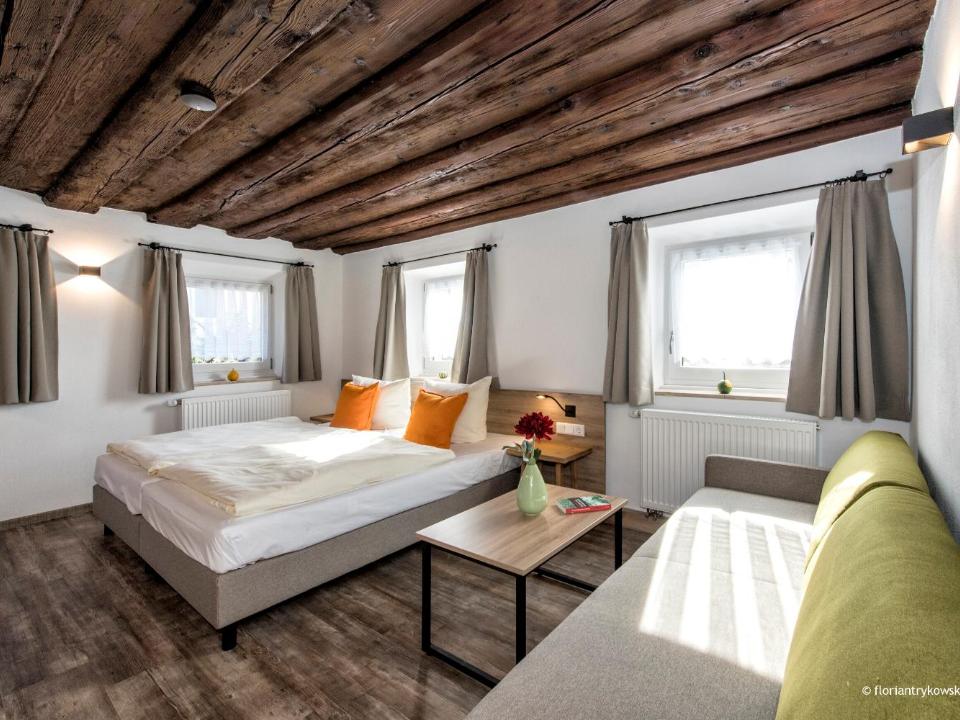
If you are looking for a budget stay, you won’t be able to beat Übernachten in der Tenne. Located about 8 kilometres from the Kaiserburg, you can catch public transport into the Old Town and around Nuremburg’s attractions.
This accommodation offers apartments in an old converted farmhouse renovated in 2018. They are functional and good looking and offer a comfortable stay for a great price as long as you don’t mind the commute.
There are four apartments with kitchens with microwave and three single rooms. Some of the apartments have sofa beds making them a great choice for families of four who want great accommodation and want to save some money.
There is free parking on-site and you can also have breakfast served in your room.
Nuremberg Attractions Map

How To Get To Nuremberg

We travelled to Nuremberg by hire car which made it very easy to get here. It’s in a central location and is a major city so it’s simple to find.
You can hire a car to get you there by clicking here.
There are regular trains and buses here. You can find timetables and all your options here. Nuremberg’s central location has it close to many places and you can be in Berlin, Frankfurt, Hamburg or Munich within hours by train.
There is also an airport in Nuremberg with flights from other places in Europe. Click here to see the latest (and best) prices.
Once in Nuremberg, we found it easy to use the local transport, although most of the time, we explored on foot. Once you are in the Old Town, it’s awesome to just walk around and soak it all in.
Final Words
Nuremberg is a fun place to visit and there are many things to see Nuremberg offers. The hardest part will be what to leave out!
We really enjoyed it all, except the disappointment of not getting to see the Nazi Party Rally Grounds as we had expected. The Old Town is awesome to walk around and then there’s so much outside of here as well as some top museums.
I hope you have found this guide useful and you have a great visit as well.
Read more guides to visiting Southern Germany here or read about nearby Dinkelsbühl here or Rothenburg here . Both are perfect places for a day trip! You may also be interested to know why we think Bavaria is the best region in the world here .
Related posts:

By Sharon Gourlay
Sharon first fell in love with Germany back in 2000 on her first visit. She loves the long history, the picturesque Old Towns, the castles, the food, everything really! Since then, she has visited many times and loves writing about Germany here so you can enjoy it too. In fact, Sharon loves German culture so much that she sent her kids to a German primary school in Australia. She especially loves Berlin and towns with charming Old Towns like Celle and Quedlinburg. Sharon also has a Certificate III in International Travel Sales and understands the nitty gritty of travel planning. Through this site, she'll help you have the perfect trip to Germany whether it's your first or tenth time!
Leave a comment Cancel reply
Your email address will not be published. Required fields are marked *
Save my name, email, and website in this browser for the next time I comment.
This site uses Akismet to reduce spam. Learn how your comment data is processed .

30 Things to do in Nuremberg, Germany: The Ultimate List!
Last Updated: August 12, 2022
*FYI - this post may contain affiliate links, which means we earn a commission at no extra cost to you if you purchase from them. Also, as an Amazon Associate I earn from qualifying purchases. Check out our Privacy Policy and Disclosure. for more info.
I’ll be real: Nuremberg is a place that’s easy to fall for.
This world-famous city, located in the north of Bavaria , is every bit the fairytale dream so often linked to Deutschland : candy cane half-timbered facades, an epic castle on a hill, dangerously munchable gingerbread, and a glittering Christmas market to boot.
But as with most amazing cities, the true magic of Nuremberg comes from its dynamic layers. Lurking beneath those photogenic facades is a dark past intertwined with war, genocide, and centuries of tumultuous history.
It is precisely this duality that makes Nuremberg one of the most fascinating cities to visit in Germany, and one that you can keep visiting again and again.
So, what is there to do in Nuremberg? It turns out, plenty of things. Below you’ll find a roundup of my favourite things to do in Nuremberg, after several repeat visits, from the touristy musts to more alternative, off-beat activities. Enjoy!
Save this post for later on Pinterest:
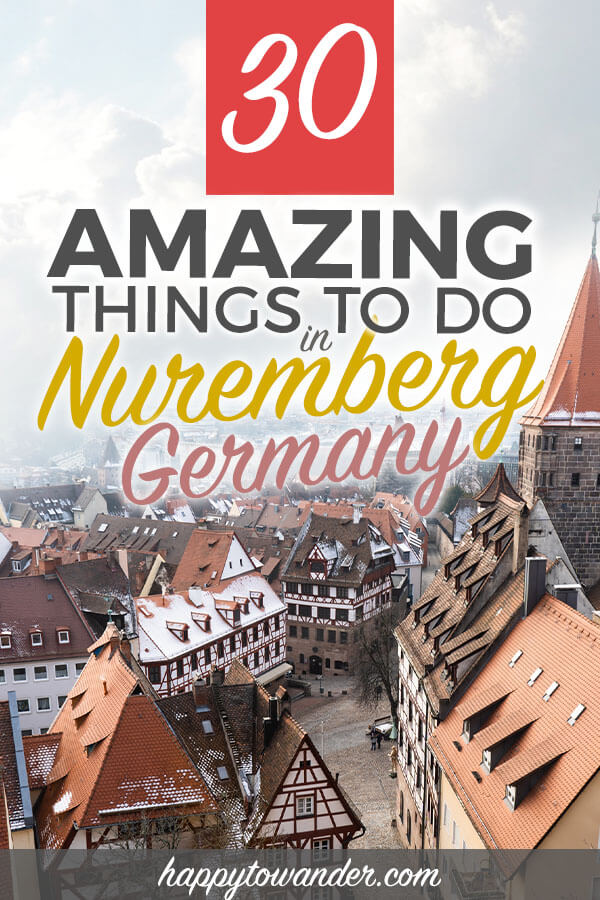
The Top 10 (Touristy but Worthwhile) Things to do in Nuremberg
Let’s start with the classics. Nuremberg is home to some world famous attractions, so we’ll begin with a list of my favourite touristy, but still worthwhile, Nuremberg things to do.
1. Tour around the majestic Nuremberg Castle
With centuries of experience under its belt, there’s no doubt that Nuremberg Castle has led one tumultuous life. From flaunting imperial hotspot status during the Holy Roman Empire to surviving severe bombings during WWII, it’s no wonder the restoration process here took decades.
All that hard work paid off though, because today, Nuremberg Castle is a landmark that is synonymous with the city, offering some of the best views in town, alongside a fascinating history that can be traced firsthand with a visit.
And, despite its status as the most popular tourist attraction in Nuremberg, there’s still a secret way to enjoy Nuremberg Castle without a thick mass of crowds…
Just pay to go inside!
I’m not joking: you’d be surprised to see how many visitors choose not to pay the castle’s entry fee, opting only to stay outside for photos and leaving shortly after.
This makes experiencing the castle’s interior, plus its museum, a nice way to escape from the crowds for a little while.
PS: Its stables are now home to a hostel, so you can actually sleep here if you so wish!
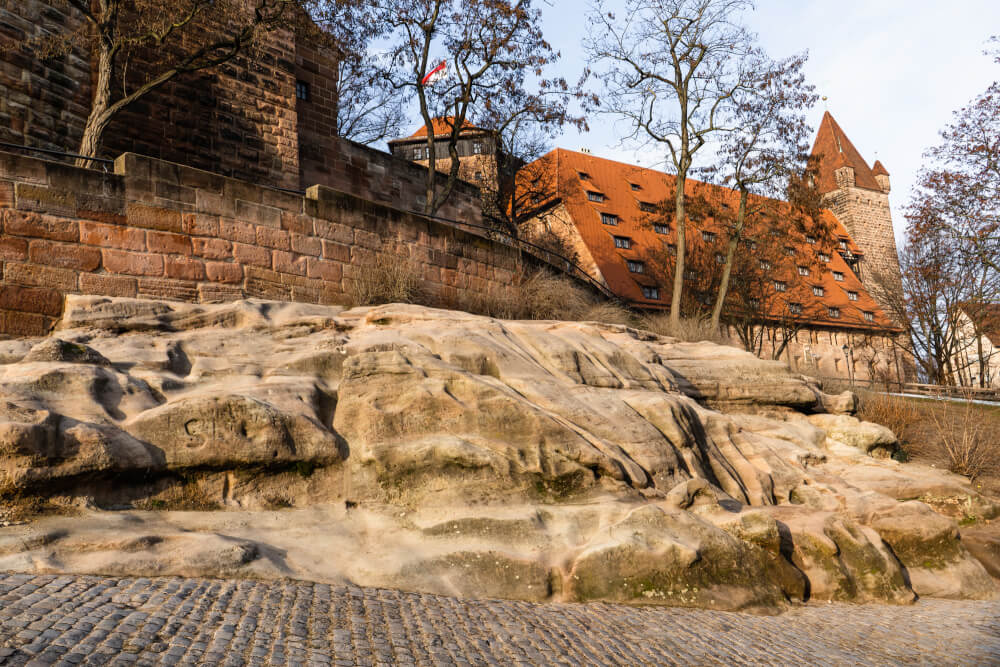
2. Stroll down Weißgerbergasse
What’s Nuremberg without a splash of fairytale charm? If it’s classic storybook houses you’re after, be sure to mark Weißgerbergasse down on your map.
This street is full of colourful half-timbered artisan houses, built in the booming days of leather making when many artisans in Nuremberg became increasingly swanky and rich.
While unfortunately, wealthy leathermakers may be tough to find these days, Weißgerbergasse is now filled with cute cafes, boutiques and little workshops to peruse, a worthy consolation prize 😉

3. Explore the handsome Handwerkerhof
For bonus fairytale points, head over to the Handwerkerhof, an adorable cobbled courtyard nestled along Nuremberg’s old town walls, filled with half-timbered houses and all the charm of an actual medieval village.
Despite its aged, old timey appearance, I have to let you in on a little secret: this cutesy courtyard was actually established in the 1970s to pay tribute to the golden age of craftsmanship in Nuremberg….
But, while it’s not nearly as old as it looks, today travelers can stop by for fun demos and to shop for handcrafted products just like in the good old days. Sure, it’s a little touristy, but it’s nonetheless absolutely adorable!
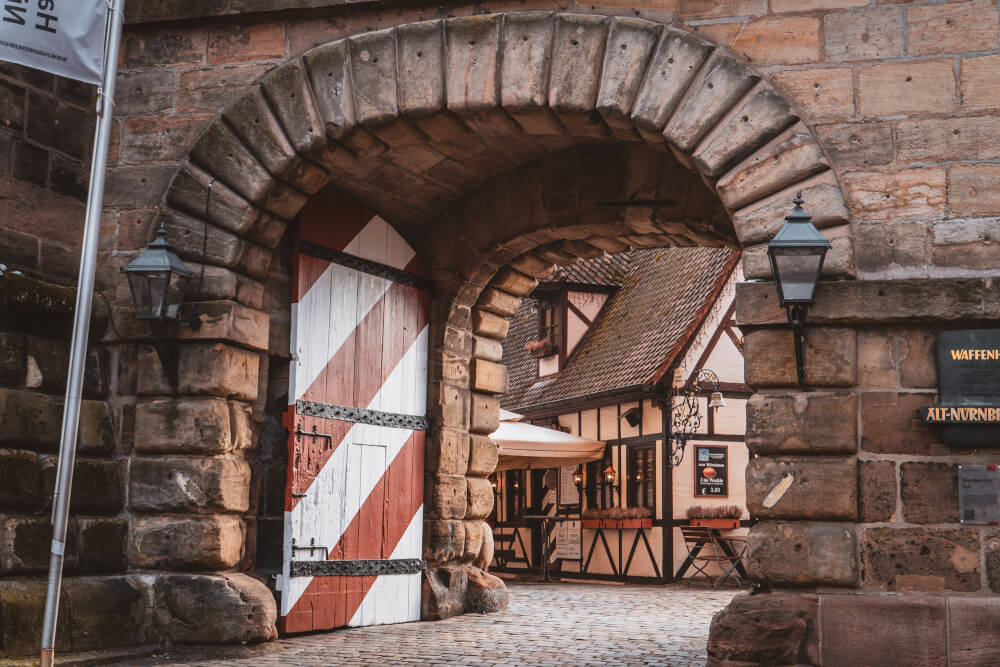
4. Enjoy the best view you can get in Nuremberg
As far as must dos go, I don’t feel like a visit to Nuremberg would be complete without seeing it from above, so allow me to aggressively suggest Nuremberg Castle to you one more time.
*clears throat*
GO TO NUREMBERG CASTLE. Really, do it… even if it’s just briefly to snag this view. It is completely worth the climb, and if the weather is in your favour, the gardens may even be open for you to explore free of charge as well.
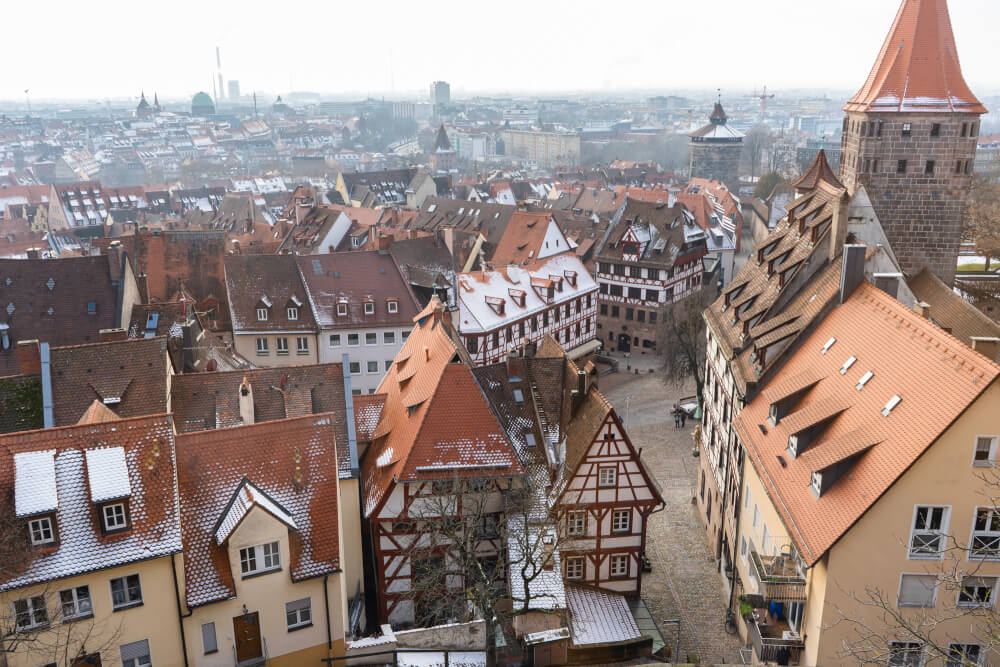
5. Visit the Hauptmarkt and the Frauenkirche
Another two gorgeous icons of Nuremberg can be found in the city’s Hauptmarkt: the Frauenkirche church (which dates back to the middle of the 14th century) and the stunning gilded fountain that supposedly has magical powers to grant wishes if you turn a mystical ring.
Scared you won’t be able to find said mystical ring? Don’t worry – there is always a line-up here to turn it.
While I’m dubious about the fountain’s actual magic powers, it’s nonetheless a beautiful sight to add to your Nuremberg itinerary.
PS: Rumour has it locals turn the dark iron ring on the other side as THEIR lucky charm – the first is just a tourist trap.
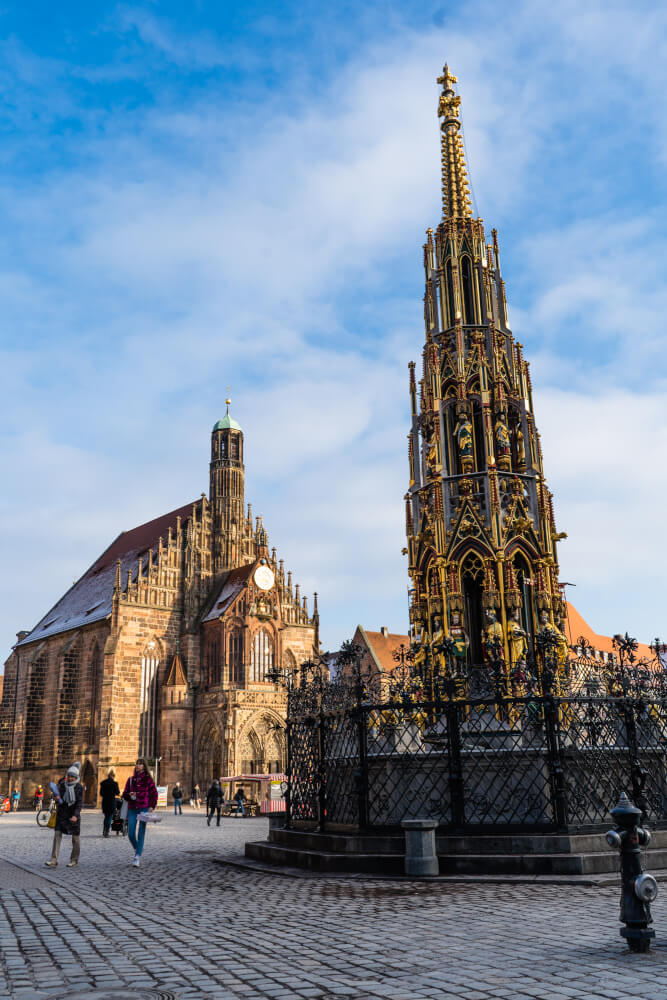
6. Enjoy the cozy vibes of Tiergärtnerplatz
If it’s a cozy and adorable square you’re after, make sure you stop by the postcardy red and white houses of Tiergärtnerplatz, one of the most charming places in Nuremberg, home to a few cute bars, cafes and of course, the famous Albrecht Dürer Museum.
When the weather cooperates, make sure to carve out some extra time in this square to sip on a hot chocolate (or beer!). The atmosphere here is the best.
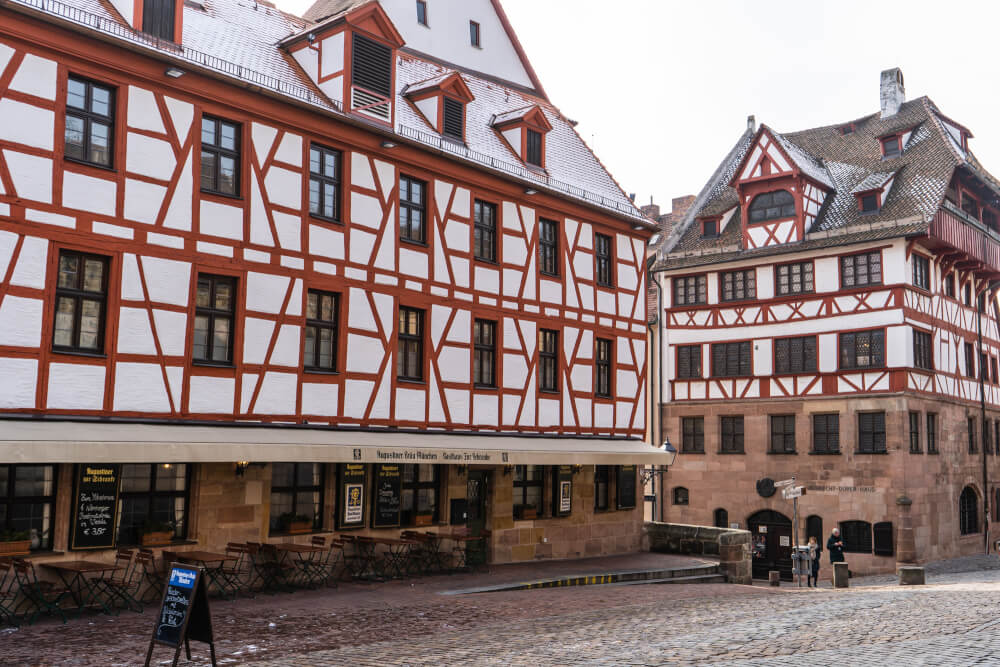
7. Drool over St Lorenz Church
Another must-visit church in Nuremberg is the St Lorenz Church, whose imposing facade you’ll definitely encounter as you bumble your way around town.
The focal point of this church facade? A stunning rose window, perfectly framed by two 80m towers… but don’t forget to explore the beautiful interior too.
With 12,000 pipes, the pipe organ inside St Lorenz is actually one of the largest in the world.

8. Visit the Nuremberg Dockumentation Center
One of the standout highlights from my first trip to Nuremberg was a visit the to the city’s Dokumentation Center, which houses a permanent exhibition that describes in eye-opening detail the atrocities that happened in Nuremberg and Germany during the Nazi regime.
Housed in the (unfinished) Congress Hall of former Nazi party rallies, this museum offers harrowing insight into one of the darkest chapters of Nuremberg’s history. A must-visit for historical context and education.
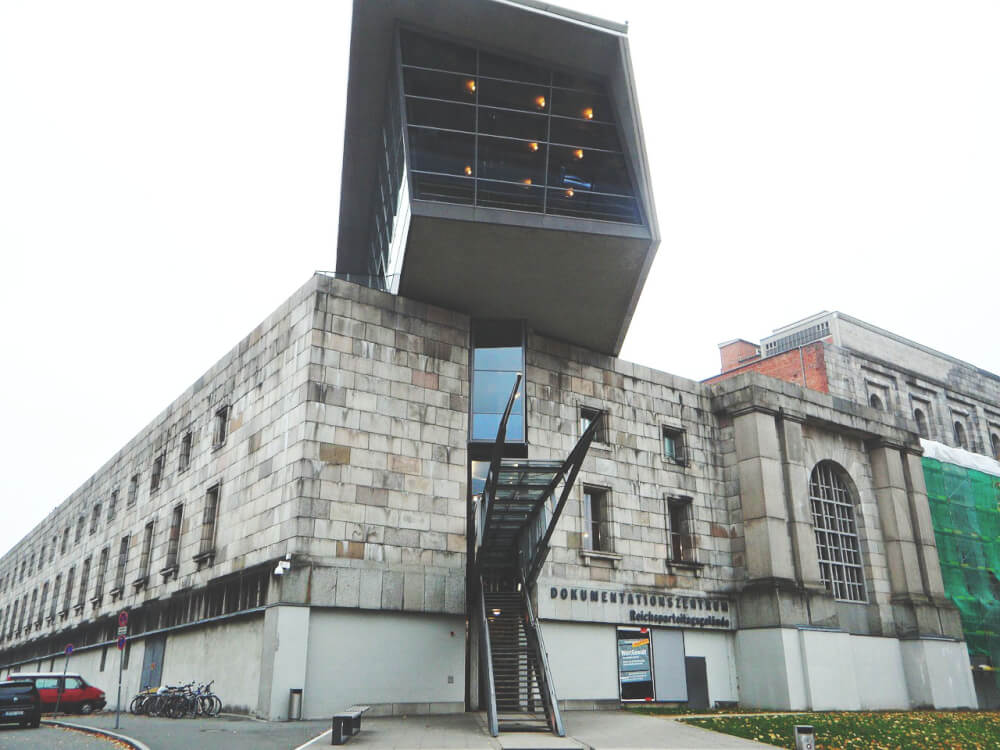
9. Stop by the Nuremberg Palace of Justice
Built in the early 20th century, the Nuremberg Palace of Justice is known best as the site of the Nuremberg Trials, the trials during which Nazi war criminals were prosecuted after WWII.
Today, the complex remains in use to house offices and active court facilities.
Inside, you’ll find Courtroom 600, the very courtroom where the Nuremberg Trials were held, along with a memorial dedicated to the trials, and a Memorium Nuremberg Trails exhibition which explains in detail the history of the trial and those who participated.
10. Visit a unique museum
Besides usual museums dedicated to art and history, Nuremberg has a handful of incredible unique museums too that are worth checking out. Here are a few:
Bavarian Railway Museum: Because Nuremberg was actually the home of the first ever German railway (known as the Bavarian Ludwigsbahn), it should come as no surprise that there’s a museum dedicated to railways in the city. At this museum, you can marvel at a variety of unique trains and exhibits, including parts of the royal train belonging to King Ludwig II. Click here for more info.
Toy museum: Nuremberg has been renowned for toy-making since the Medieval times, which is why its toy museum is actually one of the best known in the world. Click here for more info.
Cultural Things to do in Nuremberg
If you’re looking for some cultural activities in Nuremberg, there are plenty of of options for you. Here are a few cultural highlights:
11. Visit the modern and beautiful Neues Museum
If you’re looking for a modern art space in contrast to Nuremberg’s storybook aesthetic, head over to the Neues Museum, which houses thousands of art works from around the world in a gorgeous, airy contemporary 2-story exhibition space.
With various rotating exhibitions taking place annually and a lively program of events throughout the year, this is the go-to spot in Nuremberg for contemporary art and design.
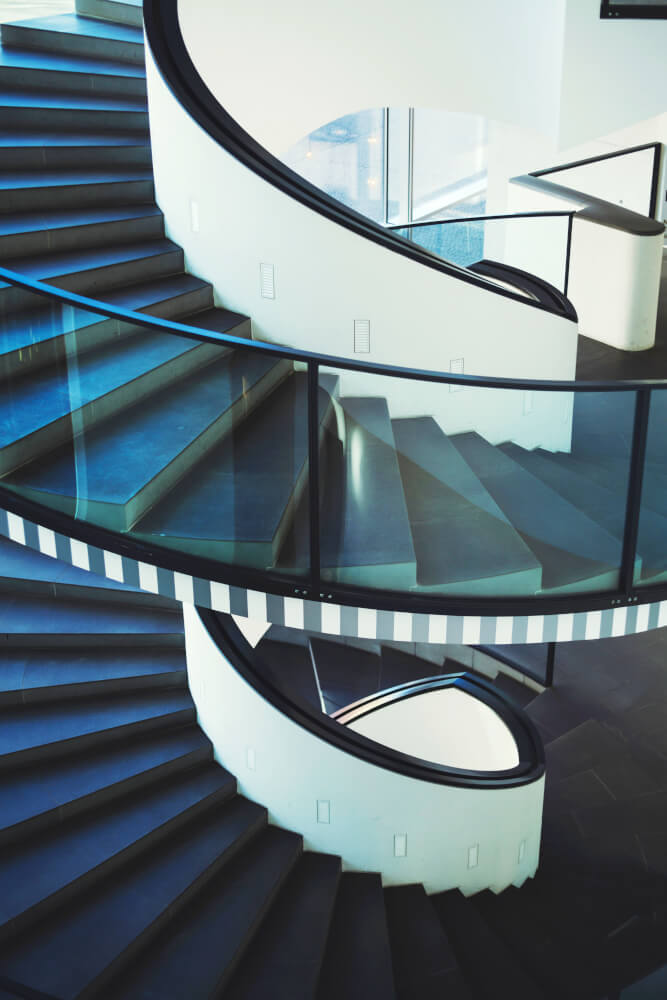
12. Marvel at the oldest globe in the world
Travel lovers, I’m sure this will intrigue you: did you know that Nuremberg is actually home to the oldest globe in the world?
The Erdapfel (which literally translates to “Earth apple”) is a terrestrial globe that is recognized as the oldest scale model of Earth, dating back to the late 15th century, although the Americas are notably absent.
Despite a variety of imperfections, this globe is highly valued by historians today because of the succinct way it summarized all that was known about earth at the time. You can see it for yourself at the Germanisches Nationalmuseum.
13. Visit Albrecht Dürer’s house
International visitors may have never heard the name Albrecht Durer, but he’s a mega-household name in Germany, and largely regarded as the country’s most famous artist.
Located in a picturesque half-timbered house in Nuremberg’s Tiergärtnerplatz a space where Dürer himself once lived and worked for two decades in the 16th century.
As the only remaining 15th century artist house in this part of Europe, it holds a tremendous historical significance, which is why it’s considered one of the top things to do in Nuremberg today.
At the house, you can view Dürer’s works, and see the inside of a house left over from the golden age of Nuremberg.
Foodie Things to do in Nuremberg
When in Nuremberg, one of the best things you can do is eat. Franconia (to me) is a foodie’s paradise, with plenty of delicious regional treats that you simply have to try. Here are a few suggestions.
14. Snack on a ‘Drei im Weggla’
One of the most beloved snacks from Nuremberg that you’ll find all over Germany are Nuremberg sausages, little finger sized sausages typically eaten in threes.
The most common way of consuming them is a “Drei im Weggla” (three in a bun), with three of these tidy sausages smooshed into a roll – so good!
You can find these at stalls all over town, but Zum Guldenen Stern is well-known as a historic place to try them out.
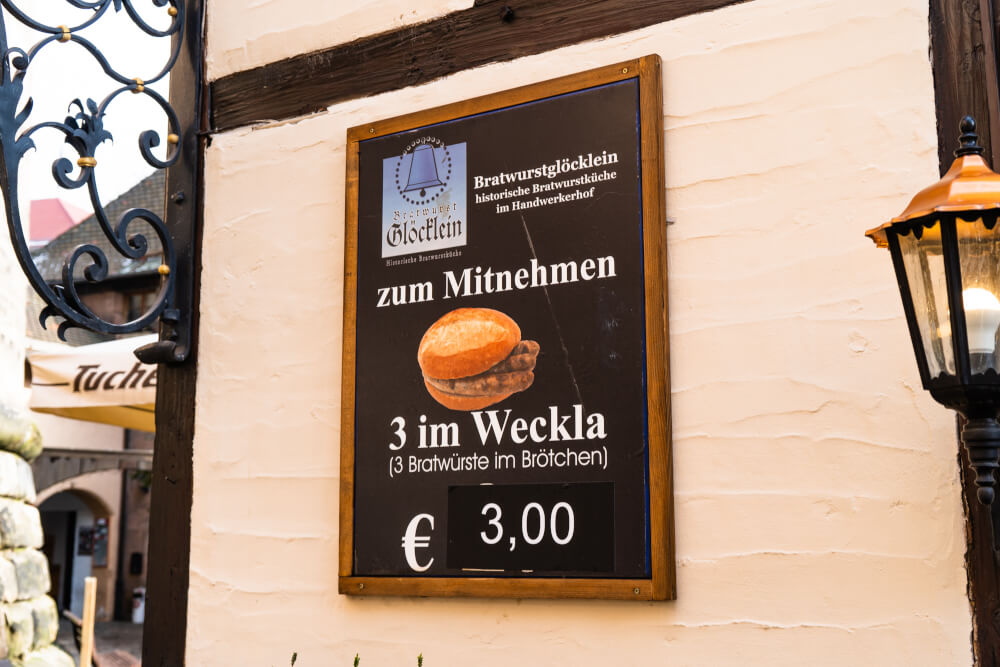
15. Try Schäufele
For those looking for something a bit heartier, you can try Schäufele, a south German dish made with pork shoulder meat – bone and rind still in tact.
Commonly served with gravy, potato dumplings and sauerkraut, this is Franconian comfort food at its finest.
16. Munch on some lebkuchen
Lebkuchen is a type of German gingerbread commonly wolfed down during the Christmas market season, and Nuremberg is one of THE places to try it because it’s largely acknowledged that lebkuchen was actually invented by monks here in Franconia all the way back in the 13th century.
It’s so prestigious here that Nürnberger Lebkuchen is protected, and MUST produced within the city’s boundaries or it’s not considered legit.
One of the most special types of Lebkuchen produced in Nuremberg is known as “Elisenlebkuchen”, and must have at least 25% nuts and less than 10% wheat flour.
These fine ingredients give the cookie a unique nutty flavour, and completely unlike North American gingerbread. A must-try!
17. Nom on some röstkloß
This simple comforting dish is one of my favourites, and it’s vegetarian-friendly too. You can find röstkloß at most typical Franconian restaurants, and if you see it, do yourself a favour and order a giant plate.
This delicious delicacy consists of potato dumplings chopped up and fried with eggs, often jazzed up with some mushrooms, side salad or other veggies. It is SO GOOD.
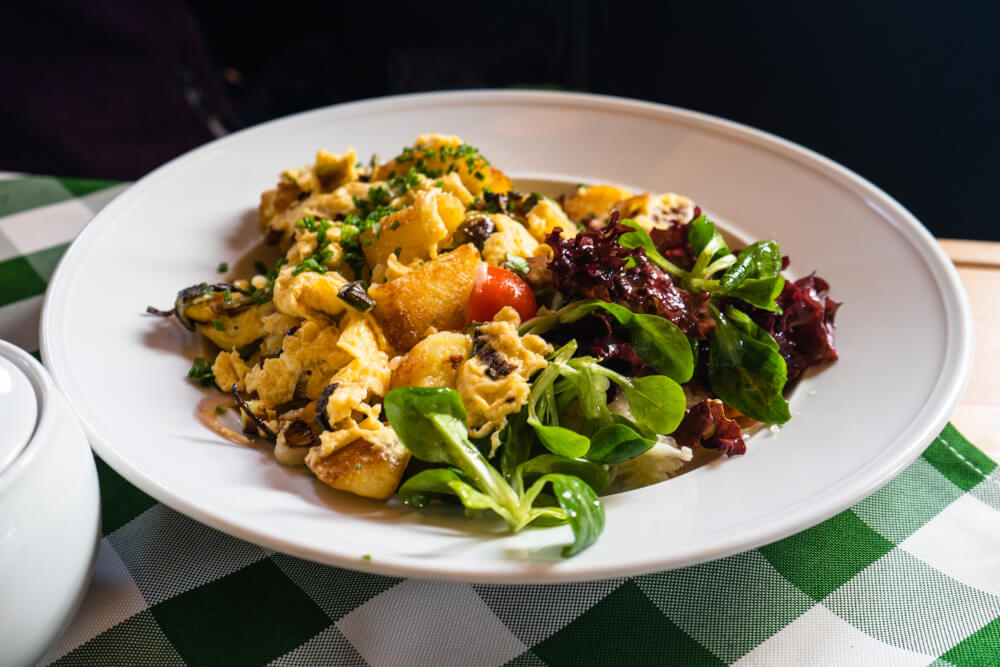
18. Take a cooking class
One of the best ways to immerse yourself in a new culture is to taste it and learn how to take it home with you! Nuremberg is no exception to this rule, and one of the best things you can do here is taking a unique cooking class.
You can for instance book this cooking class next to Nuremberg Castle where you learn to make sausages! With lunch included, it;’s less than 30 euros making it a great deal. Click here for reviews and availability.
You can also book this gingerbread making class for less than 20 euros. Click here for reviews and availability.
Quirky and Offbeat Things to do in Nuremberg
Of course, Nuremberg isn’t just about the usual must-sees. One of the most interesting things about the city is the way that it’s continually evolving, growing, and dare I say – becoming vaguely hipster?? Here are some of the better quirky/offbeat things that you can do in Nuremberg.
19. Explore the trendy GoHo district
Just outside of Nuremberg’s city centre, you’ll find the Gostenhof district, abbreviated hipsterily as GoHo. This incredibly hip district feels worlds away from historic storybook Nuremberg, with vintage shops, cute boutiques and endless cafes and unique eateries perfect for those looking to go off the beaten path in Nuremberg.
For a full list of shops round GoHo, click here.
20. Visit an a-meow-zing vegan cat cafe
Yes, you read that right… a vegan cat cafe… in Nuremberg!
Or actually, we should call it a cat temple to be precise. Yup, the Katzentempel in Nuremberg has officially claimed status as the first cat cafe in Germany, and is a haven for cat lovers who want to graze on plant-based food and drinks while cuddling with shelter cats from Munich.
Sounds pretty purr-fect no?
21. Discover the underground beer tunnels
Lurking below ground in Nuremberg is yet another fun surprise: beer tunnels!
Yup, one upon a time, a cellar system was used around Nuremberg to store beer, and today, this maze of rock-cut cellars continues to exist, and is open to those curious enough to explore them.
Download the Rock-Cut Cellar Flyer here
22. Say hi to a scary rabbit statue
This thing seriously gives me the creeps.
Lurking in one of Nuremberg’s most scenic squares is a worrying little sculpture, Der Hase (The Hare) by Jürgen Goertz. Cast in bronze, this demonic, rabid looking rabbit just sits there with no explanation or plaque, spooking every visitor that crosses its path.
Nonetheless, it’s kind of endearing. Inspired by Albrecht Dürer’s painting Der Feldhase (the Rabbit), this thing is worth a quick peek while exploring town.
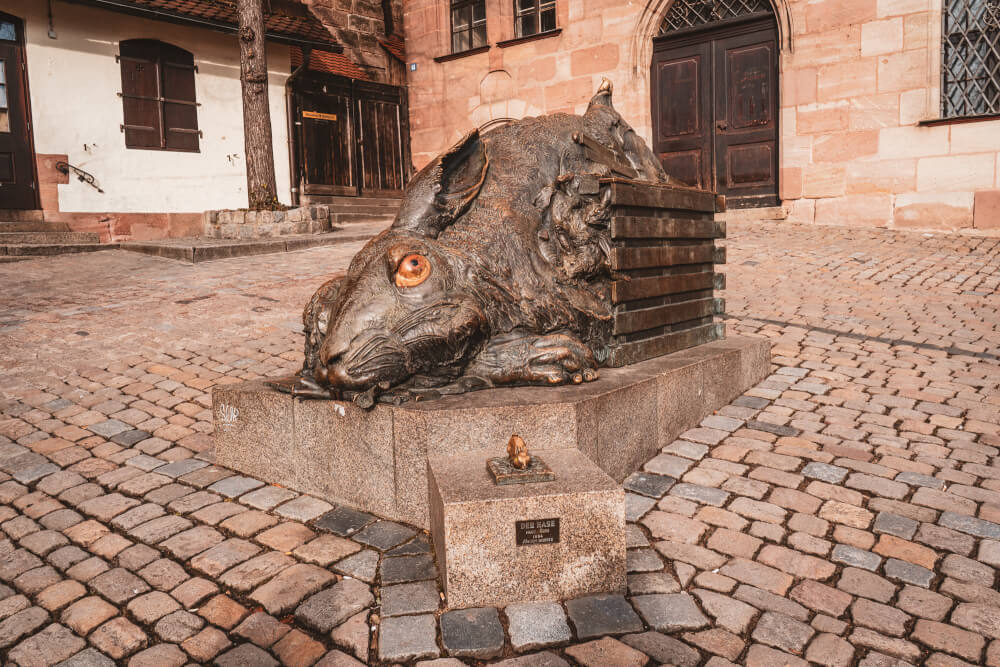
23. Relax at the Wöhrder Lake/Park
When thinking of things to do in Nuremberg, one’s mind doesn’t usually drift to green spaces, but nonetheless if you’re looking for a place to relax and unwind in the middle of the city, head over the Wöhrder Lake and Park, where you can rent a boat, laze out on the grass or do as the locals do: nurse a cold beer while soaking in the sunshine.
24. See the “marriage merry-go-round”
If you want to see a thoroughly pessimistic outlook on marriage, head over to the most controversial fountain Nuremberg, the Ehekarussell (AKA the Marriage-Merry-Go-Round ) which was created in the 80s to depict the different phases of married life.
The figures get old, fat, and…. die.
Like I said, not really the most optimistic statue, but a unique and fun contrast to the picture perfect city.
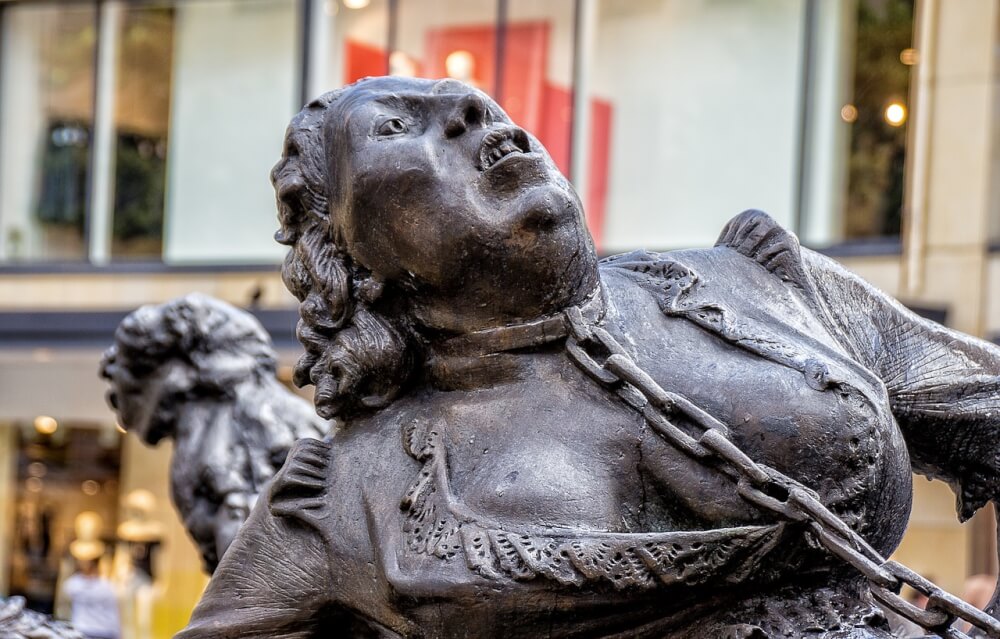
Special Events and Seasonal Things to do in Nuremberg
Last but not least, Nuremberg plays host to a variety of fun events throughout the year. If you’re lucky enough to be in town for one of the following, be sure to take advantage.
25. Visit the Nuremberg Christmas Market
The Nuremberg Christmas Market is one of the most famous Christmas markets in Germany, and while I would say it has gotten significantly busier and (overly touristy) through the years, stopping by is a must when visiting in late December/early November.
Click here to read my full guide to the Nuremberg Christmas Market.
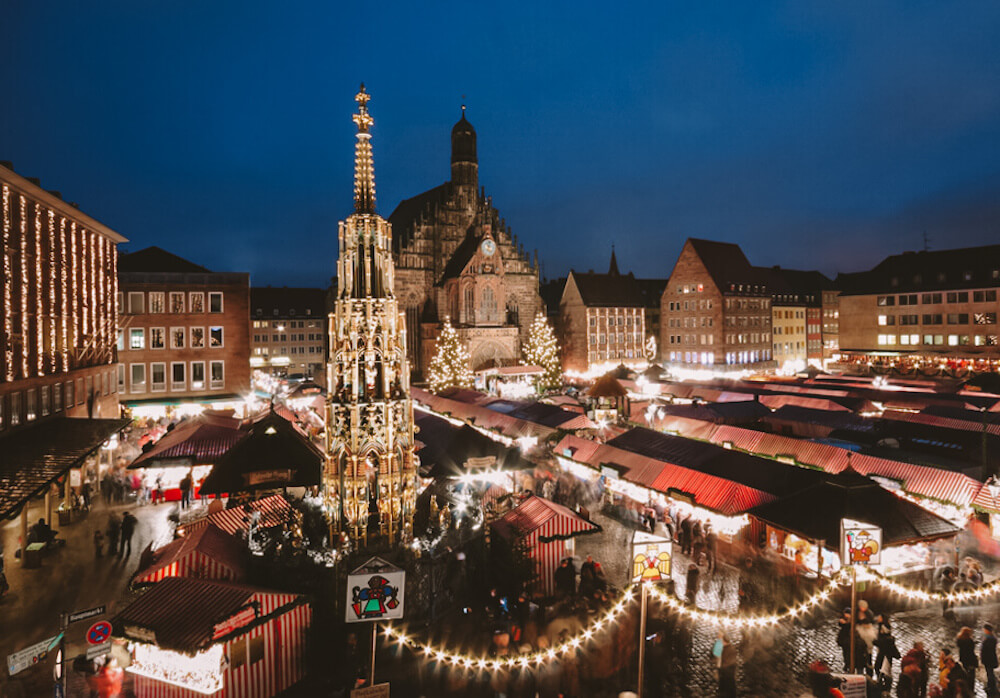
26. Drink from the largest Feuerzangenbowle in the world
Tied into the Nuremberg Christmas Market festivities is a giant Feuerzangenbowle, the largest in the world. For those of you who aren’t familiar with the glories of Feuerzangenbowle, it’s a wonderful boozy drink served during Christmas time that involves mulled wine, caramelized sugar and rum set on FIRE.
Oh it’s so good, and in the name of record-breaking booze, it has to be sampled in Nuremberg, right?
27. Attend the Franconian Beer Festival
A beer festival in a castle moat? Germany, you can do no wrong.
If you happen to be in Nuremberg in June, be sure to stop by the Franconian Beer Festival, a celebration of beer from local breweries pouring up 100+ types of yummy beer.
Combined with live music, and delicious local food, this is one activity in Nuremberg you don’t want to miss.
28. Party at the Bardentreffen Nürnberg
During Bavarian summer holidays, Nuremberg becomes a musical haven with an open air music festival that takes over the city.
Known as the Bardentreffen, celebrating here is a summer tradition in Nuremberg you won’t want to miss.
29. Enjoy a beach in the middle of the city at Schütt Island
While Nuremberg is a landlocked city, that doesn’t stop it from having a great beach to enjoy during the summer. In fact, the Schütt island is a river island in the middle of the Pegnitz.
During the summer, you’ll find 4000 square meters of white sand here, over 1000 beach chairs, palm trees, family pool area, grill events, live music and more.
30. Attend a Nürnberger Volksfeste
Last but not least, if you want a taste of Oktoberfest at Nuremberg, be sure to keep an eye out for the Nuremberg Volksfest.
Imagine beer tents, fun fair rides and tons of games that are the same as what you would find at Oktoberfest. Click here for more info.
Did I miss any of your favourite things to do in Nuremberg?
I hope you enjoyed this guide on the best things to do in Nuremberg, Germany. Let me know in the comments below if I’ve missed any of your favourite Nuremberg activities! I’d love to take down some notes for my next visit.
My Go-To Travel Favourites:
🧳 Eagle Creek: My favourite packing cubes
💳 Wise: For FREE travel friendly credit cards
🍯 Airalo: My go-to eSIM
🏨 Booking.com: For searching hotels
📷 Sony A7IV: My (amazing) camera
✈️ Google Flights : For finding flight deals
🌎 WorldNomads: For travel insurance
🎉 GetYourGuide: For booking activities
3 thoughts on “30 Things to do in Nuremberg, Germany: The Ultimate List!”
Nice article.The scenery looks amazing! Will visit the place.
Lovely pics. The scenery is amazing. I would like to visit the place.
Really helpful and interesting. Thank you!
Leave a Comment Cancel reply
By using this form you agree with the storage and handling of your data by this website. *

The 15 Best Things to do in Nuremberg, Germany
- Pinterest 89
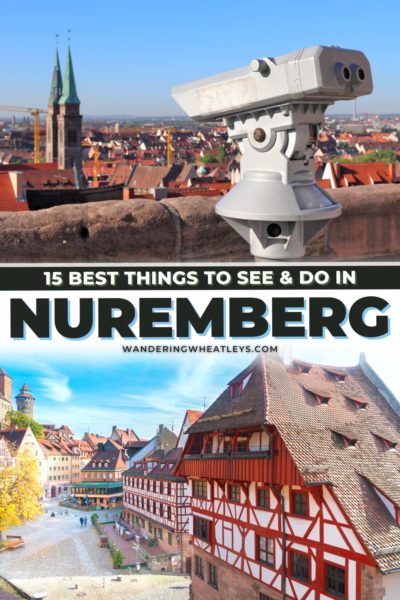
Visit Bavaria, and you have to include Nuremberg, the state’s second-largest city, on your travel itinerary. This is a destination that’s full of romance, history, folklore, fairy tales, and good German beer. Plus, you’ll love exploring the medieval streets and charming museums of this beautiful city!
Nuremberg is located along the banks of the River Pegnitz, and the city has a long history that stretches back at least a thousand years, if not beyond. You’ll quickly spot Nuremberg’s imposing Imperial Castle looming over the Altstadt (Old Town). And as you stroll through cobblestone streets, admiring the colorful timber-framed buildings and traditional architecture, you’ll learn that this was one of the most important cities in the medieval Holy Roman Empire.
As with many German cities, much of Nuremberg’s Altstadt was destroyed during World War II. The Old Town was lovingly restored, and you can learn more about the city’s role during the conflict by visiting the Documentation Center Nazi Party Rally Grounds museum and the courthouse where the Nuremberg Trials were held.
You’ll learn how the city has dealt with its past mistakes, but you’ll also see firsthand how Nuremberg has preserved the lighter elements of German culture and its own unique regional culture. While Nuremberg is part of Bavaria, it’s also part of another sub-region called Franconia. The Franconian dialect is still strong, local folklore tales and legends are still popular, and Franconian beer, wine, and cuisine are still absolutely delicious!
With so many wonderful things to see and do, you might not know where to begin. That’s why we’ve compiled our list of the absolute best things to do in Nuremberg for you. Stick to these fun and unique Nuremberg bucket list recommendations, and there’s no doubt that you’re going to have an incredible time exploring this beautiful German city!
Don’t forget to check out our web story: The 15 Best Things to do in Nuremberg, Germany
Disclaimer: This post may contain affiliate links. If you make a purchase or booking through one of our links we may earn a small commission (don’t worry, it’s at no extra cost to you).
15 Fun and Unique Things to do in Nuremberg
1. explore nuremberg’s historic altstadt (old town).
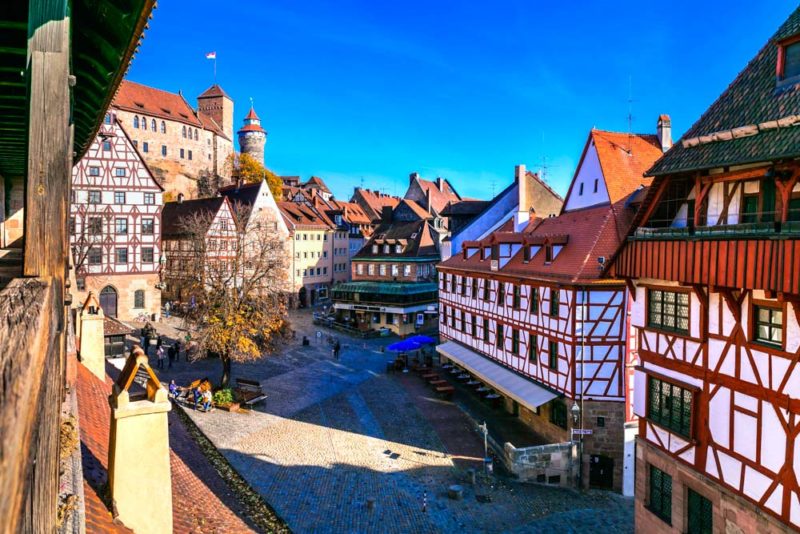
If it’s your first time in the city and you’re wondering what to do in Nuremberg, the best place to start your trip is in the Altstadt (Old Town). Nuremberg’s Altstadt is one of the best and most colorful examples of a medieval town in Germany , although as with many historic locations throughout the country, much of what you see today had to be painstakingly restored after the destruction of World War II.
Don’t let the restoration take away from the fact that Nuremberg’s Altstadt is beautiful and incredibly historic. This is the heart of the city – both old and new – and you can start exploring from the famous Hauptmarkt on the northern side of the Pegnitz River.
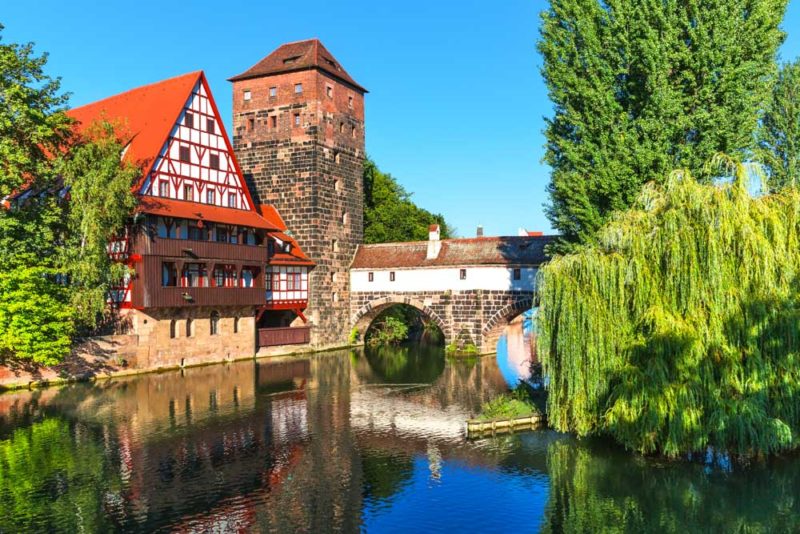
The Altstadt is surrounded by the remains of Nuremberg’s city walls, and the medieval streets extend from both sides of the river, with the two areas connected by spectacular bridges, including the 16th century Fleischbrucke. In the Hauptmarkt, you’ll find Nuremberg’s Town Hall as well as the charming Schoner Brunnen, a 14th-century fountain built with Gothic designs.
Walk north of the Hauptmarkt, stroll through medieval streets, and you’ll soon reach the Imperial Castle of Nuremberg . This massive structure marks the northern extent of the Altstadt, and for centuries, it was the focus not just of the city, but it played an important role in the wider Holy Roman Empire that stretched across much of Europe throughout the Middle Ages.
On the south side of the river, you’ll find just as much impressive architecture, including the famous St. Lorenze church . There are museums throughout the Altstadt, including the Albrecht Durer House , the Toy Museum , the City Museum , and the Deutsches Museum .
Book a guided walking tour
2. Learn about the Holy Roman Empire at the Imperial Castle
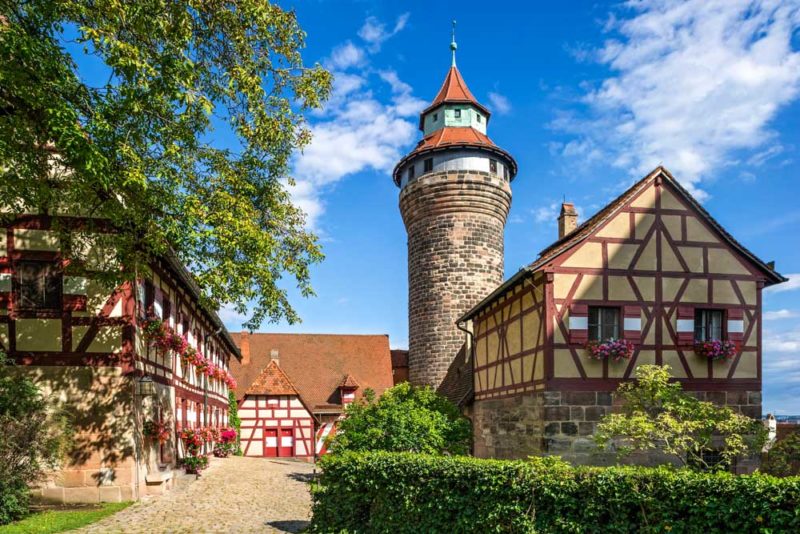
The Imperial Castle of Nuremberg , or the Kaiserburg, is one of the most important Nuremberg sightseeing attractions. The impressive castle still dominates the Altstadt to this day, with a history dating back to at least the 10th century AD when the first fortifications were built on the hilltop here.
The castle was extended on numerous occasions, and the tall stone walls and towers stand high above the surrounding timber-framed buildings of the Altstadt. The Imperial Castle of Nuremberg came to symbolize the power and authority of the Holy Roman Empire, which ruled much of Europe from the medieval era until the 19th century.
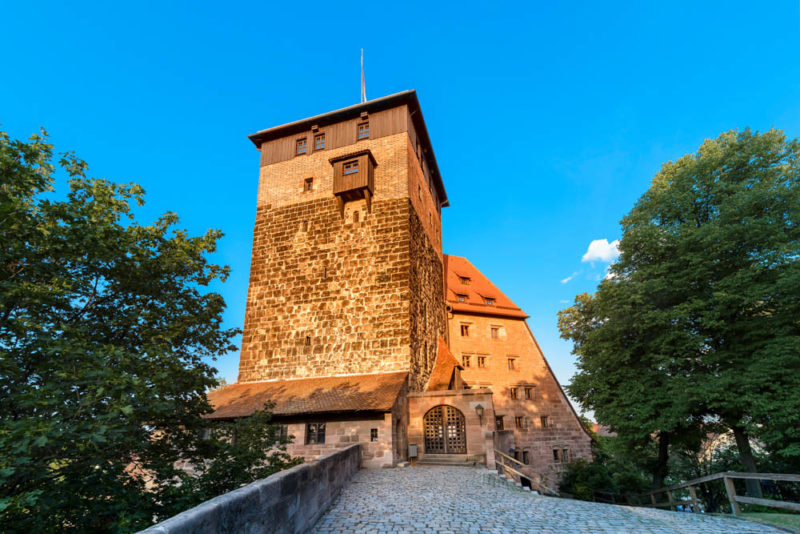
You can visit much of the castle during your stay in Nuremberg, including the Castle Museum, which is located within the Palas and Chapel. This was the focal point of the castle, and the palace is where the Holy Roman Emperors lived, worked, and prayed during their visits to Nuremberg.
The castle’s most famous landmark is Sinwell Tower, which you’ll see in many photographs of Nuremberg! Constructed in the 13th century, you can make the steep climb to the top of the staircase for spectacular panoramas over the castle and Nuremberg.
3. Walk Nuremberg’s extensive City Walls
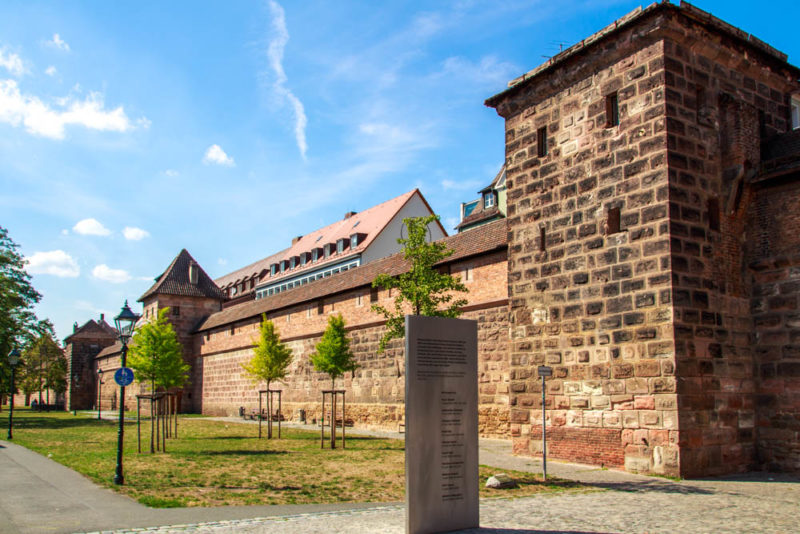
A walk along the extensive City Walls is one of the best things to do in Nuremberg. During the Middle Ages, most large towns and all cities across Europe would be built inside city walls. However, as cities have expanded, many of these unique bastions, towers, and tall stone fortifications have been torn down, destroyed, or simply lost to time.
That’s not the case in Nuremberg, where you have the opportunity to explore one of Europe’s best examples of medieval city walls during your stay. Nuremberg’s City Walls date back to the 12th century AD, and of the original three miles that were built, well over two miles remain standing. There are upwards of 70 towers, too, alongside several medieval gateways and gatehouses that are still in use.
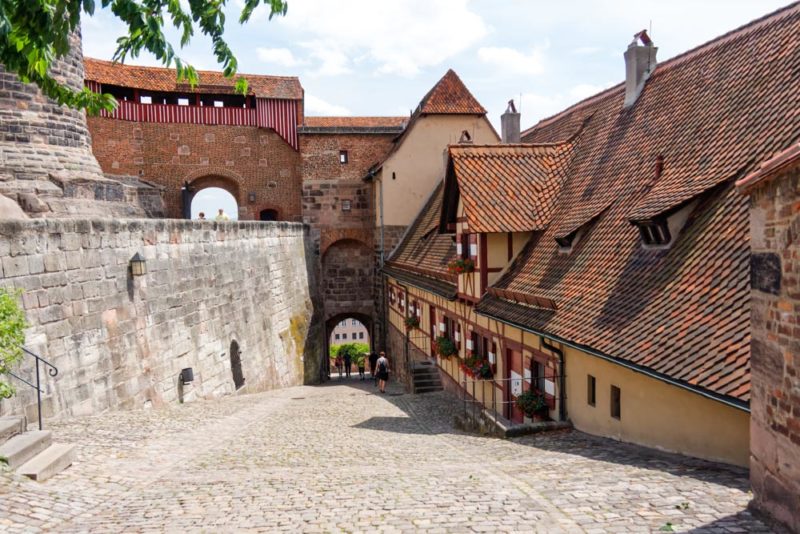
Where the walls have been torn down or destroyed over time, there are often convenient markers demonstrating where they once stood. You can easily trace the extent of the walls around the Old Town (on both sides of the river), a lovely historical walk that’s packed full of medieval surprises!
[irp posts=”96578″ name=”The 15 Best Hotels in Nuremberg, Germany”]
4. Release your inner child at the Toy Museum
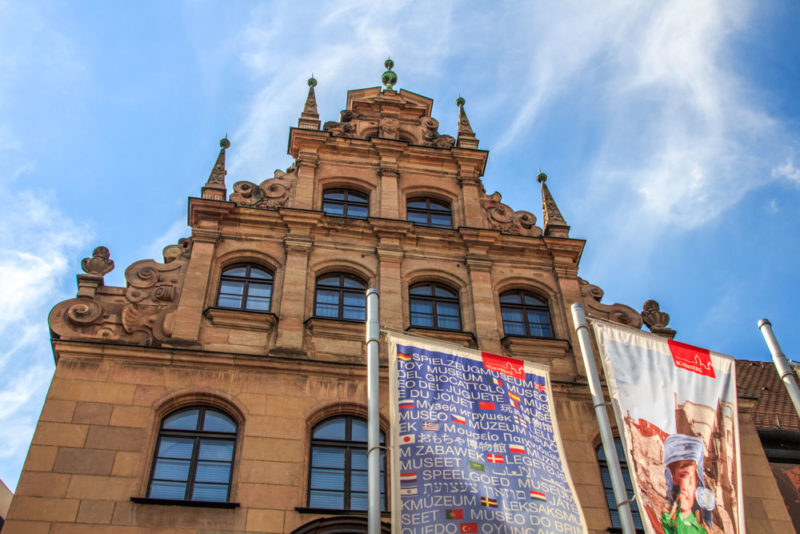
Adults and kids alike will love the refreshing fun of the Toy Museum , which we like to think is one of the best things to do in Nuremberg. You’ll find the Toy Museum located within a historic 16th-century building in the Altstadt, and inside, you’ll find thousands of toys, the oldest of which date back centuries!
Nuremberg has always had a toy-making tradition, and the museum is based on the vast collection of historic (and modern) toys started by Lydia and Paul Bayer, Bavarian locals who amassed an impressive 12,000 toys from around the world.
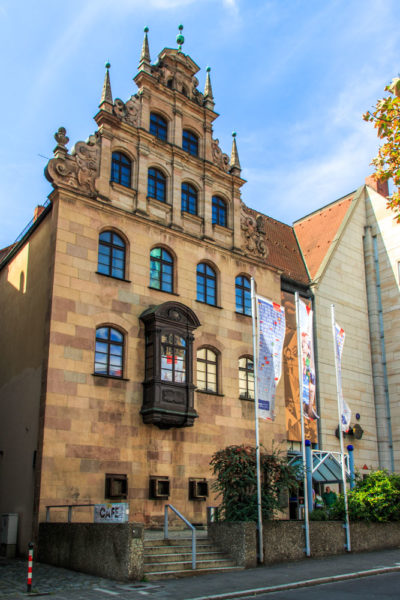
The museum opened to the public in 1971, and since then it has grown to hold over 80,000 toys. Although, there’s space for just a fraction of this number to be on permanent display.
Those displays showcase the history of toys and toy making, and you can see everything from traditional, hand-painted toy soldiers and figurines to Lego and model railway exhibitions.
5. Delve into Germanic culture at the Germanisches Nationalmuseum
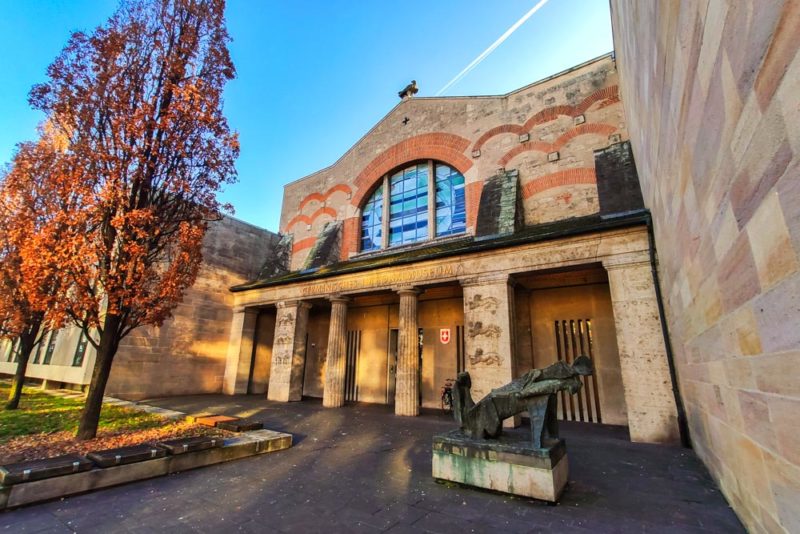
This is a city that’s packed with different museums, but one of the best Nuremberg attractions to visit is the excellent Germanisches Nationalmuseum (or the German National Museum). Located on the southern side of the River Pegnitz, this historic institution dates back to 1852 and focuses on the history and culture of German-speaking peoples across Europe.
The museum has a broad scope in this respect, and you’ll find that the permanent and temporary exhibitions cover almost the entire history of Germanic culture, from its early beginnings right to the present. That means there’s a lot for you to see, with over 1 million objects in the collection and tens of thousands of those objects on display at any one time.
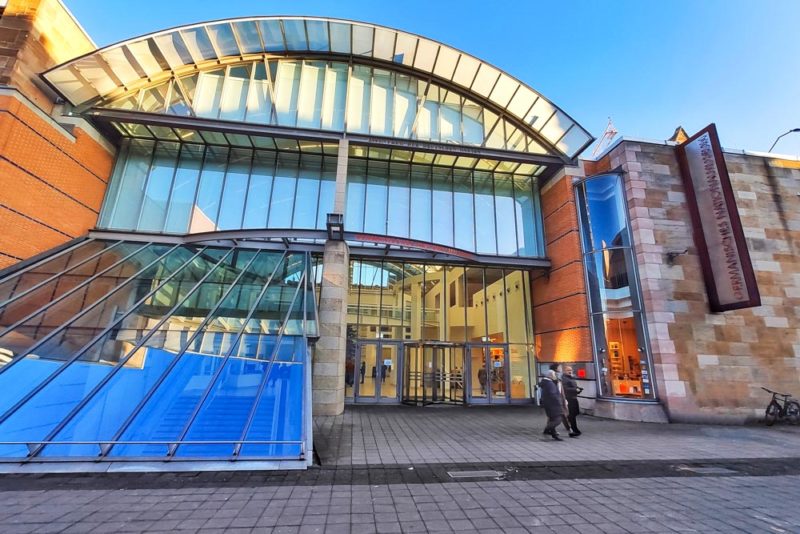
The collection is impressive, and you’ll find early stone age tools, medieval weapons and religious relics, and even a self-portrait by Rembrandt. The exhibits cover prehistory, the Middle Ages, the early modern era, and the contemporary. You’ll quickly find that hours have passed while you browse through history and culture!
Interestingly, you’ll find that the new and old buildings of the museum are intersected by the Way of Human Rights . This unique monument contains 30 tall pillars, each of which is inscribed with a passage from the Declaration of Human Rights. The monument is one way in which the city approaches its darker, Nazi-era past and shows just how far Nuremberg has come since World War II.
6. Visit the Documentation Center Nazi Party Rally Grounds
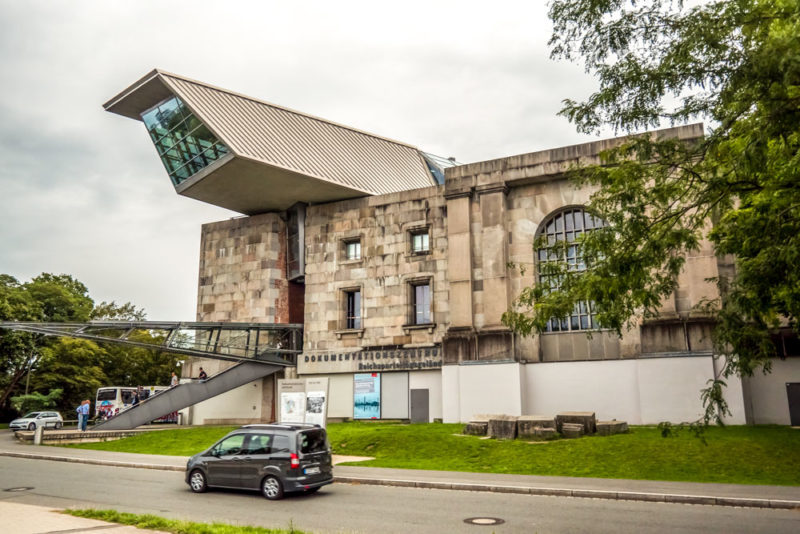
Nuremberg has a darker 20th-century history. You may already know that the city played a prominent role in the rise of the Nazis and was the scene of the infamous Nuremberg Trials in the aftermath of World War II.
Rather than sweeping this all under the rug, though, Nuremberg has tackled its recent past head-on. During the 1930s, Nuremberg hosted infamous Nazi rallies at the purpose-built Congress Hall. This extravagant coliseum-style parade ground has now been turned into a Documentation Center and a place of education called the Documentation Center Nazi Party Rally Grounds .
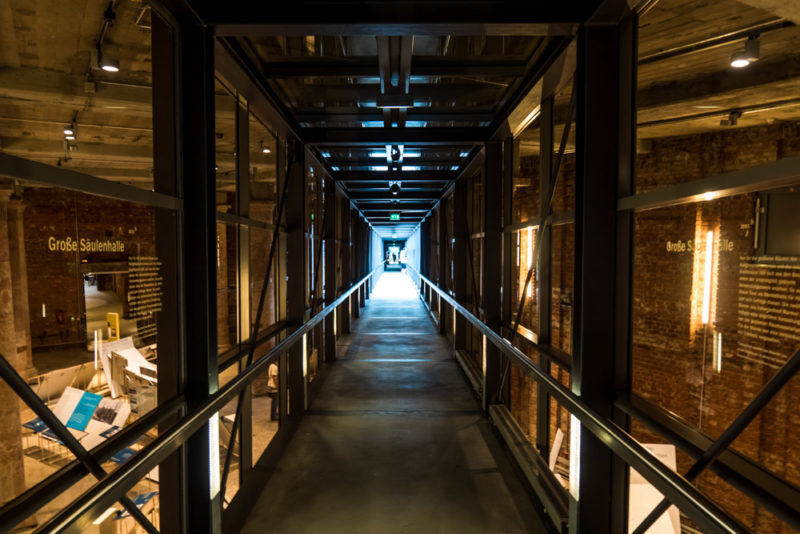
The permanent exhibition at the museum is titled Fascination and Terror , and offers an eye-opening journey through the history of the Nazi Party. The exhibition demonstrates how the Nazi Party was allowed to come to power, and ultimately, shows how anything similar can be halted in the future.
Tour the grounds
[irp posts=”85182″ name=”The 15 Best Things to do in Munich, Germany”]
7. Explore the aftermath of WWII at the Nuremberg Courthouse
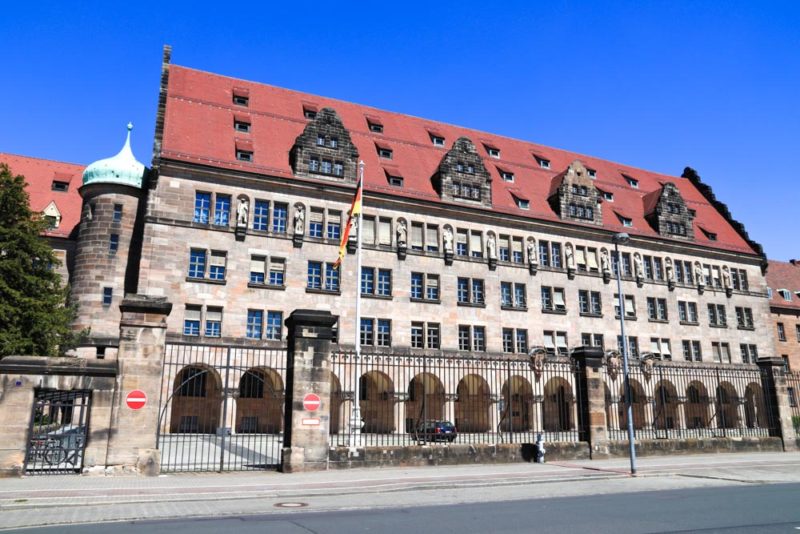
Although it may not always be visible among the medieval Old Town, Nuremberg is still inseparable from its World War II history. As well as being infamous for its association with the rise of the Nazi Party to power, Nuremberg is perhaps even more associated with the trials of the Nazi leadership at the end of the conflict.
Due to this association and involvement with the Nazi Party, the Allies chose Nuremberg as the place where the surviving Nazis would face justice for their actions during the war. The historic events took place in the Palace of Justice outside the Altstadt. Often called “the greatest trial in history,” the Nuremberg Trials revealed Nazi atrocities to the world.
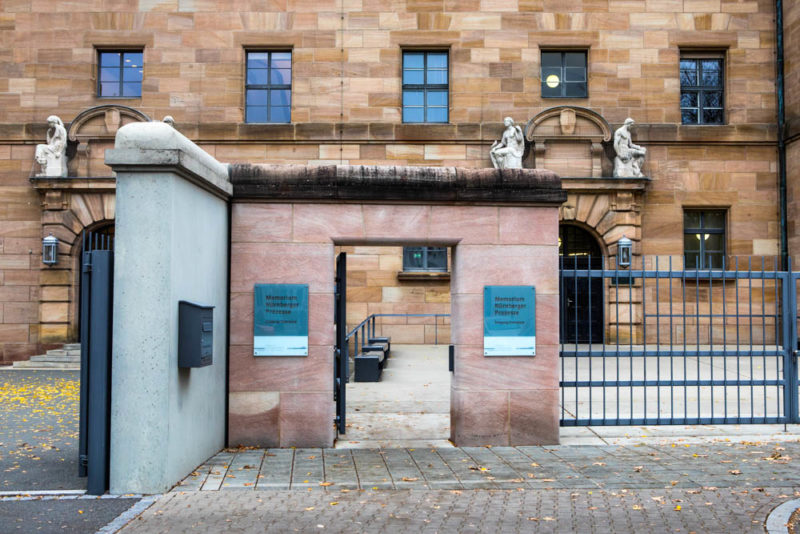
As with the Documentation Center Nazi Party Rally Grounds, the courthouse has been preserved as an educational tool for future generations. In fact, the actual courthouse where the trials took place remained a working court of law until 2020.
It’s quite eerie, but you can see the courtroom where some of history’s greatest villains were sentenced. Above the courtroom, you’ll find the museum, where you can learn more about the Nuremberg Trials and the Nazis who were put on trial.
8. Learn all about Nuremberg’s favorite artist
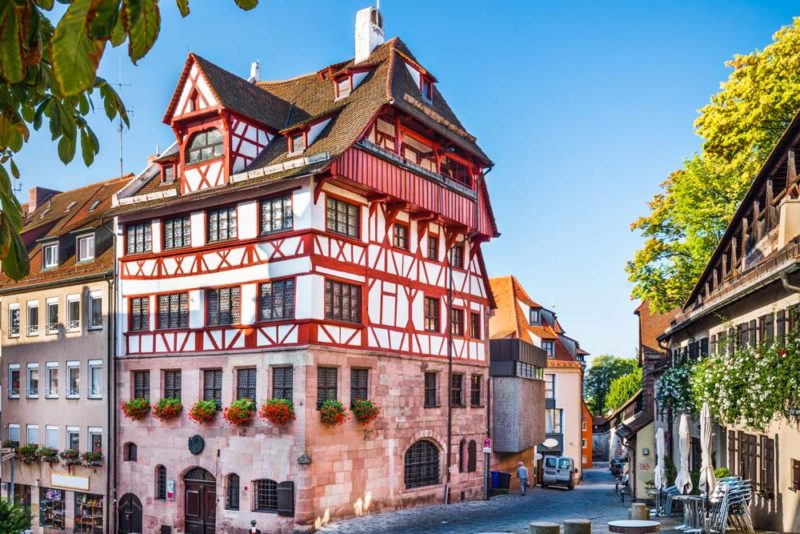
One of Germany ’s most famous artists is Albrecht Durer, a Renaissance painter, printer, sculptor, and engraver who was born and raised in Nuremberg. Durer’s House , which he lived in from 1509 until 1528, is now one of Nuremberg’s most popular museums. You’ll find it right in the middle of the Altstadt, just a short stroll away from the Imperial Castle.
Durer was prolific during his career, and he dabbled in many forms of artistry and was on par – if less well known – with the Italian Renaissance greats. Durer’s home was turned into a museum dedicated to his life and work in 1871 (on the anniversary of his birth), and it’s a fascinating place for art lovers to explore. You’ll find artwork and paintings, as well as Renaissance-era furnishings and decor that show what it was like to live and work in Nuremberg in the 1500s.
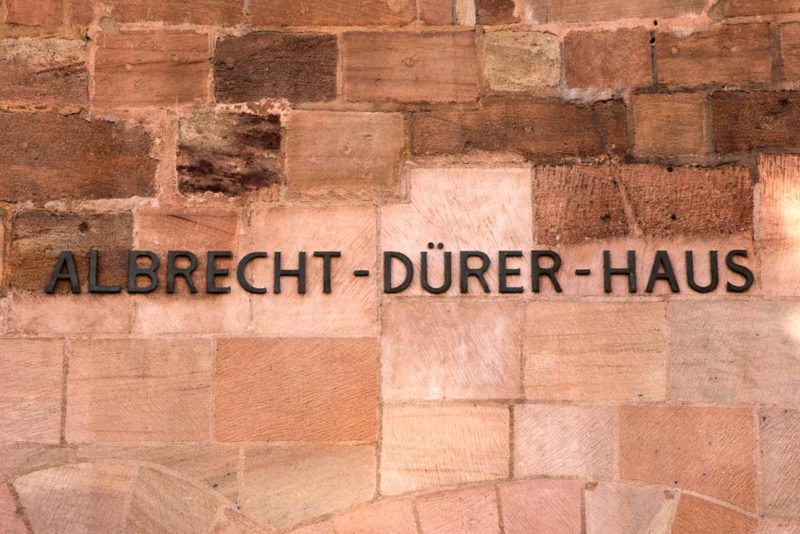
The house itself is one of the best-preserved medieval homes in the Altstadt. The distinctive timbered facade is brightly painted, and the original building dates back to 1420, although much of it had to be restored following World War II.
9. Admire modern art at the Neues Museum
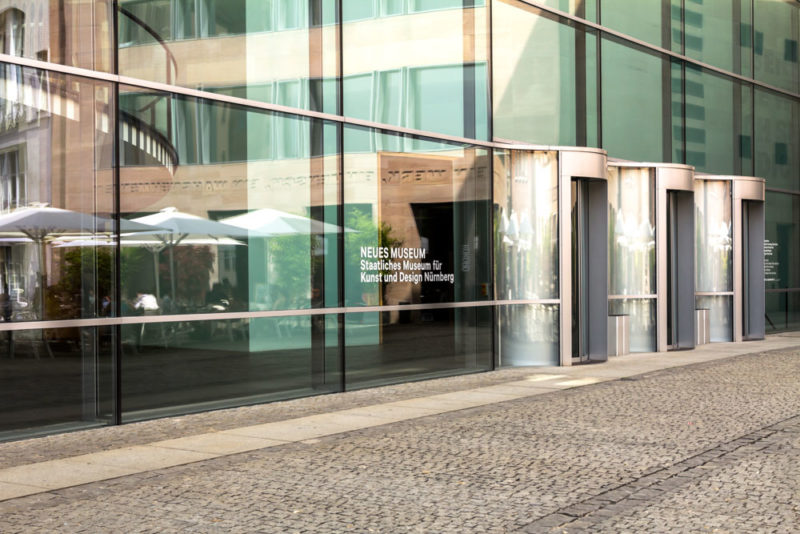
Are you an art lover? Then you’re going to love the modern art on display at the Neues Museum . This museum is one of the coolest things to do in Nuremberg, and you’ll find the sleek contemporary design and glass facade of the building stands in stark contrast to the surrounding Old Town architecture.
Head inside the Neues Museum, and you’ll find a unique selection of exhibitions showcasing the works of both local and international artists in the modern era. Exhibitions blur the lines between art and design.
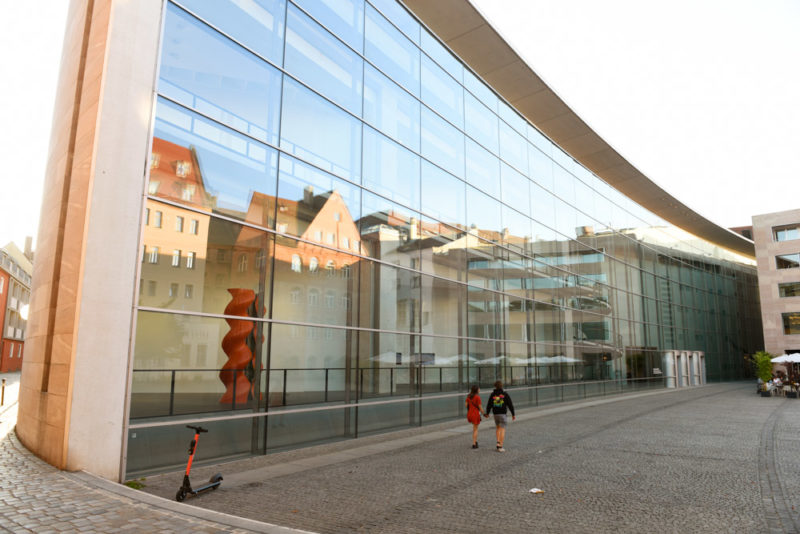
Plus, there’s incredible photography and light work, and there’s a wonderfully refreshing (and modern) selection of work that makes a progressive change from the medieval art you’ll have seen throughout the Altstadt.
There’s an ever-changing cycle of temporary exhibitions at the Neues Museum, so check the calendar to see what’s planned during your Nuremberg sightseeing trip. Most intriguing of all, you’ll be surprised to learn that the rooftop of the Neues Museum is home to a large colony of bees. The endangered bees are not only being saved, but the city’s beekeepers harvest the honey, which you can then purchase in the gift shop!
[irp posts=”76653″ name=”The 12 Best Boutique Hotels in Munich, Germany”]
10. Eat, drink, & shop at Handwerkerhof Nuremberg
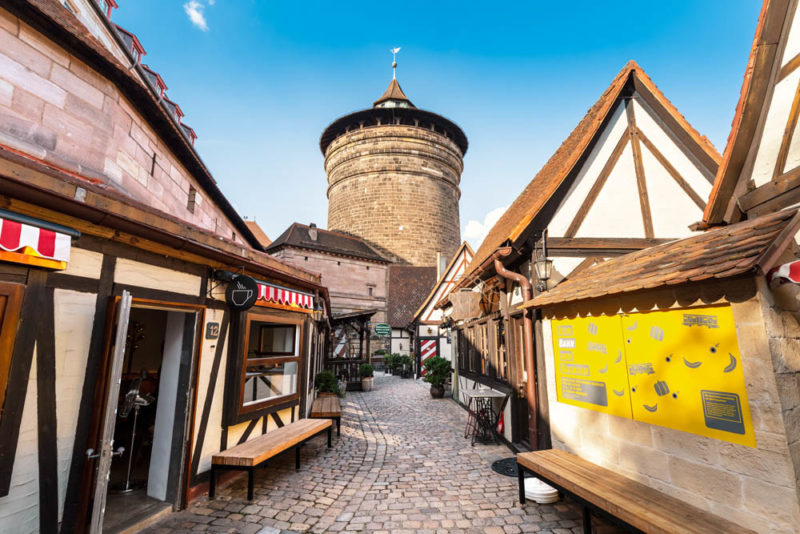
If you’re in the market for quirky souvenirs to take home, then you’ll find all you need at Handwerkerhof , where you can eat, drink, and shop in a medieval-themed marketplace!
Handwerkerhof is located on the southern side of the Altstadt, within a historic section of the city walls that was once the royal armory. Step through the medieval gateway, and you’ll find yourself transported back in time. Yes, it’s quite touristy, but we love it anyway.
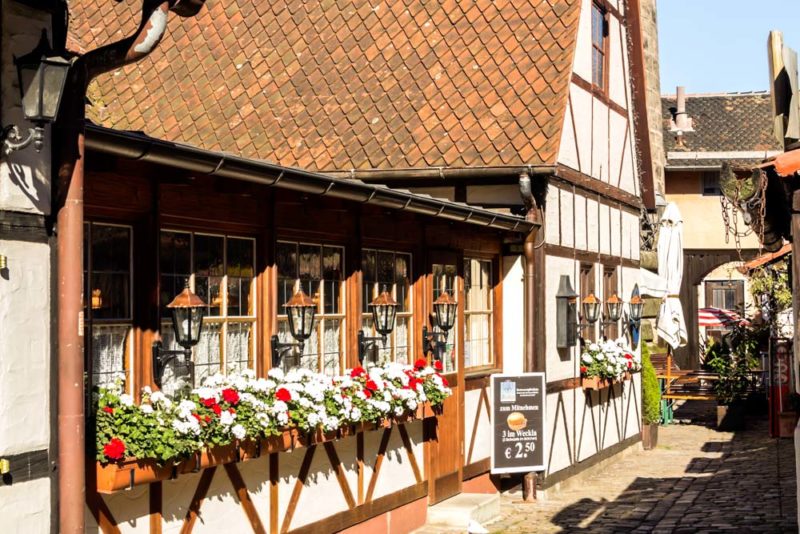
Handwerkerhof is home to a wonderful selection of craft stalls and shops, and you’ll find lots of opportunities to purchase handmade goods as you browse through the market. There are also lots of opportunities to sample and buy local delicacies, including Nuremberg’s famous sausages.
11. Go underground (and drink beer) in the Rock-Cut Cellars
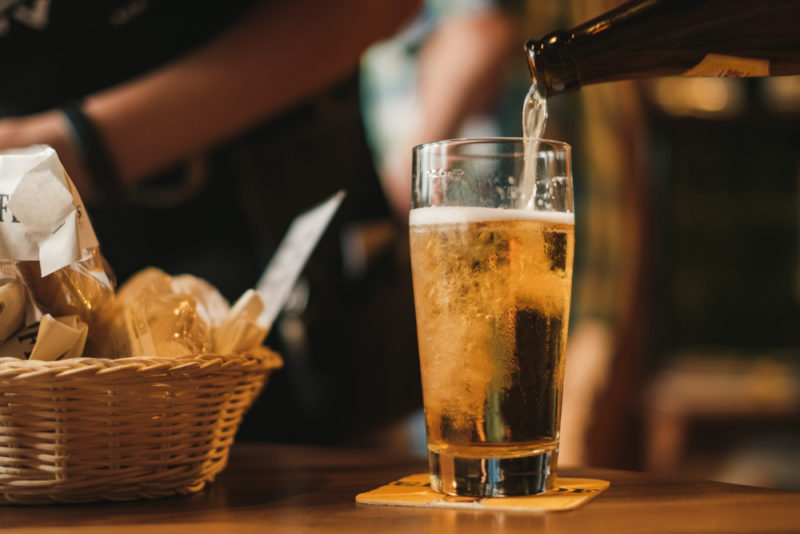
One of the coolest things to do in Nuremberg is an underground tour of the city’s Rock-Cut Cellars. For hundreds of years, tunnels, cellars, and storehouses were carved below the city, and you can now take a tour to learn more about this subterranean world!
While many of the underground vaults were simply used as prisons, many more were used to store beer or even as beer brew houses. During World War II, many of these Rock-Cut Cellars were used as air-raid shelters, while today, some are also still in use for storage and now tourism.
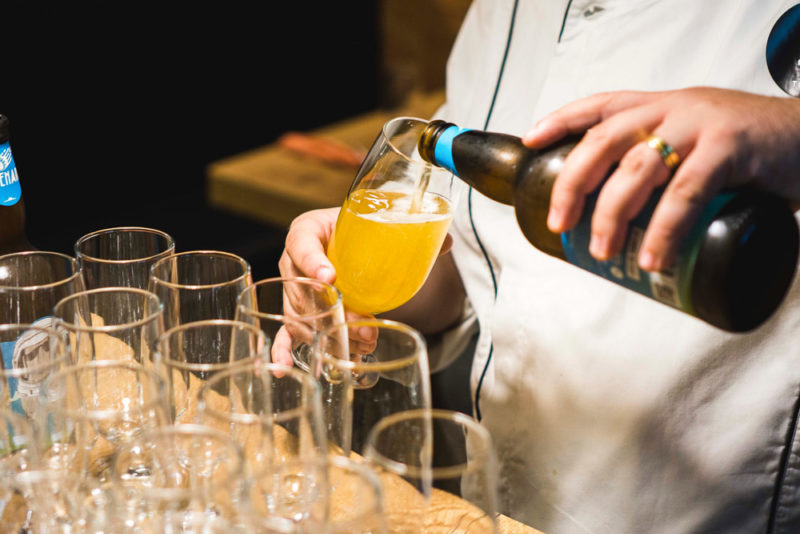
One local brewer offers tours below ground of the extensive network of cellars – which measure some 20,000 square meters in total – and ends the experience with beer drinking at their Nuremberg tavern!
12. Try the famous Nuremberg sausages
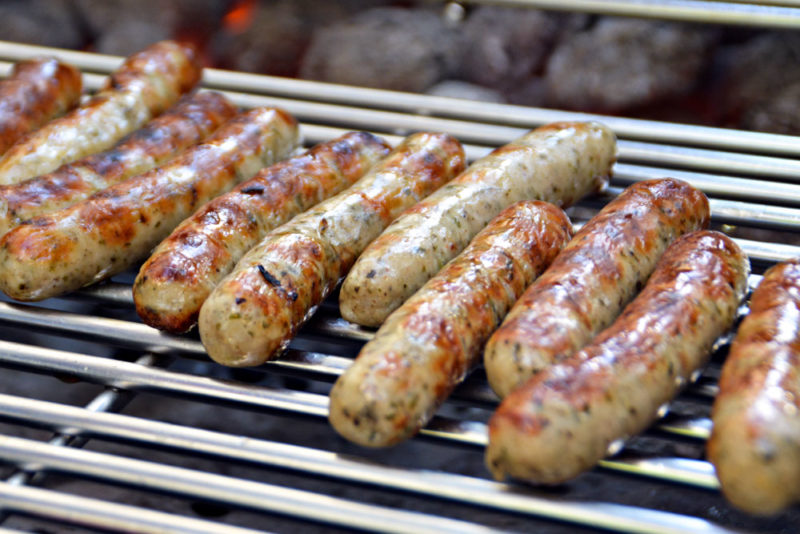
At this point in your trip, we expect you’re starting to get hungry. Luckily, Nuremberg has plenty of tasty dishes for you to try! The city is highly regarded for its local Franconian cuisine, which to an outsider seems very heavy on meat and sauerkraut.
If you are a meat-eater, then you’ll want to try the famous Nuremberg sausages, which can only be produced in this region of Bavaria. In fact, you’ll be surprised to learn that there are strict rules governing what counts as a Nuremberg sausage, such is the seriousness with which Nurembergers take their sausages. A Nuremberg sausage is around 3 inches long, and it’s thinner and smaller than standard German bratwurst, although similar in taste.
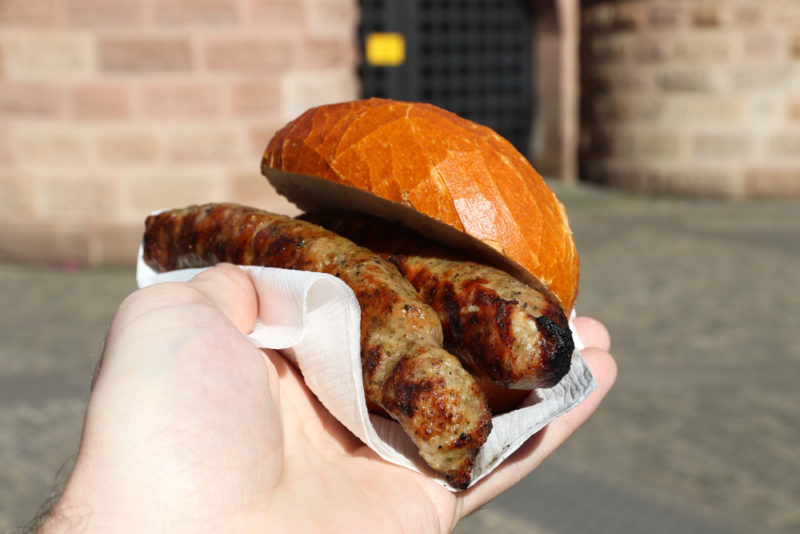
Nuremberg sausages are best enjoyed with a local beer. If you’re a vegetarian, we recommend sticking to the local potato or asparagus salads. However, you may get lucky and stumble across a veggie version of the Nuremberg sausage on occasion!
[irp posts=”76683″ name=”The 12 Best Castle Hotels in Germany”]
13. Revel in Nuremberg’s Christmas festivities
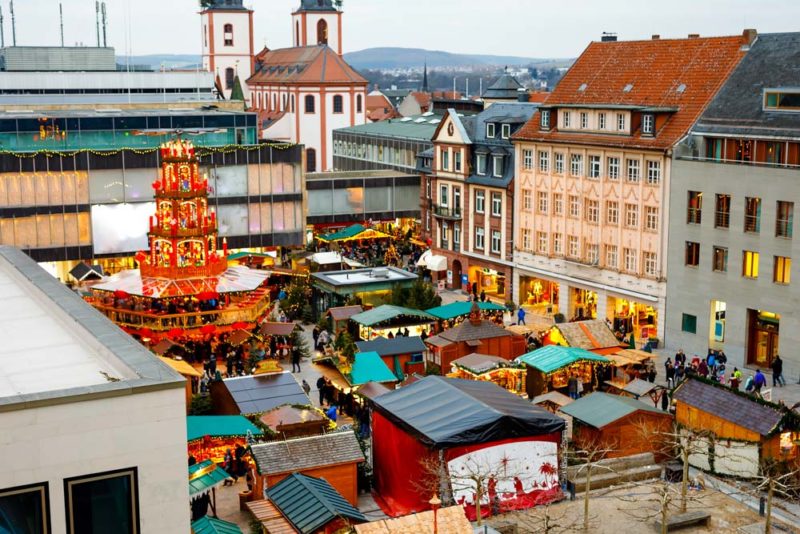
Christmas is a glorious time of year to visit Nuremberg, and we know you’re going to love the seasonal festivities, markets, and Christmas cheer that swipe through the city!
The highlight, of course, is the Christmas Market – or the Christkindlesmarkt , as the locals call it. Nuremberg’s extravagant Christmas Market is one of the best and oldest in the world, and you’ll find it suitably located in the Hauptmarkt, right in the heart of the Altstadt.
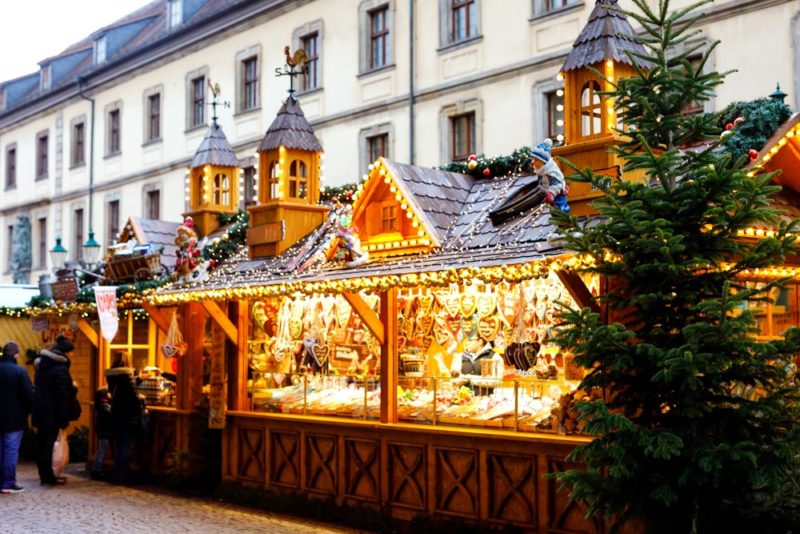
It’s a historic location for a historic Christmas market, and you’ll appreciate the quaint wood huts and timber stalls that add to the sense of timeless tradition. If you’re on the hunt for Christmas presents, you’ll find an abundance of gifts to choose from, including handmade arts and crafts, Christmas decorations, and traditional Bavarian clothing, among much more.
The Christmas Market is also well known for its culinary offerings, and you can indulge in warming mulled wine, gingerbread, and Nuremberg’s world-famous sausages.
Nuremberg’s Christmas Market begins at the end of November, and it kicks off with a traditional schedule of festive events, including carol singing and the introduction of the Christkind. The market continues until December 24, giving you plenty of time to enjoy the festivities!
14. Go hiking in Nuremberger Land
The countryside to the east of Nuremberg is beautiful, and it’s the perfect place to enjoy a day of hiking. Known as Nuremberger Land, you’ll quickly find yourself a long way from city life as you hike through valleys, take in sweeping panoramas from hilltops, and stumble across historic castles and romantic rural villages.
Grab a map in Nuremberg, and start planning because there are over 1,000 miles worth of waymarked trails that you can follow in the region. Many are accessible via public transport from the city, making for an excellent opportunity for a rural day trip.
You can find inspiration for your hikes on the Nuremberger Land website . Plus, you’ll be able to tailor routes to suit your experience, fitness level, and sightseeing goals.
15. Road trip the Romantic Road
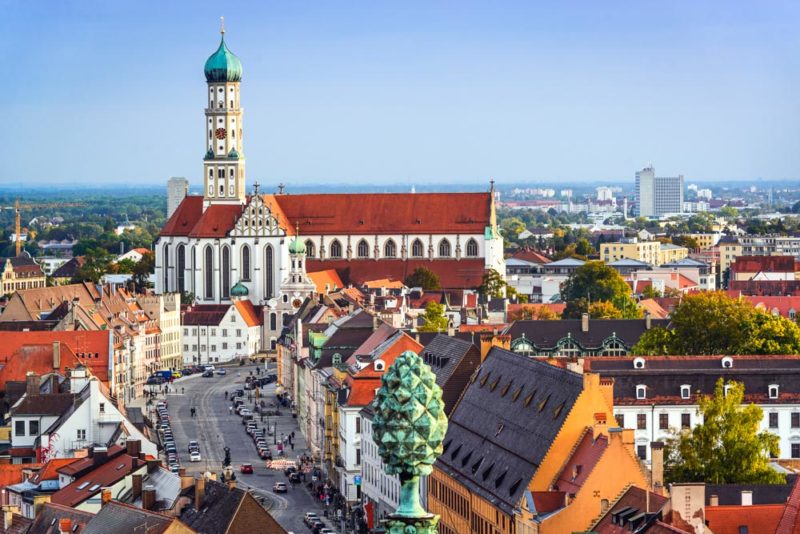
Do you love road tripping? Then we’ve got the perfect route for you to drive: The Romantic Road!
This 285-mile driving route takes you through Bavaria’s most beautiful, dreamy, and romantic destinations, and it starts (or ends) in Wurzburg, a historic town that’s just to the northwest of Nuremberg.
From Wurzburg, the route heads south and continues all the way down to the border with Austria. You don’t have to drive the whole thing, of course, and if you choose to tackle the northern sections, you’ll never be more than a 1- to 2-hour drive away from Nuremberg.
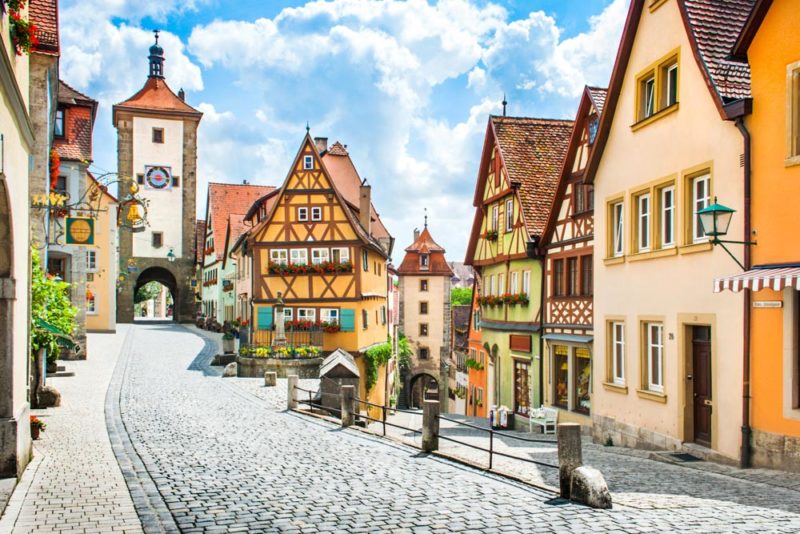
Highlights of the Romantic Road include Wurzburg, Rothenburg ob der Tauber, Augsburg, and the fairy tale Neuschwanstein Castle. The route is aptly named because it passes through many of Bavaria’s most “romantic” towns and villages, where you’ll find beautiful medieval architecture, rural charms, and enduring Germanic traditions to explore.
You can enjoy day trips from Nuremberg to the nearest destinations on the Romantic Road using the city as your home base for a multi-day itinerary, or you could hit the road for a week-long road trip once you’ve seen all of the best things to do in Nuremberg!
[irp posts=”103381″ name=”The 25 Best Things to do in Germany”]
There you have it! The 15 best things to do in Nuremberg. What’s your favorite thing to do in Nuremberg?
Planning a trip to Germany? Check out our favorite books and travel guides!

SHARE THIS ON PINTEREST
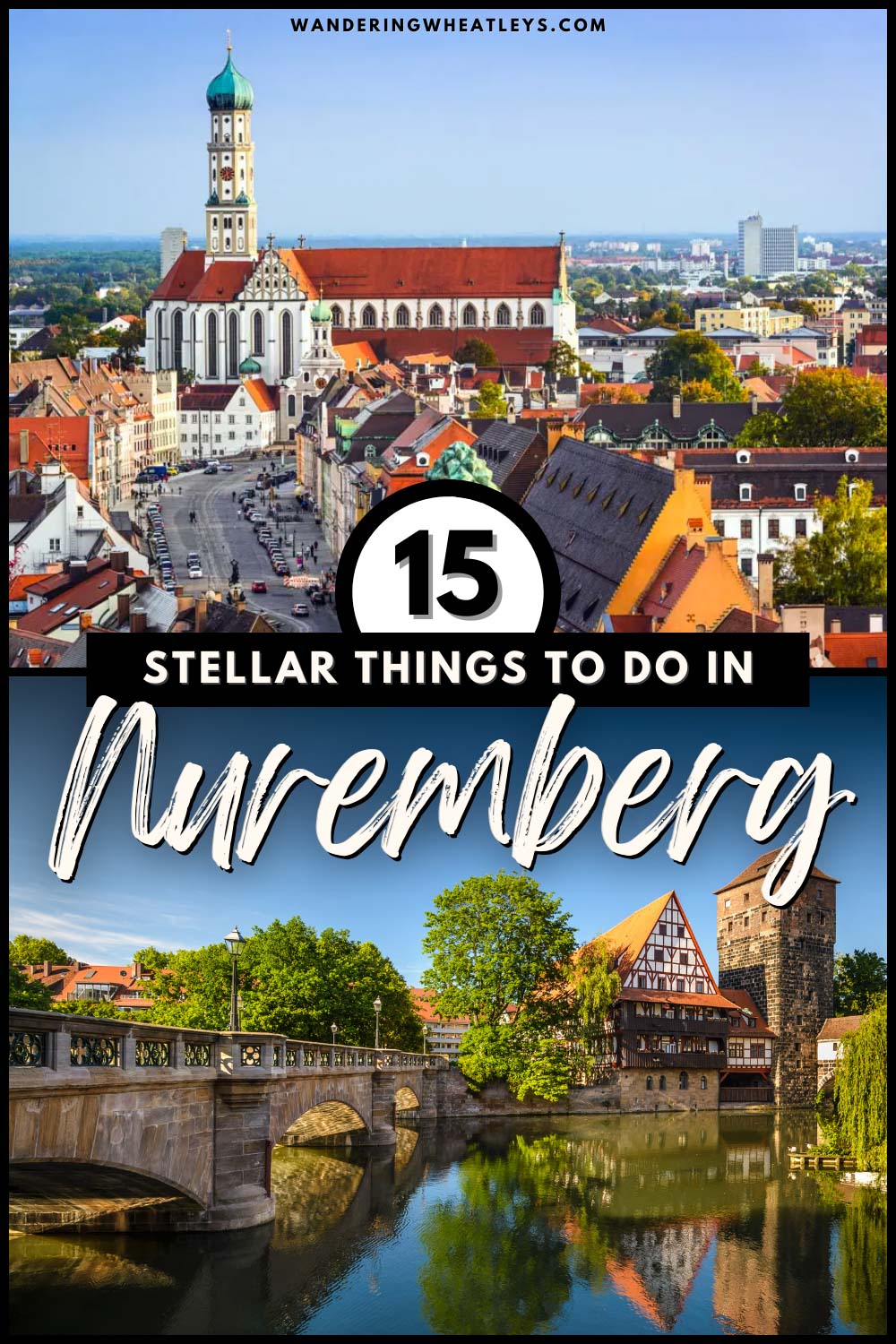
Frequently Asked Questions
If it’s your first time in the city and you’re wondering what to do in Nuremberg, the best place to start your trip is in the Altstadt (Old Town). Nuremberg’s Altstadt is one of the best and most colorful examples of a medieval town in Germany, although as with many historic locations throughout the country, much of what you see today had to be painstakingly restored after the destruction of World War II.
The Imperial Castle of Nuremberg, or the Kaiserburg, is one of the most important Nuremberg sightseeing attractions. The impressive castle still dominates the Altstadt to this day, with a history dating back to at least the 10th century AD when the first fortifications were built on the hilltop here.
If you’re in the market for quirky souvenirs to take home, then you’ll find all you need at Handwerkerhof, where you can eat, drink, and shop in a medieval-themed marketplace! Handwerkerhof is home to a wonderful selection of craft stalls and shops, and you’ll find lots of opportunities to purchase handmade goods as you browse through the market. There are also lots of opportunities to sample and buy local delicacies, including Nuremberg’s famous sausages.
One of the coolest things to do in Nuremberg is an underground tour of the city’s Rock-Cut Cellars. For hundreds of years, tunnels, cellars, and storehouses were carved below the city, and you can now take a tour to learn more about this subterranean world! During World War II, many of these Rock-Cut Cellars were used as air-raid shelters, while today, some are also still in use for storage and now tourism.
Nuremberg is highly regarded for its local Franconian cuisine, which to an outsider seems very heavy on meat and sauerkraut. If you are a meat-eater, then you’ll want to try the famous Nuremberg sausages, which can only be produced in this region of Bavaria.
About the Author:

Richard is an award-winning travel writer based in Southwest England who’s addicted to traveling off the beaten track. He’s traveled to 75 countries and counting in search of intriguing stories, unusual destinations, and cultural curiosities. Richard loves traveling the long way round over land and sea, and you’ll find him visiting quirky micronations and breakaway territories as often as he’s found lounging on a beach (which is a lot). When he’s not writing for BBC Travel, National Geographic, or Lonely Planet, you can find Richard writing for the Wandering Wheatleys or updating his off-beat travel blog, Travel Tramp.
View all posts

Related Posts
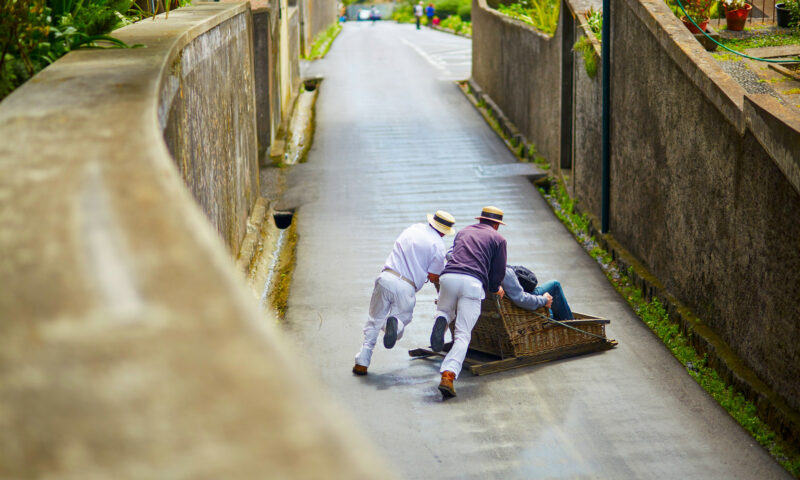
The 15 Best Things to Do in Madeira, Portugal
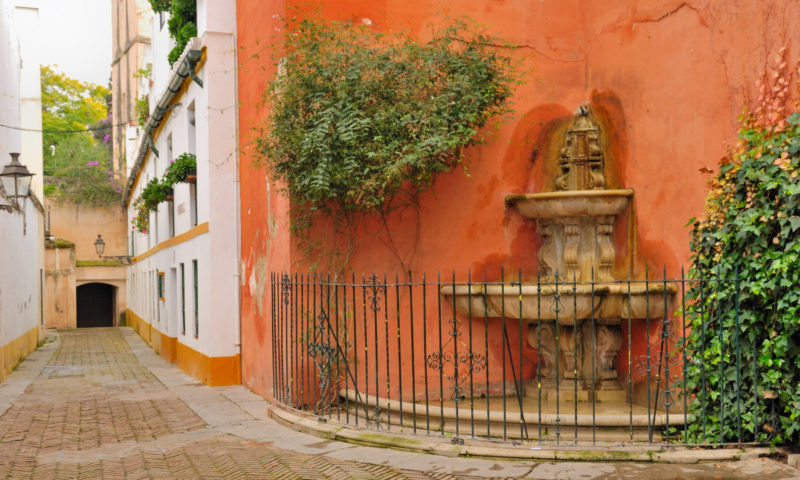
The 15 Best Things to do in Seville, Spain
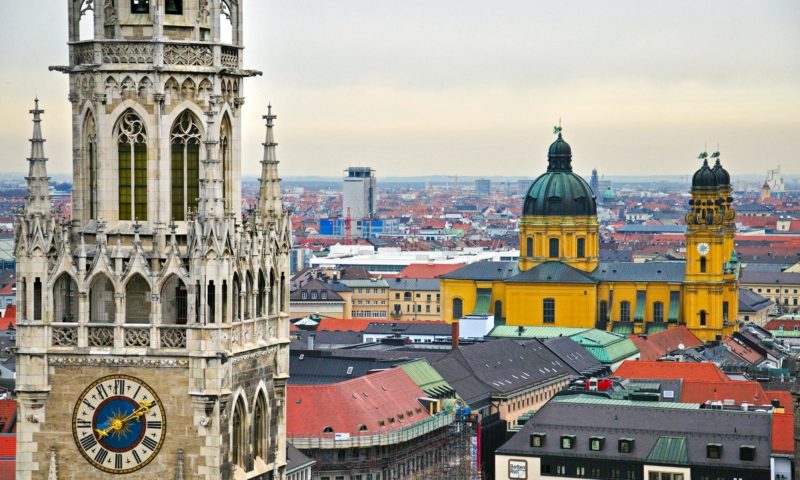
The 12 Best Boutique Hotels in Munich, Germany
Leave a comment cancel reply.
Your email address will not be published. Required fields are marked *

Fantastic Things to do in Nuremberg Germany
Written By: The Planet D
Updated On: June 24, 2023
Nuremberg was one of the last stops on our Bavarian tour and it turned out to be one of the most surprising cities we visited in Germany. Located in Northern Bavaria, Nuremberg is the second-largest city ( after Munich ) in the state. Its thousand-year-old history has survived the Holy Roman Empire and the Nazi regime to emerge as a cultural leader.
Table of Contents
Best Things to do in Nuremberg
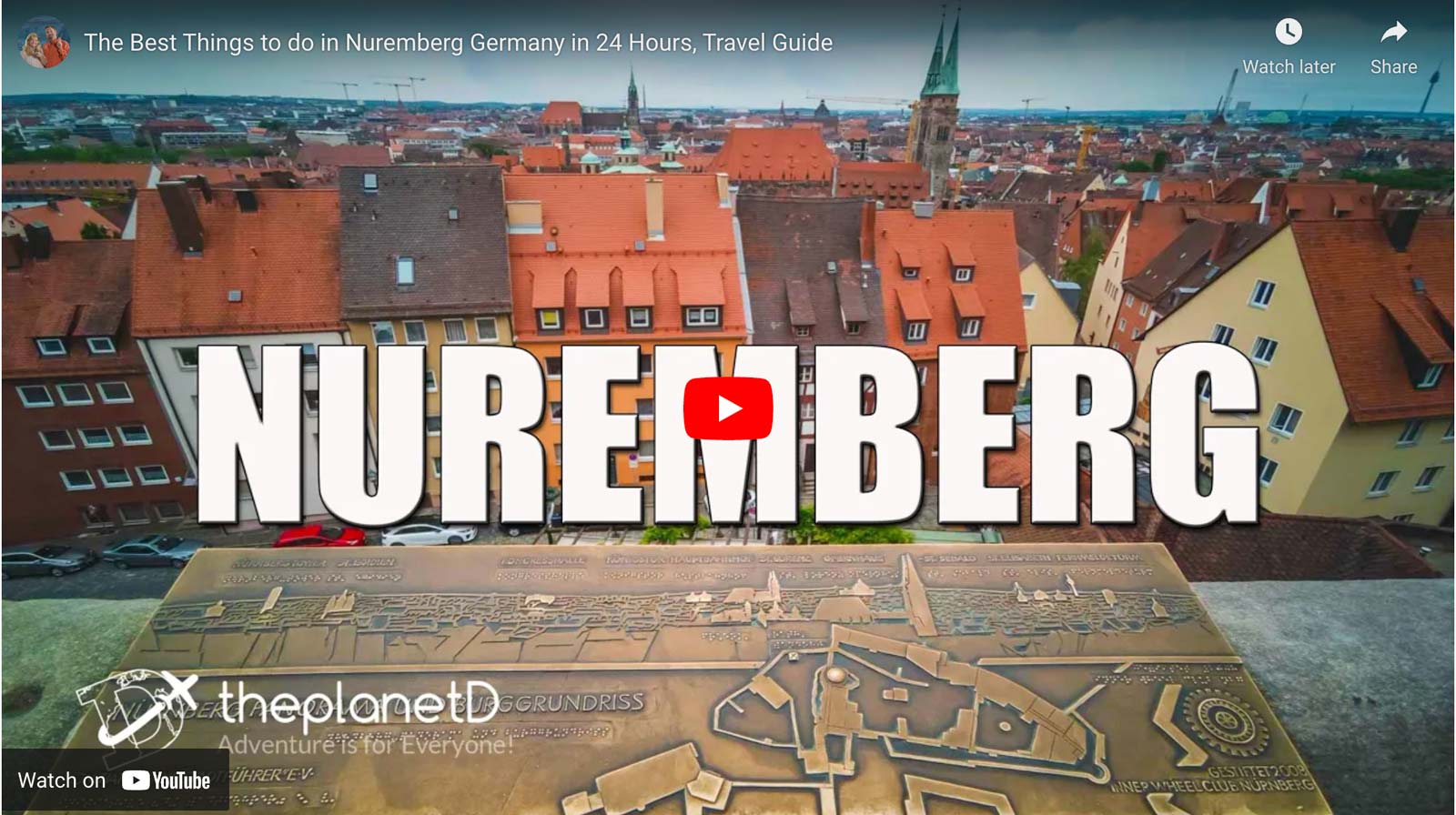
Nuremberg is filled with museums and theatres, and the beautifully restored Old Town (Altstadt) makes for a pleasant stroll with pretty half-timbered houses lining its streets. Nuremberg has something for every traveler so let’s explore all the best things to do in Nuremberg to make the most of your stay.
1. Nuremberg Castle – Imperial Castle of Nuremberg
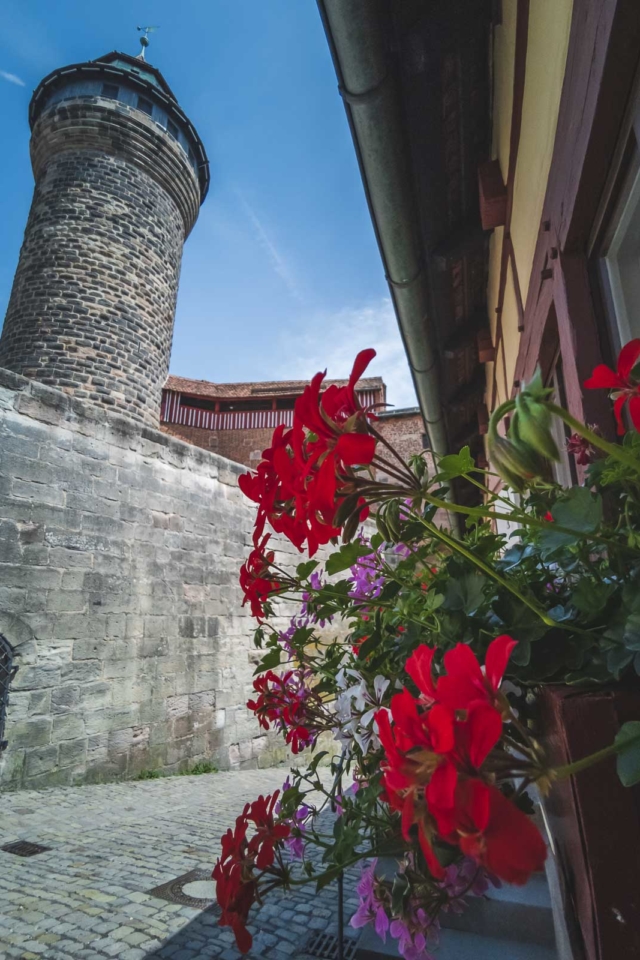
One of the first things to do in Nuremberg is to make your way to Nuremberg Castle. The Imperial Castle is the symbol of Nuremberg and has been standing since the middle ages dating back to 1050. Nuremberg played a significant role in the Holy Roman Empire and the castle symbolizes that power.
Take a walk up to the castle grounds for views of Nuremberg’s Altstadt (The Old Town) and be sure to take a tour inside the castle to explore its halls that lasted long after the fall of the Holy Roman Empire. Notable things you’ll see on a tour are its Deep Well plunging 48m (158ft) into the earth, the Sinwell Tower, the rose gardens, castle chapel, and Imperial Hall. You may also like: The Essential Guide to Germany’s Romantic Road
2. Old City Walls
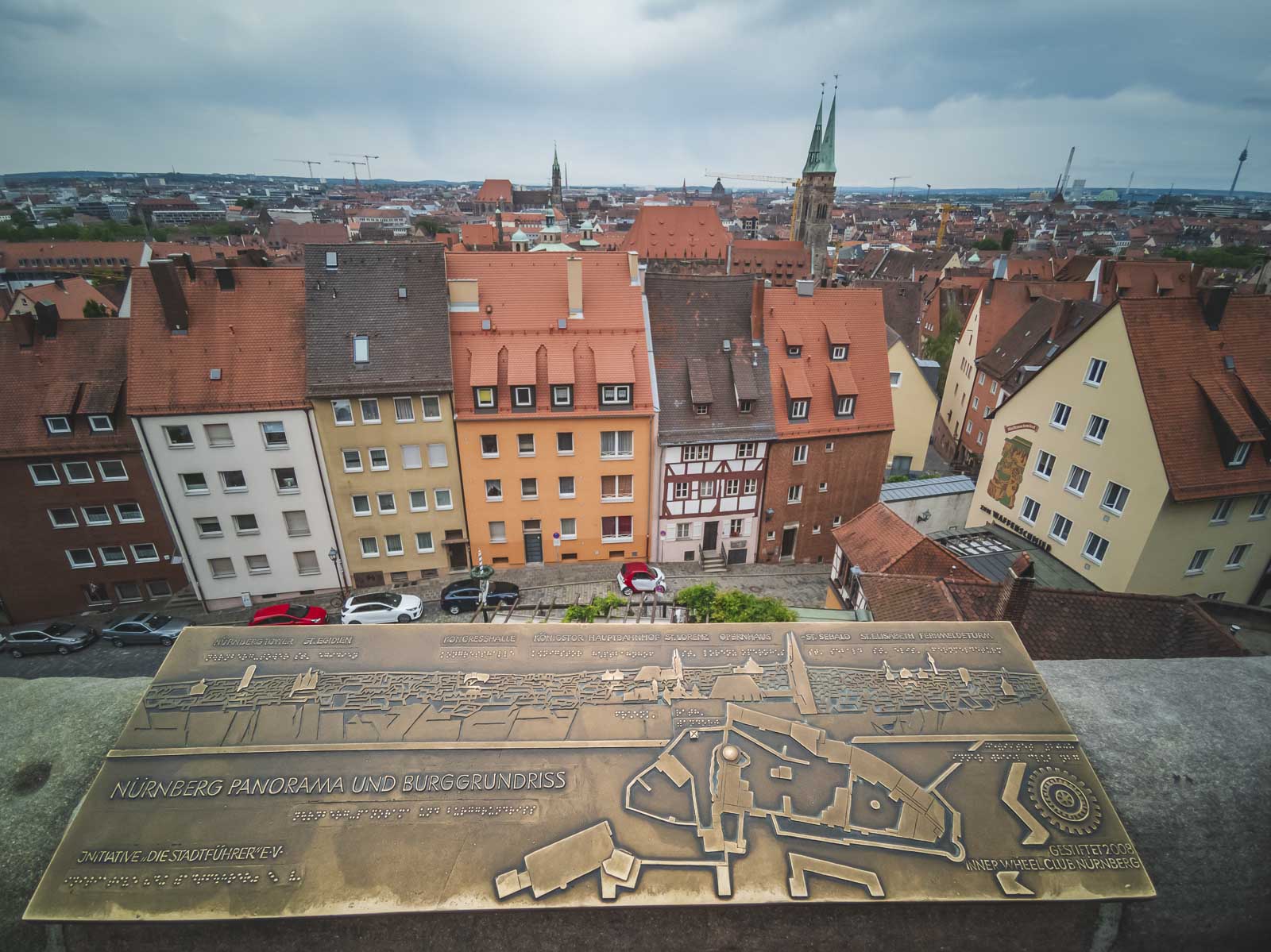
One of the most impressive things to see in Nuremberg is its Old City Walls. Constructed between the 12th and 16th centuries, the impressive city walls still span 5km around the Old Town today. You can walk along the walls with portions of it still open to explore its different towers and gates. It leads from the Nuremberg Castle all around the old town. Take this Old Town Guided Walking Tour with a local guide to discover secret spots and learn of the city’s history.
3. Hauptmarkt
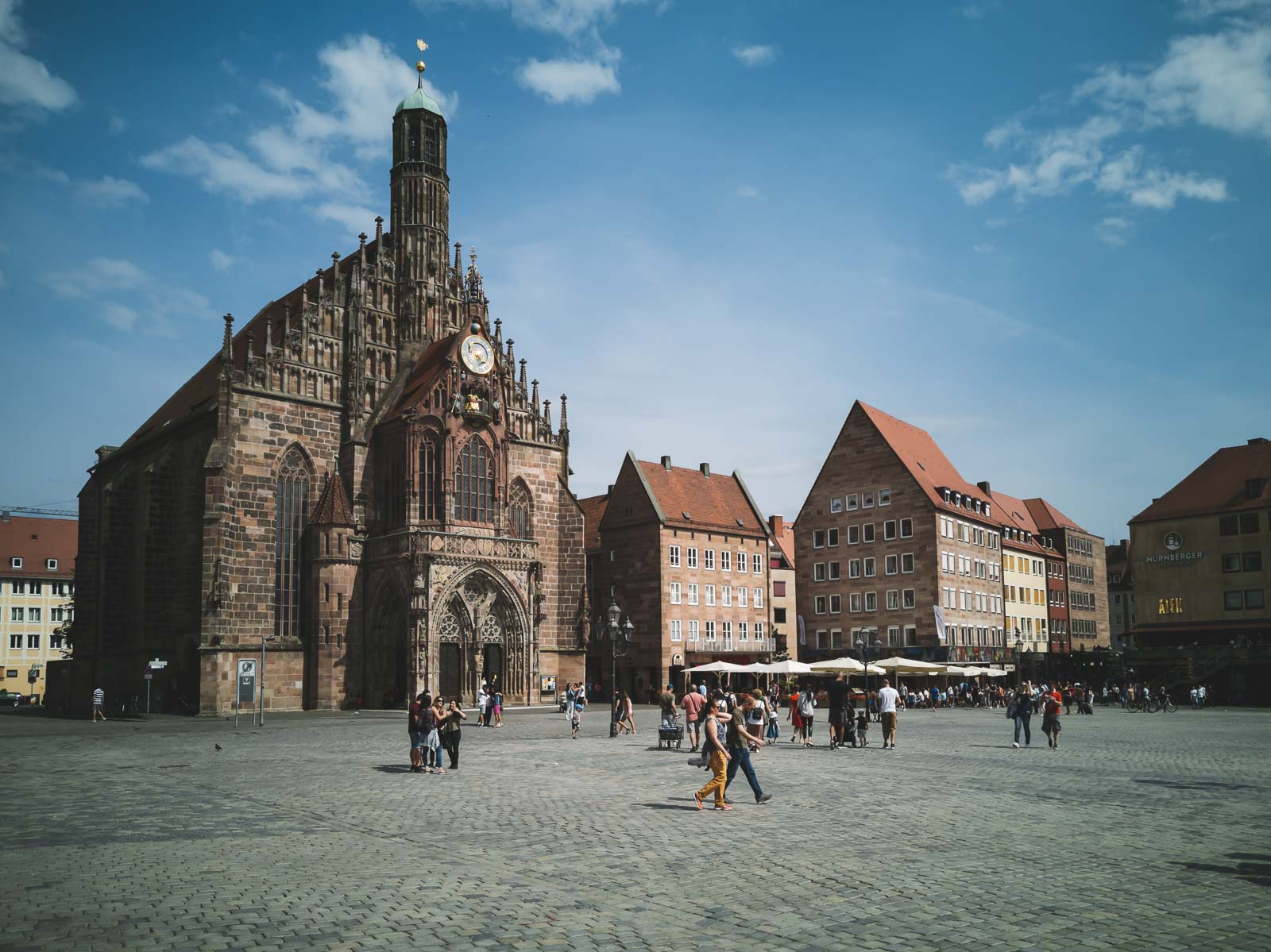
One of the first places you’ll probably visit in Nuremberg is Hauptmarkt. Nuremberg’s Main Market and city center, Hauptmarkt is a sprawling square containing the Old Town Hall (Nurnberger Rathaus) and Nuremberg’s only Baroque church, St. Giles’ Church. Here is also where you’ll find the Nuremberg tourist information center where you can join some walking tours. But it is the beautiful fountain of Hauptmarkt that is the star attraction.
We always enjoy a hop-on-hop-off-bus tour when we first arrive in a city. It’s a great way to get acquainted with the city and it stops at the historic sites and tourist attractions letting you hop off to explore as you go.
4. Schöner Brunnen
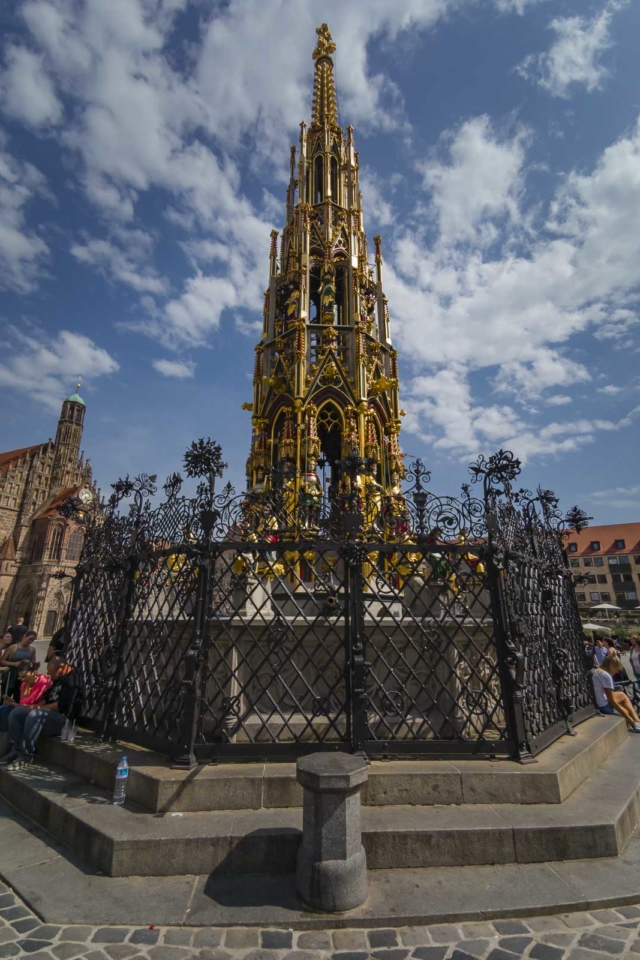
Schöner Brunnen is one of the top things to see in Nuremberg. This ornate fountain dating back to the 14th century, the fountain contains 40 figures that represent the world view of the Holy Roman Empire. It stands 19 meters high and looks like a Gothic spire. Local legend has it that if you turn the golden ring while making a wish it will come true. (but can’t that be said for all fountains?)
5. Frauenkirche – The Church of Our Lady
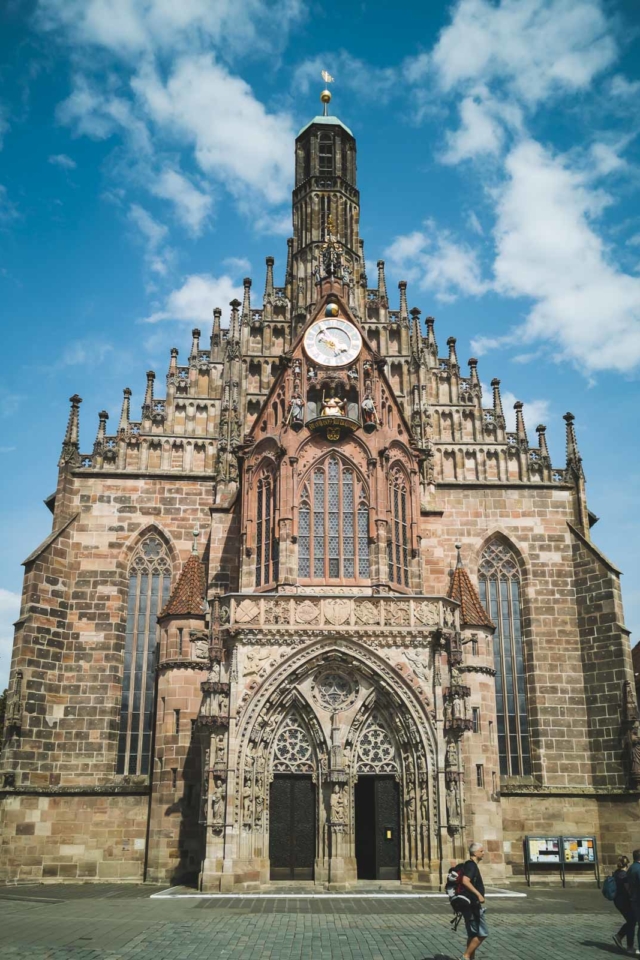
This gothic church was built by Charles IV, Holy Roman Emperor between 1352 and 1362 and can’t be missed when walking around Hauptmarkt. A good way to explore the old town is on a private walking tour. This highly rated tour, visit Hauptmarkt with the beautiful fountain and the Frauenkirche, and see Albrecht Dürer’s House, Nuremberg Castle, and more!
6. Medievel Dungeouns
For a glimpse into a dark and macabre history, the Medieval Dungeons in the cellars of Nuremberg’s Old Town Hall is not for the faint of heart. Inside you’ll see twelve tiny cells and a torture chamber. Oh, how dark and depressing the middle ages were.
7. Weißgerbergasse
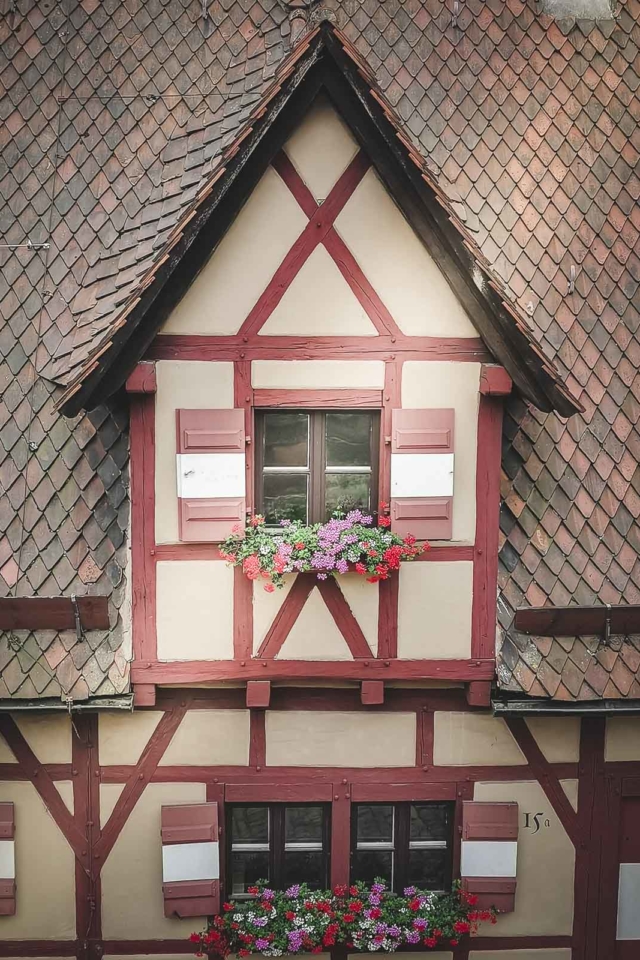
Located in the Old Town of Nuremberg, Weißgerbergasse is a fantastic walk through the Middle Ages. This street takes you along historic timber houses that were once artists’ houses and craftsmen. Also known as Tanners’ Lane Weißgerbergasse is one of the most picturesque streets in Nuremberg.
8. Handwerkerhof Nuremberg
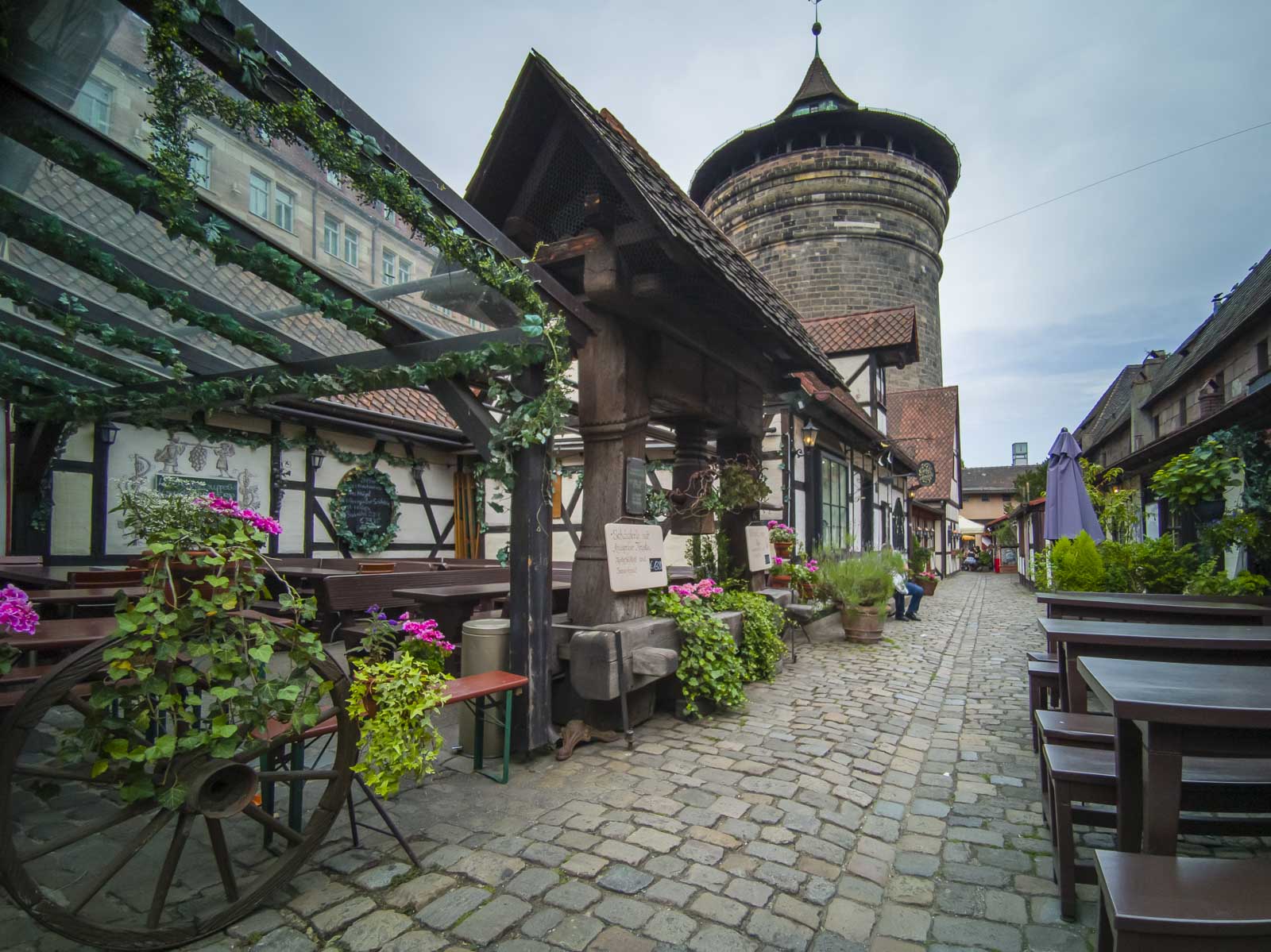
Another historic section in the Old Town is the Handwerkerhof Nuremberg. This artisan section is a Medieval village was a craftsman village that stands beside Nuremberg’s Old City Walls. Dating back to the 15th century this charming section of Nuremberg is a good place to enjoy a pint on an outdoor patio while watching artisans at work.
9. Nürnberger Felsengänge – Nuremberg Rock Passages
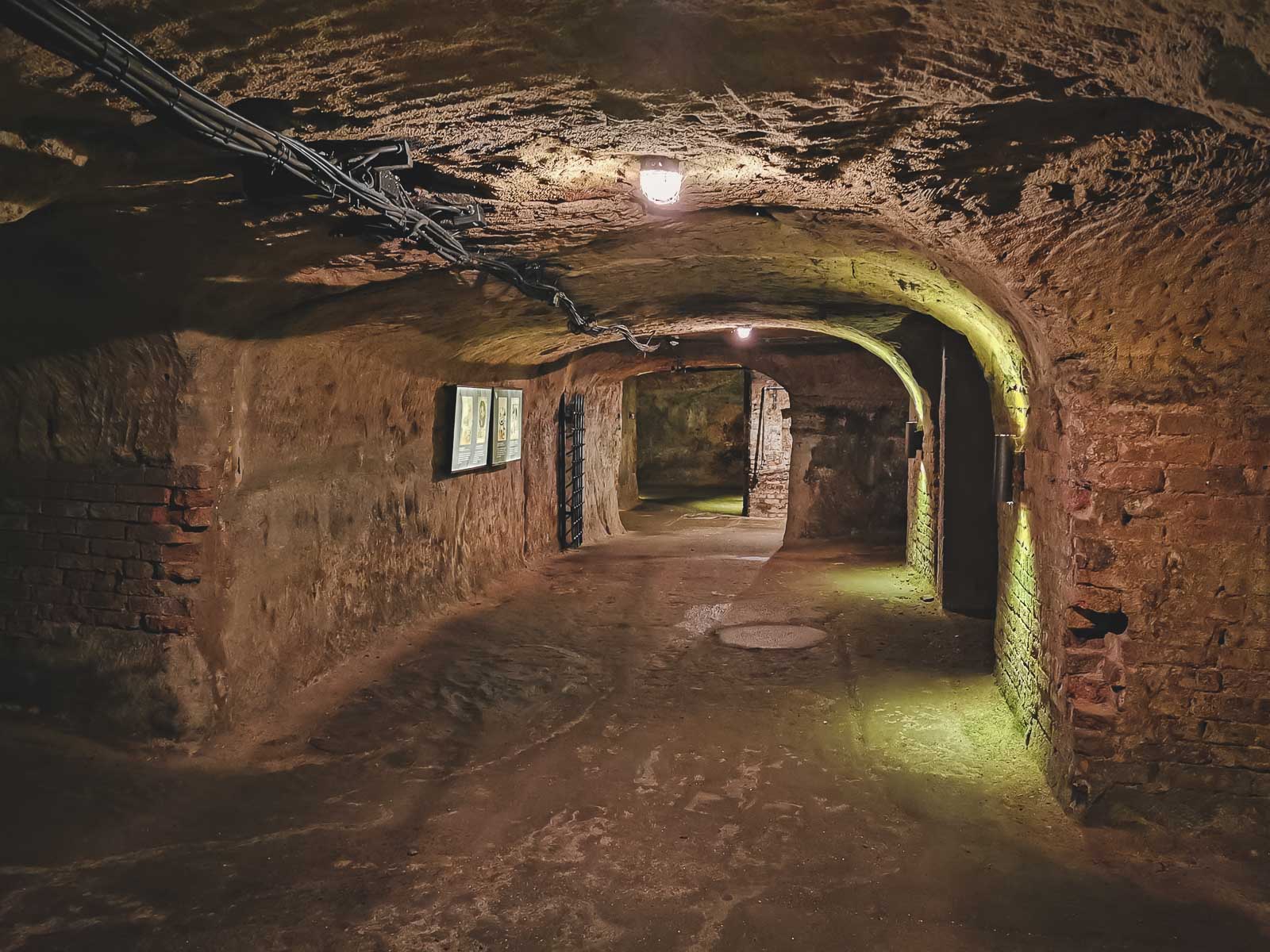
By far one of our favorite things to do in Nuremberg was to tour the Nürnberger Felsengänge. (Nuremberg Rock Passages) This labyrinth of underground tunnels dates back 600 years and was used to cool and store beer. Used by locals to seek shelter. Nuremberg was heavily bombed during World War II because it was a strategic location for the Nazis. The Nazi party took hold of its power here before the war attracting up to 1 million people at a time on the Nazi Party Rally Grounds. The city played a huge part in helping Hitler rise to power as he used it for his base of Nazi propaganda.
Cool Fact: At one time there were more than 40 breweries in Nuremberg and a law was passed that made anyone who wanted to sell beer needed to have their own beer cellar. Hence the rock cellars were born creating 20,000 square meters of rock cellars.
10. Documentation Center Nazi Party Rally Grounds
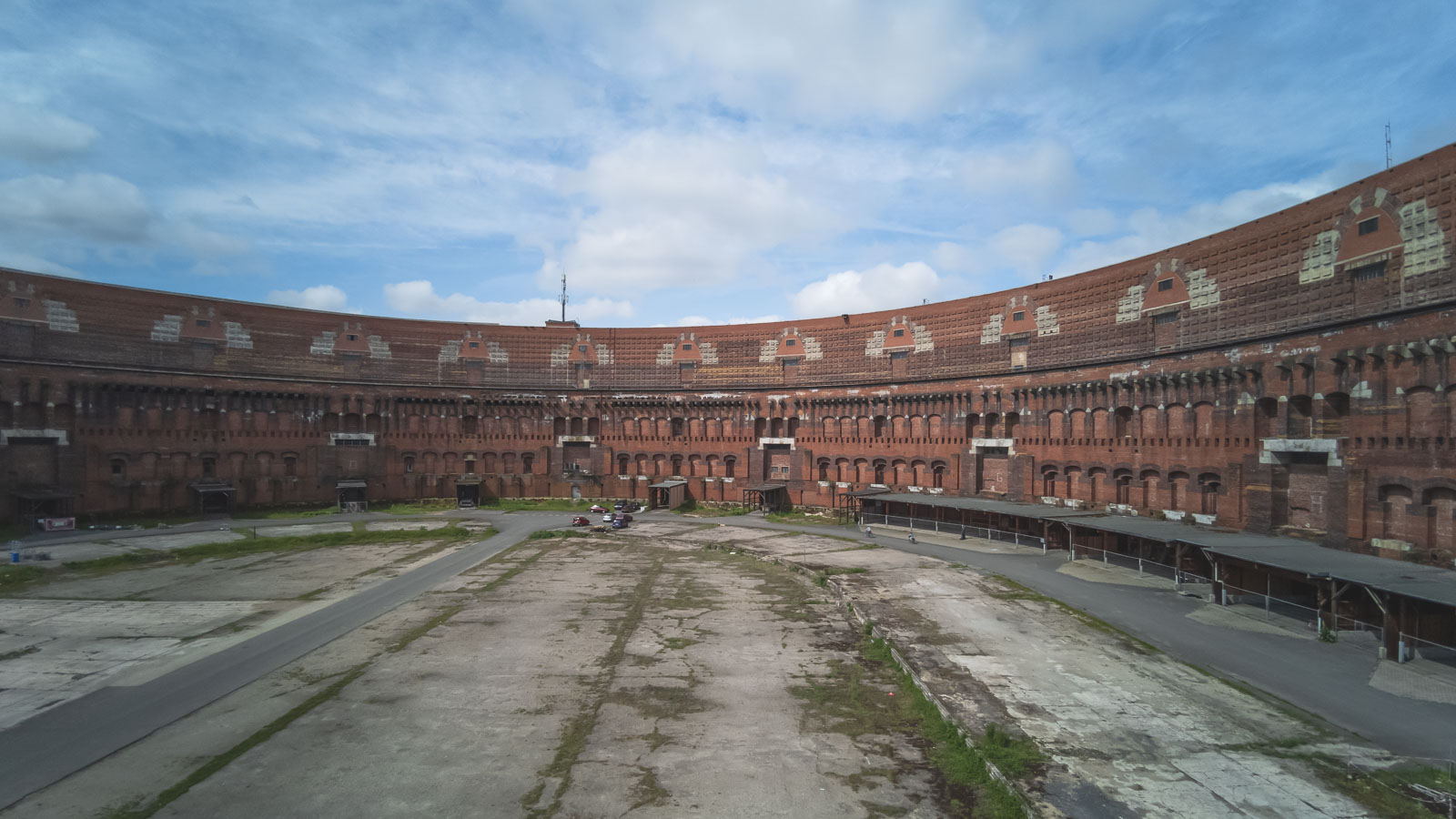
When visiting Nuremberg you must visit the Documentation Center and Nazi Party Rally Grounds. Located on the former rally grounds of the Nazi Party, we weren’t expecting to spend much time here, but we ended up spending an entire morning learning about how Hitler rose to power and how the Nazi party managed to corrupt people’s minds into following such extremism.
It pays tribute to those who suffered under the Nazi Regime and pulls no punches. You will see the horror that people faced when murdered by Hitler’s party and followers. Book a private tour to learn of this dark chapter in Nuremberg’s history through the Nazi party rally grounds and the unfinished congress hall.
11. Palace of Justice – Nuremberg Trials
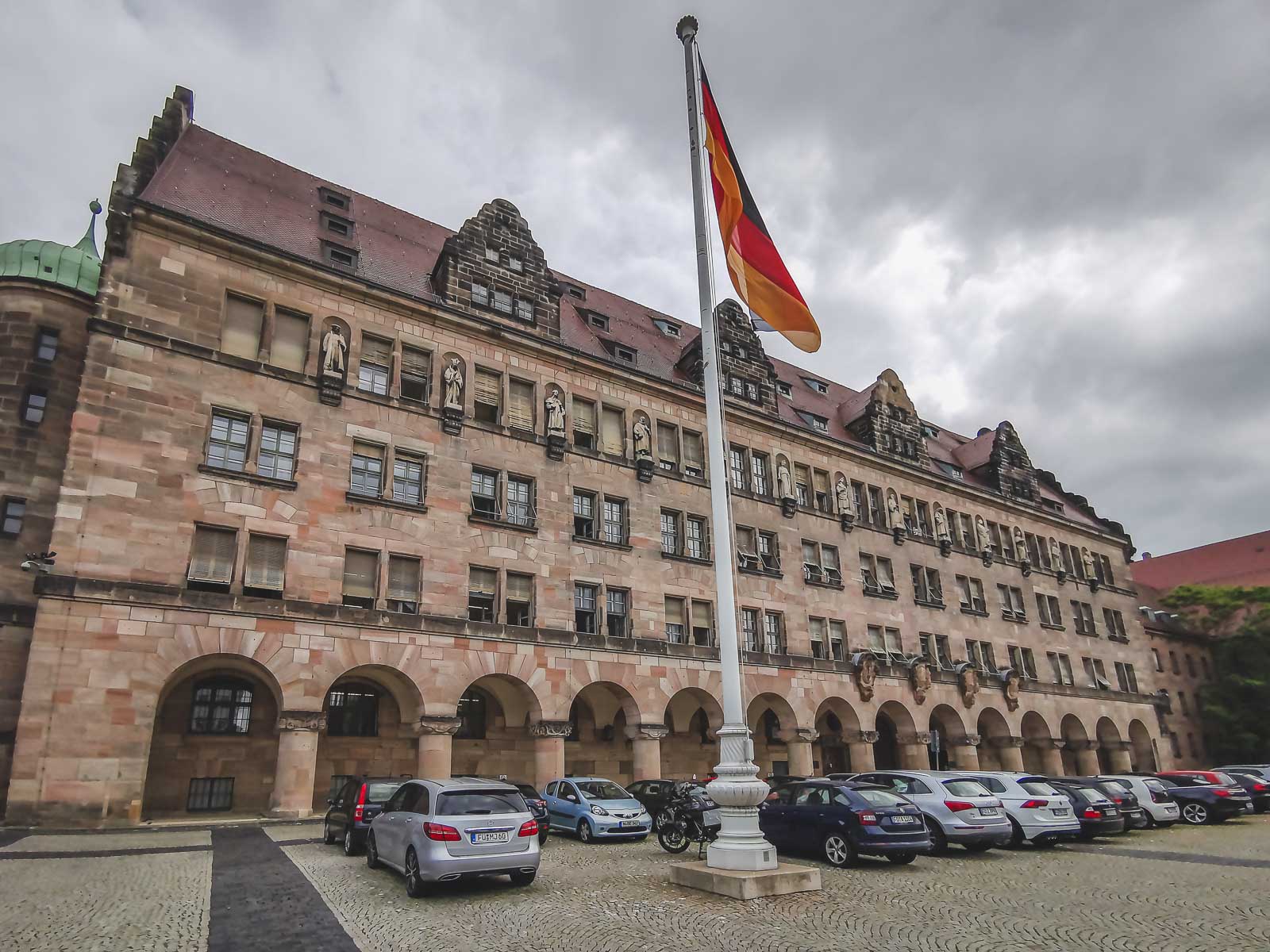
Thank God Hitler lost the war and his followers were put on trial. When exploring Nuremberg, you can visit the Palace of Justice to see where the Nuremberg Trials took place in Courtroom 600. This was where high-ranking Nazis were put on trial and found guilty of human rights abuses.
The Memorium Nuremberg Trials is located on the top floor of the courthouse and information from the Nuremberg Trials of 1946 to 1949 and the impact the Nuremberg Trials have had on the present day. Courtroom 600 is still working courtroom and the best time to visit is on Saturdays when the court is not in session.
12. Germanic National Museum
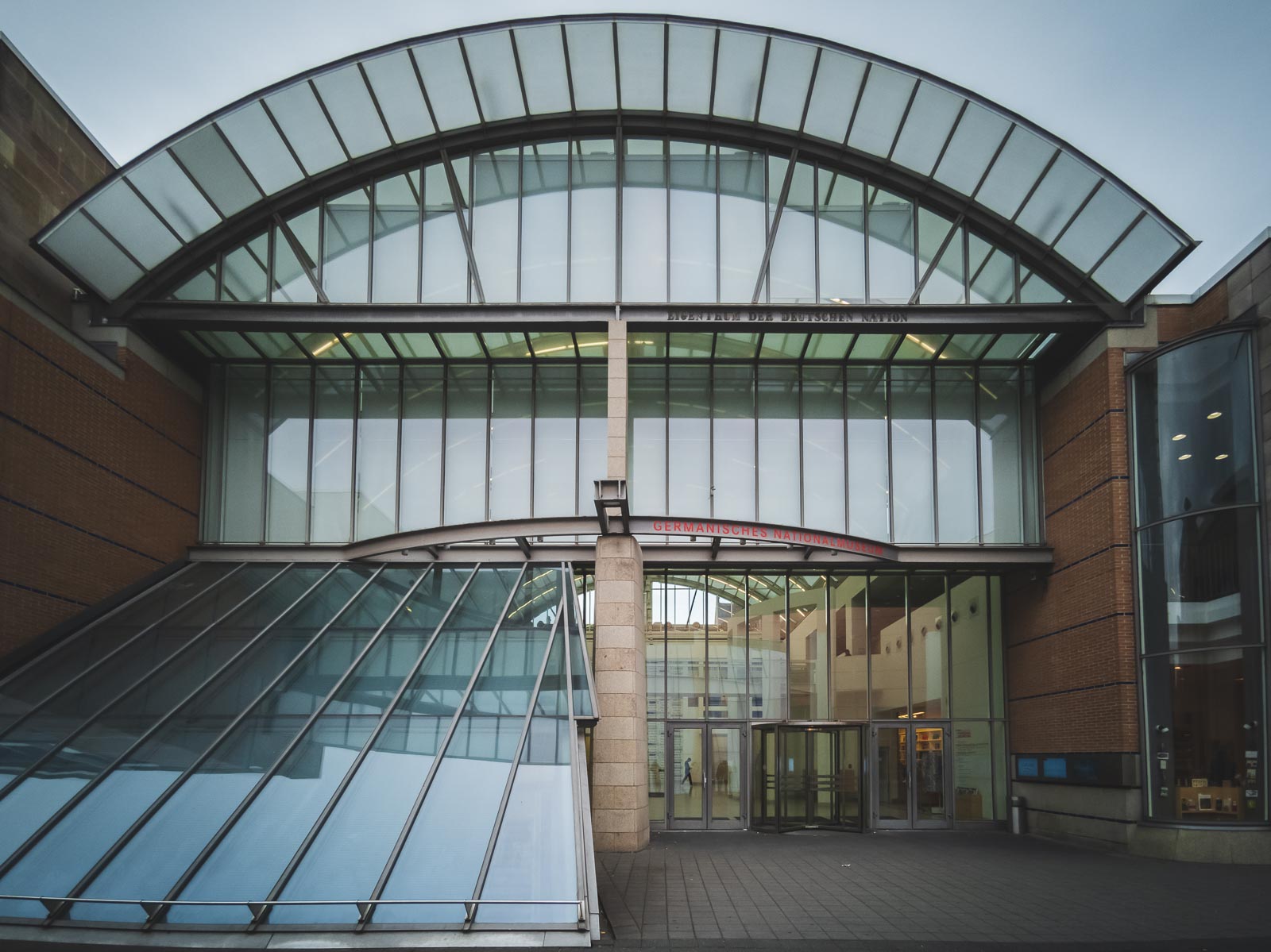
We had a museum pass when visiting Nuremberg which allowed us to pop into many museums during our visit. The Germanic National Museum is home to the largest collection of German art and culture. There is a lot to see inside the museum, but be sure to take your time to explore The Way of Human Rights (Straße der Menschenrechte) outside. This street consists of 27 high white round pillars depicting messages of declaration of human rights. Germanisches Nationalmuseum
13. Nuremberg Transport Museum
Transportation enthusiasts will enjoy visiting the Nuremberg Transport Museum (Verkehrsmuseum Nürnberg) which contains scale models of Deutsche Bahn’s, railway cars, locomotives and carriages. Nuremberg was home to the first German railway and the museum is one of the oldest in the country. Dating back to 1899 it was originally called the Bavarian Railway Museum. One of the coolest things to see is King Ludwig II’s royal train and a replica of Germany’s first train.
14. Albrecht Dürer’s House
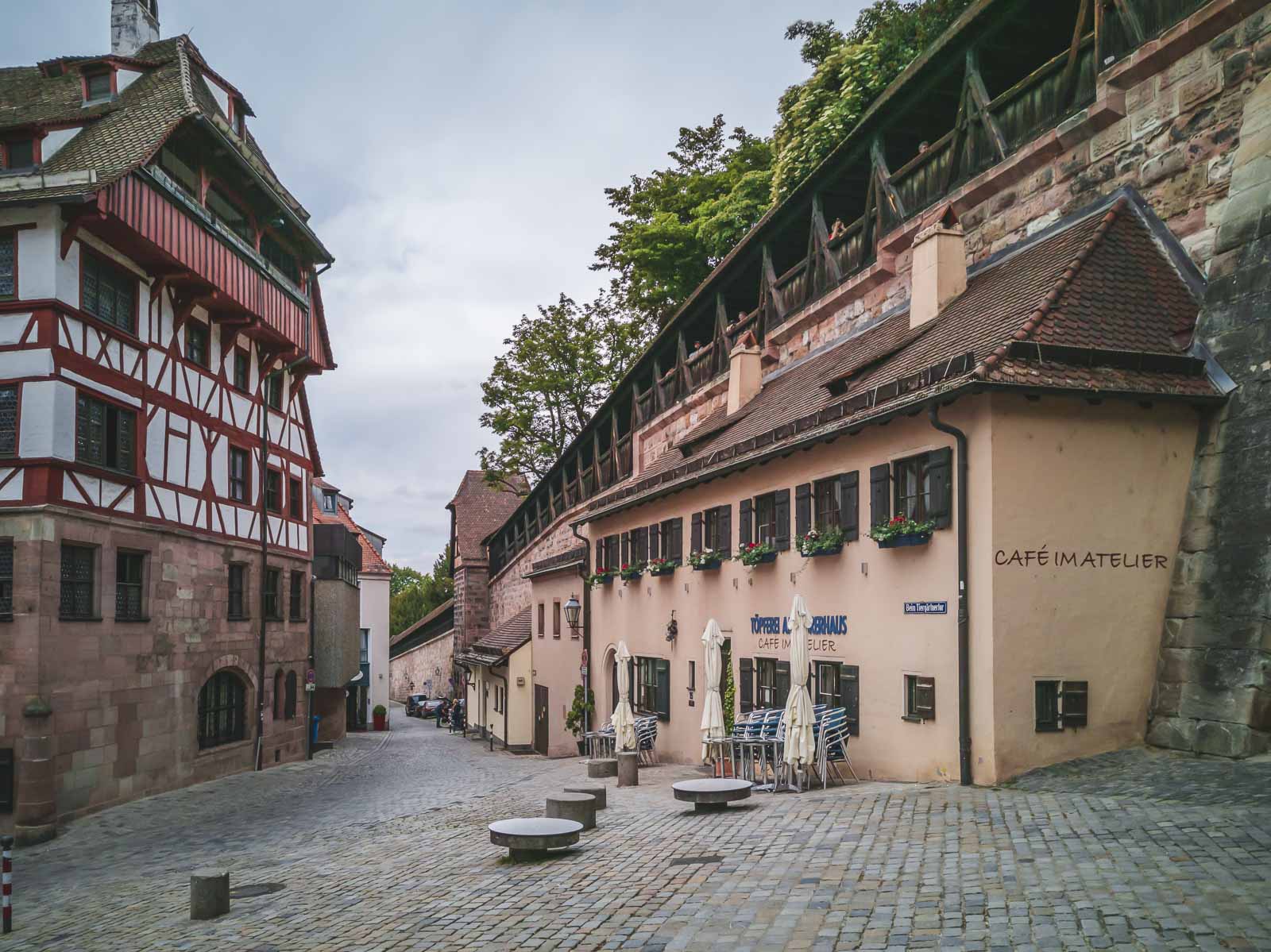
I will admit I have no idea who Albrecht Dürer was before visiting Bavaria, but once I arrived I soon discovered visiting his house is one of the most popular things to do in Nuremberg. Located in Kaiserburg near Nuremberg Castle, Albrecht Dürer’s House is a lovely Timber House and home to the famous German Renaissance artist Albrecht Dürer from 1509 to 1528. It was turned into a museum dedicated to his life and work in the 1800s but was destroyed during WWII. It was restored and rebuilt after the war and reopened on Dürer’s 500th birthday in 1971.
15. Neues Museum Nürnberg
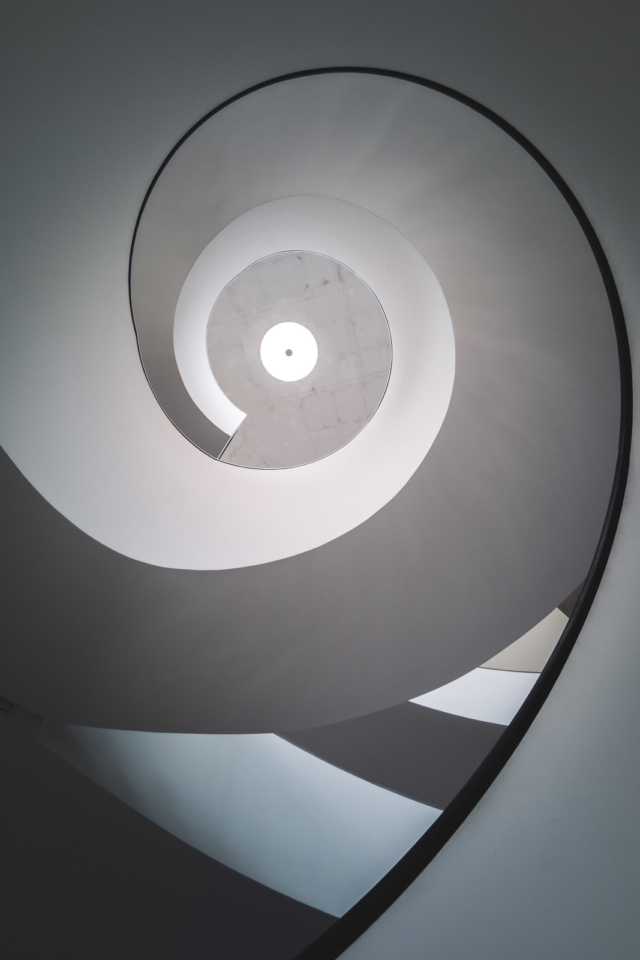
For contemporary art be sure to go into Neues Museum Nürnberg. Art lovers will enjoy it but we loved its design more than perusing modern art. When entering, there is an Instagram-worthy spiral staircase leading up to the exhibits.
16. St. Sebaldus Church
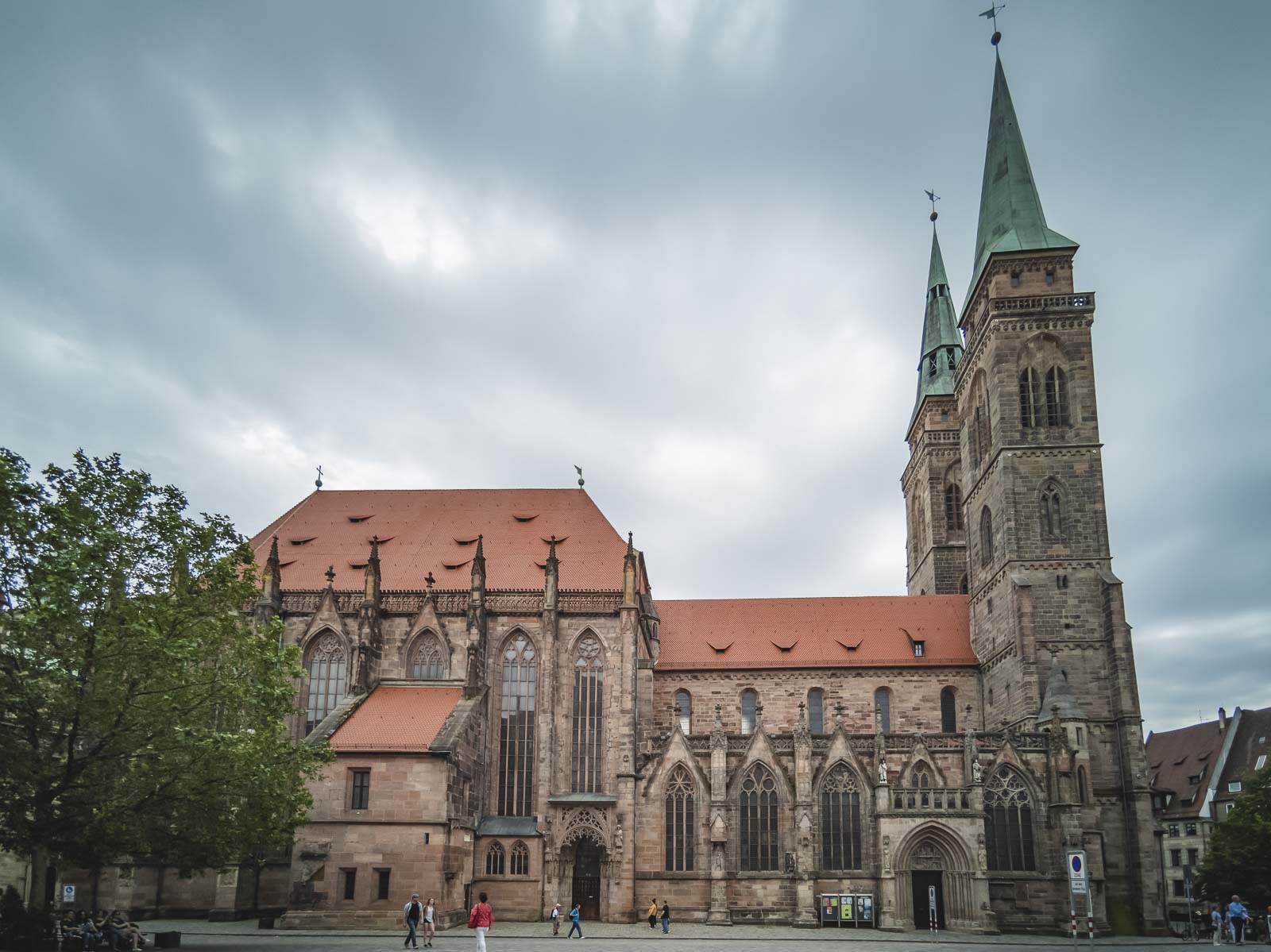
Located in Albrecht-Dürer-Platz, St. Sebaldus Church is one of the oldest and most important churches in Nuremberg. Named after the Patron Saint of Nuremberg it dates back to 1225. It is a mix of Romanesque and Gothic and if you go inside, you can view the tomb of Saint Sebald who lived during the 8th century.
17. St. Lorenz Church
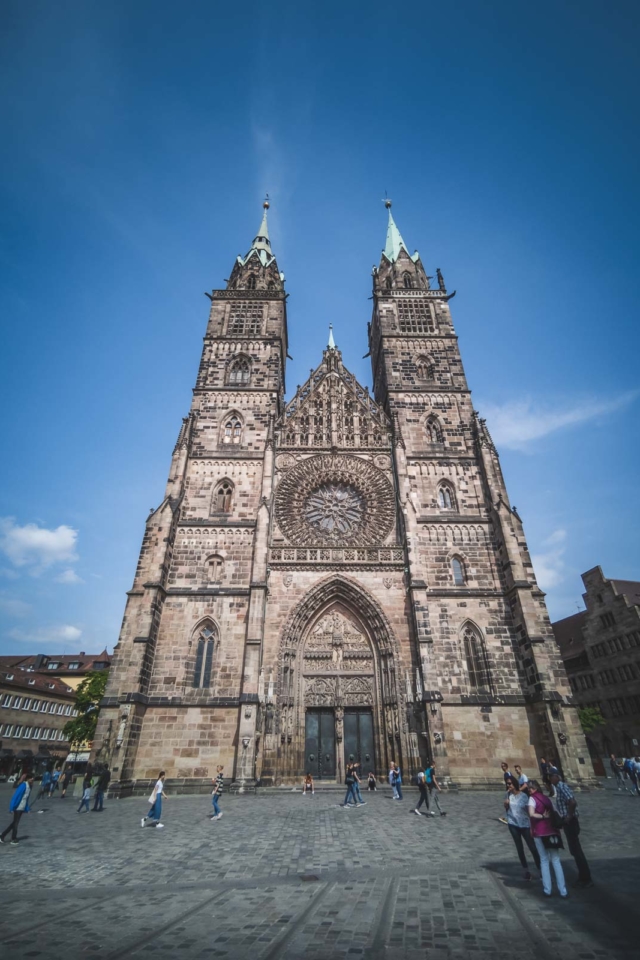
Another important church in Nuremberg is St Lorenz Church. Construction of this gothic style church began in 1439 and its 80m (260ft) tall twin towers stand proud over Lorenzer Platz and the Old Town. When you go inside you’ll marvel at one of the largest pipe organs in the world containing 12,000 pipes and its 9m (30ft) rose window. Much of its art and treasures were preserved even during the destruction of Christianity during the Reformation period because its wealthy patrons did not want to destroy their ancestral memories.
18. Bratwurstglöcklein im Handwerkerhof
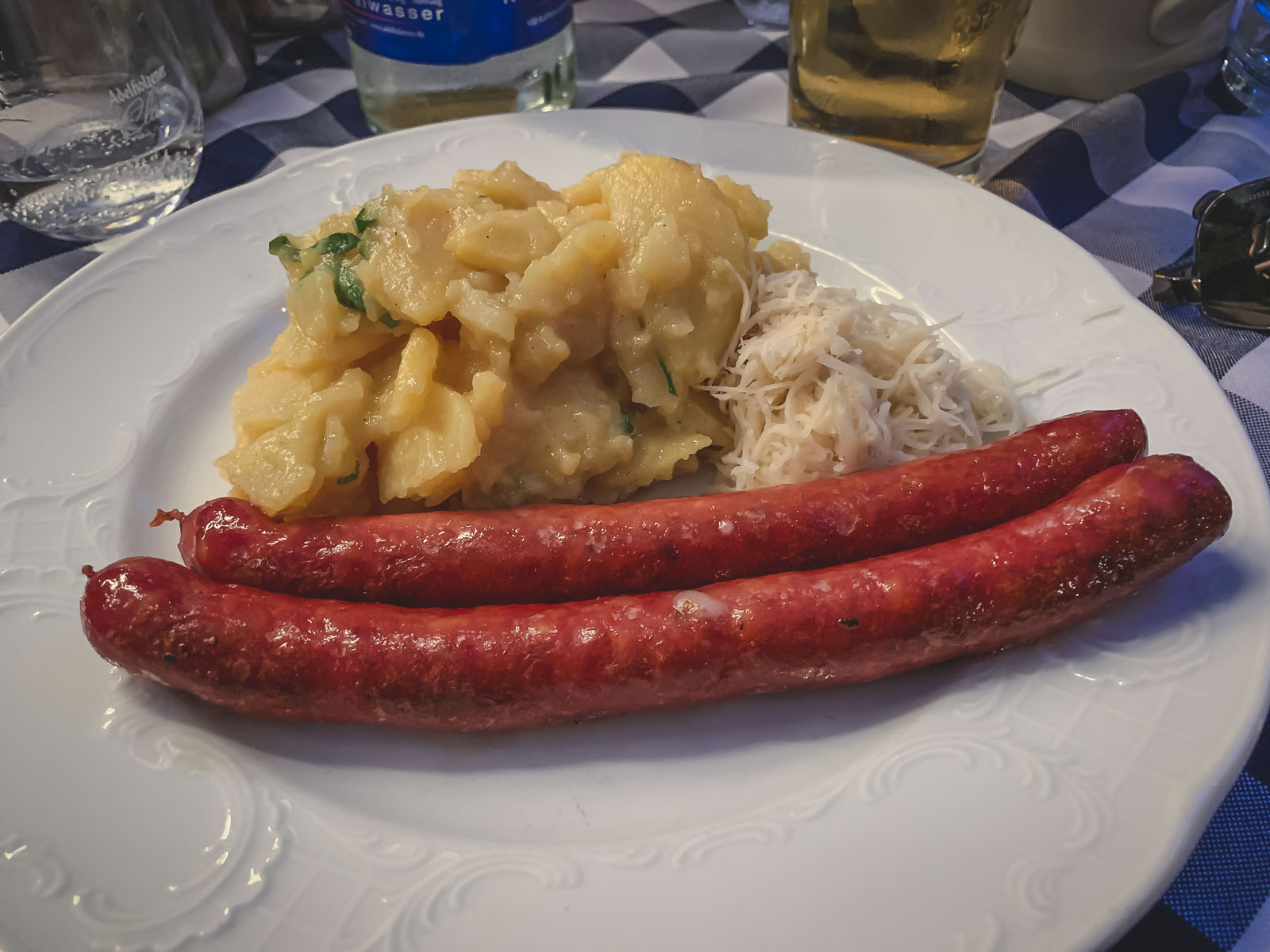
One very interesting piece of trivia is that Nuremberg has a bratwurst that is protected like champagne is in France. Nürnberger Bratwurst is protected and can only be made in Nuremberg. One of the best places to have Nürnberger Bratwurst is at Bratwurstglöcklein im Handwerkerhof which has been serving this sausage since 1313. Make sure to have an authentic meal served with sauerkraut, potato salad, horseradish, and a pretzel.
19. Take a Walk Along the Canal
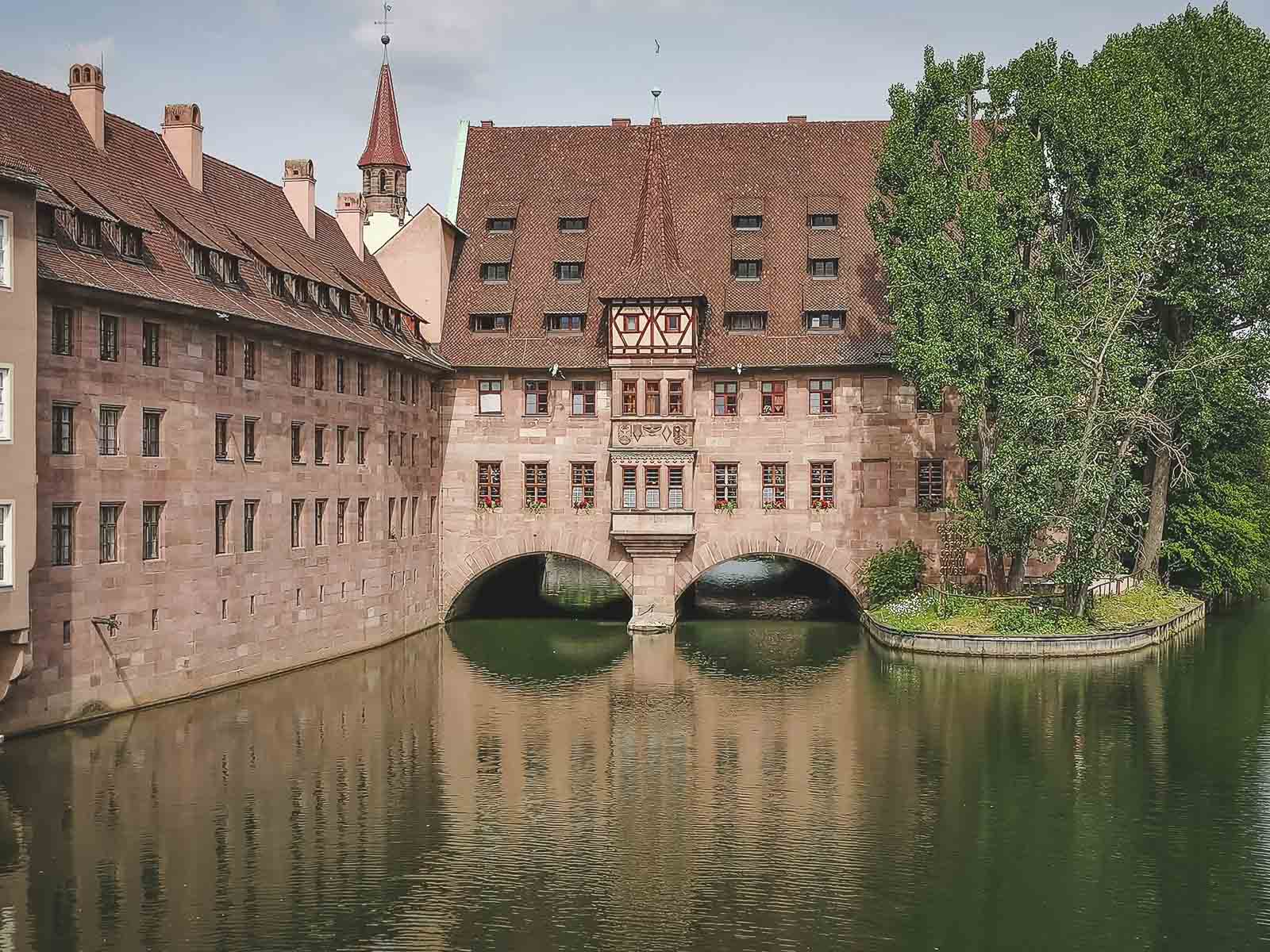
One of the best things to do in Nuremberg is to stroll along the canal looking at the half-timber houses lining the waterway. The Holy Spirit Hospital in Nuremberg (The Heilig-Geist-Spital Nürnberg) is one of the most photographed places in Nuremberg. It was one of the largest hospitals of its time built between 1332 and 1339. Today it is a bratwurst house, but it is worth stopping to view from the bridge to see its picturesque setting on the canal.
Where to Stay in Nuremberg
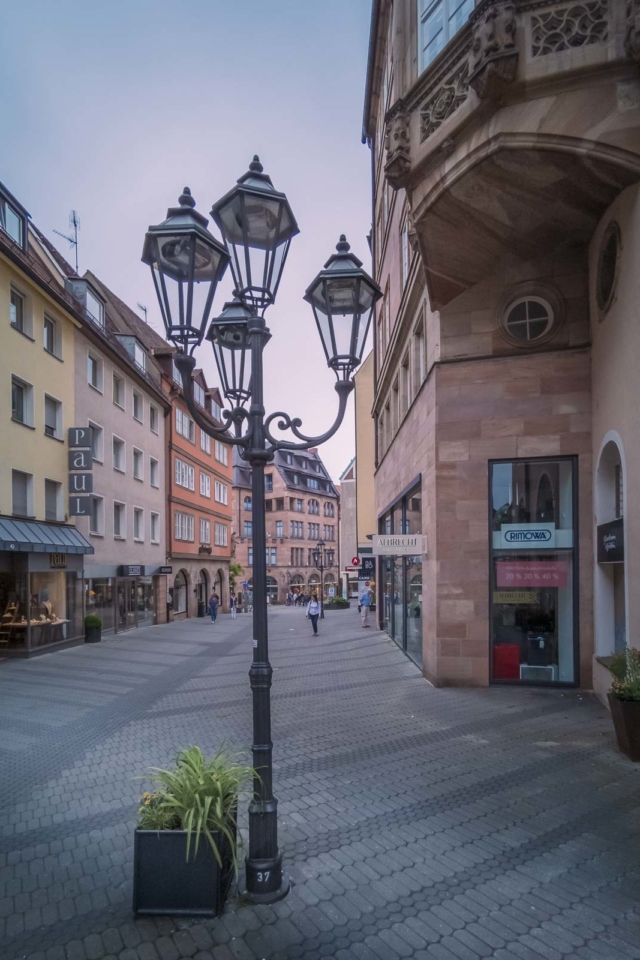
We stayed at the Adina Apartment Hotel which was a walking distance to everything. It had great rooms, an indoor pool (that we didn’t personally use) and a good bar. Check rates and availability on TripAdvisor
How to Get Around Nuremberg
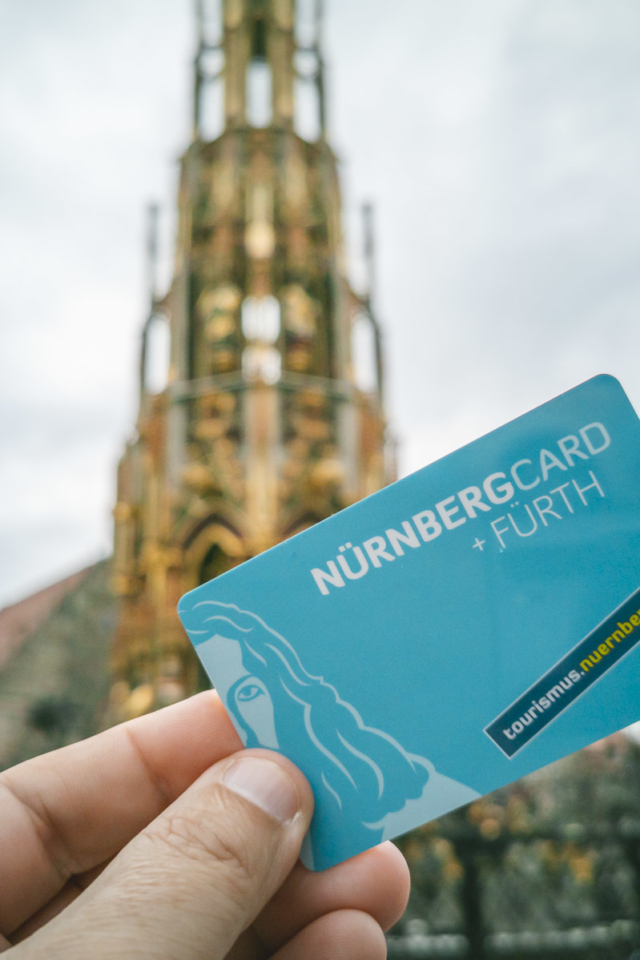
Nuremberg is very easy to navigate. We stayed just outside the old town and found it easy to walk everywhere. Most of the main attractions in Nuremberg are in the Old Town or just on the outskirts which is walkable.
Nuremberg does have easy public transit with three U-Bahn (underground) lines four S-Bahn (local train) lines, and plenty of bus routes. To get to and from the airport, the U2 line runs every 10 minutes.
We had a car in Nuremberg that we kept parked when visiting the old town but found that having a car is an amazing way to get around the rest of Bavaria and the attractions outside of town. Check out RentalCars.com for price comparisons.
The Nuremberg Card is a great way to explore Nuremberg. It offers free admission to the city’s most popular attractions including Imperial Castle Nuremberg, Deutsches Museum Nuremberg, Germanisches Nationalmuseum, Albrecht Dürer House, and many more. Plus, it offers unlimited travel on Nuremberg’s public transportation in Zone A and you will find discounts to other activities such as Historical Rock Cut Cellars, and the Nuremberg underground.
Read more about Germany Travel
- Best Things to do in Munich, Germany
- Top 16 Fun Facts About Germany That You Probably Didn’t Know
- Things to do in Garmisch Partenkirchen, Germany
- The Best Places to Visit in Berlin, Germany
- 20 of The Best Things to do in Bavaria
Travel Planning Resources
Looking to book your next trip? Why not use these resources that are tried and tested by yours truly.
Flights: Start planning your trip by finding the best flight deals on Skyscanner
Book your Hotel: Find the best prices on hotels with these two providers. If you are located in Europe use Booking.com and if you are anywhere else use TripAdvisor
Find Apartment Rentals: You will find the cheapest prices on apartment rentals with VRBO .
Travel Insurance: Don't leave home without it. Here is what we recommend:
- Allianz - Occasional Travelers.
- Medjet - Global air medical transport and travel security.
Need more help planning your trip? Make sure to check out our Resources Page where we highlight all the great companies that we trust when we are traveling.
You May Also Like
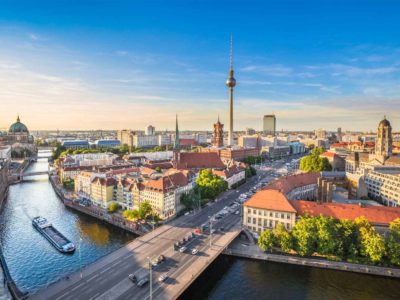
Where To Stay in Berlin In 2024: Best Areas And Places
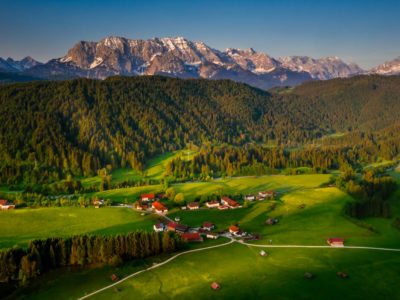
17 Best Day Trips from Munich in 2024
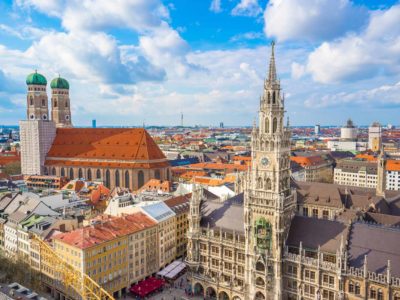
37 Of The Best Things to Do in Munich, Germany
About The Planet D
Dave Bouskill and Debra Corbeil are the owners and founders of The Planet D. After traveling to 115 countries, on all 7 continents over the past 13 years they have become one of the foremost experts in travel. Being recognized as top travel bloggers and influencers by the likes of Forbes Magazine , the Society of American Travel Writers and USA Today has allowed them to become leaders in their field.
Join thousands of others who get our monthly updates!
Leave a comment cancel reply.
Save my name, email, and website in this browser for the next time I comment.
Best Time to Visit
Weather & Climate
Nuremberg Airport Guide
Best Hotels
Public Transportation
Top Things to Do
Best Museums
48-Hour Itinerary
Day Trips From Nuremberg
Food to Try
Top Restaurants
Nightlife Guide
Your Trip to Nuremberg: The Complete Guide
Nuremberg (Nürnberg in German) is a small city that’s nevertheless borne witness to many of history’s big moments: It was once known as the unofficial capital of the Holy Roman Empire; the 20th century saw it host the Nuremberg Trials after WWII, and it now ranks as Bavaria’s second-largest city . Visitors come for the history, its romantic annual Christmas market with spiced lebkuchen (gingerbread), and local brews—as well as plenty of nature to enjoy and day trips to take outside of the city as well.
In our city guide to Nuremberg, we’ve covered the basics—and the best—of planning your trip to the Bavarian city. Read on for information about where to say, things to do, and where to eat and drink in Nuremberg.
Planning Your Trip
- Best Time to Visit : For the best weather , come from May to September: The skies are fairly dry and the sun is out—the perfect weather for days spent wandering Nuremberg’s picturesque Old Town and checking out the nature in the region.
- Language: German is, of course, the main language spoken here, and there are three main dialects spoken in the Bavaria region . However, many Germans speak some English or other foreign languages.
- Currency: The euro
- Getting Around: While Nuremberg’s Old Town is easily walkable (and, chances are, that’s where much of your visit might be centered), if you want to get around to the outer stretches of the cities it’s best to utilize the easily navigable VGN transit system . You can use day tickets on any mode of public transport in the city and even to towns and areas beyond city limits.
Things to Do
Visitors to Nuremberg should be sure to take in the city’s history by visiting some key historic sites, sample the town’s legendary local food and beers, and—if it’s the season—head to its famous Christmas market.
- Visit historic sites : Definitely make time to check out the city’s Kaiserburg castle , where German kings lived for around 500 years between 1000 and 1600, and visit the home of Albrecht Dürer, an important figure during the Northern Renaissance of the late 1400s and 1500s. Then tackle a more tragic portion of history with a visit to the half-finished Nazi party rally grounds and the Nuremberg Trials museum in the east wing of the city’s Palace of Justice (Justizpalast).
- Sample local food and beers : Eating and drinking should rightfully be a big part of your visit to Nuremberg—this is a city of hearty local specialities. For carnivores, a trip isn’t a trip without trying the local Nürnberger Rostbratwurst, or Nuremberg sausages, whose production is protected by regulations since the Middle Ages—head to Behringer's Bratwurstglöcklein and Bratwursthäusle for some of the best. Then, wash them down with a beer on the steps of Wanderer , which has one of the biggest selections of local beers, a Bavarian tradition.
- Visit the Christmas Market: Nuremberg’s Christkindlesmarkt is one of the most romantic (and best) in Europe. Come for the glühwein and shopping artisan products, stay for treats like lebkuchen (gingerbread) and, of course, more sausages.
For more ideas on what to do in Nuremberg, check out our list of the top historical sites , guide to local nightlife , and a handy rundown of our top 12 ideas for your trip to town .
What to Eat and Drink
For visitors who love the idea of tucking into pewter platters of hearty Bavarian food washed down with a traditional German beer, Nuremberg will deliver. Local and regional specialities abound on each menu, and you’ll want to be sure to try them all before you leave. Nürnberg Rostbratwurst is the standout local dish, and you can find these centuries-old sausages served at many restaurants in town—many of which date back to the 14th and 15th centuries. Other dishes to tuck into include Schäuferle, pork shoulder cooked until it falls off the bone, and, of course, soft, buttery pretzels. If you’re coming to the city during the festive season, don’t miss lebkuchen, or the traditional gingerbread beloved in the town.
If you drink alcohol, beer is the name of the game in Nuremberg when it comes to what you pair with your meals. Hausbrauerei Altstadthof brews the original red beer that’s a local speciality, and Schanzenbräu, located in the Gostenhof neighborhood, is a great pub to pop into for a locals’ vibe.
See our top five foods to try in Nuremberg here—and read up more on the fascinating background of the town’s famous sausages .
Where to Stay
Sebalder Altstadt—the city’s Old Town—is the most ideal spot for your first stay in Nuremberg. It’s located north of the river and is on the quieter side, making it an ideal base for the day and retreat at night. That being said, it’s definitely touristy because of its proximity—the Christmas Market is located in the neighborhood, as is the castle and some of the more popular restaurants and breweries in town. While staying here definitely makes sightseeing easy, definitely be sure to book stays in this neighborhood early as Nuremberg is a popular destination for tourists from Germany and abroad.
Getting There
The easiest way to get to Nuremberg is to fly: Nuremberg airport (NUE) is only Europe’s 10th largest but has connections to many European hubs via Ryanair, Lufthansa, Corendon Airlines, Eurowing, Wizz, KLM, Vueling, Turkish Airlines, TUI, Swiss Air, and Air France. It’s super-convenient, too: From your gate, it’s only 3 miles to city center.
Culture and Customs
Like in the rest of Germany, tipping is optional but customary. Keep in mind German service is less hands-on and more direct than American service—and that the customer isn’t always right here (especially if the customer isn’t, in fact, right). Expect to flag down your server for requests or to pay. For tipping, the rule of thumb is to round up to the nearest euro and leave a bit of change if you get some back. Around 10 percent is standard for very good service (again, keeping cultural differences in mind), with 15 percent being for a quite exceptional experience.
Money Saving Tips
- For heavy sight-seeing days, a day ticket will likely be your best-value way to get around—solo riders pay 8.30 euros to access any transit all day, and with the Plus version, you can take up to six people for 12.30 euros.
- Imbisses are small, no-frills restaurants or stands that serve inexpensive food like sausages and fries and make for a great meal on the go (several in town serve up the Nuremberg bratwurst as well).
- Drinking beer in public is extremely common—and a bottle of local brew makes a nice accompaniment to afternoons spent wandering the old town (just don’t get too sauced and become an annoyance).
WorldAtlas. "The Largest Cities In Bavaria. " Dec. 6, 2019
Bavaria Tourism. "Bavarian Language."
Nuremberg Convention and Tourist Office. "Nuremberg Sausage Protection Association: All About Nuremberg Bratwurst."
Your Trip to Munich: The Complete Guide
Lübeck: Planning Your Trip
Regensburg: Planning Your Trip
48 Hours in Munich: The Ultimate Itinerary
5 Foods to Try in Nuremberg
Your Trip to Berlin: The Complete Guide
Germany Guide: Planning Your Trip
Erlangen's Beer Festival: Bergkirchweih
Your Trip to Frankfurt: The Complete Guide
Vienna Guide: Planning Your Trip
Your Trip to the Czech Republic: The Complete Guide
The 15 Best Things to Do in Nuremberg, Germany
How to Visit Munich on a Budget
48 Hours in Nuremberg: The Ultimate Itinerary
Your Trip to Budapest: The Complete Guide
Trips to Seattle: A Complete Guide

Touropia Travel Experts
Discover the World
23 Best Things to do in Nuremberg, Germany

The second-largest city in Bavaria after Munich, Nuremberg has long been one of the country’s most important centres for the arts, culture and science. Although it’s often still associated with the Nazis, Nuremberg rallies and the famous trials that took place here, over the last few decades it has worked hard to change its image and challenge its past.
Lying along the Pegnitz River and Rhine-Main-Danube Canal, it initially flourished in the Middle Ages and later served as the Holy Roman Empire’s unofficial capital for centuries. Despite suffering heavy bombing during WWII, its Altstadt still contains pockets of attractive half-timbered houses. Presiding over everything is the immense Nuremberg Castle, one of Europe’s largest along with its city walls.
Dotted about are interesting museums and historic sights, some of which unflinchingly examine the horrors inflicted by the Nazi regime. One of the best things to do in Nuremberg is attending its magical Christmas market. With astounding artworks by Durer to see and numerous folk festivals to take part in, Nuremberg is a great place to visit at any time of year.
Map of Tourist Attractions in Nuremberg
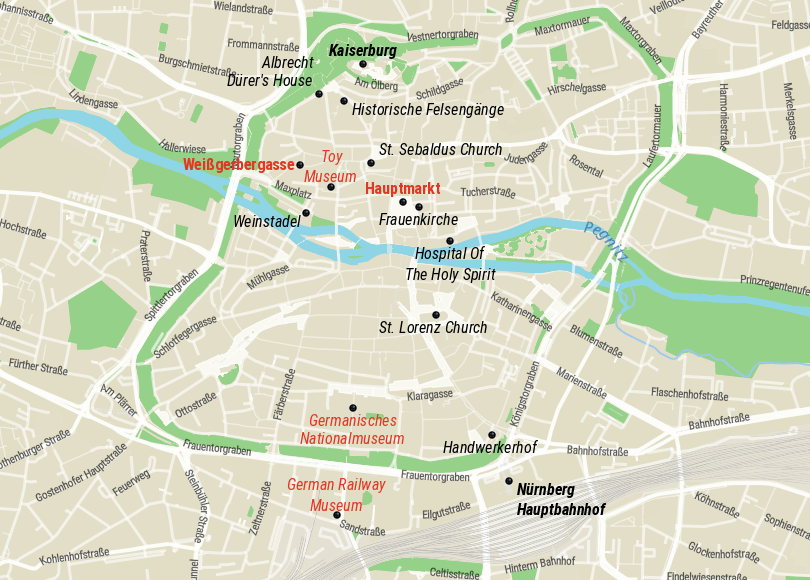
23. Weinstadel
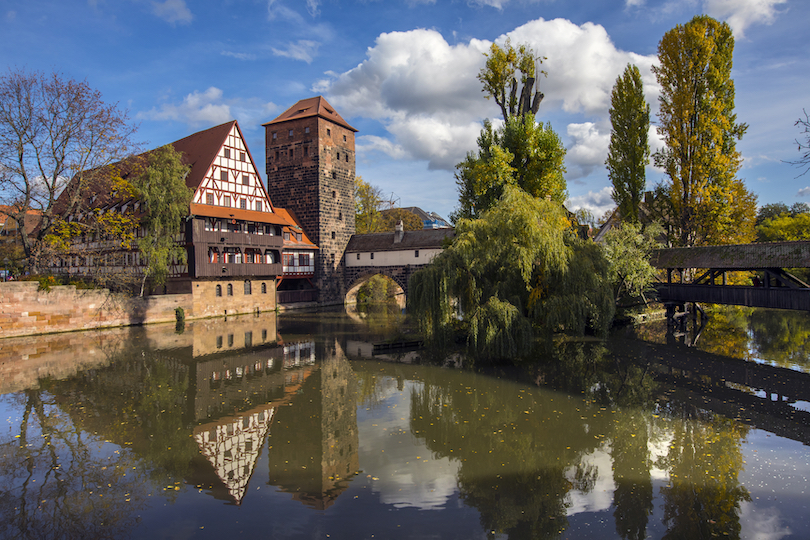
One of the most picturesque parts of the city, the wonderful Weinstadel lies by the Maxbrucke along the north bank of the Pegnitz River. The largest half-timbered house in Germany, it makes for some fabulous photos, what with the glinting waters before it.
Built in 1446, it was originally used as a hospice before later serving as a wine storage facility. Now a student dormitory, the historic building was heavily damaged during WWII though has thankfully since been restored.
Together with the old stone bridge and sturdy tower alongside it, the handsome house creates some perfect photo opportunities. Just one of the Old Town’s many architectural treasures, it is located not far from countless other attractions and museums.
22. Walk the City Walls
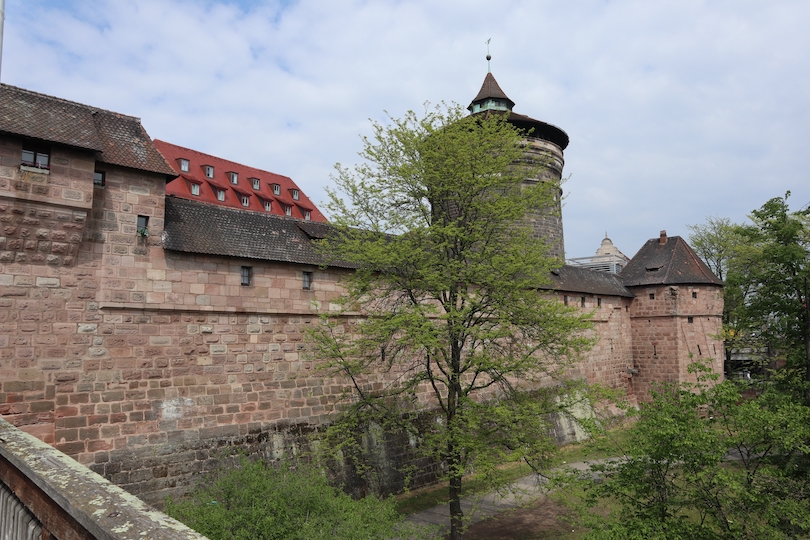
One of the most fun things to do in Nuremberg is to walk along the incredibly old city walls that encircle its atmospheric Altstadt. Aside from enjoying the enthralling history and architecture, you can drink in fine views from the ramparts.
Remarkably well-preserved, the phenomenal red brick fortifications stretch roughly four kilometers in total and are punctuated by a stunning seventy towers and gates. Continually strengthened between the thirteenth and seventeenth centuries, they were only ever bested once; by the Americans in WWII.
Although they were smaller and less imposing than we imagined, ambling along the top of the walls was still fun. The best part for us was along the city’s western side, leading up to its colossal castle complex. Here too, you pass medieval gates and look out over gorgeous gardens and rooftops.
21. German Railway Museum
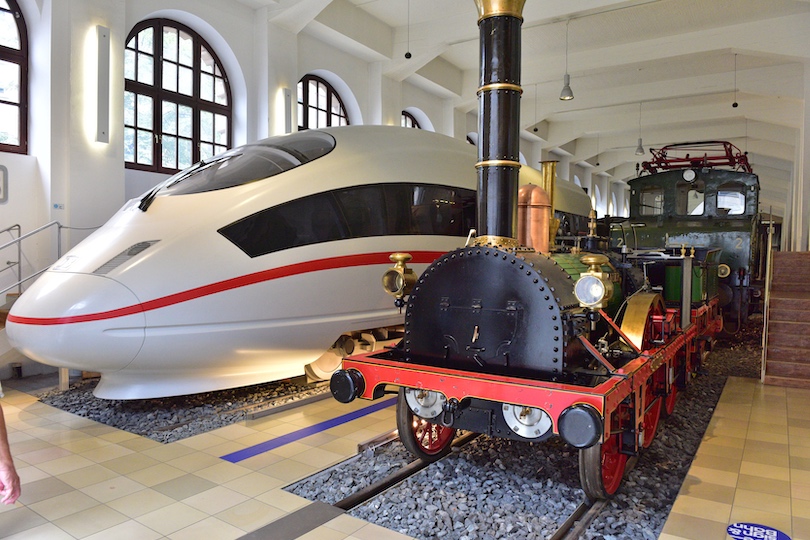
Just to the south of the Old Town’s extensive walls is the excellent German Railway Museum. Full of fascinating artifacts, equipment and, of course, old trains, it covers the history of the railways in the country from the 1800s up to the present day.
The oldest museum of its kind in the world, it was established in 1882 and features interactive exhibits and vintage locomotives sprawled across a massive site. On display are loads of scale models and full-sized replicas, antique engines and quaint communications equipment.
In addition to seeing restored steam trains and resplendent royal carriages, there are sometimes relaxing rides to enjoy in classic trains outside. Although everything is mostly in German, this doesn’t detract from the experience of examining engines up close. There are also fun simulators to try out and a colourful kids’ area for young ones.
20. Memorium Nuremberg Trials
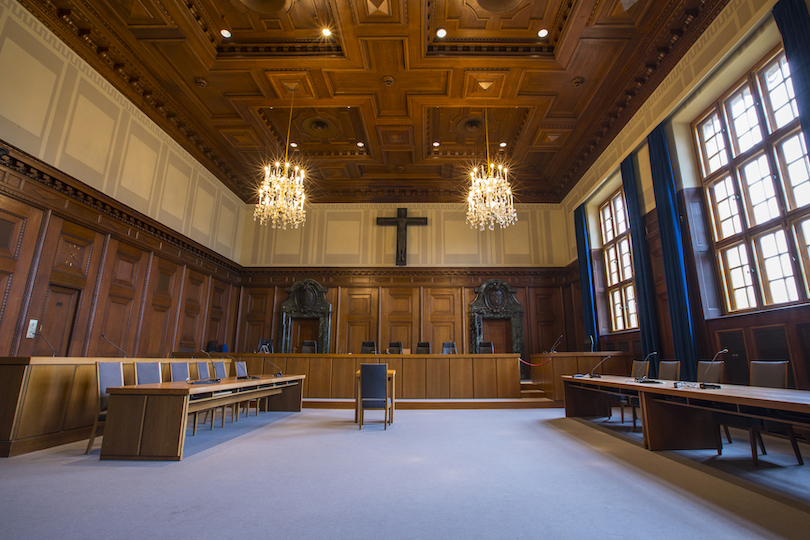
For those interested in history, the Memorium Nuremberg Trials are an absolute must. Very poignant and powerful, the photos and videos highlight how the Nazi high command was brought to justice in the actual courtroom where the trials took place.
Located in the east wing of the Nuremberg Palace of Justice, the important exhibition opened to the public in 2010. It was here in 1945 that 199 of the Nazi’s most influential military leaders, politicians and propagandists were put on trial for war crimes and crimes against humanity. Most were deemed guilty and 37 were sentenced to death, among them Goring, Ribbentrop and Rosenberg.
Informative displays explain the context of the trials, how they were held and the horrendous crimes brought before the judges. Entering Courtroom 600 and seeing where the high-up members of the SS and Gestapo were found guilty really is an eerie experience. Despite the heavy atmosphere, we would certainly recommend visiting as it covers such a momentous moment in time.
19. St. Sebaldus Church
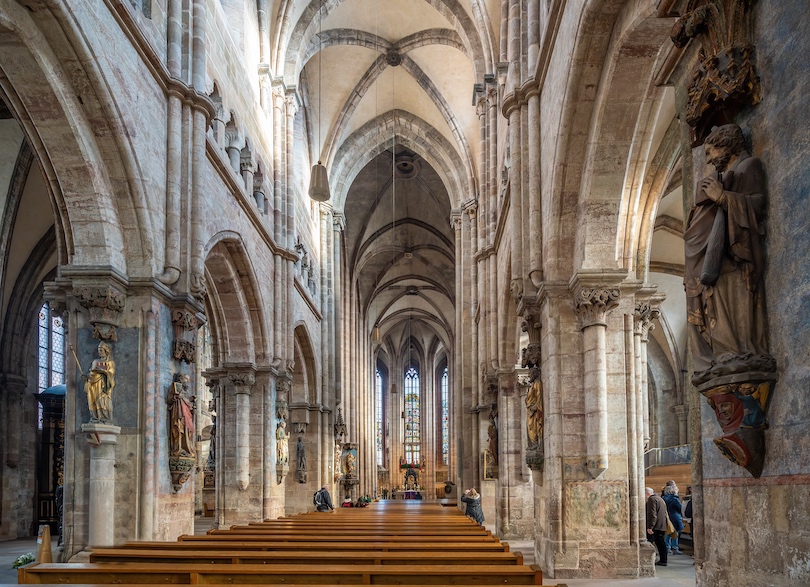
Quite unique looking, the spectacular St. Sebaldus is both Nuremberg’s oldest church and one of its most important. Lying right in the historic heart of town, it exhibits some extraordinary architecture and has an art-filled interior to explore.
Completed over decades, the large Lutheran church dates to 1225 though much had to be restored following WWII. While the two tall towers and nave at its western end are Romanesque in style, the hulking great hall at its eastern end is instead Late Gothic.
After taking some pics of its unusual outline and inspecting its intricately-carved Schreyer Landauer epitaph, check out its Baroque interior. As well as soaring columns and stained-glass windows, it has some amazing altars, paintings and statues to see. Its prized possession, though, is a sparkling silver casket thought to contain the remains of Saint Sebaldus himself.
18. Way of Human Rights
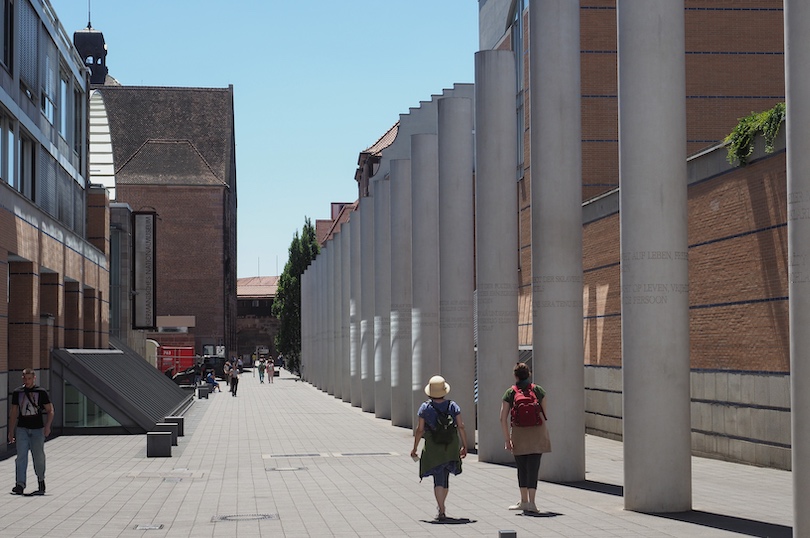
A nice contemplative spot to pass by, the Way of Human Rights is a street-long monument dedicated to the Universal Declaration and world peace. Situated in between the new and old buildings of the Germanisches Nationalmuseum, it connects the city wall to the center.
Unveiled in 1993, its giant sculptures are part of Nuremberg’s efforts to shed its Nazi-era reputation and instead be known as the ‘City of Peace and Human Rights’. Designed by esteemed Israeli artist Dani Karavan, it consists of a huge arch and thirty pillars. Made of white concrete, they are engraved with one article each from the Universal Declaration of Human Rights. These are both in German and other languages too.
While the monument isn’t particularly impressive, it repudiates past crimes and serves as a reminder to protect human rights.
17. Day Trip to Bamberg
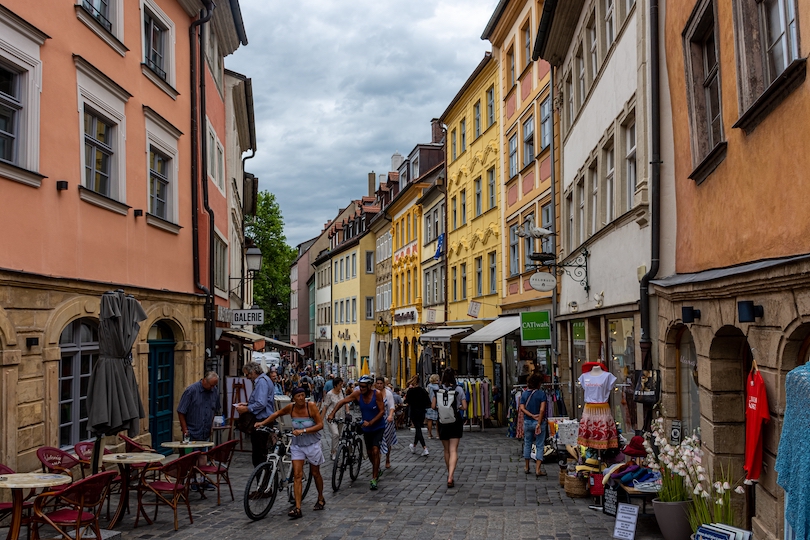
If you have the time, it is worth taking a day trip to beautiful Bamberg so you can see some more of Bavaria. Just a forty minute train journey north of Nuremberg, the historic town is renowned for its attractive Altstadt and architecture.
Spread across seven hills, each crowned by a delightful church, it straddles the Regnitz River in Upper Franconia. Thankfully unscathed after the Second World War, its picture-perfect medieval streets are enclosed by Europe’s largest intact old city wall. Here you’ll find some wonderful historical buildings and romantic riverside walks.
As it was an important ecclesiastical center for centuries, highlights include its marvelous cathedral and Michaelsberg Abbey. Bamberg’s Rathaus which hangs rather dangerously over the river is another must as is trying its distinctive smokey Rauchbier.
16. Toy Museum
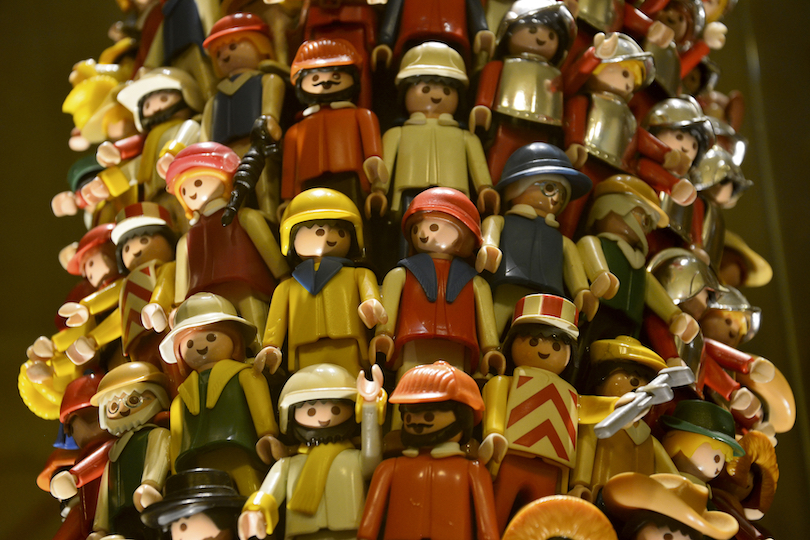
Back in the center of Nuremberg’s Old Town is another of its top attractions: the terrific Toy Museum. One of the most highly rated in the world, its artifacts and exhibits take you right from antiquity up to the present day. It also proudly examines the city’s reputation for producing lovely toys that have been around since medieval times.
Occupying a historic townhouse that dates to 1517, the museum has been a firm favourite with families since 1971. Its holdings now number a staggering 87,000 objects in total, only a fraction of which are on display. These include tin soldiers, elaborate dollhouses, wooden rocking horses and a large model railway, among many others.
Texts also cover their cultural significance and different periods and places around the world. It also looks at more recent toys like Lego, Barbie and Playmobil. Fittingly enough, there is also an exciting area for kids where they can do handicrafts, play and experiment.
15. Zeppelinfeld
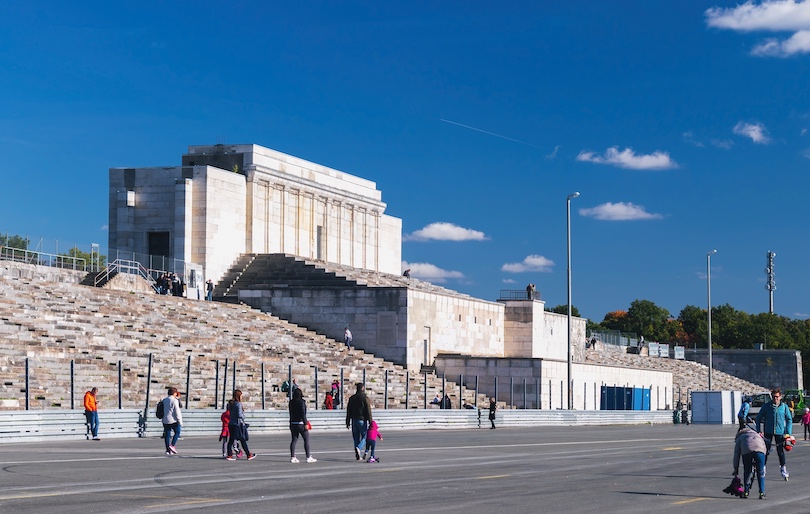
A chilling place to visit, Zeppelinfeld is a ginormous grandstand where the Nazi party once held their infamous Nuremberg rallies. Only fifteen minutes southeast of the center by public transport, its vast steps serve as a sobering reminder of what happened here in the thirties.
Now overgrown with weeds and almost appearing abandoned, it was built in 1935 by architect Albert Speer. Over the next few years, the Nazis put on carefully planned propaganda events here in front of hundreds of thousands of party members.
Standing in the exact same spot where Hitler spewed hate-filled speeches is a creepy, uncomfortable experience. Its immense size and scale also creates an oppressive feeling. Especially if you’ve seen photos or videos of the endless crowds of people who attended the rallies. Taking a tour around the grounds was invaluable as the guide provided so much information we didn’t know about Nuremberg and the Nazi’s rise to power.
14. Albrecht Durer’s House
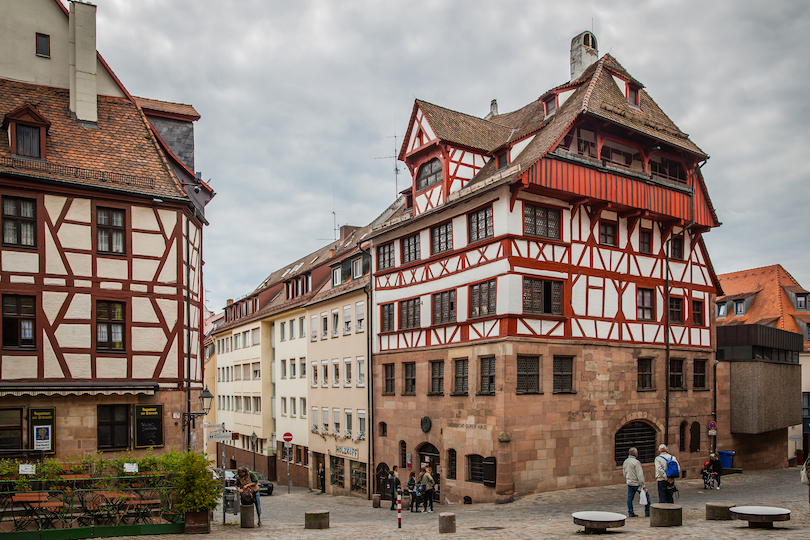
One of Germany’s most exalted artists, Albrecht Durer hailed from Nuremberg and produced many of his finest paintings, prints and theoretical works here. At his former home and workshop, guests can learn about his life and see some of his most famous masterpieces.
From 1509 to 1528, the master engraver occupied this gorgeous timber-framed Gothic house in the northwest of the Altstadt. Now a museum, it contains period furnishings and a recreation of Durer’s workshop. You can also observe old printmaking techniques in practice and take a guided tour of the whole house.
Besides learning about the revered German Renaissance artist, there are rare paintings, etchings and drawings done by Durer to admire. The five-story building and its cozy interior also look impressive, having been erected in 1420.
13. Hospital of the Holy Spirit
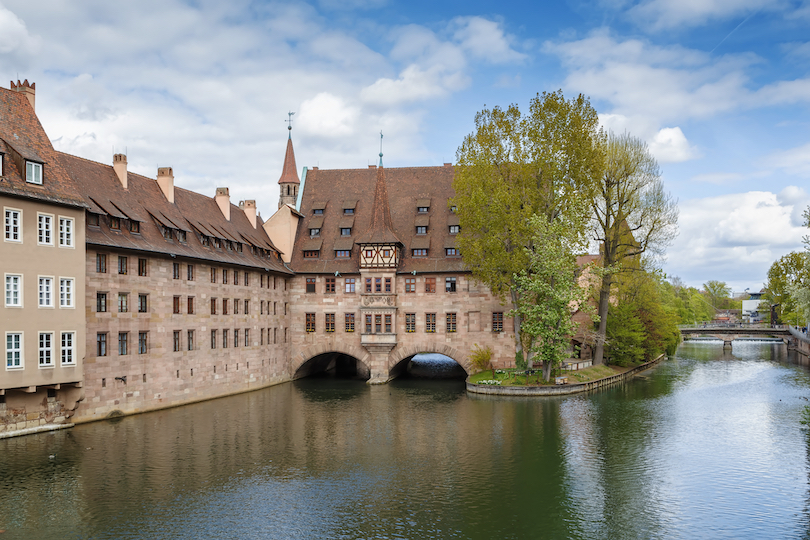
Another of Nuremberg’s prettiest parts is down by the river alongside the Hospital of the Holy Spirit. Now a restaurant and care home, its ruddy red brick walls and well-preserved facade make for some fantastic photos, reflected in the Pegnitz.
Built back in 1339, its extensive buildings once formed the largest hospital in the Free Imperial City of Nuremberg. From 1424 to 1796, its chapel also housed the Imperial Regalia – the crown jewels of the Holy Roman Empire.
Nowadays, you can enjoy some delicious German dishes in its handsome historic tavern overlooking the river. After washing down your meal with a draft of beer, snap some pics of the hospital partially hanging over the Pegnitz. Take a look at its charming courtyard and the carved fountain outside too.
12. Handwerkerhof
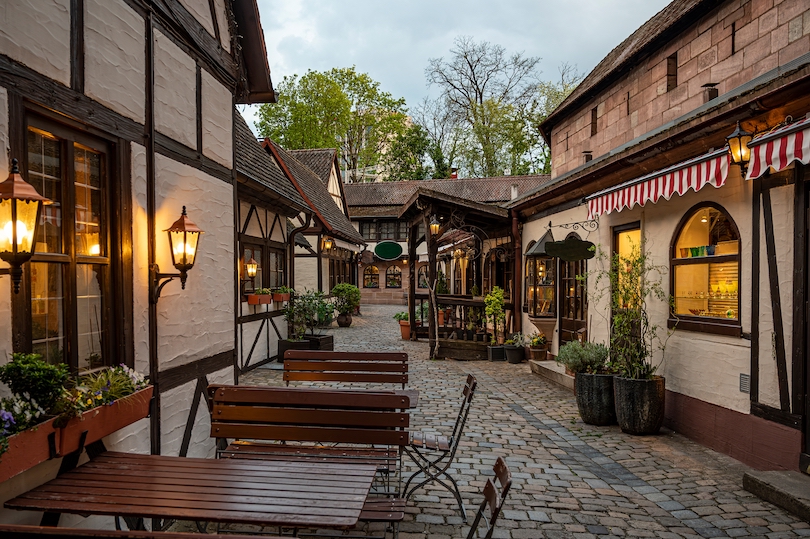
For yet more traditional German restaurants and cute crafts shops, head to the Handwerkerhof. Like traveling back in time, its enchanting medieval streets, bars and artists’ studios are nestled away in the southwest of the Altstadt, along the city wall.
Also known as the Craftsmen’s Courtyard, its rustic-looking shops sell everything from ceramics and sweets to glassware, leatherwork and toys. All delightfully decorated, they lie alongside atmospheric restaurants and beer gardens. This makes it a great spot to stop for a meal or drink while picking up some souvenirs or gifts.
Altogether, its half-timbered houses, cobblestone streets and the castle tower rising above them certainly paint a pretty picture. The ambience is also just as pleasant as its aesthetic. Although it is not nearly as old as it seems, wandering around the Handwerkerhof was one of our favorite things to do in Nuremberg.
11. Nürnberg Zoo
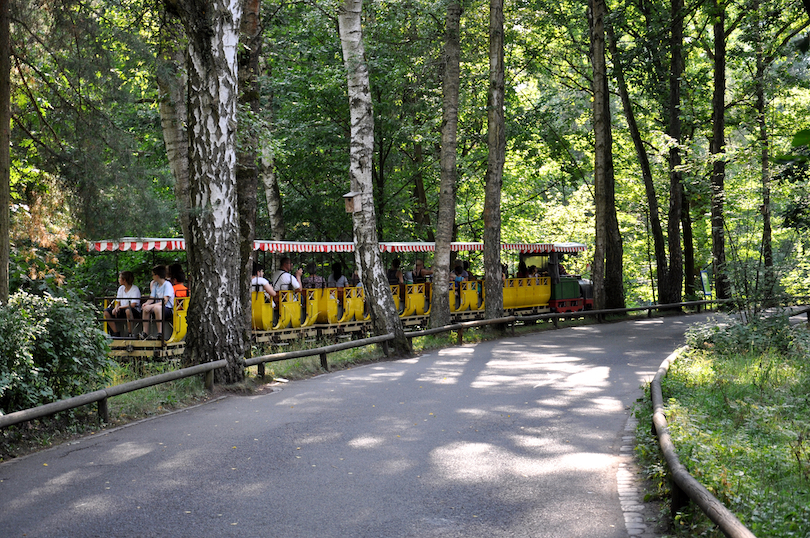
Another big hit for us was the historic Nürnberg Zoo which is often listed among the most beautiful in Europe. Set amidst lush forests in a former sandstone quarry, its spacious enclosures are located just a fifteen minute tram ride east of the center.
One of the continent’s largest and oldest zoos, it was established in 1912 with over 2,000 animals of some 300 or so species now inhabiting its natural exhibits. While ambling about, you’ll therefore see everything from giraffes and rhinos to Siberian tigers, lowland gorillas and snow leopards. It also has an amazing Manatee House and Dolphin Lagoon to check out.
Perhaps because it is so leafy, its residents appeared much more active and happier than many zoos we’ve been to. Plenty of picnic areas and playgrounds are also dotted around while feeding sessions and informative keeper talks regularly take place.
10. Historische Felsengange
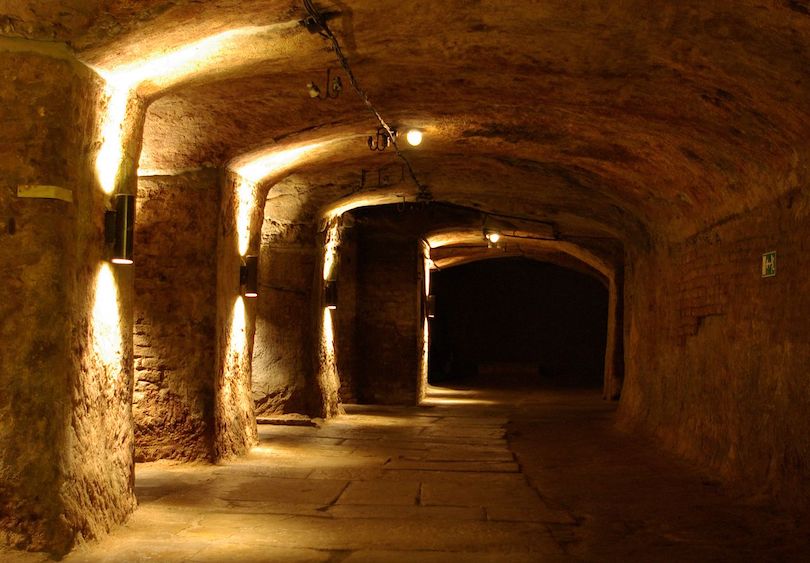
Just around the corner – or rather under the ground – from Albrecht Durer’s House are the Historische Felsengänge. The largest series of rock-cut cellars in Southern Germany, their dimly lit passageways are fascinating and fun to explore.
Hewn out of the soft sandstone over centuries, the labyrinth-like caverns riddle the hill beneath the castle and northwestern corner of the Old Town. First mentioned in documents dating to 1380, they were later used by citizens to shelter from bombs during WWII.
Quite cold and claustrophobic, the rock passages can be visited on tours that take you around all the tunnels and teach you more about their past. Their cool confines are also still used for ripening and storing the city’s famous brew. After emerging from the dark, you can taste some of their beers and whiskeys before heading off.
9. Frauenkirche
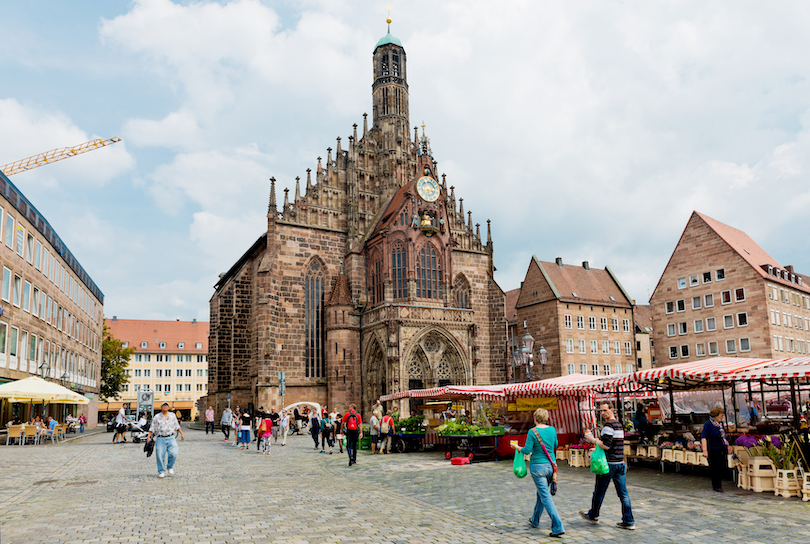
Certainly one of the city’s most striking buildings, the phenomenal Frauenkirche dominates one side of the Hauptmarkt. Other than its richly decorated facade, the church contains numerous important works of art from the Middle Ages.
An excellent example of brick Gothic architecture, it was constructed back in 1362 on the initiative of Charles IV who was Holy Roman Emperor at the time. Instantly catching the eye, its elaborate facade features a fetching portal with a mechanical clock at its top. Rising overhead are dozens of small spires and a central octagonal tower.
Inside, loads of fine sculptures and religious artworks can be found beneath its vaulted ceilings and colourful stained-glass windows. The highlight though is definitely seeing its ornately-crafted portal and watching all the clock’s little figures whir around.
8. Nuremberg Christmas Market
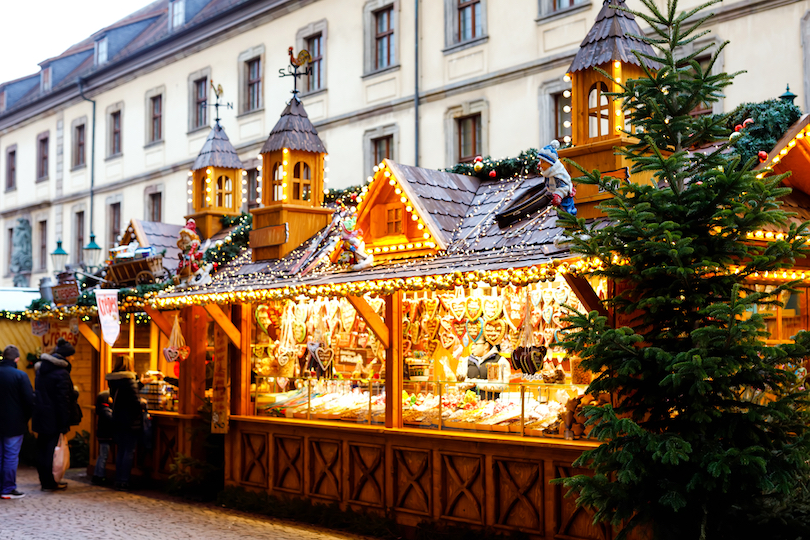
Right in front of the Frauenkirche is where the city’s most anticipated event takes place each winter: the Nuremberg Christmas Market. Over two magical weeks, millions pack into the huge Hauptmarkt to enjoy its fun festivities and food.
Now one of the largest and most famous Christmas markets in the country, its origins are thought to date to the early 1600s. Since then, it has grown considerably with more than 180 wooden stalls now dotting the square. Delightfully lit up against the dark December sky, its stands sell handcrafted gifts, gingerbread, gluhwein and more.
Known in German as Christkindlesmarkt, the market is opened each year with a solemn speech by a young local lady from the church balcony above. A very popular event, it is attended by thousands as the festivities begin right afterwards.
With so many great gifts and decorations to pick out and so many tasty traditional treats to sample, Nuremberg’s Christmas market really is one of the best around. You’ll want to dress up warm though as it gets very, very cold later in the evening.
7. St. Lorenz Church
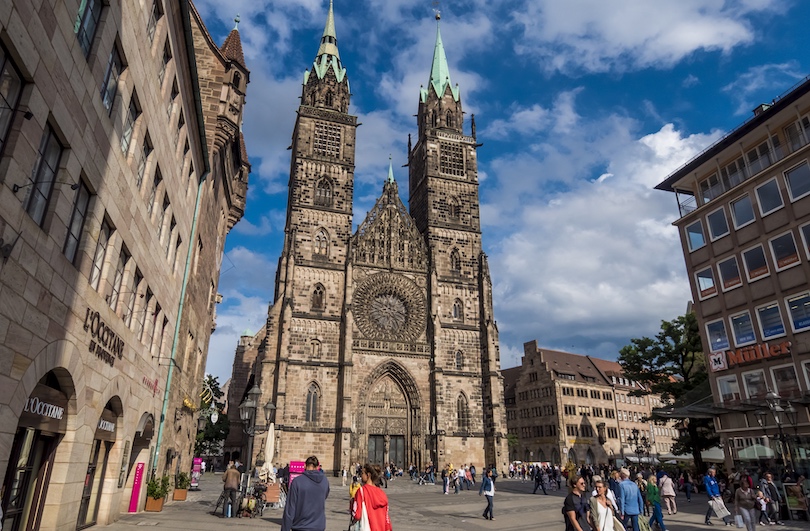
Arguably even more impressive than Frauenkirche are St. Lorenz Church’s soaring twin spires and its stupendous facade. Situated on the opposite side of the Pegnitz, the gigantic Gothic structure has a similar design to that of St. Sebaldus.
Dedicated to Saint Lawrence, the city’s largest church was mostly completed in the fifteenth century, with funding from rich citizens. Thanks to them, it boasts a breathtaking facade, designed to reflect their wealth and the city’s power and prestige. Its eighty meter-high bell towers and intricately-carved west doorway certainly achieve this though its wonderful rose window steals the show.
Despite being Lutheran, its enormous interior houses many lavish artworks with its terrific tabernacle and stained-glass windows being the pick of them all. There is also one of the world’s largest organs to see and a stunning sacrament house made by Adam Kraft. For us, its unique architecture and art pieces made it one of the best buildings we saw in Nuremberg.
6. Germanisches Nationalmuseum
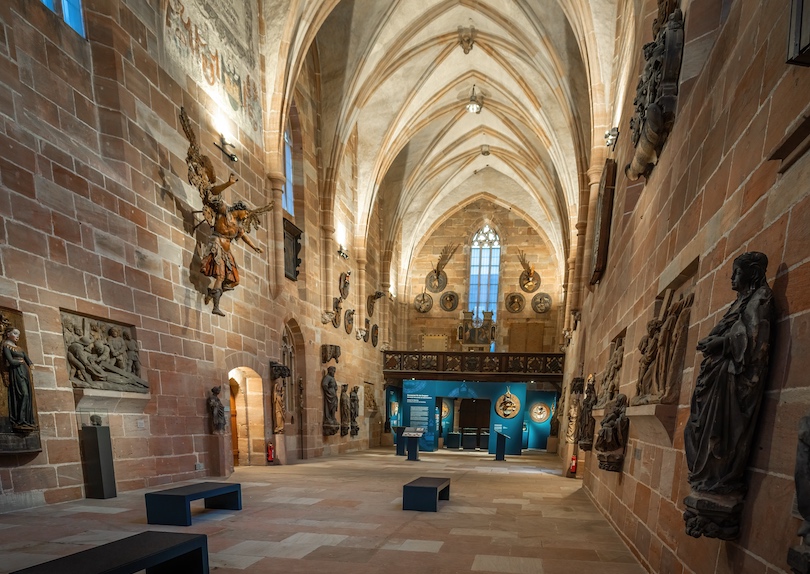
Not far away too is the must-visit Germanisches Nationalmuseum which investigates the art, history and culture of the German-speaking world. Covering prehistoric times up to the present, its collection includes everything from armor and instruments to books, paintings, toys and more.
Now spread across a couple of buildings, both modern and historical, the vast museum was founded in 1852. Since then, it has amassed over 1.3 million objects of which 25,000 are on show at any one time. There are also sections of a sixteenth-century charterhouse and an old abbey to see too.
Almost endless, its well-done exhibits look at not just medicine and the Middle Ages but fashion, folk art and scientific achievements too. As it has so many captivating paintings, photos and altarpieces to inspect, you can easily spend half the day here.
5. Playmobil FunPark
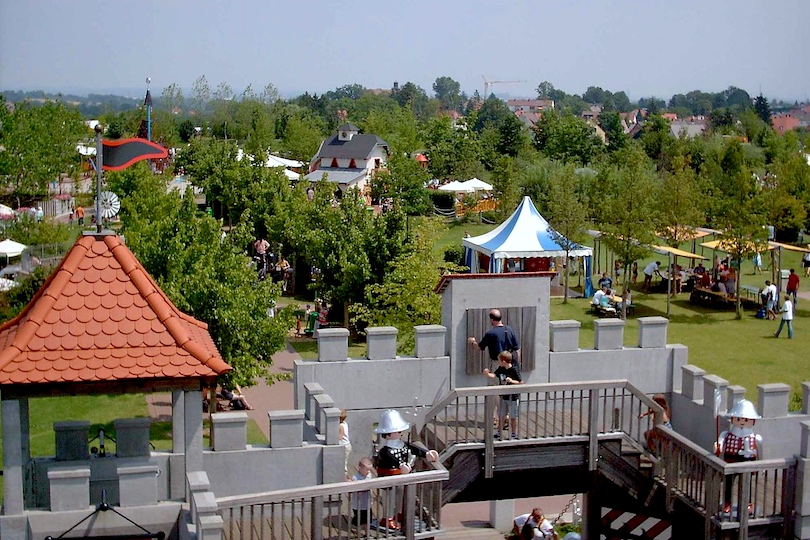
A must for families with younger ones, the Playmobil FunPark lies a fifty minute public transport trip west of Nuremberg. Its fun-themed areas and all the oversized toy figures can be found just outside the small town of Zirndorf where the company’s headquarters are based.
Sprawling across a giant green area, the amusement park has large replicas of Playmobil characters and their specific worlds to stroll around. Sure to stimulate the senses, they feature playgrounds and paddle boats, climbing walls and ropes courses. Suitable for the ages three and up, it also has some rides and go-karts for older ones to enjoy.
One minute you can be exploring a cool pirate ship or castle and the next an American Indian village, treehouse or dinosaur area. Alongside all its trampolines and slides, there are plenty of food options to choose from. The park also has a massive store selling all the latest Playmobil sets to stop by.
4. Hauptmarkt
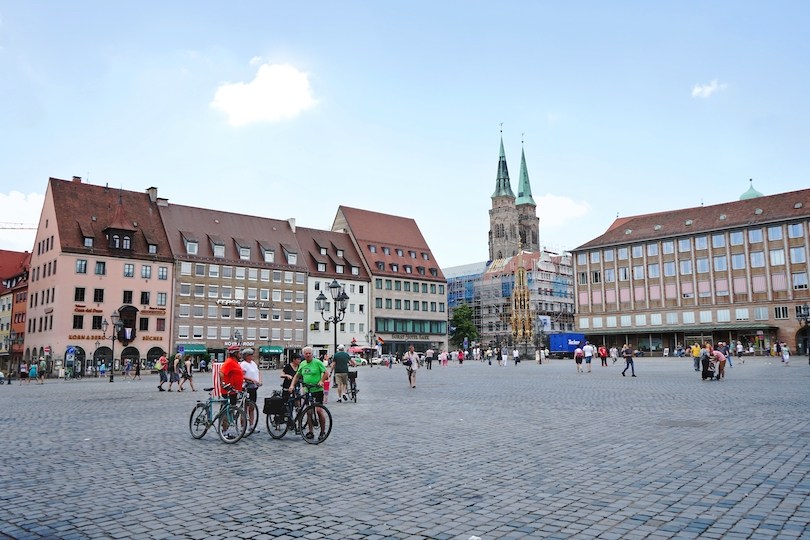
The city’s main square, the historic Hauptmarkt is home to some of its most impressive monuments and buildings. Located right in the heart of the Old Town, it is here too that the Nuremberg Christmas Market is held.
Overlooked by the Frauenkirche’s fabulous facade, its worn cobblestones have been at the center of life, commerce and celebrations in the city since around the thirteenth-century. Once swampland, and then part of the Jewish ghetto, it later hosted large Nazi party rallies in the 1930s. As it was severely damaged during WWII, most of its buildings look quite modern in contrast to the old church.
The square’s other standout sight is the spectacular Schoner Brunnen or ‘Beautiful Fountain’ that lies in its northwest corner. Towering nineteen meters, the iconic landmark is a replica of the gorgeous Gothic spire that stood here in the fourteenth-century.
Other than the Frauenkirche, seeing its forty colorfully painted figures was our favorite thing about the Hauptmarkt. These depict Prince-electors, prophets, philosophy and liberal arts; all things that represented the worldview of the Holy Roman Empire.
3. Documentation Center Nazi Party Rally Grounds
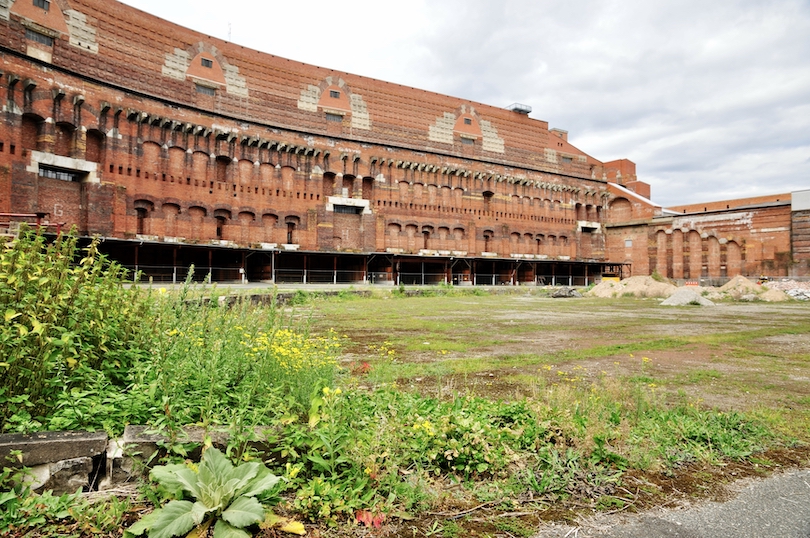
As it was one of the most important cities in the empire and the German-speaking world as a whole, the Nazis chose Nuremberg to host their enormous annual rallies. At the outstanding Documentation Center, you can learn about their rise, rallies, propaganda techniques and brutal time in power.
Established in 2001, its moving artifacts, exhibits and photos are fittingly located in the colossal but unfinished Congress Hall. This was just one of the imposing buildings that the Nazis planned for the city and their rallies. Only a few, though, like the nearby Zeppelinfeld, were ever actually completed.
Its exhibition ‘Fascination and Terror’ perfectly explains how their propaganda and rallies had such a grip on people and the violent, tragic consequences thereafter. Although we’ve been to loads of WWII museums over the years, the Documentation Center is definitely one of the best. This is because it deals with the horrible reality of life under Nazi rule and its aftermath in such an analytical, engaging manner using eye-witness interviews.
2. Kaiserburg
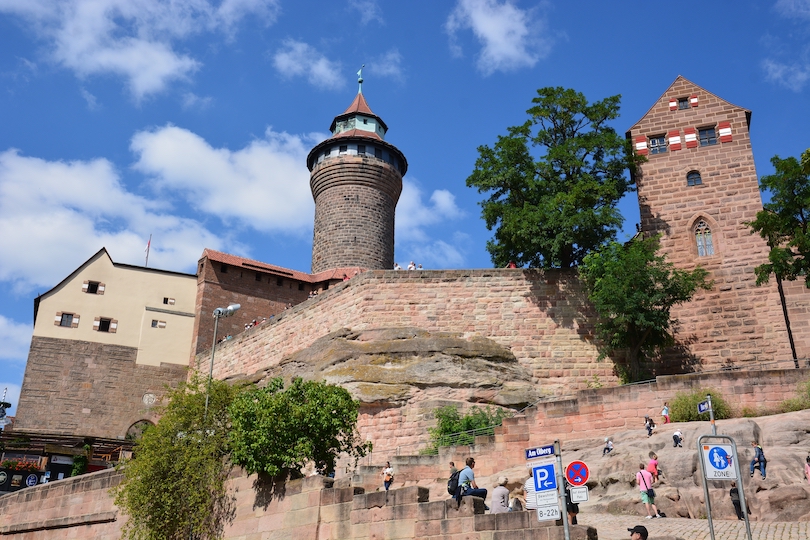
Nuremberg’s main symbol and sight, the Kaiserburg dominates its Alstadt from its prominent hilltop position in the northwest corner. Besides boasting lots of incredible old architecture, artifacts and exhibits, the immense castle complex offers phenomenal views over the city.
One of Europe’s most formidable medieval fortifications, the castle and its walls were built from the eleventh-century onwards. Back in the times of the Holy Roman Empire, it often hosted the emperor who also had to hold their first Imperial Diet here. Clustered about its charming central courtyard are a palace, chapel and castle museum. These present more information about the castle, all the kings who ruled here and the Holy Roman Empire itself.
Presiding over everything is the thirteenth-century Sinwell Tower; one of Nuremberg’s defining landmarks. Its cylindrical shape and colourful red roof make for some marvelous photos, what with the half-timbered historic houses around them. One also contains a deep well, the castle’s only water source, that plunges fifty metres down into the ground.
1. Weissgerbergasse
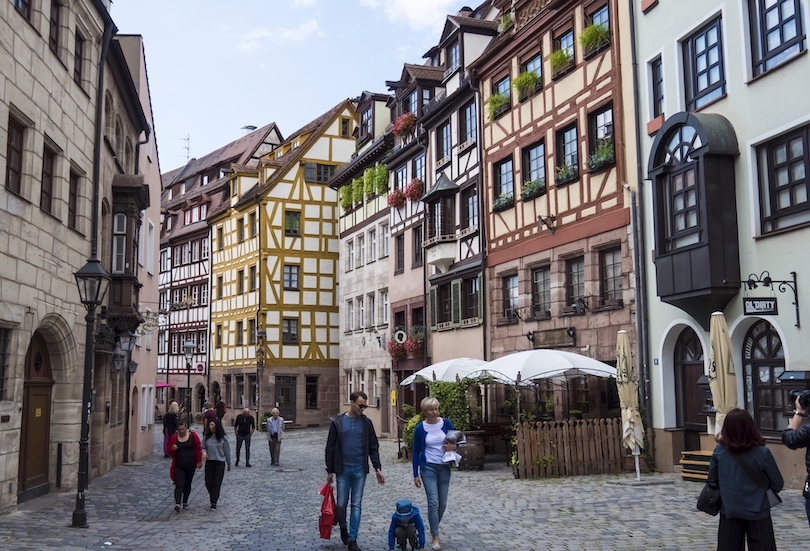
Appearing as if out of a fairytale, Weissgerbergasse is, without doubt, one of the most attractive and atmospheric streets in the Old Town. Lined by dozens of colourful half-timbered houses, these now contain tons of cozy cafes, unique boutiques and little artists’ workshops.
Numbering around twenty in total, its beautiful buildings were miraculously missed during the heavy air raids over Nuremberg in the Second World War. Dating to the Middle Ages, their facades look very picturesque and perfectly frame the cobblestone street between them.
Aside from ambling along and snapping some photos, you can enjoy a coffee or meal at the lovely terraces lining it. Along with the Kaiserburg, it created some of the most romantic images of our time in Nuremberg.
Where to Stay in Nuremberg
As almost everything is within walking distance or a short public transport journey away, you’re best off staying in Nuremberg’s Old Town. Several hotels can also be found just outside the walls, not far from the train station. Here are a couple of options you may want to consider.
Right by the Hauptbanhof but still within the city walls is the outstanding Hotel Victoria . Occupying a renovated nineteenth-century building, the four-star hotel has clean, comfy rooms for visitors to stay in. Offering up the perfect mix of tradition and modernity, it also lies right by all the Handwerkerhof’s romantic restaurants and cool artists’ studios.
A more budget-friendly option is the three-star Hotel Five , right in the heart of the Altstadt. Other than its convenient location alongside St. Sebaldus Church and the Hauptmarkt, it has spacious, modern rooms and all kinds of amenities to enjoy. Friendly staff members and fantastic breakfasts out on its terrace are an added bonus.
How to get there
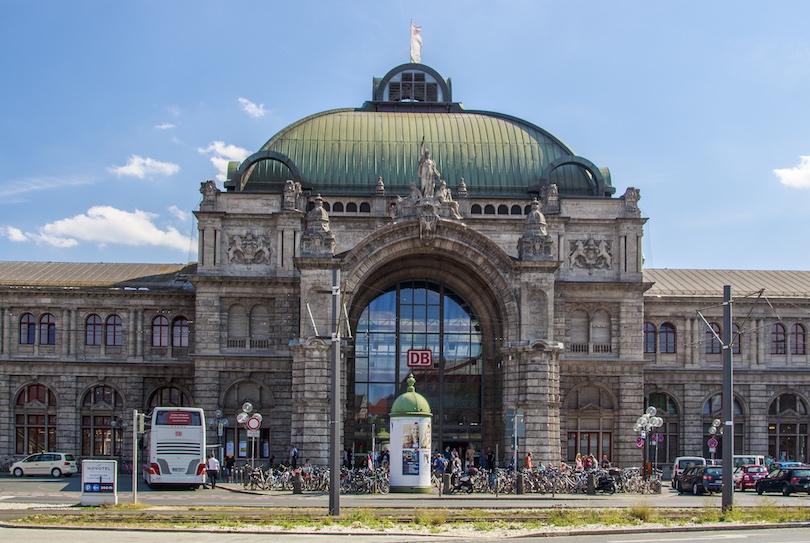
Quite well-connected to the rest of Germany by train, Nuremberg can be reached in just an hour from Munich . Frankfurt and Stuttgart both also lie roughly two and a half hours away. Each of these are serviced by a couple of busy airports with the city’s own Albrecht Durer Airport lying just north of the center.
From Nuremberg, the autobahn heads in the direction of Czechia one way and Belgium, Luxembourg and the Netherlands another. Straight to the south and southeast is Austria; around three and a half hours drive away.
Once you arrive, most tourist attractions in Nuremberg are within walking distance of the main train station. Otherwise buses, metros and trams can whisk you to them in no time at all.
Approximate travel times:
- Bamberg – 40 minutes by car, 25 minutes by train
- Regensburg – 1 hour by car, 1 hour by train
- Munich – 2 hours by car, 1 hour 30 minutes by train
- Frankfurt – 2.5 hours by car, 2 hours by train
- Stuttgart – 2.5 hours by car, 2 hours by train
- Prague (Czech Republic) – 3 hours by car, 3 hours by train
- Vienna (Austria) – 4.5 hours by car, 4 hours by train
- Berlin – 4.5 hours by car, 3 hours by train
Best Time to Visit Nuremberg
Lying along both the Pegnitz River and Rhine-Main-Danube Canal, Nuremberg has a slightly continental climate with quite cold winters and warm, sunny summers. This is the best time to visit as temperatures hit 22 to 24°C (71 to 75°F) perfect for ambling about the Altstadt and exploring its nearby parks and forests.
Countless fun events create a lively atmosphere though the city is quite crowded and prices are at their highest. Sudden rain showers can put a bit of a damper though on the Rock im Park and Bardentreffen music festivals.
Although cooler at 14 to 20°C (so 57 to 68°F), both spring and autumn are also pleasant times to visit. In April the Volksfest attracts millions of visitors, as does the two-week Altstadtfest in September. Displaying plenty of Franconian traditions, these both have music performances, markets and games to enjoy.
While the rest of the year is quite drab weatherwise, its famous Christkindlesmarkt entices millions in December with all the festive Christmas markets. You’ll need to wrap up warm as temperatures plummet to just 3°C (37°F).
In fact, it’s always a good idea to take a jacket to Nuremberg as each month sees between 12 and 18 days with at least some rain.
Share this post:
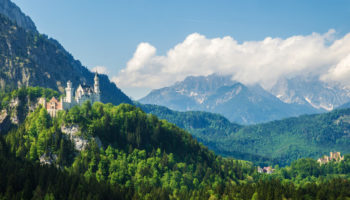
10 Top Destinations in Southern Germany
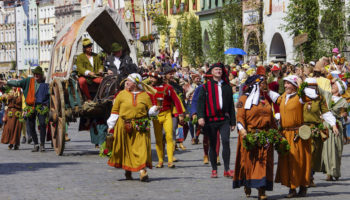
17 Best Places to Visit in Bavaria, Germany
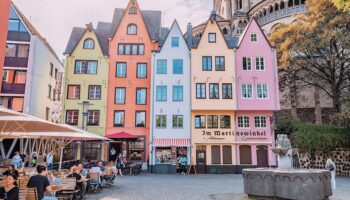
23 Top Attractions & Things to Do in Cologne
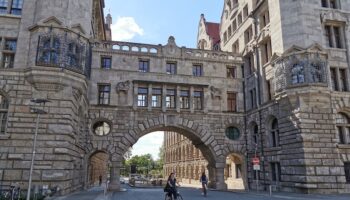
12 Top Tourist Attractions in Leipzig
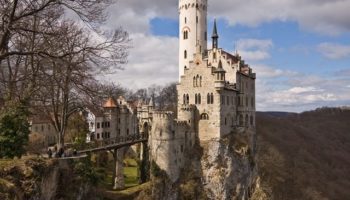
10 Most Beautiful Castles in Germany
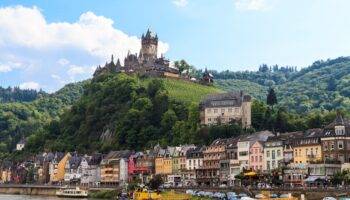
8 Best Day Trips from Frankfurt
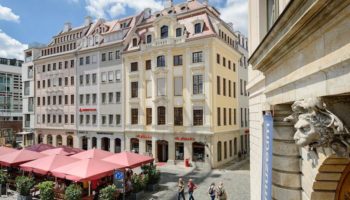
Where to Stay in Dresden: 8 Amazing Hotels
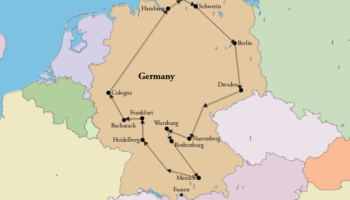
How To Spend 3 Weeks in Germany: DIY Itinerary
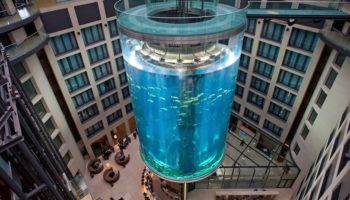
11 Most Amazing Hotels in Germany
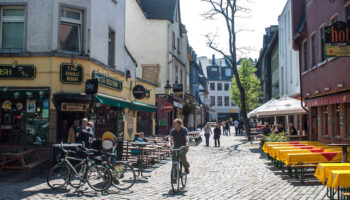
18 Best Things to do in Frankfurt, Germany
Reader interactions, leave a reply cancel reply.
Your email address will not be published. Required fields are marked *
This site uses Akismet to reduce spam. Learn how your comment data is processed .

Home » Europe » Germany » 18 Fun Things to Do in Nuremberg, Germany
18 Fun Things to Do in Nuremberg, Germany
By Author Laura Longwell
Posted on Last updated: October 14, 2022
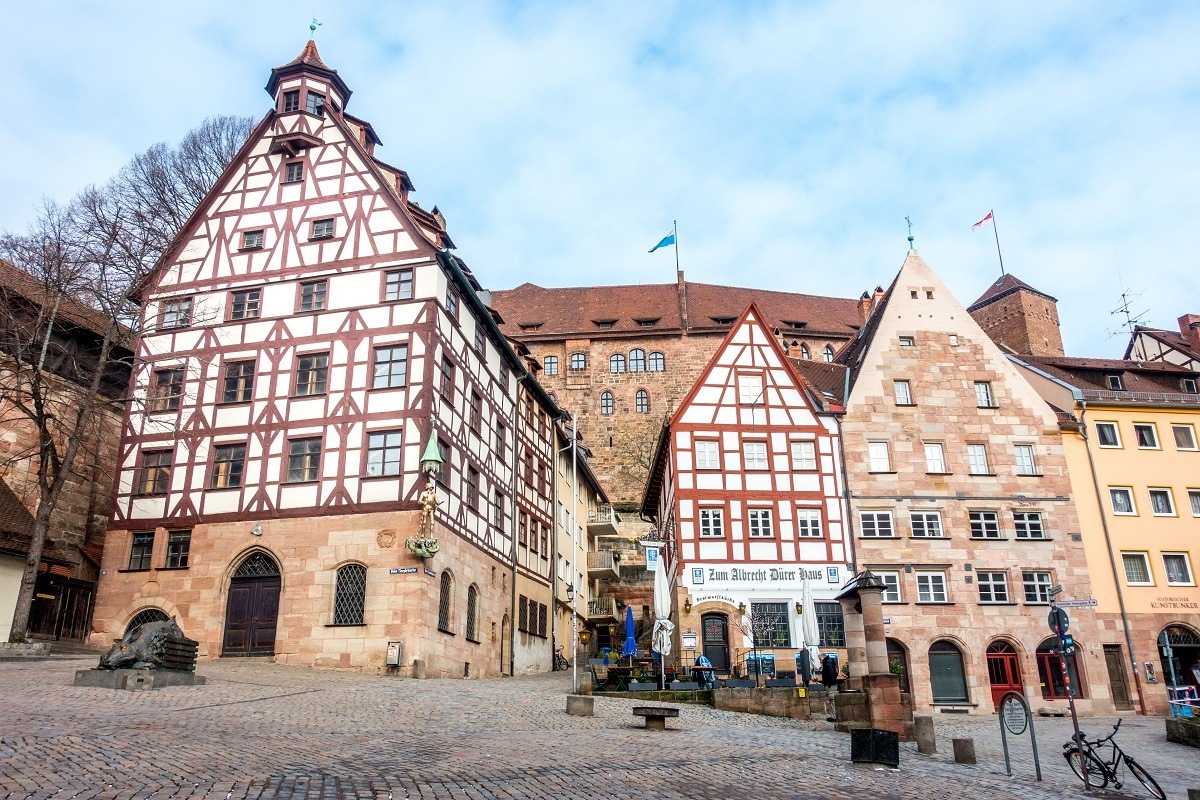
Dotted with medieval churches, laced together with half-timbered buildings, and punctuated by a castle from the early days of the Holy Roman Empire, Nuremberg, Germany, is bursting at the seams with history. Walking around the old town, every few steps, there’s something new to see from the 13th century or the Renaissance or some other prosperous period in the past. For lovers of art and architecture, there are so many interesting things to do in Nuremberg and so many sites to see.
And, yet, it’s a miracle that the old town exists at all.
Nuremberg’s modern history is less glorious than its ancient history. As a weapons manufacturing hub, a hotbed of Nazi activity, and the location of the annual Nazi Party rally for 15 years, the city became a target for Allied bombing during World War II. Most of old town Nuremberg was destroyed. The pieces that stand today are lucky survivors or carefully preserved and reconstructed remains.
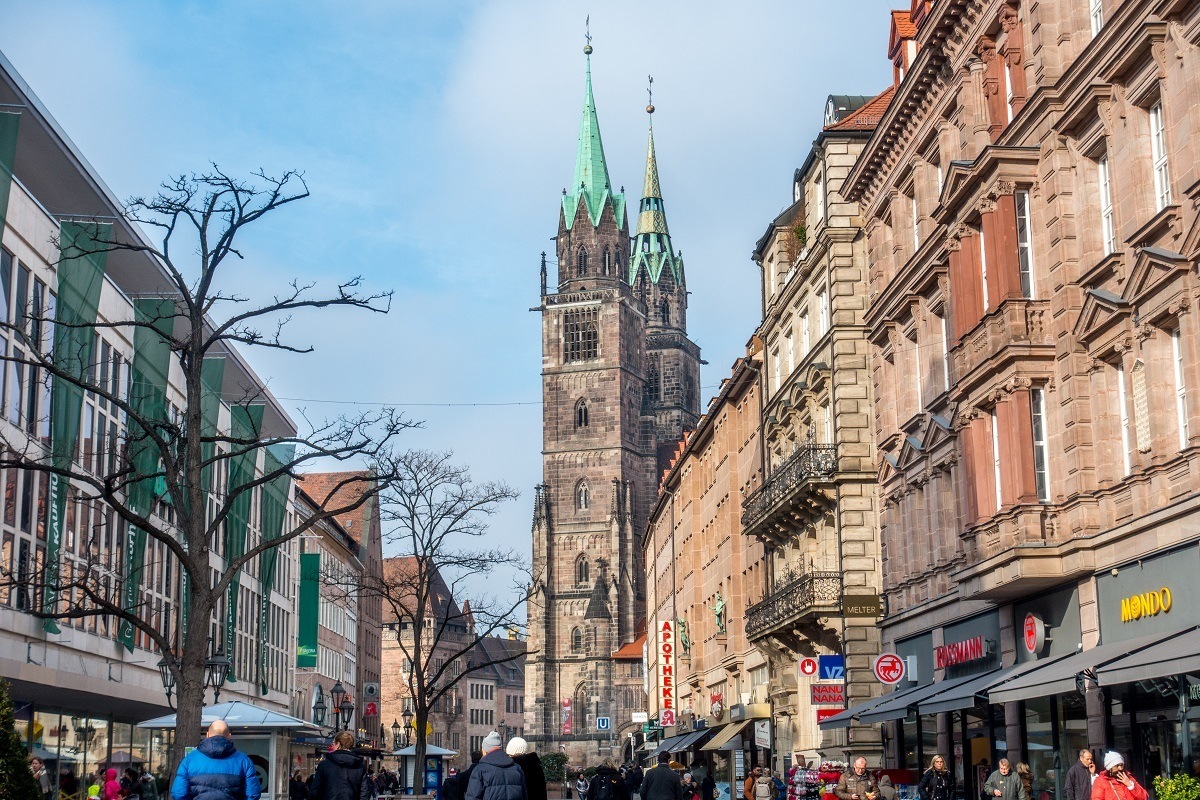
Today Nuremberg is a complex city. It’s full of beautiful buildings, ancient artworks, and endless stories of emperors and kings. It’s also a city that’s acknowledged its past and built monuments to justice and peace. Plus, it’s the home to one of the most festive Christmas markets in the world.
We’ve visited five times and are still uncovering new things to do in Nuremberg and new aspects to love about the city. Here’s a look at some of our favorites.
Shop at Handwerkerhof
Gaze at st. lawrence church, visit the hospital of the holy spirit, see the sites of the hauptmarkt, visit the weinstadel wine depot, see the colors of the medieval tanners’ lane, walk through the nuremberg imperial castle, immerse yourself in art at albrecht durer’s house, see the documentation center nazi party rally grounds, get cultured at the german national museum, walk the way of human rights, step back in history in courtroom 600, see st. sebald church, take a ride to the white tower, contemplate romance at the ehekarussell fountain, visit the toy museum, try the city’s famous sausage, don’t miss the christmas market.
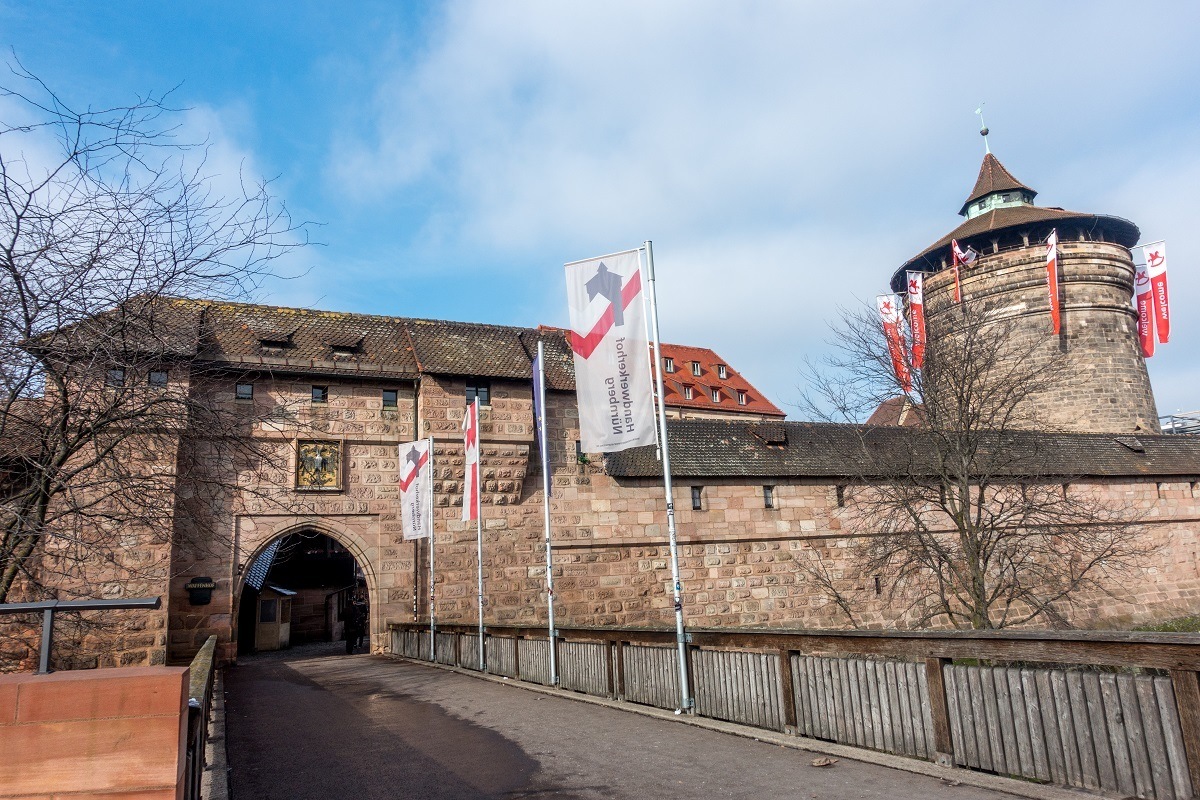
Walking from the train station to the center of historic Nuremberg, the first attraction you see is Handwerkerhof , a small craftsman’s court. The large, round tower with its “welcome” flags and the ancient city gate let you know you’re headed in the right direction.
The gate and the old city wall mark the entrance to this area that was the former weapons yard of the imperial city of Nuremberg. In this small corner, you’ll find elaborate wrought-iron signs and half-timbered buildings housing a variety of businesses.
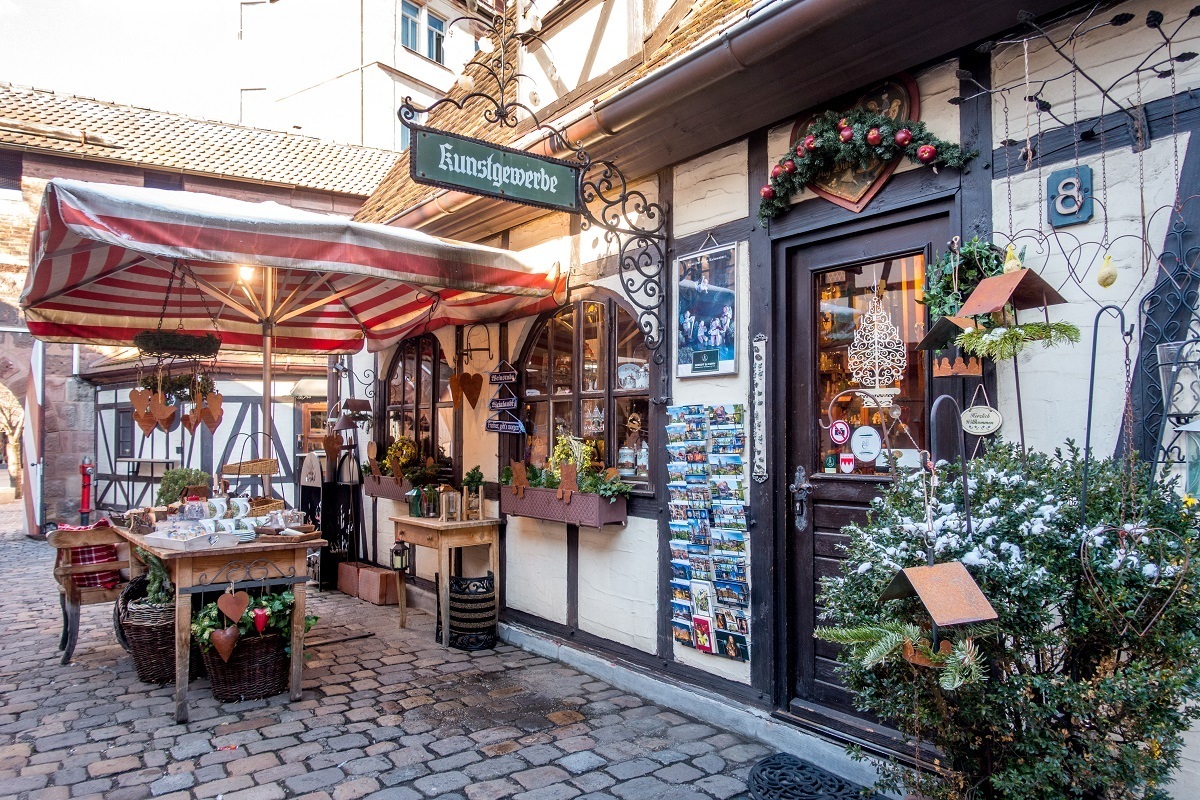
There are craftsmen selling leather goods, jewelry, wooden toys, and souvenirs. You’ll find a handful of cafes and bars offering coffee, pastries, and the heartier food of Germany like Franconian beer and the city’s namesake Nuremberger bratwurst sausages.
Visitors can also watch potters, metalworkers, glass grinders, and other craftsmen at work in their workshops. The outside of the rustic businesses give you a glimpse of what walking through the streets of Nuremberg might have felt like 300 years ago.
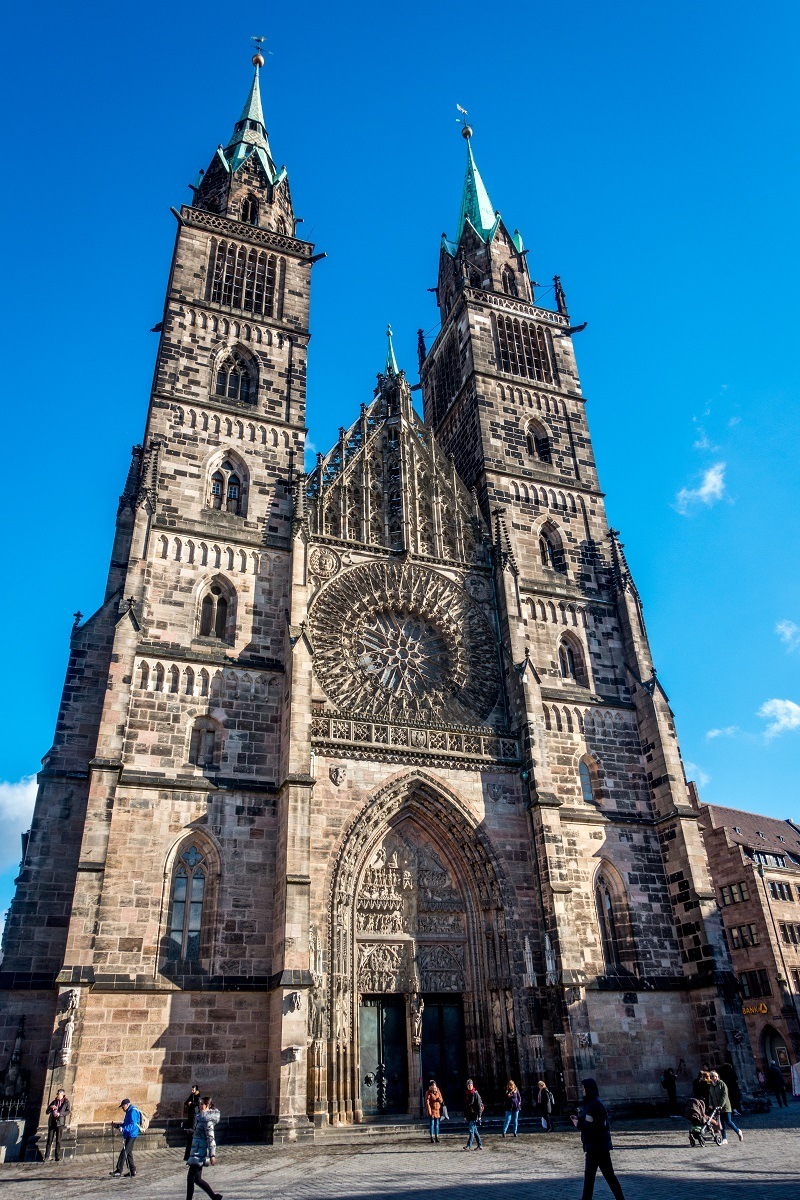
With its twin towers reaching over 260 feet in the air, it’s impossible to miss St. Lawrence Church (Lorenzkirche) along Konigstrasse, now the main shopping street in Nuremberg. Originally built as a Catholic Church, it became Lutheran after the Reformation started by Martin Luther in the early 16th century.
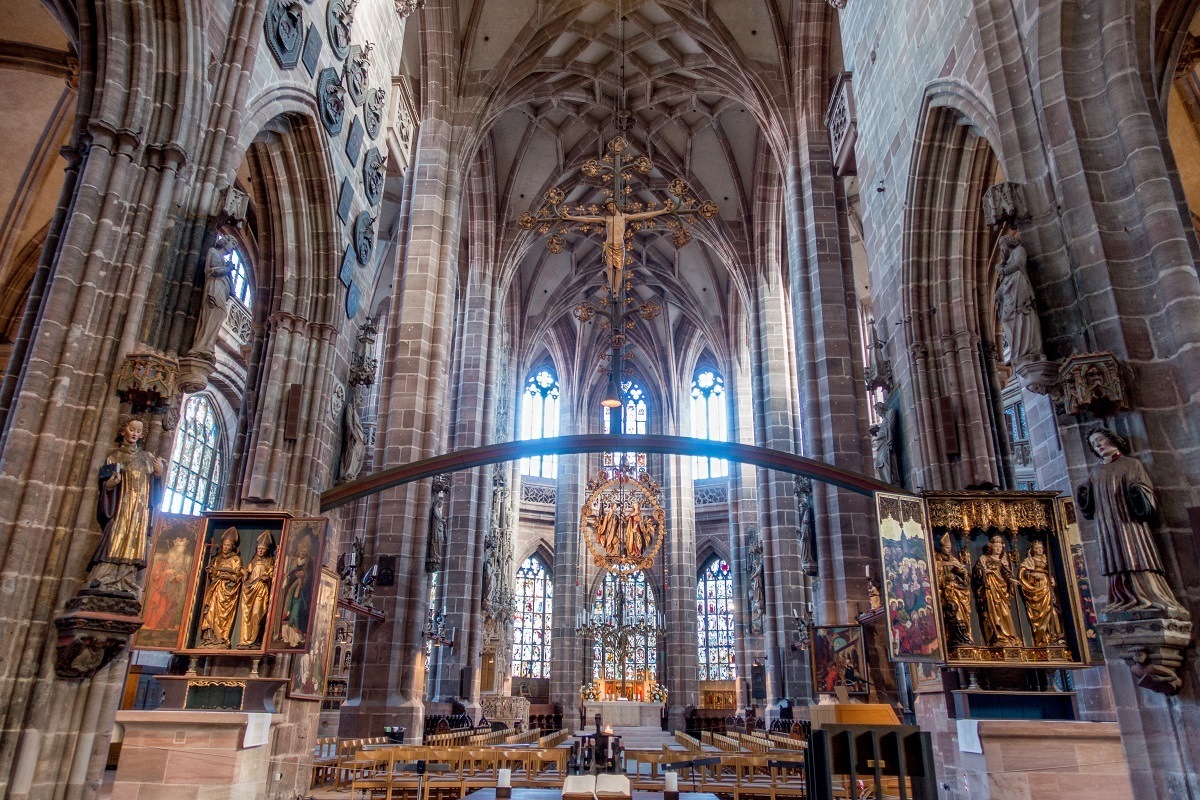
Construction began about 1250 on this church built in the high Gothic style and continued well into the 1400s, making it one of the oldest buildings in the city. St. Lawrence was damaged in the Allied bombings during World War II and was reconstructed, but its ornate western façade with the rose window remained largely intact.
The interior of the church is free to visit. You’ll see the carved choir and ornate pulpit along with elaborately designed stained glass.
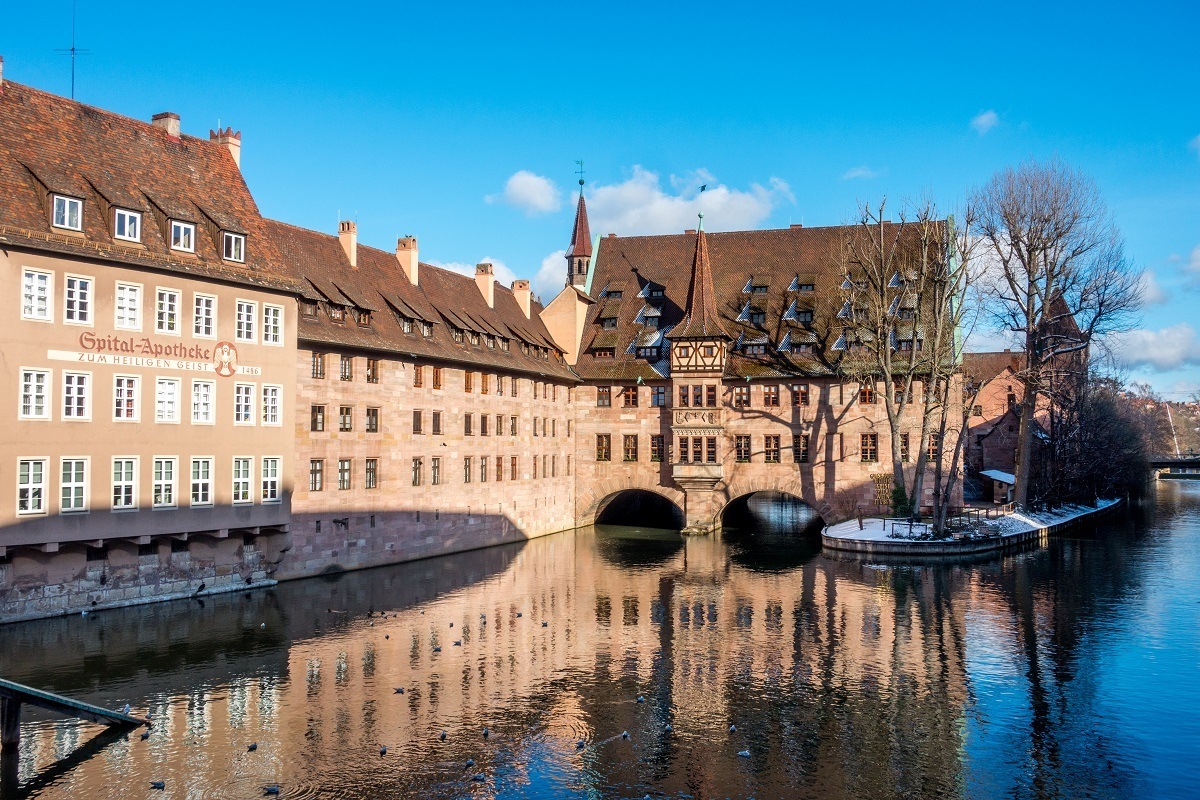
Most people admire one of the main sites in Nuremberg—The Hospital of the Holy Spirit (Heilig-Geist-Spital)—from the outside without knowing its purpose. With its arches and the Pegnitz River flowing underneath, it’s easy to see why this historical place attracts so much attention.
The Hospital of the Holy Spirit was established in the 1330s to care for the elderly and the needy. For nearly 200 years, it remained the largest private endowment in the Holy Roman Empire. Today, it’s a retirement home, and the hospital’s former dining room is a top restaurant in Nuremberg.
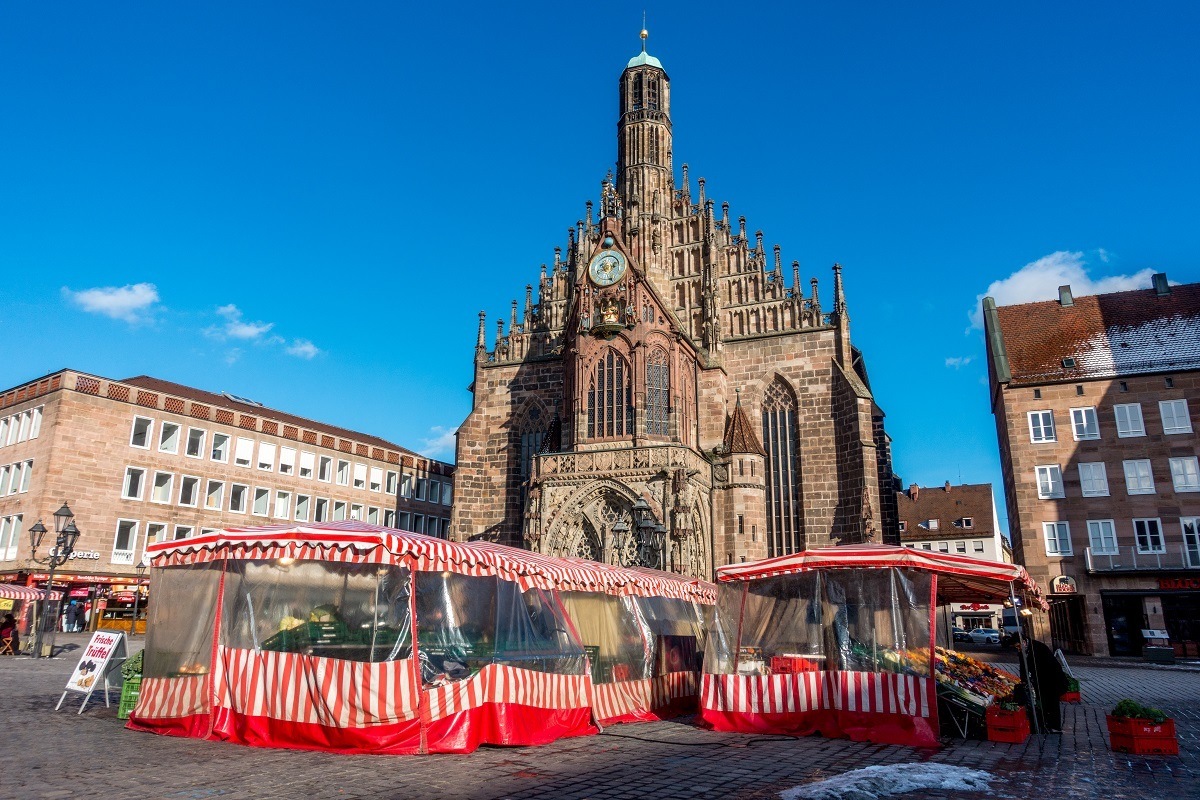
There is a lot going on in the Hauptmarkt, so it’s an area you shouldn’t miss . In the center of the historic old town, the square hosts regular markets and is the location of the city’s most iconic church and an opulent fountain.
The Hauptmarkt plaza is the site of daily markets. The square fills with vendors selling fresh produce, flowers, pastries, and more. There is also a group of food trucks where you can get German, Lebanese, and other international cuisines for a quick, inexpensive lunch.
At Christmas, the Hauptmarkt is the center of the Christkindlesmarkt . Every inch is occupied by craft vendors and food sellers. At the foot of the Frauenkirche (the Church of Our Lady), choirs and bands perform Christmas carols for the thousands that flow through the market, which is not only one of the top places to visit in Nuremberg but one of the top markets in all of Germany and Europe.
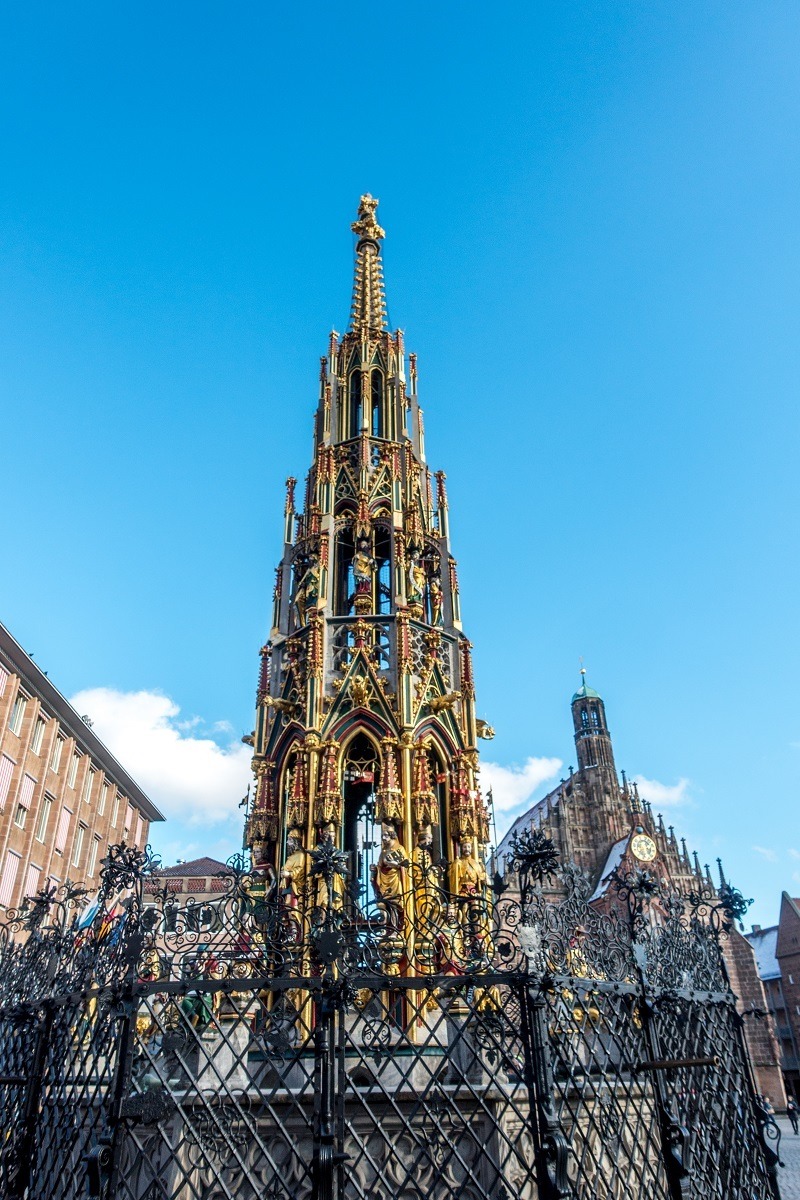
Every day at noon, the clock of the Gothic Frauenkirche is one of the top things to see in Nuremberg because the clock’s figurines come to life. A parade circles the Holy Roman Emperor, and trumpeters and a drummer perform on the face of the 16th-century clock. Step inside the church to see the sculptures and artwork from the Middle Ages.
Don’t miss the fountain on the corner of the Hauptmarkt, the Schöner Brunnen (Beautiful Fountain). The fountain dates from the 1380s and it’s adorned with 40 colorful figurines. Touch the golden ring for good luck.
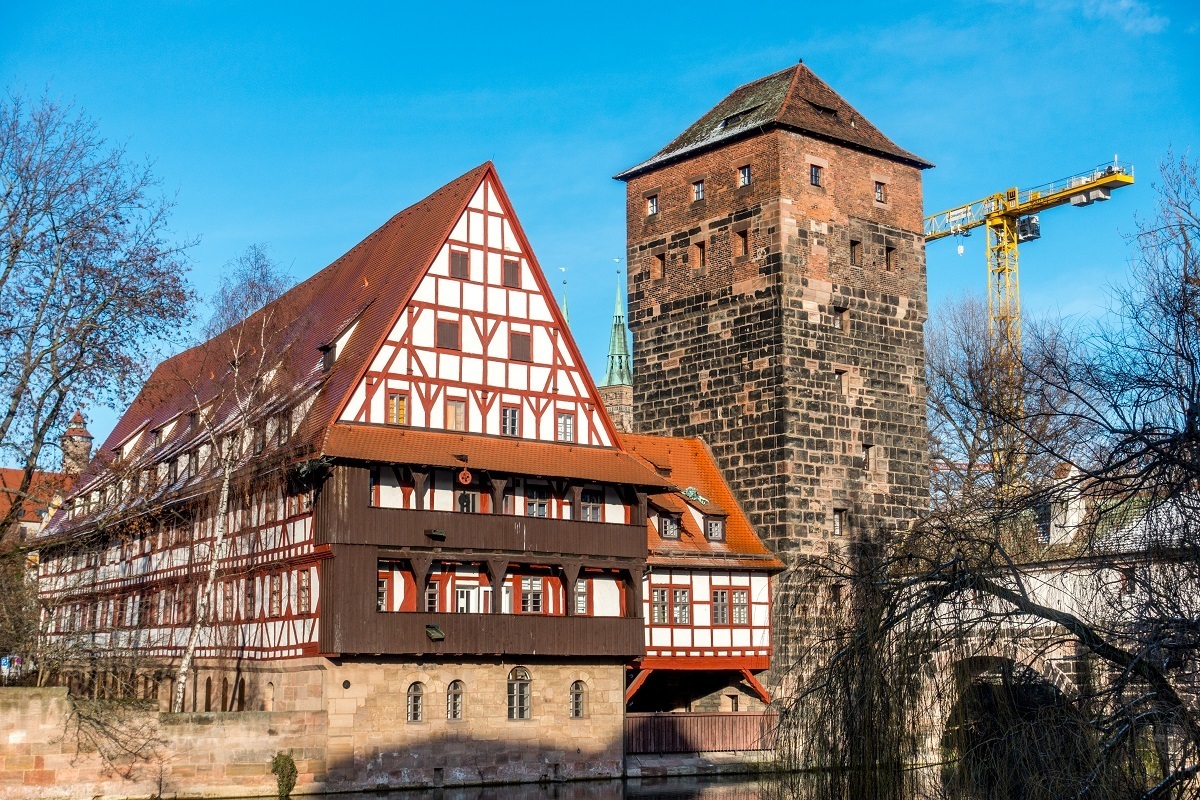
As soon as I read that the Weinstadel is the largest half-timbered building in Germany, it was added to our list of what to see in Nuremberg. (I have a small obsession with half-timbered towns .) At over 150 feet long, it is impressive not just because of its size but because it has withstood nearly 600 years of changes in the city of Nuremberg.
Built 1446-1448, the Weinstadel (“wine depot”) originally served a unique purpose. Each year at Easter, citizens with leprosy were allowed into town for three days to receive food, clothing, and medical attention in the building.
Needs changed over time, and it ultimately became a wine warehouse in 1571. Hence the current name. It later became a workhouse, a hospital, and a home for poor families over the centuries. Today, it provides student housing.
Take a stroll on the bridge, admire the architecture, and keep a look out for the gargoyles.
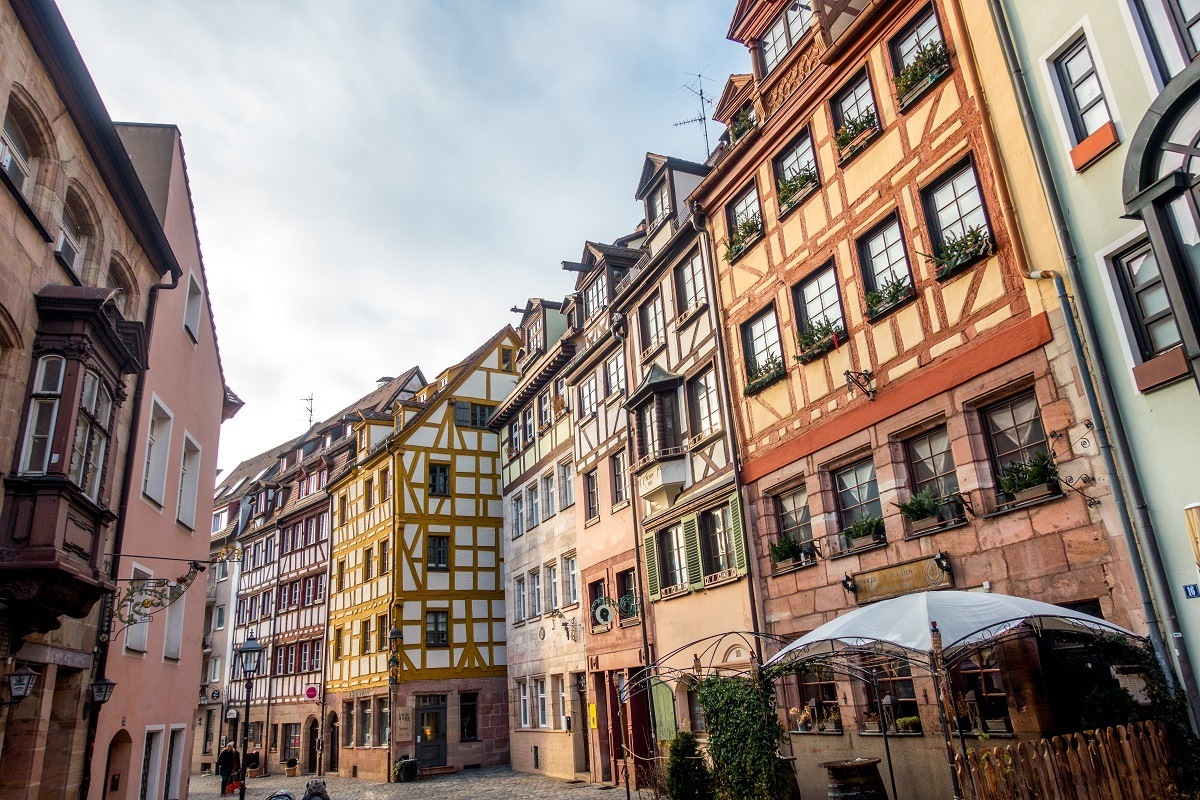
Not far from the Weinstadel, the medieval tanners’ lane, Weissgerbergasse , is the best-preserved street in the old town and a must-see when you visit Nuremberg. With half-timbered construction and colorful facades, the lane echoes similarly preserved streets of the same era such as the tanners’ lane in Colmar, France (once a free imperial city like Nuremberg and also once part of Germany.)
In the Middle Ages, these houses with their own gardens and wells belonged to the white tanners of the city. Today, these 20 houses show what the remaining artisan quarters looked like pre-war and are a testament to the middle-class wealth that arose from leather-making. Instead of busy tanneries and workshops, Weissgerbergasse is now a pedestrian area with cafés, bars, and boutiques.
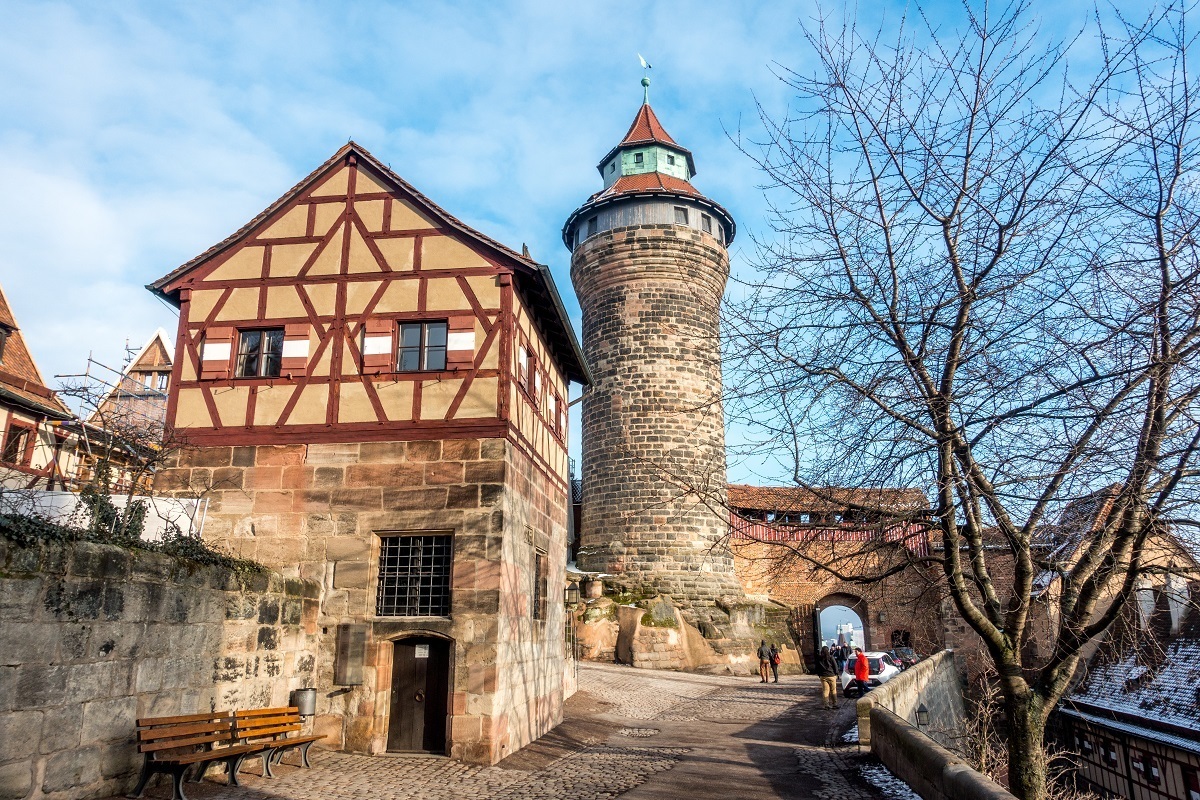
The Imperial Castle has been the symbol of Nuremberg for over 1000 years. In the Middle Ages, its grandeur was a testament to the power and importance of the Holy Roman Empire and the critical role of the imperial city of Nuremberg. As a favorite stopping place for rulers on their trips across the Empire, the castle in Nuremberg was a key location for court assemblies, Imperial Diets, and meetings of the most important people in the realm.
Over the centuries, portions of the castle complex have been built, re-built, and added to according to the style and needs of the time. Though it lost its importance for a time after the Thirty Years War in the 1600s, the castle continued to be used on and off by heads of state and dignitaries through the 20th century.
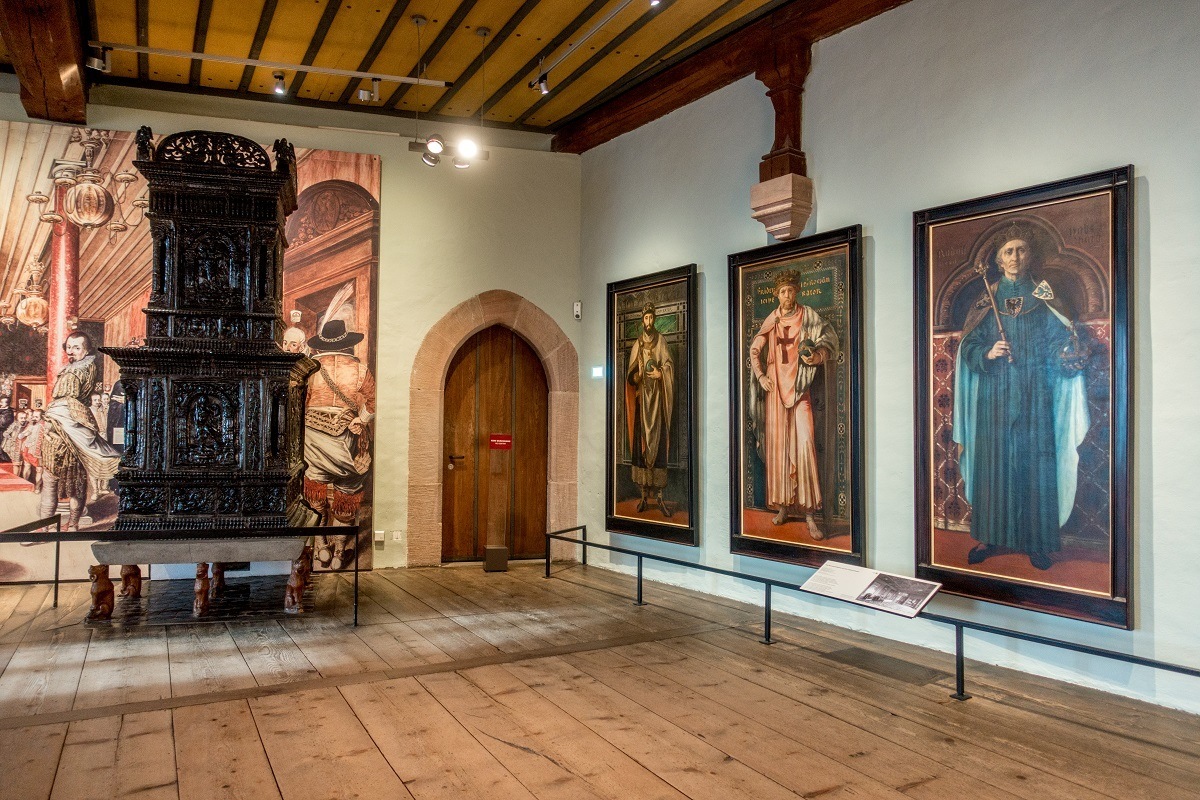
Some parts of the castle were in ruins after the War, but other parts—like the famous Sinwell Tower and the Double Chapel in the center of the castle—were nearly untouched. Restored to its original state, the castle is one of the highlights of sightseeing in Nuremberg.
The Imperial Castle Museum contains an array of artifacts, including weapons, official documents, and artwork. There are interesting exhibits about the function of the castle and Nuremberg’s place in the Holy Roman Empire. Visitors can also climb the Sinwell Tower and take a tour of the “Deep Well,” the castle’s medieval water source.
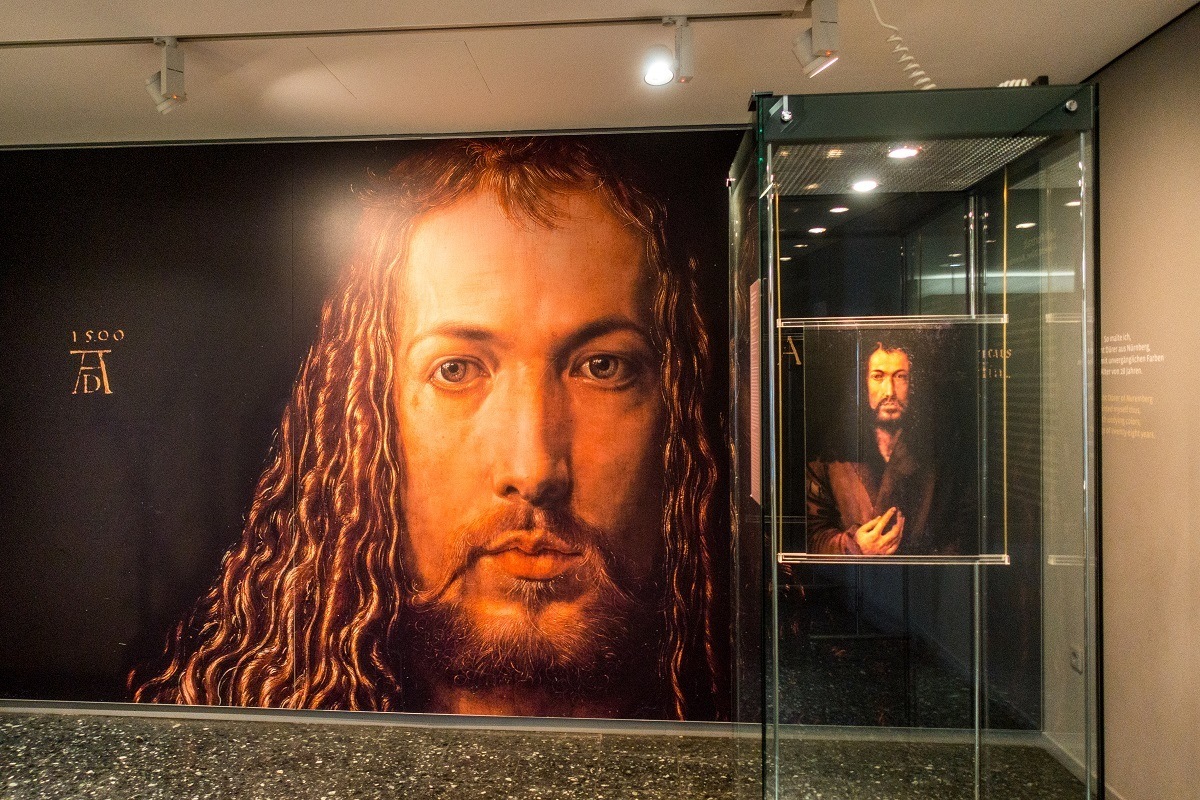
Albrecht Durer is Nuremberg’s most famous son and Germany’s most famous artist. The German Renaissance artist was a painter, engraver, and printmaker credited with helping to bring the ideas of the Renaissance to Northern Europe thanks to his communication with other masters including Raphael and Leonardo da Vinci.
For nearly 20 years—beginning in 1509 until his death—he lived and worked in the 5-story, red half-timbered house near the castle. One of the few such buildings to survive the war, his home and studio is now a museum about his life and work.
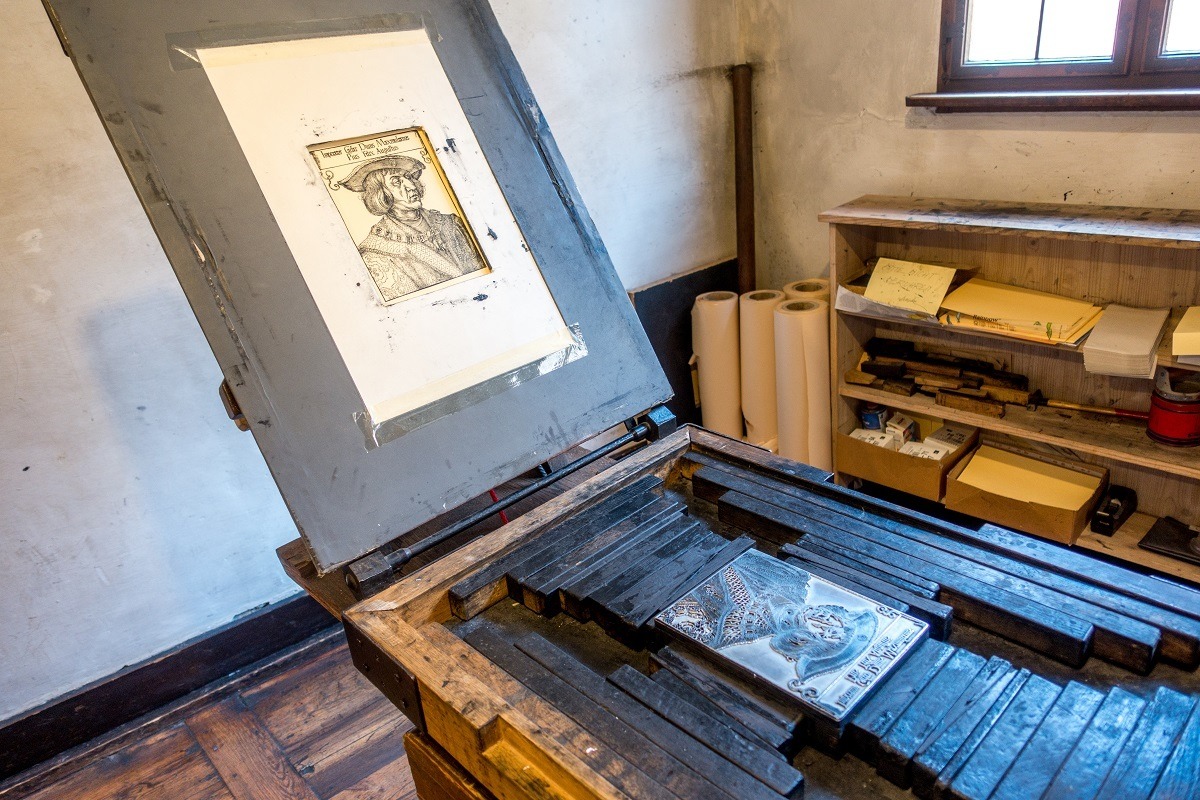
The Durer House, the only surviving 15th century artist’s house in Northern Europe, was purchased by the city in 1826. It has been preserved and restored, though none of Durer’s possessions remain.
The museum features valuable copies of his most famous works and furnishings of the type Durer would have owned along with a recreation of his workshop. Rotating exhibits also feature items from Nuremberg’s art collections. Visitors can watch copper plate engravings on site for a glimpse into Durer’s techniques and work and can take a tour with an actress playing Agnes Durer, the wife of the artist.
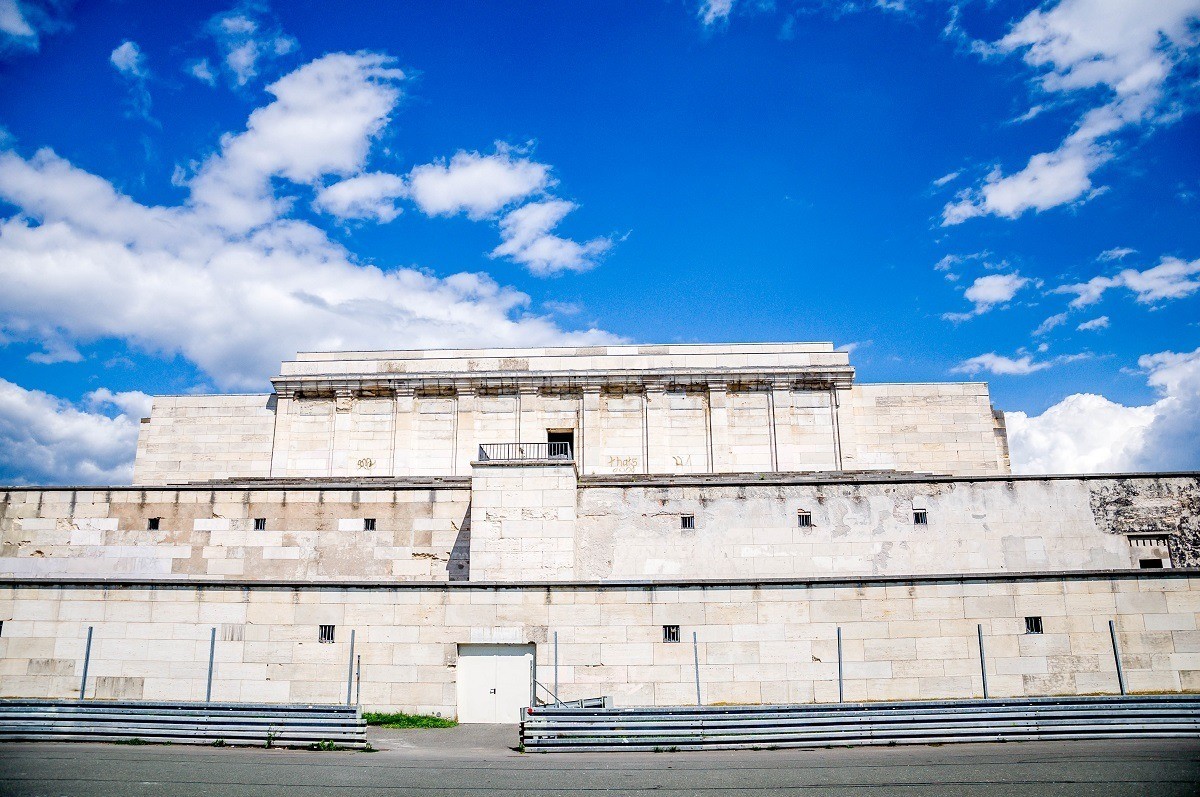
The unfortunate reality of Nuremberg’s history is that it is closely tied to the Nazi Party, in large part because of the annual rallies held here. The Nazi Party Rally Grounds —about 2.5 miles (4km) from the center of town—have been preserved so that Germany will never forget what happened and the world can focus on never allowing it to happen again.
For 15 years, the 7-square-mile site of the Rally Grounds ( Reichsparteitagsgelände ) hosted massive rallies where hordes of Nazi faithful engaged in sports, built friendships, and grew in their allegiance to Hitler and their hatred of non-Aryans. One of the spectacles was featured in Leni Riefenstahl’s controversial film the Triumph of the Will .
Walking around the grounds today is eerie. You can see the famous Zeppelin Field (now used as football pitches) and the Tribune Stand from which Hitler addressed the masses as well as the Congress Hall, the party’s central meeting place. The Rally Grounds also has a Documentation Center, the site’s museum and a center for studying of the Nazi period. Anyone interested in history will find this site intriguing.
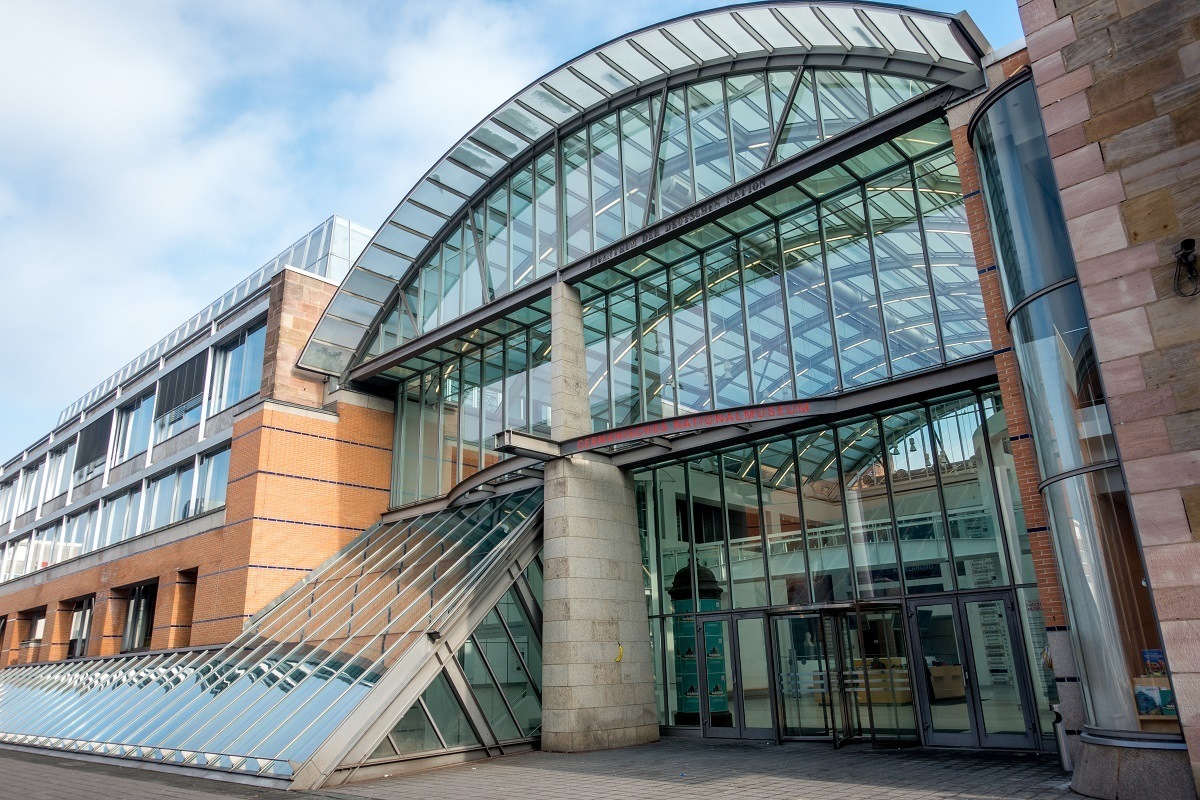
The German National Museum (Germanisches Nationalmuseum) is the premier collection of German art and artifacts in Europe. Founded in 1852, the museum houses items relating to German culture and art from prehistoric times through to the present day.
One of the largest museums in Europe, the collection of the German National Museum includes more than one million items. There are Neolithic tools, ancient statues and carvings, and items belonging to emperors and royals. Among the museum’s greatest treasures are works by Albrecht Durer and the world’s oldest globe.
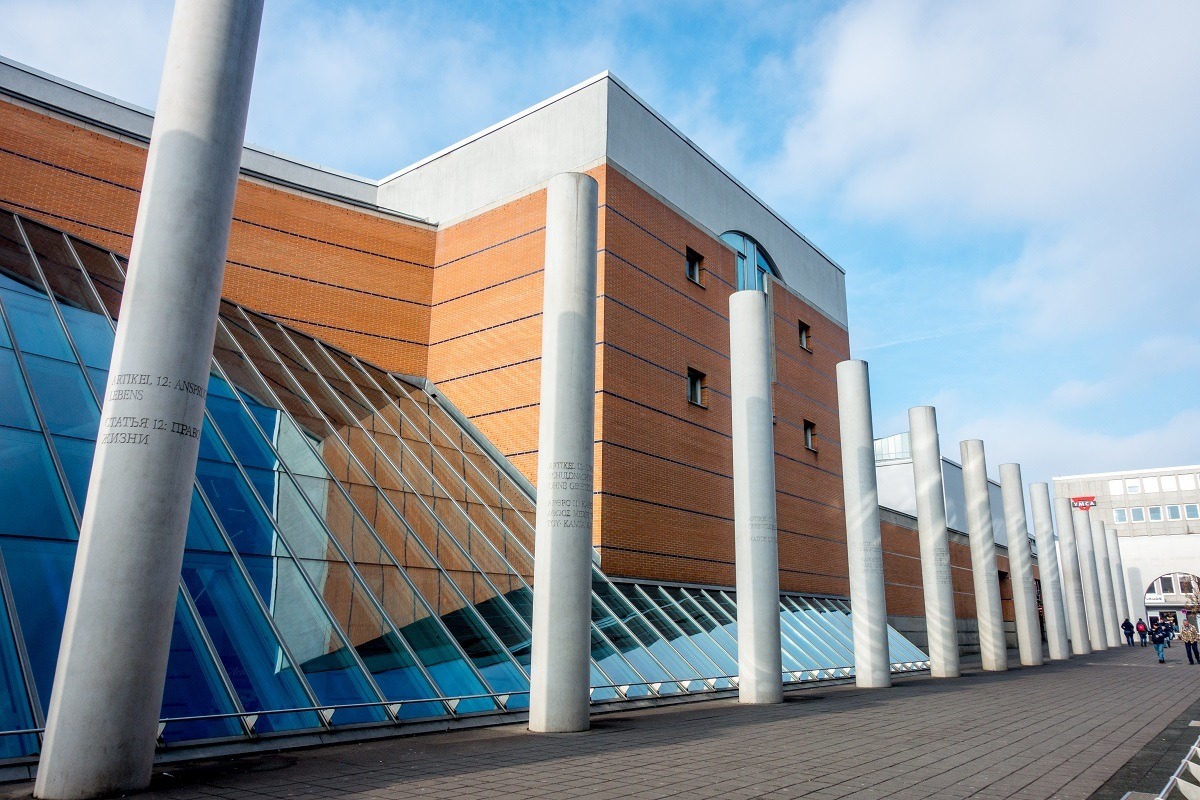
Next to the German National Museum is an artwork known as the Way of Human Rights . Unveiled in 1993, the installation is a response to the city’s past role in the Nazi Party movement and the need for overall awareness of human rights.
Walking from the Kornmarkt past the museum, visitors pass 27 large concrete columns. On each one, there is an article of the Universal Declaration of Human Rights in a different language (plus German). The work is even more relevant in today’s political climate than it was when it was created as parts of Europe, the US, and other countries continue to move to the political right.
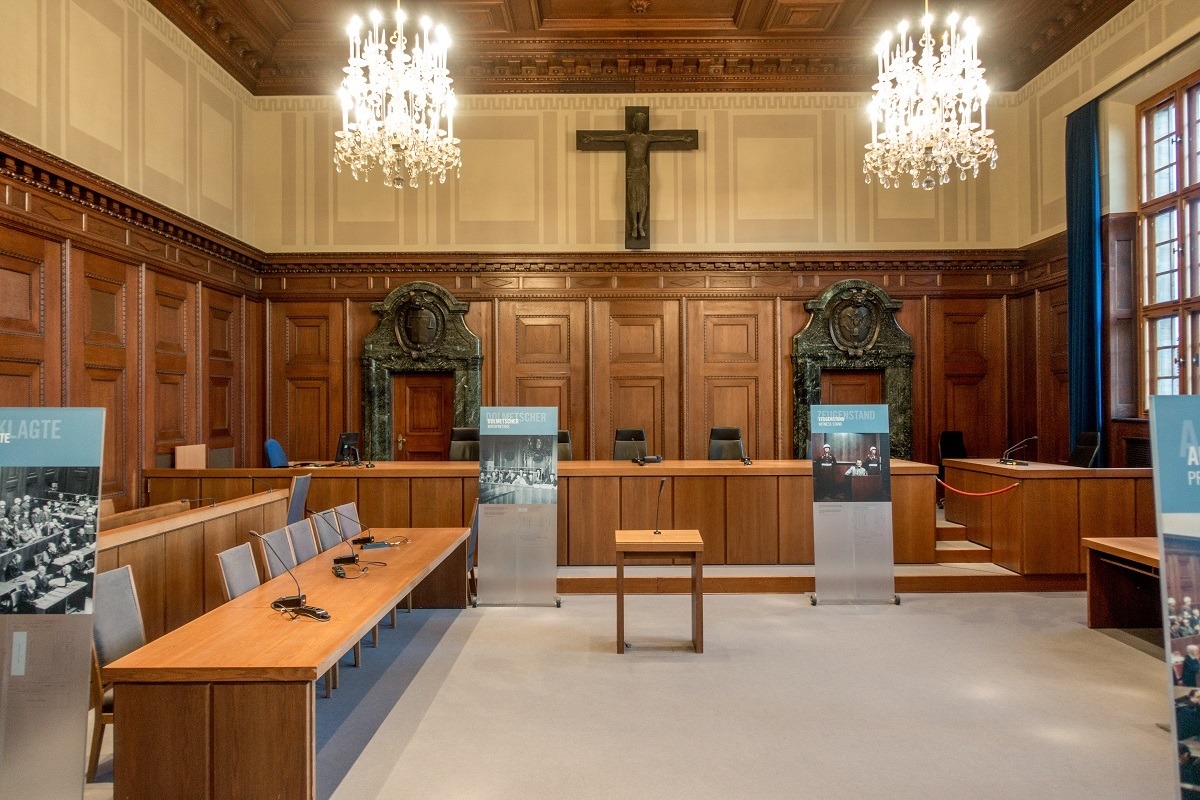
We have been to numerous Holocaust sites. We’ve seen the barracks at Dachau and the items people left behind at Auschwitz . We’ve seen Anne Frank’s hiding place in Amsterdam and walked the Jewish ghetto in Budapest . None of those places prepared me for the feeling of utter disgust I had sitting in Courtroom 600 in Nuremberg.
For four years following World War II, Courtroom 600 at Nuremberg’s Palace of Justice was the location where the worst of the worst were put on trial. The first Nuremberg Trial was the most notorious.
From November 1945 to October 1946, 24 of the primary perpetrators of the Holocaust, including Nazi Party leaders like Rudolf Hess and Hermann Goring, had to answer for their roles in the Final Solution. Knowing I was walking where they walked and sitting where they sat hit me unexpectedly hard.
In Courtroom 600, visitors learn about why Nuremberg was chosen for the trials, how the prisoners were held, and all the modifications made to the courtroom to accommodate the prisoners, media, and numerous interested parties.
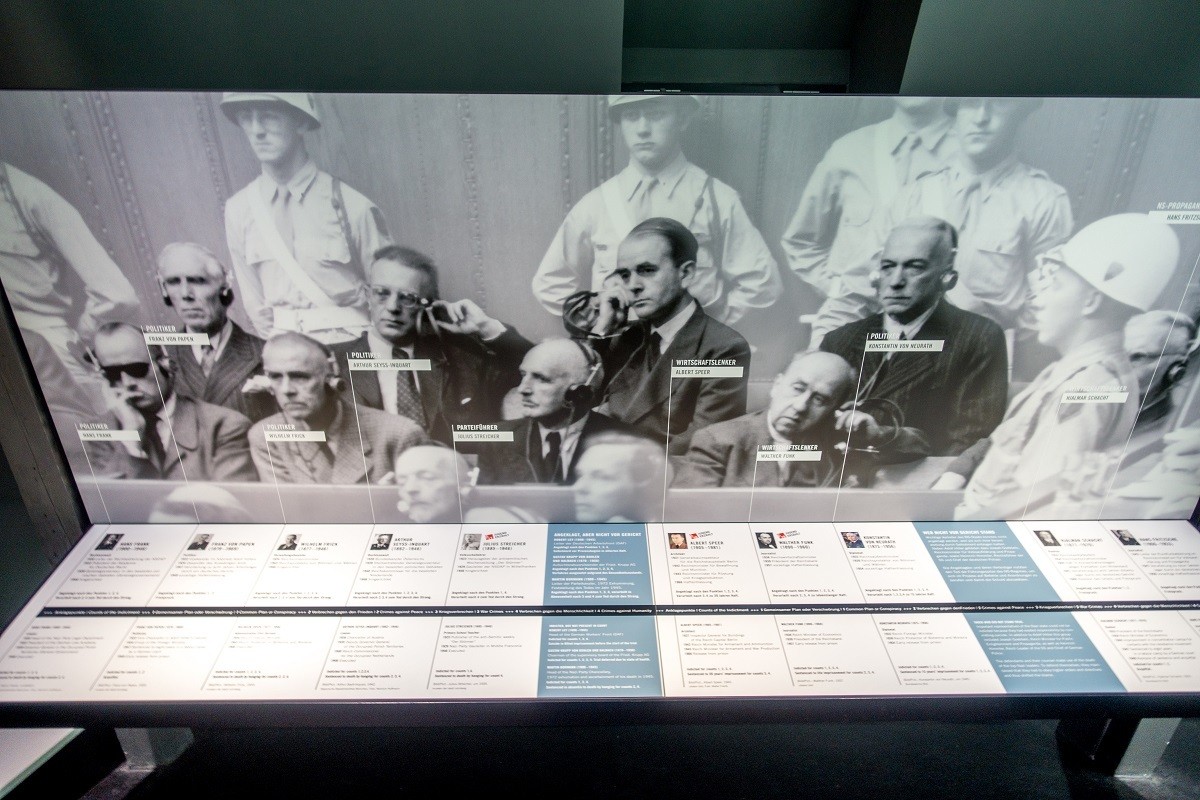
Other exhibits in the courthouse go into detail about the lives of the prisoners and how the trials were conducted. They also outline the role of the Nuremberg Trials as important precedents for how international law is now administered, particularly as related to genocide and other crimes against humanity. Despite my visceral feelings about the people involved, Courtroom 600 is one of the best places to visit in Nuremberg.
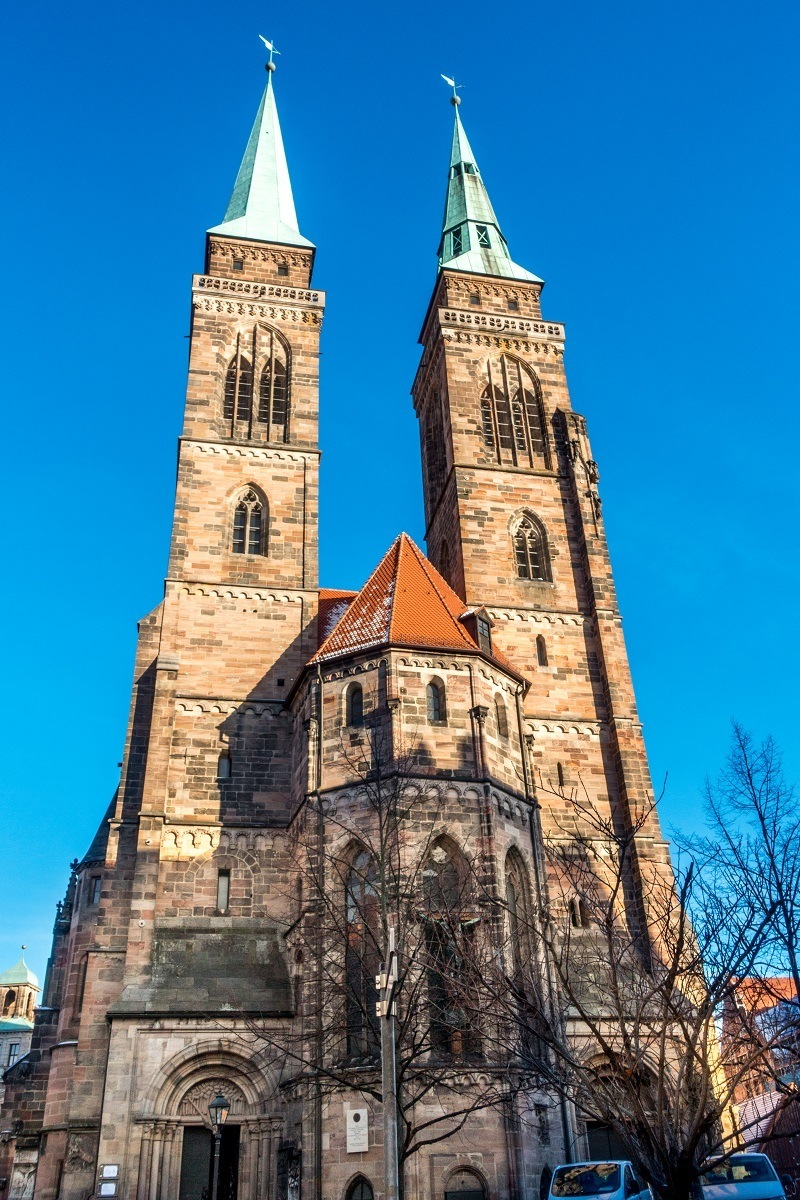
The oldest church in Nuremberg, St. Sebald Church was consecrated in 1273. Part Gothic and part Romanesque, it takes its name from Sebaldus, an 8th-century hermit and missionary who became the city’s patron saint.
The Baroque interior of the church is the site of the tomb of St. Sebald, an imposing brass monument ringed with saints and sitting atop a group of snails. The bones of Sebaldus are presumed to be in the silver embossed box in the center.
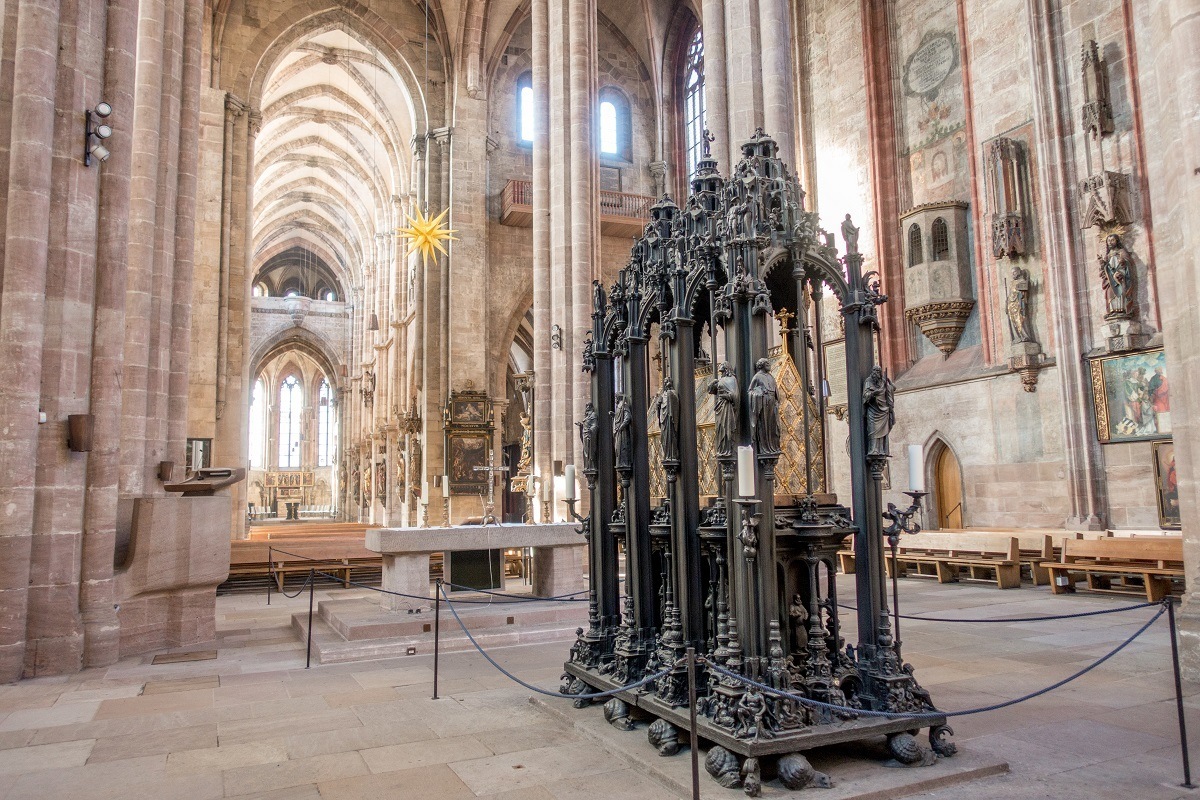
Like many of the other buildings in Nuremberg, St. Sebald Church was partially destroyed during the War. It was rebuilt and re-consecrated in the 1950s. With its beautiful carvings, statues, and frescoes from the Middle Ages, you would never know the extent of the damage it suffered.
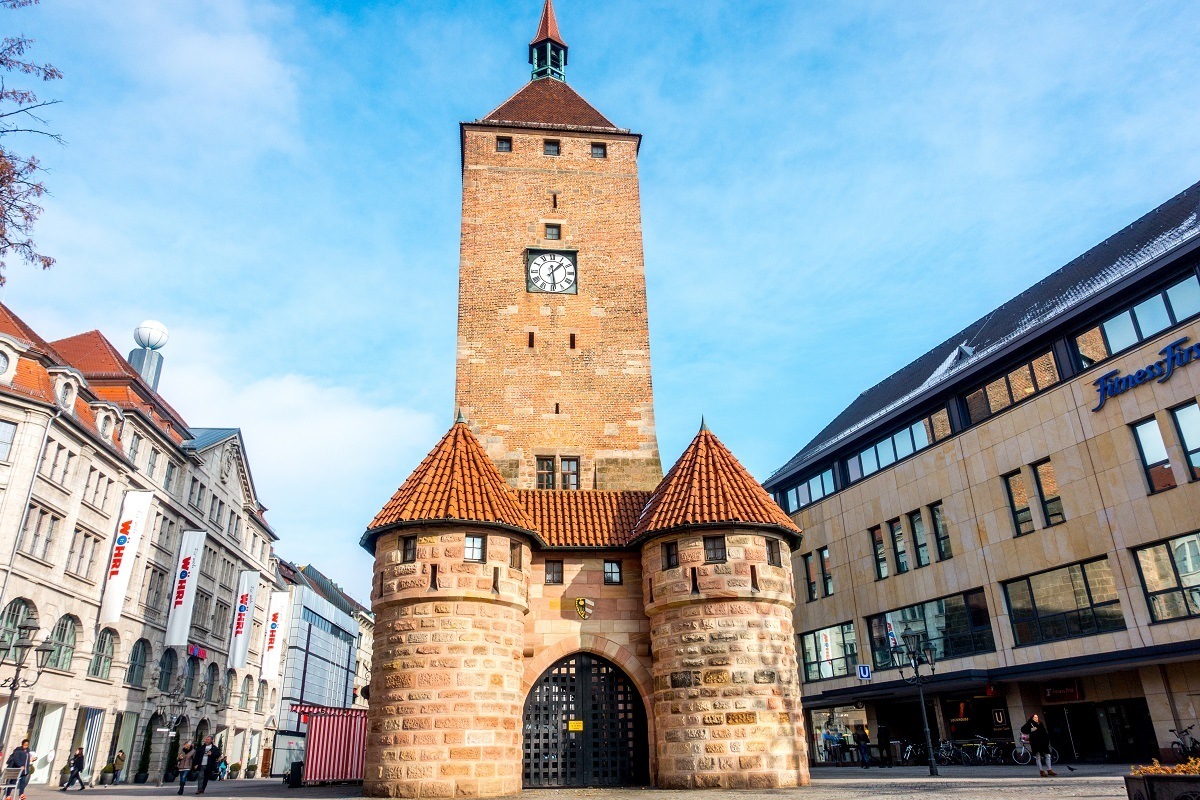
The White Tower (Weisser Turm) is one of the oldest structures in Nuremberg. Originally built around 1250, the tower and gate originally served as a tollbooth and were formerly part of the second city wall. It is one of the few remaining such towers in the city of Nuremberg.
The tower was named after the white plaster that originally covered its exterior, but that was removed as part of restoration efforts following the War. Since 1978, the tower has been the above-ground part of the Weisser Turm subway stop, making it even easier for people to visit.
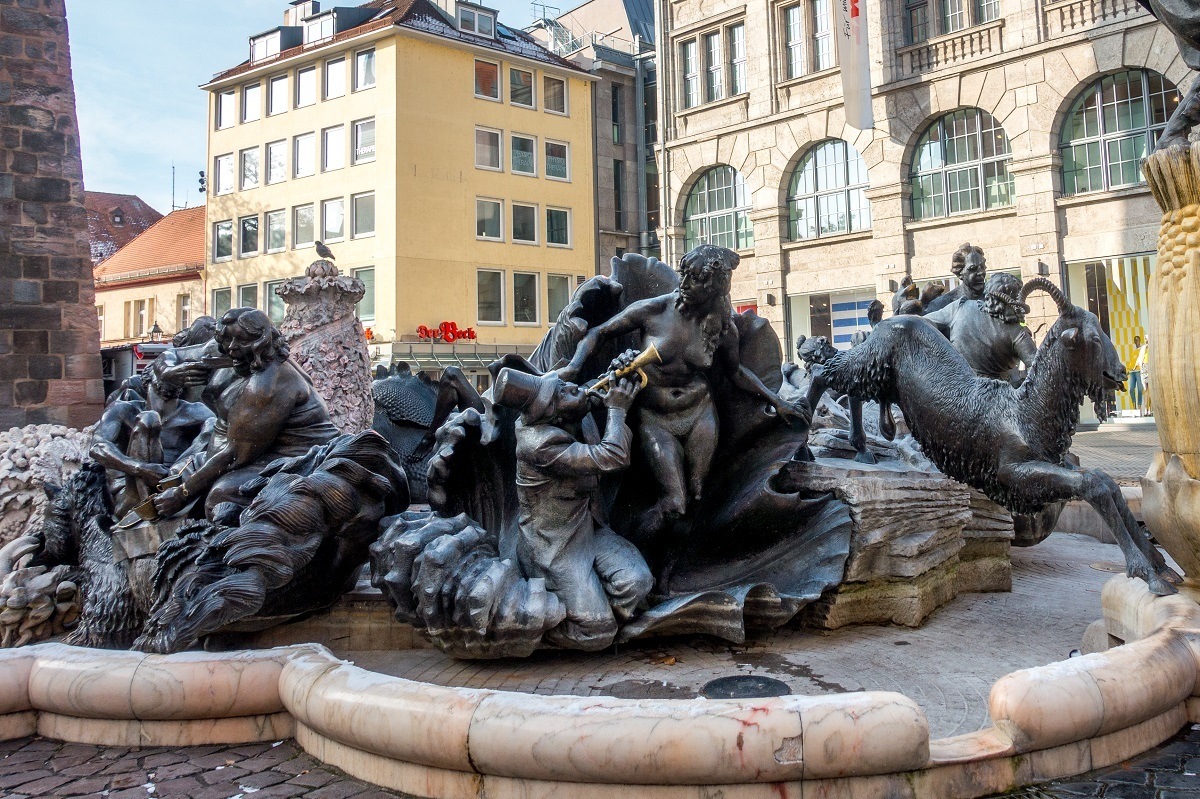
Just behind Weisser Turm is one of the few Nuremberg attractions without a medieval pedigree or roots in World War II. The Ehekarussell Fountain (loosely translated, the Marriage-Merry-Go-Round) was completed in 1981 based on a verse by Hans Sachs, a 16th-century German poet.
The controversial bronze fountain depicts—sometimes grotesquely—the stages of courtship and marriage. Pairs of men and women with the odd animal thrown in show life from dating through death. There’s love, gluttony, nudity, and seemingly murder, which combine into a sculpture that is both loved and hated, depending on who you ask.
Nuremberg’s Toy Museum has one of the largest and most wide-ranging collections of toys in the world with more than 85,000 objects. The collection spans the time from antiquity to the modern day. Permanent exhibits include wooden toys, dollhouses, and movable toys like toy trains, cars, and more technologically advanced items. There are also classics like Barbie and Lego.
In addition to exhibits, visitors can play games, experiment with crafts, and read books. In the summer months, you can linger in the outdoor café and watch the model train.
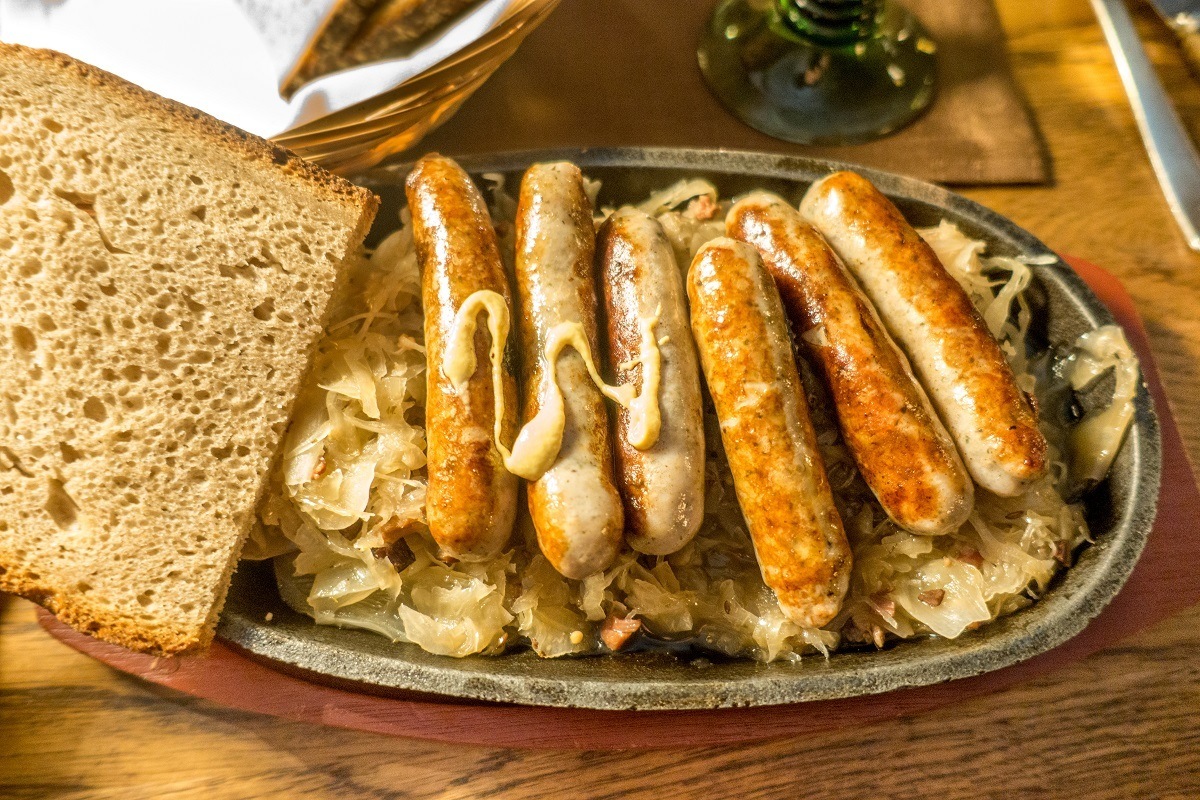
Germany and sausage go hand in hand. One of our favorites are the Nurembergers, Nuremberg’s namesake sausage that the city is famous for. You can’t leave without trying them.
Nurembergers, or rostbratwurst, are small marjoram-flavored pork sausages, about the size of a breakfast link sausage. According to legend (these sausages have been around at least 500 years), they had to be small to fit through the key holes of the city gates and, after closing time, through the key holes of pub doors.
Traditionally, Nurembergers are grilled over a beechwood fire, though it’s also common to find them reheated on a flat-top grill, especially at street food stands. At the stands, they are often sold as Drei im Weckla (three in a bun). In restaurants, they’re served as a main dish of six sausages on a pewter plate with sauerkraut or potato salad with a healthy dose of horseradish or mustard.
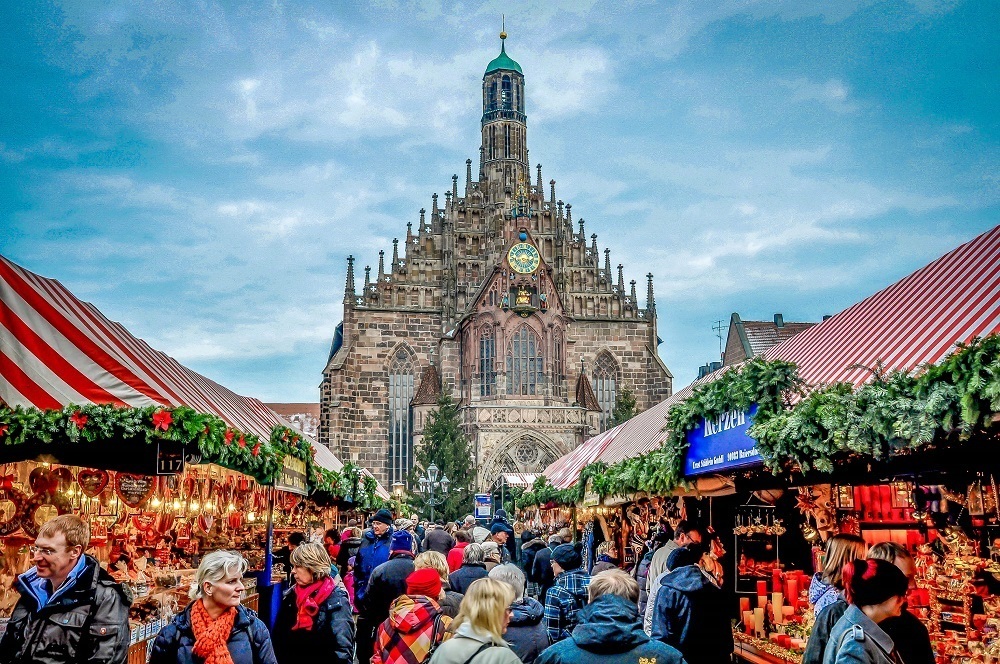
We cannot say enough about our all-consuming love for Christkindlesmarkt, the Christmas market in Nuremberg. With the smells of traditional foods, the sounds of choirs, and the sights of the stunning nutcrackers and ornaments for sale, the market is one of the most famous Christmas markets in Germany for good reason.
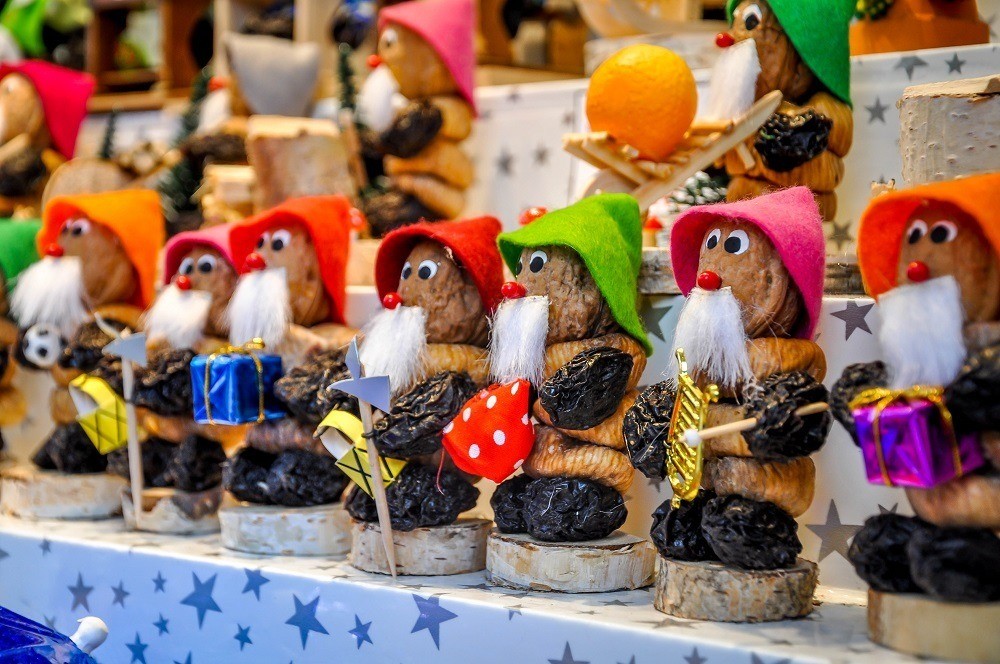
The section of the market in the Hauptmarkt holds the most vendors. There, you’ll find the “prune people” that are traditional in the city alongside gingerbread (lebkuchen), Christmas cakes, and more mulled wine ( gluhwein ) than you can ever drink. The festivity is infectious.
There is also a section of the market just for children, and–on the opposite end of the celebration spectrum–a place to drink from the world’s largest feuerzangenbowle, a concoction of mulled wine and rum-soaked sugar. Horses clomp through the streets carrying visitors on carriage rides, and there are numerous parades.
If you’re really lucky, you’ll get to see the Christkind, and angel (a teenage girl) who brings children their Christmas gifts. If you have the chance to visit Nuremberg at Christmas, do not hesitate.
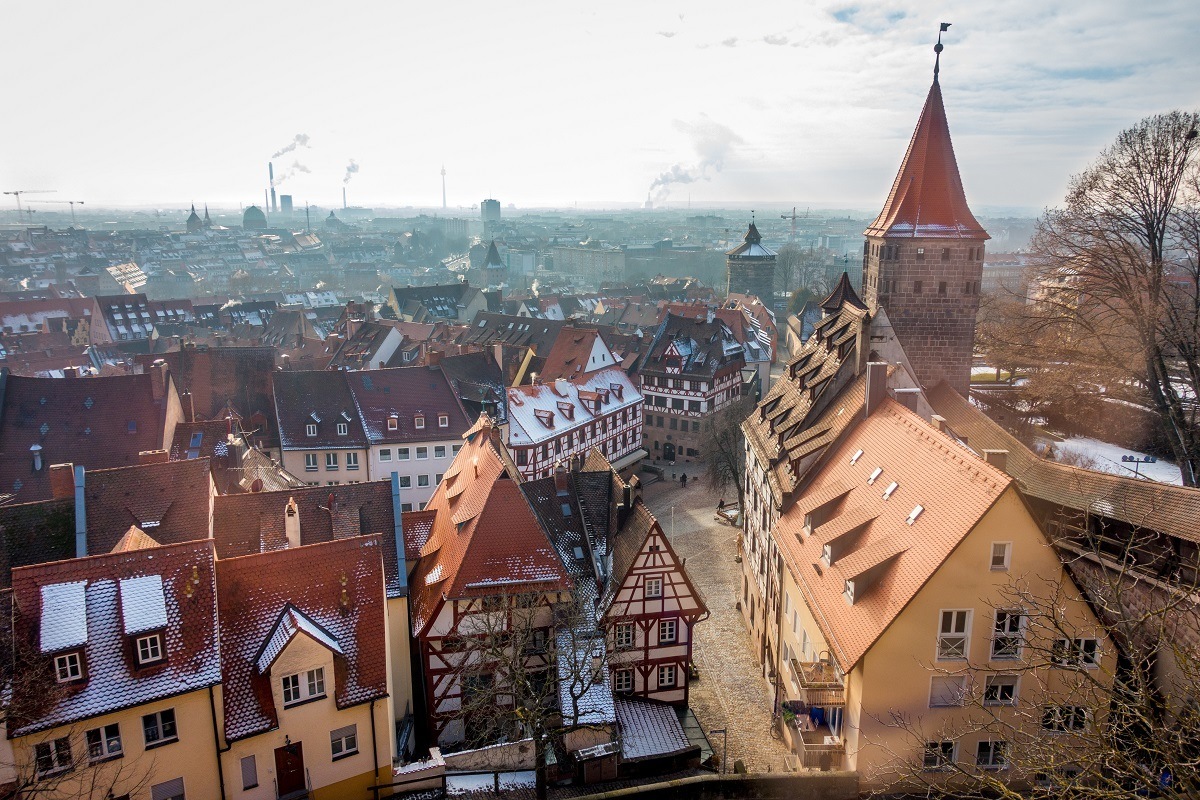
Where to Stay Le Meridien Grand Hotel : Centrally located with comfortable beds, elaborate breakfast, and a bubbly happy hour NH Collection Nurnberg City : Four-star hotel offering rooms with views over a summer terrace and herb garden Where to Eat Cocoon : Sushi, stir fry, and savory Asian flavors Burgerheart : Excellent burgers and fried in old town Der Nassauer Keller : Traditional German food in a Bavarian cellar
Laura Longwell is an award-winning travel blogger and photographer. Since founding Travel Addicts in 2008, she has written hundreds of articles that help over 3 million people a year get the most out of their travel. In that time, she has visited nearly 60 countries on 5 continents, often returning to favorite destinations over and over again. She has a deep love of history, uncovering unexpected attractions, and trying all the good food a place has to offer.
In addition to Travel Addicts, Laura runs a site about her hometown of Philadelphia—Guide to Philly—which chronicles unique things to do and places to see around southeastern Pennsylvania. Her travel tips and advice appear across the web.
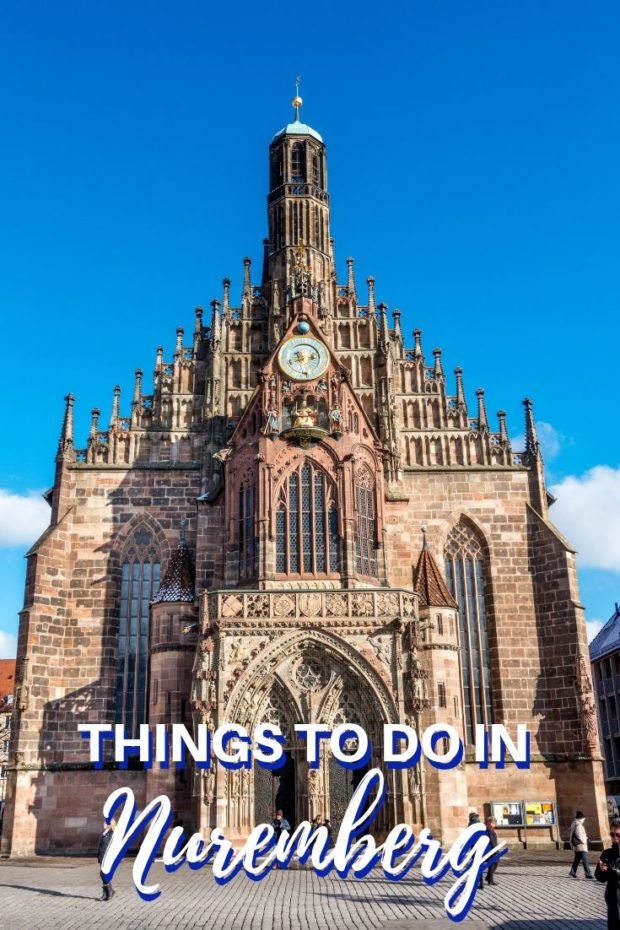
Share this post:
This site uses Akismet to reduce spam. Learn how your comment data is processed .
Tuesday 3rd of January 2023
Are there these places or most of them, within a walking distance from each other or is it necessary bus or other transportation.
Laura Longwell
Most sites are in walking distance of each other. The Nazi Party Rally Grounds and Courtroom 600 are further out and might require transportation.
Saturday 13th of July 2019
Great photos. Enjoy Franconia, we spent some time in Bamberg, Nuremberg and Wurzburg a couple of years ago and it's one of our favorite regions. Planning a trip back later this year and this post gives me a few more ideas.
Sunday 14th of July 2019
Glad it's helpful. There are so many pretty towns to visit in the region :)
ROOTS ABROAD
Explore with us
Best Things to Do in Nuremberg | A Complete 2-Day Guide
Renaissance splendor, an imperial castle sweeping you back in time, and local delicacies for foodie lovers. This travel guide with top things to do in Nuremberg ( Nürnberg ) has got you covered.
Known as the hometown of the world’s oldest bratwurst restaurant, the birthplace of Albrecht Dürer , and for its tumultuous history. You can find here an abundance of historical spots & musea, cozy bars & restaurants, gorgeous shopping areas, and local delicacies to try out. Walking around you will encounter several little squares with an energetic flair where people are enjoying drinks on terraces. The best is, even though it’s one of the bigger cities in Bavaria, in the old town all the attractions are easily reachable on foot.
This picture-perfect Franconian town is the ultimate getaway for a lovely day trip. Maybe even a full weekend since there are plenty of things to do in Nuremberg. After visiting quite some places in Germany , mainly in the Bavarian part, we can truly say that Nuremberg blew us off our socks. It’s that perfect kind of touristy destination that offers something for everyone who wants to go on a city trip.
This guide will take you on the perfect walking tour throughout the old city along with all the beautiful medieval sights . You can perfectly alter our recommendations to your liking, depending on the length of your stay. Combined with the best food spots on where to have the most delicious regional specialties, your perfect Nuremberg getaway is just a blog post read away.
Background & History of Nuremberg
The medieval city of Nuremberg (Nürnberg) is located in the Northern part of Bavaria, more specifically in the Franconian region . Most inhabitants consider themselves first and foremost Franken (Franconian), which can be noticed in slight cultural differences with their southern neighbors like Munich and Regensburg. This history-rich city is one of the most important centers in Germany when it comes to culture and art.
Nuremberg lived through some major significant world events, even dating back to the Roman Empire. Fun fact, the city was actually an unofficial capital of the Roman Empire. The Kaiserburg castle has hosted many ceremonies for centuries during those times. Walking through the medieval strongholds you will surely see the depth of history the city of Nuremberg represents. To this date, the old town (Altstadt) is still encircled by fortified walls with the mighty Kaiserburg higher up north watching over the surroundings.
When looking up Nuremberg, this city will pop up often in association with World War II and the trials that took place thereafter. On the rally grounds outside the city, you can find an in-depth museum about the Nazi regime , right at the Nazi congress hall. Actually, over 90% of Nuremberg was completely destroyed by air raids carried out by allied forces and thousands of civilians lost their lives. Many of the important medieval buildings that you see within the historic city walls have been rebuilt in their former traditional glory, even though it was impossible to recreate everything, especially hundreds of half-timbered houses are lost forever.
You will notice plaques at the entrance of buildings, mentioning the initial building date and the rebuilt one. Reconstruction projects are still ongoing, like the one on the beautiful Pellerhaus . This monument was originally a library and archive. Parts are already open to visitors on the weekends.
Best Things to Do in Nuremberg
Ready to emerge yourself into the tumultuous history and picturesque lanes of this wonderful place? Below you can find our recommendations of top things to do in Nuremberg. We outlined the perfect city trip, starting from the train station in the south. We will make our way along the east part of the old city, all the way to the north at the Kaiserburg castle. From there we go back south, journeying through the west side. On this walk, you will cover the main top attractions and pass by the most lively neighborhoods. We wanted to take our time to explore so we stayed overnight. We covered the east side within the old walls on day 1 and the castle together with the west side the next day. It is possible to see everything in one day, but then you might be rushing through everything.
The entrance to the old city
Coming out of the train station you will first encounter a bustling traffic street. When you take the crosswalk it will take you directly to the big entrance of the old town. An elevated drawbridge over a wide ditch, the Stadtgraben , leads you to the Frauentor (Women’s gate) and Handwerkerhof (Craftsmen’s Courtyard). These Stadtgraben are one of the longest-surviving ones in Europe. Today they serve as a city garden to enjoy a walk and some greenery. At the end of the drawbridge, you will enter through a big gate, which is adorned with the Black Eagle Imperial Coats of Arms .
The historic city walls
What’s so unique about Nuremberg is that the city was able to preserve a great part of its circuit of old city walls. Around 4 kilometers of the wall are still standing today, part of which is the Kaiserburg castle in the north and 67 defensive towers. Originally they were first put up in the 11th century but were modified for canons during the 16th century. Throughout history, the fortifications got only once captured, which was in 1945 at the end of WWII by the Americans, when most of the city was bombarded and destroyed.
A great way to discover Nuremberg is to walk through these old city walls. You will pass by numerous gates and watchtowers . The best part is probably the west side of the wall, between the Spittlertor and Maxtor. Head over to the Fürther Tor to get the best views of the Kaiserburg and the overall Old town. This medieval tower stands in the southwestern corner.
Craftsmen’s Courtyard
Upon entering the Old town through the main gate, you will find yourself at the Craftsmen’s Courtyard ( or Handwerkerhof ). This little courtyard looks and feels straight out of a medieval book. The small alleys with their old half-timbered houses just add to the medieval feel of Nuremberg. It’s a colorful area where you can find a myriad of traditional handicraft shops such as leather goods, mouth-blown glass, goldsmith products, and wooden ornaments. You can actually still see the craftsmen like goldsmiths and glass painters work on their art. Talking about a unique souvenir to take home! Walking around, you won’t be able to escape the delicious flavors of Nuremberg bratwurst and gingerbread either. This special attraction was definitely one of our highlights in Nuremberg!
When you exit the Craftsmen’s Courtyard on the east side you will pass by the Frauentor . Probably you already spotted it from the inside since it’s one of the four large tower points around the city wall. From here we will move further on the Königsstraße .
St. Lawrence Church
One thing Nuremberg surely doesn’t lack is the number of churches. However, the formidable St. Lawrence church (or St. Lorenzkirche) probably dominates the skyline the most. With its copper spires and spectacular twin towers (80m), it’s just impossible to miss this 14-century church along the road. It was severely damaged during WWII, just like the majority of the city, but got rebuilt after.
The impressive collection of German art, its superb stained-glass rose window, and its medieval tabernacle make it worth stopping by. You might almost think it’s more of an art gallery on the inside than a place of worship. The gothic church also houses one of the largest church organs in the world. This three-part organ exists out of over 12.000 pipes and 16 bells, of which supposedly date back to the 1300s. When you leave the church, two other highlights situated on the square are the Nassauer Haus and the Fountain of Virtue .
Heilig Geist Spital
The most beloved photo spot in all of Nuremberg must be the Hospital of the Holy Spirit ( or Heilig-Geist-Spital ). The Museumsbrücke bridge that runs over the Pegnitz River is probably the best place to take pictures. The hospital was established somewhere around 1339 and it served as a caring place for the elderly and sick. At one time the hospital held the crown of the Holy Roman Emperor. These days the place houses a renowned restaurant.
When you turn to the other side of the bridge you will look over the Fleischbrücke . The late-renaissance bridge was supposedly inspired by the famous Rialto Bridge in Venice. From here you can walk straight to Market Square. We decided to take a small detour around here though, to the other side of the Heilig-Geist Spital along the Spitalbrücke . This side of the hospital also offers some amazing views and a lively area with bars.
Nuremberg Main Market
After our little detour, we ended up in the Main Market (or Hauptmarkt) of Nuremberg. For centuries this was the location for a daily market. To this day it still has its weekly market traditions (Wochenmarkt), stalls selling fresh vegetables and fruits, bread, and local pastries. But most of all, Nuremberg’s Hauptmarkt gets its fame for having the largest Christmas Market (Nürnberg Christkindlesmarkt) in Europe. During these two weeks in the holiday season, you will see the marketplace fully transformed with lights and decorations. You can wander through alleys of stalls selling Christmas treats, ornaments, and handicrafts.
READ MORE | The Most Magical Christmas Markets in Germany
Church of Our Lady
While at the Hauptmarkt you will also see the Roman Catholic Church of Our Lady (or Frauenkirche). You can’t miss it, with its spectacular gothic facade and rich details dominating the whole square. The landmark dates back to the 14th century and is adorned with sculptural decorations above the porch. Among them is a beautiful old clock with mechanical figurines. If you pass by at noon you will be able to see them perform the famous Nuremberg Glockenspiel . The inside of the church is rather humble compared to its outer appearance. Its most notable feature is the Tucher Altarpiece from 1440. Another thing you might notice is a David star, which has been placed in remembrance of the Jews that were killed during a pogrom in 1349.
Schöner Brunnen
Back on the Main Market you come across a spectacular fountain, called the Schöner Brunnen , which literally means beautiful fountain. It looks less like your typical kind of fountain, it almost more resembles a miniature version of a gothic church spire, embellished with all kinds of figurines and ornaments. The fountain is often surrounded by people that want to touch the famous golden ring . Apparently, it brings good luck to the person who turns it three times. However, this ring is more meant for tourists, you should be on the lookout for a second black ring. This is the one the locals go for to fulfill their wishes. In any case, touch them both just to be sure that your wish comes true ;).
St. Sebald Church
Right, when you leave the Hauptmarkt you will stumble upon another church, St. Sebald (or Sebaldus). It’s the oldest Protestant church in Nuremberg and dates back to the early 1200s. Make a quick stop inside along your way to the castle if you have the time. Inside you can find the tomb of the city’s patron, a bronze masterpiece from the late medieval period.
TIP | You can also join a guided tour of the towers and climb to the top to get a magnificent view of the city. Spots are limited, so make sure to purchase your ticket early and check in on updated information regarding timings.
OPENING HOURS | Daily 9:30 am-4 pm (Jan-Mar); 9:30 am-6 pm (Apr-Dec)
FEE TOWERS TOUR | €5 (children €2)
Medieval dungeons
On a more macabre note, across from the church are Nuremberg’s Medieval Dungeons located. This tourist attraction takes you on a journey along with the medieval prison that held 12 tiny cells and a torture chamber. Here they locked away criminals that were sentenced to death back in the 14th century.
Fembo house
Before reaching the castle you will pass by some more good-looking buildings, among them the Fembo house . It’s the only surviving aristocratic house from the Renaissance period and nowadays houses the city museum (or Heimatmuseum). The 16th-century old merchant house displays the town’s history within a domestic interior.
Depending on how quickly you like to rush through these sights or like to take your time, maybe enjoy a terrace with a drink in between, you can decide to still check out the castle or leave it for the next day as we did. On our way to the castle, we passed by a beer brewery (more on that later on) where we decided to make a halt and enjoy a beer tasting. On our second day in Nuremberg, we opted to leave early in the morning towards the Nuremberg Kaiserburg and start exploring the other half of the town.
Nuremberg Imperial Castle
As one of the most important fortresses of Germany, there is no escaping the imperial castle of Nuremberg (or Kaiserburg) on your city tour. The medieval landmark not only clearly dominates the city skyline, but is also an important touristic highlight. Once it was the residence of German kings and Emperors from the 11th to 16th century and remains one of the most important surviving medieval fortresses in all of Europe. The castle is located on a hill, looking out over the old town, which takes a small hike to reach. Once at the top, a magnificent view of Nuremberg opens in front of you.
FUN FACT | Inside the imperial stables, on the lower end of the Castle, you can nowadays find a youth hostel. It is possible to spend the night inside an imperial German castle! The stables have been completely renovated, but still hold that old charm thanks to their vaulted ceilings and stone walls.
Inside the castle
The castle in its current form was built during the 13th century and after, however, it got heavily damaged during World War II just like most of the city. The imperial church was the only part that survived the bombings. The rest was mostly restored afterward. Once the fortified castle played a huge role during the Holy Roman Empire. It served as an important location for imperial assemblies whenever the Roman Emperor would visit. Upon his arrival, an impressive procession with music would be foreseen. A depiction of this scene can be seen in the Knight’s Hall above the windows.
JOIN A TOUR
A great way to explore the castle and get the most out of your visit is to join a walking tour of Nuremberg’s Old Town.
In case participating in an organized tour is less your thing, there are also English audio tours available for a small fee. Inside the castle museum, you can see a wide range of surviving artifacts as part of the castle’s history. Moreover, it holds an impressive collection of medieval weaponry and armor.
From the Sinwell Tower (or Sinwell Turm) you can enjoy a wonderful panoramic view of the surroundings. You don’t want to miss this!
More information about opening times and admission fees can be found on the website of Kaiserburg Nürnberg.
Castle Gardens
Make sure to not miss out on the Castle Gardens (or Kaiserburg Garten), which are perfect for a stroll and enjoying some quiet time on a bench. Somehow they often get skipped, maybe due to tight itineraries, or because the entrance isn’t that obvious. When hiking up to the castle, the entrance to the gardens is located towards the west. This was a truly peaceful area and during summer all the flora was in full bloom. On top of that, you get a wonderful viewpoint over the city from here!
Tiergärtnertor
Once you leave Castle Hill, find your way towards the Tiergärtnertor , which is a well-preserved 13th-century city gate located on a lively medieval square. You can find several cozy restaurants here (a bit more on the touristy side), an interesting sculpture that depicts Dürer’s Young Hare, and the actual Albrecht Durer House. You can definitely just hang around here for a while, soaking up the atmosphere, picking up ice cream or a beer, and get into the sounds of the street musicians that are jamming inside the city gate.
Albrecht Dürer’s House
Just a stone’s throw away from the castle stands the Albrecht Dürer House which was only recently restored. The original one dates back to the 15th century during the renaissance. Nowadays the five-story house is a museum dedicated to the artist’s life and work. The famous timber-framed house showcases many of the German Renaissance painter’s drawings, printed maps, and sketches. However many of his works are on display in every corner of the world.
Albrecht Dürer is probably the most famous citizen of Nuremberg. He was born in the city and spent most of his life here. Today it’s possible to visit his birth house where he lived most of his life until his death in 1528. Next to his best-known creations the museum also displays authentic furniture from the time and reproductions from Dürer’s workshop where you can enjoy demonstrations of his printings.
Hangman’s bridge & Weinstadel
The typical postcard view of Nuremberg that you just cannot miss is the Hangman’s bridge (or Henkersteg). This unique historic site is a roofed wooden bridge that connects the St. Lorenz quarter to Trödelmarkt Island. The idyllic little island on the Pegnitz holds some exclusive shops, and an overall cozy neighborhood to stroll through.
Although there is a museum inside Hangman’s tower, the main reason to visit is probably the picture-perfect setting. On a more historic note, the Henkersteg with its wooden bridge belonged to the “Henker” or the Executioner in the Middle Ages. Since the executioner was not allowed to have actual contact with the city’s honorable citizens, the bridge would isolate him.
Right next to the tower, you can see a typical medieval half-timbered house which is the Weinstadel . It’s a typical medieval wine warehouse but served many other purposes like a leper house, workhouse, and spinnery. Most recently it became a student dormitory and a popular tourist attraction. Make sure to put it on your list of things to see in Nuremberg ;).
TIP | While standing on the Maxbrücke admiring the view of the Hangman’s bridge, don’t forget to turn around to the Schlayerturm. In the front, you have Kettensteg , a pedestrian chain bridge, over which you can cross the river. On the other side, you end up in a Beer garden.
Weißgerbergasse
Another picture-perfect spot must be Tanner’s lane (or Weißgerbergasse), the most photographed alley in all of Nuremberg. It’s a street filled with beautiful half-timbered houses in all possible colors and will give you some fantastic photos. The Weißgerbergasse is the best-preserved and largest existing ensemble of these types of buildings. Before the city fell victim to the horrific bombings of the Second World War, most of the streets were filled with these traditional houses. Sadly enough this isn’t the case anymore and you can only find it here.
Ehekarussell
Moving further south you will pass by several shopping streets, feel free to roam around ;). Keep an eye out for the Ehekarussell, which is a big statuesque fountain with some more controversial figures. They are supposed to portray Hans Sachs’ poem: The Bittersweet married life. We were quite fascinated by the whole thing which is located right on the other side of the White Tower (or Weißer Turm).
Germanic National Museum
We are almost at the end of our tour through the old town when we arrive at the Germanic National Museum. This museum about German culture covers four floors holding an extensive collection of medieval art, making it the largest of its kind. It showcases over 22.000 cultural and historical artifacts coming from all kinds of German-speaking regions. A huge part of it is even everyday objects from throughout the centuries such as musical instruments, weaponry, clothes, etc. Some outstanding pieces you will find here are the first globe on earth, the Behaim globe , many paintings by Nuremberg resident Albrecht Dürer, the golden hat of Ezelsdorf-Buch, and many more big artworks. Since the museum is quite large, you can easily spend half a day here if you take your time to see everything.
Nazi Documentation Center
Of course, there are many more things to do in Nuremberg next to the ones we just covered. But we selected, in our opinion, the most significant and interesting ones for a weekend trip to the city of Nuremberg. If there is one more thing that may be worth mentioning that you could add it’s the Nazi Documentation Center . This all depends on your time and interest, also since it’s located more outside the city center. You might need to puzzle around a bit, personally, we couldn’t fit it into our schedule. But if you would like to dig a little deeper into Germany’s history, this might be a good fit for you.
Nuremberg has a rich German history but is sadly also known for the rallies that took place during the Nazi regime. This is where the Nazi Documentation Center came into existence. These former Nazi Party rally grounds are all that remains today from the former National Socialist Regime. This was the place where Hitler between 1933 and 1938 held its infamous propaganda rallies. The Congress Hall stretched over an area of almost 4 square kilometers and could hold around 50.000 followers.
What & where to eat in Nuremberg
Eat a nürnberger rostbratwurst .
If you say German food, people tend to think of German bratwurst. But did you know that each region has its own specialty? Nuremberg is home to the Nürnberger Rostbratwurst, which you can recognize by its smaller size and you often get six in a serving. This local sausage can only be produced within the Nuremberg walls and is protected by the EU as a “ protected geographical indication ” (PGI). The Nürnberger Bratwurst has been produced since the 16th century and is traditionally grilled over a beechwood fire. It’s usually served together with a side of sauerkraut, potato salad, horseradish, and spicy Bavarian mustard.
We enjoyed a portion of Nürnberger Bratwurst at Restaurant Bratwurstglöcklein at the Handwerkerhof. It’s an adorable location with cozy benches directly at the entrance of the Handwerkerhof. The smell from the grill is welcoming you from all over the Craftmen’s courtyard coming from the chimney. They were absolutely delicious, you can really taste the smoke flavor. Prices are really affordable here, as well for the drinks. We can definitely recommend it and would come back on our next visit!
Another option would be Zum Gulden Stern , which is considered the oldest bratwurst restaurant in the world. Their meals are hand-crafted according to traditional recipes and are supposed to look like they come straight out of the Middle Ages.
Nibble on some Nürnberger Lebkuchen
Nuremberg is also known as the home of the original gingerbread or Nürnberger Lebkuchen . These sweet gingerbreads are made out of all kinds of spices and are mostly a Christmas tradition. Over 70 million are produced on a yearly basis and these days can be found all over the world. However, the real Nuremberg Lebkuchen are trademarked and can only be produced within the city walls of Nuremberg. There are many little bakery shops all over town where you can pick up a box of treats. We picked up a pack at Dornauers Lebküchnerei and were some of the best we ever had (and we know our Christmas treats)! It was a mix of some covered in chocolate, some sugarcoated, and others with nuts, but the classic one stays the best!
Sip a Nürnberger Rotbier
For those who are into trying out local beer, Nuremberg is known for its locally produced Red beer (or Rotbier). You will find it all over town, but the place to try it out is at Hausbrauerei Altstadthof , located near the Tiergärtnertor. They offer the best Rotbier around. We suggest sampling their tasting pallet with different beer varieties and the small beer schnapps. Further, we also took the snack plate with a variety of meats and Obazda (a typical Bavarian cheese delicacy), which went so well together with the beer. The place has a bunch of picnic tables out front, as well as a very cute area to sit and enjoy the atmosphere.
On the hunt for the best coffee spots
Nuremberg is filled with lively bars and restaurant squares, and certainly, doesn’t fall short with the offer of coffee bars. We gave a few a shot and recommend the following ones depending on the area:
Halt die Waffel – A cute little café close to the Tiergartnertor, it only has a few spots inside and a few seats on the terrace. The coffee was pretty damn good here and the location couldn’t be better. Besides coffee, the place mostly attracts people fancying gelato, which is supposed to be very good as well!
Kaffeerösterei Bergbrand – If you are checking out the sights around the beautiful Weißgerbergasse, stop by this place to enjoy their high-quality and house-roasted coffee. The café is rather small but has a nice rustic and industrial look to it. We can also highly recommend ordering some dessert here, they have a wide choice of (vegan) pastries and cakes.
Machhörndl – Close to the St. Lorenz Church and the shopping area, you can find Machhörndl on a side street. It’s a trendy coffee roastery with some relaxing seats outside.
Authentic Franconian food for dinner
We really wanted to have typical Franconian food for dinner, in an authentic setting. After googling a bit we came across Albrecht-Dürer-Stube , which seemed to be a Nuremberg favorite. It definitely didn’t disappoint! The restaurant has a very warm interior with a cozy atmosphere. The small restaurant is fully decorated with images and drawings from Albrecht Dürer. The service was super friendly and above all, the food was amazing. We went for the ragout with spaetzle, the best comfort food and filling after a long day of walking. The dishes were really worth their money, and actually super affordable overall. We advise making reservations for this one given its size and since it’s a loved place among visitors. We will certainly go there again on our next visit to Nuremberg.
On our way back to the hotel after dinner, we passed through the Lorenzer Strasse, which had some nice-looking food spots as well. As major Asia food lovers, we are always on the hunt for a good Chinese, Indian, or Vietnamese,… spot to go in a city. We looked a few up and Sao Mai (Vietnamese) and Chiba 小食光 (Chinese) have some really good reviews and their food looks amazing. We saved them for the next time we are in town. In case you have been, let us know your thoughts and recommendations!
Where to stay in Nuremberg
For our stay in Nuremberg, we booked a night at Le Meridien Hotel , which is located right at the entrance to the old city (Burgmauer) when you come from the train station. If you come by car, the hotel’s location is very convenient since you can just park across the street at the central station. The hotel has several spots reserved for its hotel customers. Le Meridien itself has very modern and clean rooms with very nice service. The entrance to the hotel however has more of a classic almost Parisian style to it. Breakfast was a high-standard buffet with a wide range of charcuteries, cheeses, and other toppings. Further, you can order all kinds of freshly cooked egg dishes. We can fully recommend this stay.
Another hotel located within the old city walls that looks really nice and has some very good reviews is the Melter Hotel , a sleek modern type of hotel.
Hotel Elch Boutique is housed in a rustic premise within the historic walls but combined with a stylish contemporary style. Both hotels are around the same mid-price range as Le Meridien.
How to get to Nuremberg
How to get to nuremberg by car.
If you are traveling around Germany or the Bavarian region by car, Nuremberg is pretty easy to access. It’s right by the highway (or Autobahn) and a favorite stop on the Romantic Road. Many people combine it with Rothenburg ob der Tauber on their road trip. The city itself is pedestrian-friendly and the best way to discover the main attractions is on foot.
So the best is to leave your car aside during your visit. Parking inside the city is a bit on the expensive side, we were lucky that it was included with our hotel. So unless you stay at a hotel that offers parking spots, we suggest leaving your car at a Park and Ride (P&R) and taking the S-Bahn into the city.
Nuremberg Park and Rides:
- Herrnhütte : If you come via A3 (north-east), B2, it’s around 8 min to the city center with U-Bahn-Linie U2.
- Bauernfeindstraße : If you come via A73, B8 (south), it’s around 7 min to the city center with U-Bahn-Linie U1
- Mögeldorf : If you come via A3 (east), 6 minutes from city center with S-Bahn-Linie S1
How to get to Nuremberg by train
Nuremberg is a major train stop within Germany, so it’s also really accessible by train. The central station (or Hauptbahnhof) is located south of the Old Town, you only need to cross the street and you are there! The city is fairly easy to get to from other bigger cities in Bavaria. Munich and Regensburg are around 1 hour away, Berlin with the ICE around 3 hours, and Bamberg only 40 minutes. With a Bayern Pass, you can travel throughout all of Bavaria by train with the Deutsche Bahn. This is a day ticket that you can use for all public transportation (S-Bahns, U-Bahns, trams, and buses).
How to get to Nuremberg by plane
Nuremberg also has its own international airport, called “Albrecht Dürer” (NUE) which has connecting flights to many European cities. There are a lot of great budget airlines available to find good flights. In case you would be flying in from outside Europe you might find better flights to Munich. From there you can take the train or get a rental car to get to Nuremberg. After landing, you can easily reach the city center by S-Bahn which leaves right from the front door.
Nuremberg Essential Resources
FLIGHTS | Find the best deals for flights to Nuremberg with Skyscanner .
TRANSFERS | Ready to travel to your next destination in Europe? Book your bus or train tickets via 12go .
HOTELS | Browse Booking.com for a place to stay in Nuremberg, from budget hostels to luxury hotels.
TOURS & ATTRACTIONS | For booking the most fun experiences, check out GetYourGuide or Viator .
We hope this travel guide inspires you to discover the historical city of Nuremberg. Let us know in the comments what you think! You can show some ❤ and support for the blog and help us share more adventures! Our travels are entirely self-funded, so any show of support is greatly appreciated. It allows us to keep writing helpful travel guides and gather information to make it easier for people to discover the world.
No time to read now? Pin it to Pinterest for later!
* Disclosure: This post contains affiliate links. We will receive a small commission if you book through our links. This is at no extra cost to you. This way you’re helping us write awesome travel guides and keep providing you with free content. We only recommend products we like and trust ourselves.

The Ultimate 24 Hours in Rothenburg Ob Der Tauber Guide

The Most Magical Christmas Markets in Germany (UPDATED 2023)
Leave a comment cancel reply.
Your email address will not be published. Required fields are marked *
Save my name, email, and website in this browser for the next time I comment.
- The Top 10 Things To...
The Top Things to Do and See in Nuremberg

The 950-year-old Bavarian city combines romantic charm with a turbulent past. Eat at the world’s oldest bratwurst restaurant, Zum Gulden Stern, explore Albrecht Dürer’s house and see the former Nazi party rally grounds – these are just a handful of things to do in Nuremberg .
Known for its sausages , gingerbread and handmade toys, it’s clear that Nuremberg has something to offer everyone. Delve into the medieval city’s colourful, and often tumultuous, history before wandering the picturesque streets of the old town and venturing inside its impressive churches and castle. Here’s what we recommend you put at the top of your to-do list while you’re there.
1. Visit Nuremberg Castle

Whenever the emperor of the Holy Roman Empire returned to the Imperial Castle, his arrival would be heralded by a procession, festive music and the ringing of bells. Now, in the Knight’s Hall you can see an animated version of the spectacular scene depicted above the windows. The castle in its current form was built in the 13th century. Wander around the lavish Imperial Hall, admire the views from the Sinwell Tower or peer 48m (158ft) into the Deep Well.
2. Learn about Nuremberg’s history at the Weinstadel
Historical Landmark

A typical medieval wine warehouse, the Weinstadel was originally built to house lepers who were allowed into the city for three days at Easter to receive food, clothing and medical attention. Since then it’s been a wine store, workhouse, spinnery and, more recently, a student dorm. Today, you can take photos of the beautiful half-timbered building, which sits next to the covered walkway known as Hangman’s Bridge – built to protect the hangman from infection.
4. See the former Nazi Party rally grounds

This monstrous structure is what remains from the megalomania of the National Socialist regime. It was here that Adolf Hitler infamously held a series of Nazi party rallies between 1933 and 1938. The unfinished Congress Hall is a vivid reminder of the period, covering 11sqkm (4.2sqmi) and designed for 50,000 spectators. It even boasted barracks where sympathisers could stay for weekend-long rallies. Today, the grounds are widely explorable and represent one of the only remaining mass architectural pieces left intact after World War II.
5. Eat bratwurst at Zum Gulden Stern
Restaurant, German

6. Explore the medieval dungeons

7. Marvel at historic artefacts inside the Germanisches Nationalmuseum

8. Admire the beautiful Lorenz Church
Building, Church

9. Book dinner at the Heilig-Geist-Spital

Eliza Marin contributed additional reporting to this article.
Since you are here, we would like to share our vision for the future of travel - and the direction Culture Trip is moving in.
Culture Trip launched in 2011 with a simple yet passionate mission: to inspire people to go beyond their boundaries and experience what makes a place, its people and its culture special and meaningful — and this is still in our DNA today. We are proud that, for more than a decade, millions like you have trusted our award-winning recommendations by people who deeply understand what makes certain places and communities so special.
Increasingly we believe the world needs more meaningful, real-life connections between curious travellers keen to explore the world in a more responsible way. That is why we have intensively curated a collection of premium small-group trips as an invitation to meet and connect with new, like-minded people for once-in-a-lifetime experiences in three categories: Culture Trips, Rail Trips and Private Trips. Our Trips are suitable for both solo travelers, couples and friends who want to explore the world together.
Culture Trips are deeply immersive 5 to 16 days itineraries, that combine authentic local experiences, exciting activities and 4-5* accommodation to look forward to at the end of each day. Our Rail Trips are our most planet-friendly itineraries that invite you to take the scenic route, relax whilst getting under the skin of a destination. Our Private Trips are fully tailored itineraries, curated by our Travel Experts specifically for you, your friends or your family.
We know that many of you worry about the environmental impact of travel and are looking for ways of expanding horizons in ways that do minimal harm - and may even bring benefits. We are committed to go as far as possible in curating our trips with care for the planet. That is why all of our trips are flightless in destination, fully carbon offset - and we have ambitious plans to be net zero in the very near future.

Places to Stay
What are the best boutique hotels in nuremberg, culture trip spring sale, save up to $1,100 on our unique small-group trips limited spots..

- Post ID: 394082
- Sponsored? No
- View Payload

Top 8 things to do in Nuremberg, Bavaria, Germany
- July 27, 2023
- curious goose
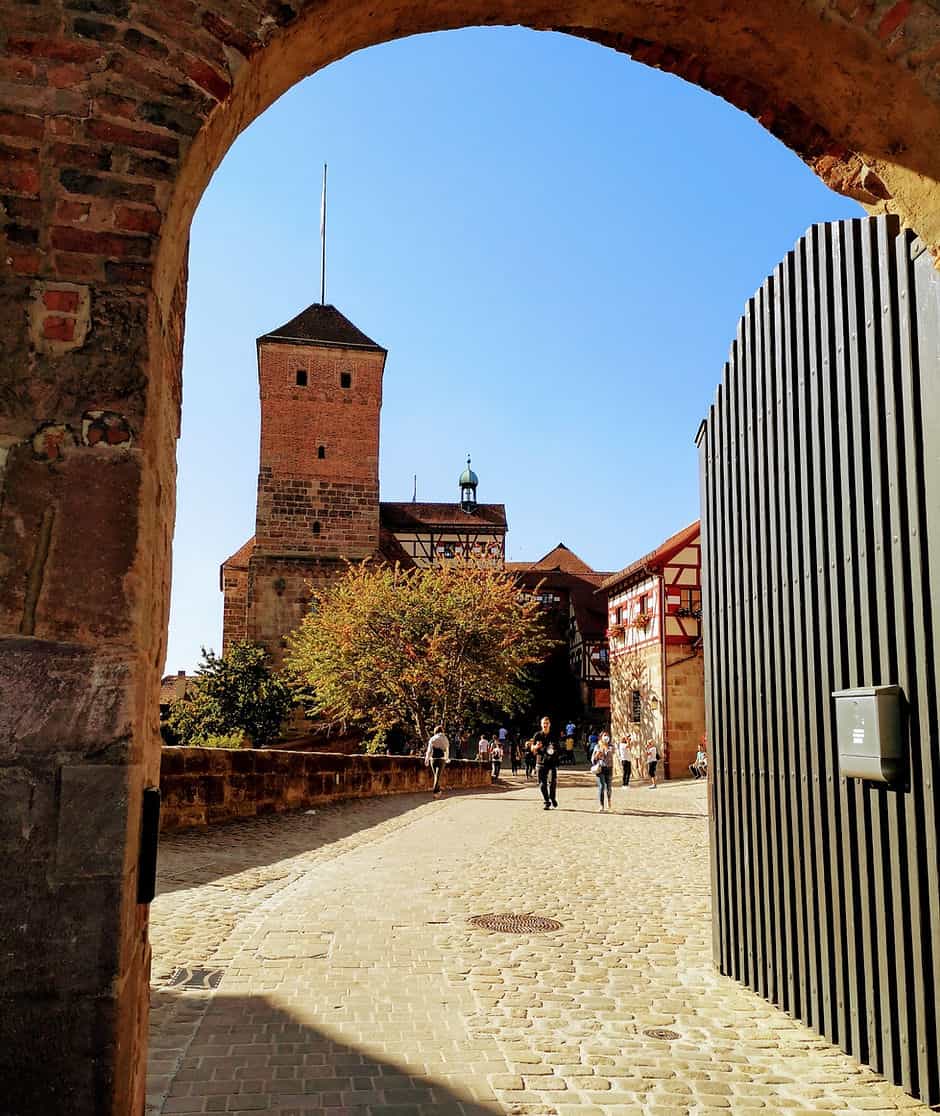
This post may contain affiliate links. I receive a small commission if you use these links, with no extra cost to you.
Visiting Bavaria in Germany, but not sure where to go? Nuremberg, in Northern Bavaria is a great choice! Here’s 8 great things to see and do in Nuremberg for the perfect day trip – and bonus – most of them are free!
1. Stroll along the river Pegnitz in the centre of Nuremberg 2. Visit the Henkerhaus Museum 3. Visit the Kaiserberg (Imperial Castle of Nuremberg) 4. See the Tiergartnertor 5. Visit the gothic house of Albrecht Dürer 6. Wander down Nuremberg’s prettiest street 7. Visit Nuremberg’s Hauptmarkt 8. Pick up a traditional Bavarian souvenir in Handwerkerhof
How to get to Nuremberg, Bavaria, Germany
Bavaria is one of Germany’s most beautiful regions, alongside the Black Forest and Romantic Rhine Valley . Nuremberg is located in the north of Bavaria, in the region of Franconia and is Bavaria’s second-largest city (behind the state’s capital, Munich). Sadly, a large part of Nuremberg was destroyed in World War II and it later became known for holding the Nuremberg trials – a series of 13 trials held after the war to bring Nazi war criminals to justice.
The city was rebuilt following the war, paving the way for more modern structures, however, there are still parts of the old town (Aldstadt) and the old city walls that remain intact.
Despite the city’s modern additions, the old town has managed to retain its charm, making Nuremberg a great place to spend the day sightseeing, and one of Northern Bavaria’s must-see cities. If you’re spending the day in Nuremberg, here are my top 8 things to add to your itinerary.
Top 8 things to do in Nuremberg, Bavaria
1. stroll along the river pegnitz in the centre of nuremberg.
The old town straddles the river Pegnitz and a stroll alongside the river is an idyllic way to start your day sightseeing in Nuremberg. You will cross over the Maxbrücke bridge – a traditional timber bridge framed by half-timber houses and a medieval tower. It’s one of Nuremberg’s prettiest bridges and makes for the perfect photo spot!
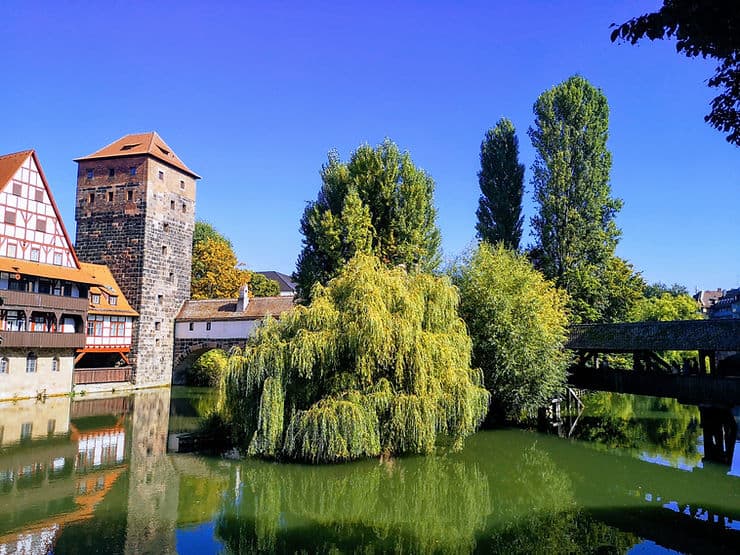
2. Visit the Henkerhaus Museum
On the river Pegnitz, you’ll also find the Henkerhaus Museum . One of Nuremberg’s more unusual attractions, the small museum is housed in the old residence of Nuremberg’s official executioner. Inside you can learn about his life through the diaries he kept on each of the 361 criminals he executed!
3. Visit the Kaiserberg (Imperial Castle of Nuremberg)
Visiting Nuremberg’s castle is one of the best things to do in Nuremberg. There is a small entrance fee to visit inside the castle and museum, however, you can actually see a great deal of this impressive 11th-century castle for free by wandering around the grounds and gardens. From the terrace that wraps around the castle’s entrance, you can also get sweeping views across Nuremberg’s old town and the surrounding city.
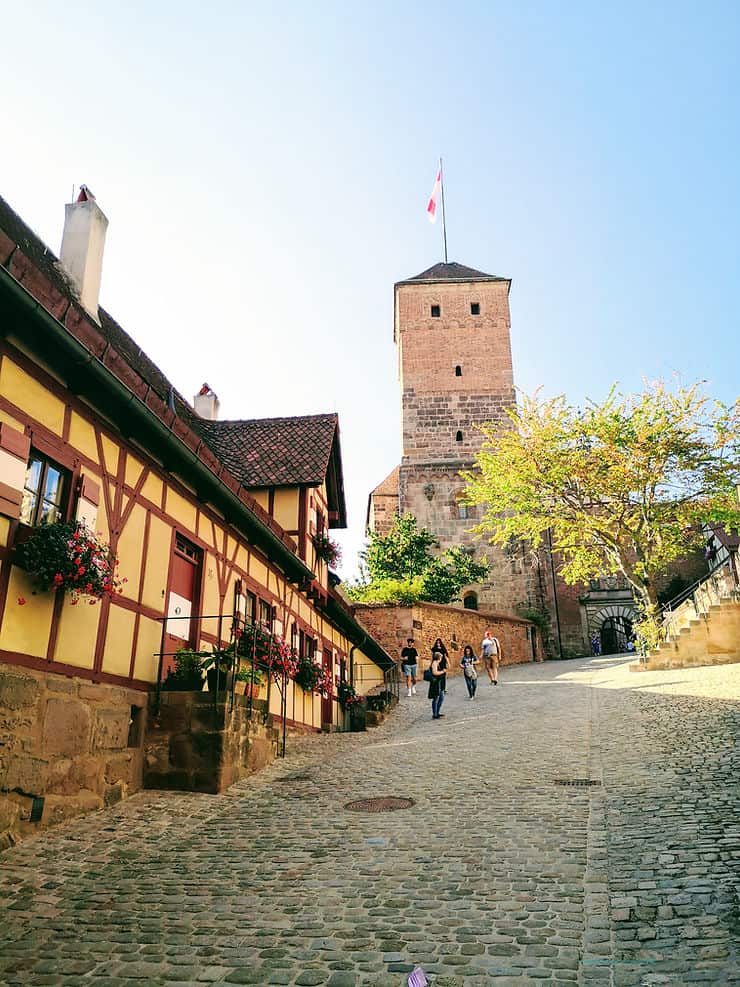
4. See the Tiergartnertor
The Tiergartnertor is a 13th-century gate and defensive tower in the old city walls, located by Nuremberg’s castle. Make sure that you walk through the tunnel under the gate to see how thick the defensive stone wall was! Part of the Tiergartnertor gate is open to visitors, overlooking the old town. There’s also a couple of bars in the small square in front of the Tiergartnertor, creating a really nice, lively atmosphere. Almost 4km of the old city wall and several of its towers still remain standing, so after seeing the Tiergartnertor, why not check out the rest of the medieval wall.
If you are the type of person that loves to explore secret passages and hidden rooms, check out this guided tour, which takes you through the defensive hidden corridors inside Nuremberg’s city walls!
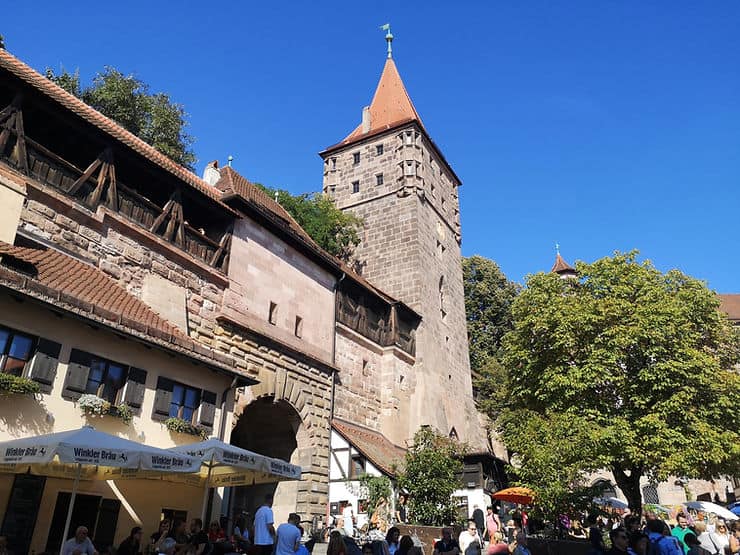
5. Visit the gothic house of Albrecht Dürer
Sat opposite the Tiergartnertor, in Nuremberg’s old town, you will find the house of famous German artist, Albrecht Dürer . The house, which now acts as a museum and art gallery, is one of the few undestroyed gothic houses from pre-war Nuremberg and is notable for being the last remaining example of a 16th-century artist’s house in Europe.
If you want to learn more about the history of Nuremberg as you are wandering around, there are many guided walking tours of the Old Town, and also a hop on hop off bus, which is a great way to see the highlights if you are short on time.
6. Wander down Nuremberg’s prettiest street
Weissgerbergasse is one of Nuremberg’s prettiest and most photogenic streets. Historic colourful, half-timber houses sit on either side of the cobbled street, which now has the addition of a couple of cafes now too.
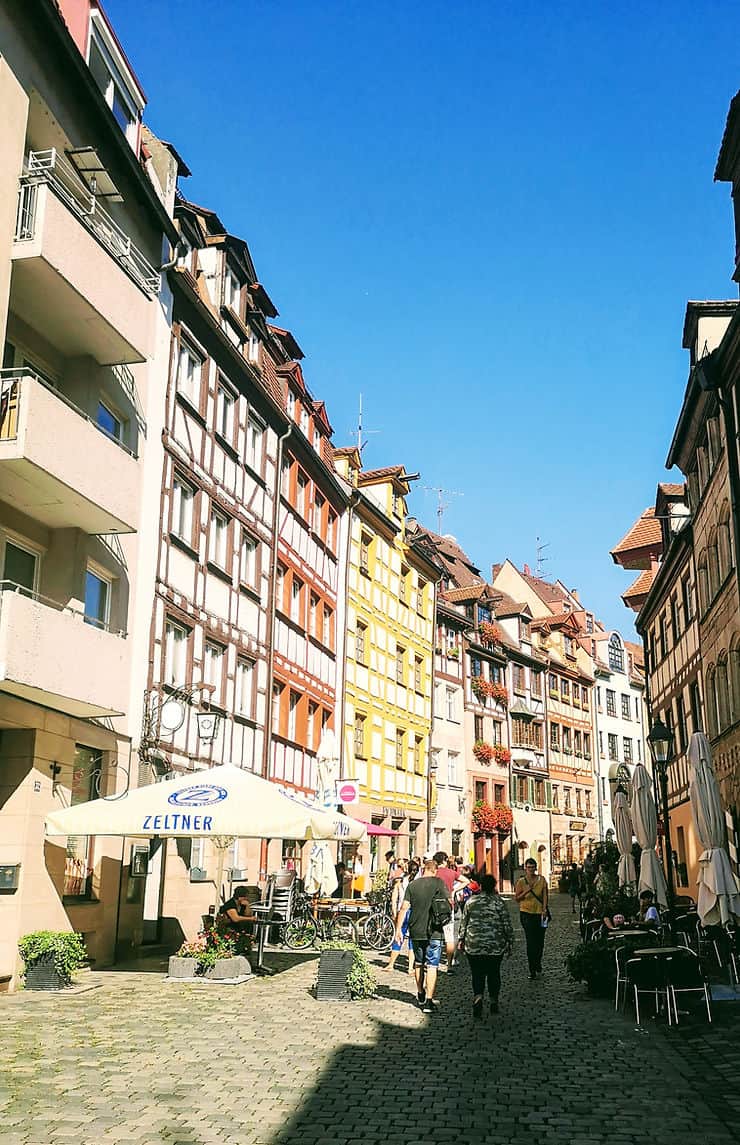
Tip: If you want to see more beautiful streets like this, make sure that you visit the charming town of Rothenburg ob der Taub er.
7. Visit Nuremberg’s Hauptmarkt
In the centre of Nuremberg’s old town, the Hauptmarkrt is a large open-air market where you’ll find vendors selling all kinds of local produce, sweet and savoury snack stalls, and crafts. Whilst you’re here, don’t miss the Schoner Brunnen – an ornate, gothic fountain and the Frauenkirche – a 14th-century gothic church housing historic artwork.
8. Pick up a traditional Bavarian souvenir in Handwerkerhof
Handwerkerhof is a small purpose-built, medieval-style Bavarian village. Shops occupy half-timber houses, showcasing local crafts, gifts, and produce whilst traditional rustic pubs serve local beer and tasty treats. If you want to get a feel for how Nuremberg was in the past, then this is a great attraction.
There you have it, my top 8 things to do in Nuremberg, Bavaria. There are many beautiful towns and cities in Bavaria and because of this, Nuremberg often gets overlooked in favour of some of its smaller, quainter neighbours, such as Bamberg and Rothenburg ob der Tauber. However Nuremberg is a great choice for a day out, there’s so much to see and do here, and much of it for free!
As you might expect for a large city, Nuremberg is really well connected . There are 3 main ways to get to Nuremberg: by plane, train or car
P lane – You can fly into Nuremberg airport, which is less than 5km from the main city centre.
Train – Nuremberg is an important transit hub for trains around Germany, therefore trains from all over the country arrive and depart frequently from Nuremberg’s train station
Car – Arriving into Nuremberg by car is easy. There are many car parks located on the outskirts of the old town, so you can park up and explore for the full day
Getting around – Getting around Nuremberg is best done on foot. The old town is full of small streets and pedestrianised roads and you’ll see so much more by walking round and exploring at your own pace.
Pin this post for later!
Related Posts
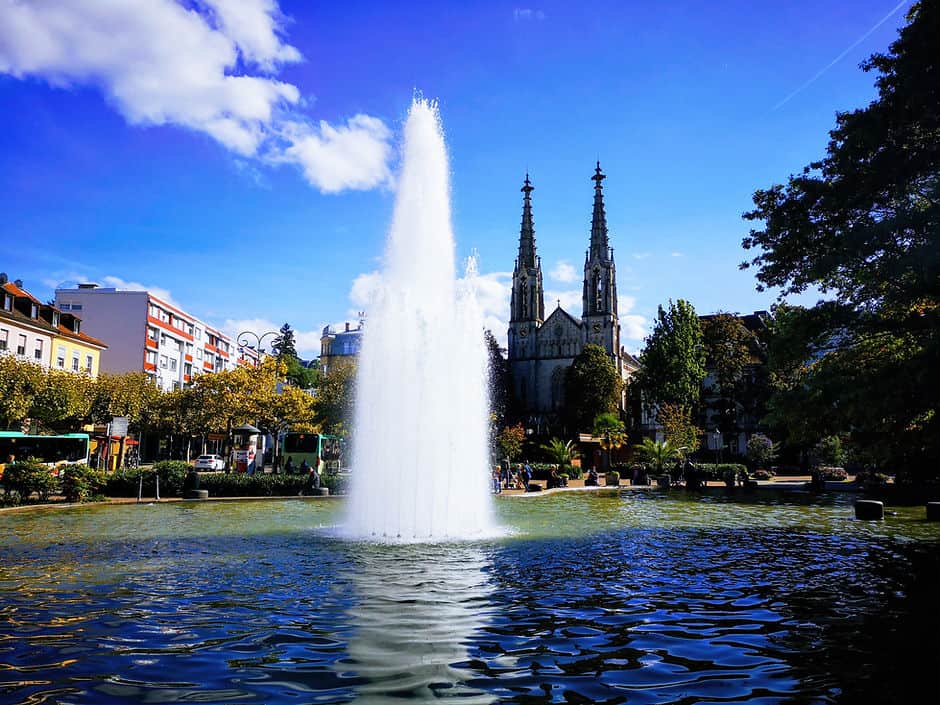
10 Great things to do in beautiful Baden-Baden, Germany
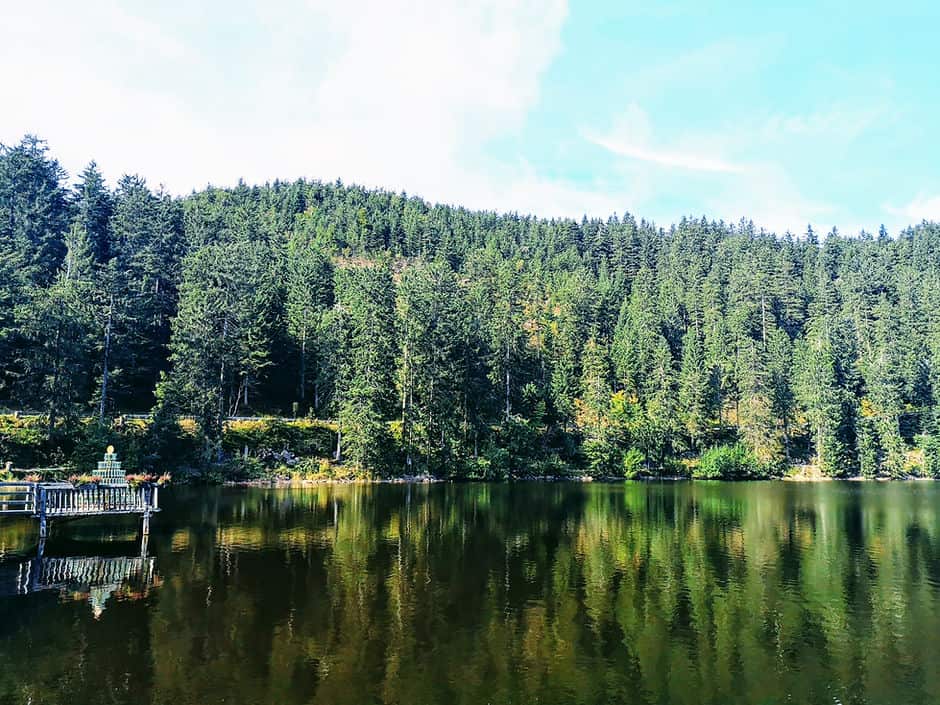
10 Amazing things to see and do in the Black Forest, Germany
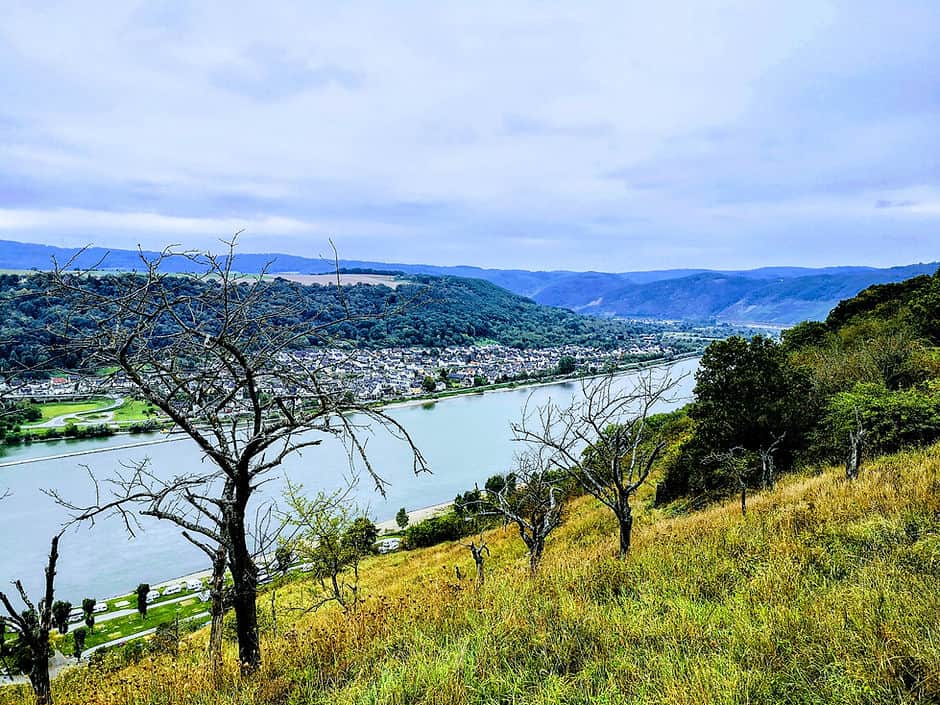
6 great hiking trails in the Romantic Rhine Valley, Germany

11 Awesome Things to Do in Nuremberg
As with many of the small villages located in Germany and on the Romantic Road, people tend to spend more time passing through them then they do enjoy them.
There is a lot to be said for the experience you can have if you just allow yourself to stay overnight in some of these places.
Not only will you get good photography opportunities when the tour buses leave for the day, but you’ll get a chance to see the real magic on offer. Not to mention there are a surprising number of things to do in Nuremberg.
Without really thinking twice, we made the decision to spend 2 days in Nuremberg before we even left America. I have always wanted to visit this Bavarian city and making this decision wasn’t a hard one.
It wasn’t until we arrived that we learned most people just make quick day stops and then move out of the city before dinnertime.
Don’t leave home without: Lonely Planet Germany (Travel Guide)
Believe me, I know what it is like to only have a few days of vacation to work with and the ultimate desire to use them to the fullest by visiting as many places as possible during your vacation.
I used to live that life, but let me tell you something; you’re missing the point people. If you just blow through a place, what about it do you take with you? Is there anything other than the proverbial checkmark on the list and the series of poorly taken photos you’ll never look at again?
With all the might I can muster and pass-through this keyboard to you, leave room in your German vacation for the time to see the places you visit. Spend at least 2 days in Nuremberg and any other small village on our route.
If you don’t, you’ll miss out on the magic. Besides, don’t you want to know more about the man that invented the selfie?
Read reviews and check prices with our Hotel Search Engine , that gives you the best hotel deals found on the web. Our search engine pulls results from all of the major booking places, including Expedia, Hotels, Booking and more. All the options, all the deals, all in one place and just for you.
Things to Do in Nuremberg
Table of Contents
Meet Albrect Dürer
One of the most famous painters in art history, I am personally convinced that Albrecht Dürer invented the selfie. Born in 1471, he would become a risk-taker in his perception of art and be one of the first artists to paint a self-portrait to be used as part of his portfolio.
He painted himself in both the traditional pose of slightly tilted side profile and with a new style, from straight on.
Nobody was doing this to build a portfolio and he was applauded for the forward-thinking and earned many jobs from the tactic. The straight-on portraits, however, never took off among his clients as they thought it was too obtrusive.
Make sure you leave time on your visit to tour his house and see some of his magnificent paintings. You’ll also learn more about his life and a strong influence on the art world. This is one of the more interesting things to do in Nuremberg.
Underground Beer Cellar Tour
If you buzz out of town without spending a night, you won’t have a chance to head underground at the Altstadthof Brewery for a guided tour of their historic rock-cut cellars.
I think it is safe to say that for the amount of space above ground in Nuremberg, the equal exists just below it in traditional beer storage. This proved handy during WWII when the city was bombed to nothing.
If the underground cellars hadn’t existed, most of the people would have lost their lives. Instead, they used the cellars as a way to escape from the city.
The tour runs at 5 pm from the brewery shop and is free if you have a Nuremberg card. While the tour runs only in German, they do provide headsets in English to listen to on the tour and in our experience; the guide spoke English as well.
Nuremberg Castle Without the Crowds
The centerpiece of tourism in Nuremberg, the castle sits on the tallest part of the city and looks down over all that is below.
Never a formally occupied residence, it was used by the royalty during their tours through Bavaria. Living in the castle was always temporary and it says empty when they were not there.
It was mostly destroyed during the bombing in WWII, but has been mostly restored and now houses a beautiful museum.
For some great views, you can also climb the Sinwell tower and when you’ve finished that gaze into the depths of the Deep Well. The entrance is free with the Nuremberg Card.
Exclusive Tower Tour of St Sebald Cathedral
This is by far the best thing we did in Nuremberg and we couldn’t have done it if we hadn’t stayed overnight. The towers in this church are not open to the public like most towers in Europe; instead, they run a private, ticketed tour to the top in the evening, only twice a week.
Seriously, this is the best-kept secret in Nuremberg. We showed up 10 minutes before 5 pm, bought our tickets for €5, met the two other people in our group and headed into the heights of the church.
The tour lasted 1.5 hours and was spectacular. We had tours of each level all the way to the top and ended with free time on the tower to photograph the city. At the time of our visit, the Tower Tour was only being run on Wednesday and Saturday at 5 pm.
Entertaining Guided City Tour
There is nothing worse than a dry tour. Perhaps you’ve been on one and cracked a smile when I said that, well I can admit we sure have. Never fear!
The Nuremberg guided city tour, ran by the Nuremberg Tourism board, is not only thorough but also very entertaining.
Our guide gave us insight into the lives of the people, not just regurgitated encyclopedia information. We learned what it was like to live in Nuremberg at the height of its popularity, the tales of lore and of course, the sprinkle of history along the way. The English speaking tours run at 1 pm daily and last approximately 2 hours.
Indulge in Fine Bavarian Food & Beer
A trip to Bavaria wouldn’t be complete without a stop for beer and brats and Nuremberg is no exception. Often overlooked by day-trippers, Nuremberg has some really fine Franconian and Bavarian dining options. We can recommend the following without pause.
Alstadthof Restaurant
If you are looking for a chance to sample the Alstadthof breweries famous red beer accompanied by traditional Franconian food, then look no further. This is one of the best meals we had in Germany and the red beer lived right up to its hype.
Bratwurthausle
This place serves the traditional sized Bratwursts of Nuremberg. Not bigger in diameter than your ring finger, these little sausages were made specifically to fit through keyholes.
In the early days, when your family was locked up for a crime, it was your problem to make sure they were fed. You weren’t allowed to open the doors, so they made the sausages small enough to fit through the keyhole. The tradition stuck and you can now indulge in these little sausage wonders on your next stop in Nuremberg.
Nuremberg Travel Tips
Nuremberg card.
For those of you that wish to spend at least 2 nights in the city (which we HIGHLY recommend), it is worth investing in a Nuremberg Card.
This little beauty will give you free access to the best sites in the city plus free use of all the public transportation. They are valid for 2 full days from the time of first use.
Accommodation
There is no shortage of great places to rest your head in this Bavarian village, however, we can recommend from experience, the Hotel Elch .
It is a very short walk from the old city center and 2 blocks from a parking ramp, which is very convenient if you have a rental car. The rooms are clean, modern, spacious and they serve a fabulous buffet breakfast to get your day started.
Other great hotels in the Nuremberg area are Hotel Drei Raben , Hotel FIVE , and Hotel Victoria .
Visiting Nuremberg on a Road Trip
Nuremberg was one of our stops while road tripping through Germany with Discover Car Hire . We arranged our car rental for pickup in Munich and traveled through Bavaria before heading north to finish in Berlin.
Renting a car is the best way to see the real Germany and allow yourself the chance to experience places like Nuremberg after all the day trip buses have left for the day.
Need to book a car for your road trip adventure? We use Discover Car Hire for comparing car prices to find the best deal. They search both local & international rental companies.
Want to visit Nuremberg Germany but don’t have a Car
Do not miss out on one of the best towns in Germany. Do you want to visit Nuremberg Germany but you do not have a car. No worries, we have found a way for you to discover Nuremberg Germany. You can discover Nuremberg from Munich and Frankfurt, Germany.
- Nuremberg Day Trip from Munich: Discover beautiful Nuremberg — site of Hitler’s infamous propaganda rallies — on a 10-hour rail tour from Munich. Relax on the comfortable train ride to Nuremberg, take a guided tour of city attractions like Congress Hall and medieval old town, then enjoy some free time to make an optional visit to the Documentation Center.
- Heidelberg and Nuremberg Tour from Frankfurt: Visit the cities of Heidelberg and Nuremberg on this guided, full-day sightseeing adventure from Frankfurt. First, explore Heidelberg, Germany’s oldest and most famous university town. See the Gothic landmark Heidelberg Castle and the bustling Old Town district that runs for one mile along the Neckar River. Then visit the medieval city of Nuremberg.
- Munich and Nuremberg Day Trip from Frankfurt: Explore two of Bavaria’s beautiful cities in one day on this Munich and Nuremberg day trip from Frankfurt. Explore Munich by double-decker bus and discover top attractions including the Cathedral of Our Blessed Lady and the Old Town Hall. Admire Nymphenburg Palace’s Baroque architecture and sightsee at your leisure. In Nuremberg, take a walking tour through the Old Town and Castle Quarter, where half-timbered houses tell of a bygone era.
- Nuremberg and Rothenburg Day Trip from Frankfurt: Visit the cities of Nuremberg and Rothenburg on this guided, full-day sightseeing adventure from Frankfurt. Combine two best-selling tours at one discounted price. First, explore the medieval city of Nuremberg. Learn about its history — from the days of the Holy Roman Empire to the German Renaissance, Third Reich, Nazi rallies and Nuremberg Trials — and see many of its popular attractions. Then visit the picturesque town of Rothenburg ob der Tauber.
More on Germany:
- Ultimate Germany Road Trip Guide
- 30 Germany Photos That Will Spark Your Wanderlust
- 4 Days in Munich Itinerary-Things to do in Munich
- Germany Travel Guide
- Germany’s Romantic Road: The Only Guide You Need
- 12 Best Photo Spots in Berlin Germany
- Camping in Berlin with Huettenpalast
- Travel Insurance for Europe Vacation & Do I Need It?
- Ultimate Guide to Eurail Pass Train Travel in Europe
- When is the Best Time to Visit Europe?
- 20 Simply Unreal Castles in Germany to Visit
- 10 Best Day Trips from Munich Worth Doing
- How to Visit Neuschwanstein Castle from Munich
- Elegant Elbe River Cruise with Viking River Cruises
- Viking River Cruises in Europe-What to Expect
- Highlights from 3 Days in Hamburg
Did you like this story? Share it!
Travel planning resources, about lina stock.
Lina is an award-winning photographer and writer that has been exploring the world since 2001. She has traveled to 100 countries on all 7 continents. Member: SATW, NATJA, ATTA, ITWA
7 thoughts on “11 Awesome Things to Do in Nuremberg”
Can you provide more info on the Exclusive Roof Top Tour of St Sebald Cathedral? You haven’t included details on what day they offer tours, or for what time. I’m not finding any info online about it.
Hi Kaitlyn, they only offer the tower tours twice per week on Wednesday & Saturday at 5pm, when we visited. You can find information about the church on the tourism board website for the city of Nuremberg. If you are planning to visit Nuremberg and have your heart set on doing this, I would strongly advise you to email the contact listed to get current information on the running of the Tower Tour.
This is a fantastic article! I was looking to do a short stop on my way to Munich and this will provide just that, this is really comprehensive and has helped me make my decision, thanks again and happy travels 🙂
SO glad to hear this!!! So many people miss the real beauty of Nuremberg by shooting through on a day trip. It deserves more time and the experience will be so much better for you this way. Enjoy, we loved this city.
Beautiful city, i would love to visit there soon.
I was there last years, it’s a beautiful city!
It really is! We loved our visit to Nuremburg.
Leave a Comment Cancel reply


12 Best Places To Visit In Germany With Family In 2024!
T hinking about visiting Germany with your kids? Looking for the best places to visit in Germany with family in 2024? You’re in the right place!
Germany is a fabulous destination for families. It’s renowned for its rich history, gorgeous landscapes and interesting culture. Its fairy-tale old towns and castles add some magic and its big cities add some vibrancy. All up, Germany is a captivating blend of historical charm and modern appeal.
From landmarks such as the Berlin Wall and Neuschwanstein Castle to the beautiful landscapes of the Rhine Valley and the Black Forest to the great food and ease of getting around, there’s so much to love about traveling in Germany.
Germany isn’t just for adults though. There are many fantastic places to visit in Germany with kids. In this guide, I’ll walk you through the best choices to add to your itinerary.
Why Is A Family Vacation In Germany A Great Idea?
Where to stay in berlin for families, where to stay in nuremberg for families, where to stay in rothenburg for families, where to stay in the rhine valley for families, where to stay in trier for families, where to stay in heidelberg for families, where to stay in europa park for families, where to stay in the black forest for families, where to stay near autostadt for families, where to stay in bremen for families, where to stay in lübeck for families, christmas markets.
Germany is an incredible destination for families for the reasons I mentioned above as well as many others. The fairy-tale castles are sure to capture your kids’ imagination.
A trip to the Berlin Wall can be a great accessible educational opportunity. A walk on cobblestoned streets through a colorful old town will take your kids right back to fairy-tale classics. Families are welcome almost everywhere.
There are, of course, many attractions in Germany for kids. From huge theme parks to children’s museums and fun markets, trains and more, there is a lot to love about traveling to Germany with kids.
The efficient train system and great road network also make it easy to get around and to explore as much of Germany as you like. There’s a great range of accommodation, including many hotels that specifically created for families.
The food can also be quite kid-friendly. It’s easy to enjoy a pretzel or a bratwurst (sausage) almost anywhere which is likely to appeal to even fussy eaters.
All up, it’s a very easy place for a family vacation that your kids won’t forget.
Best Places To Visit In Germany With Family
Here are my top 12 picks of the best places to visit in Germany with kids…
The capital of Germany, Berlin offers a fantastic blend of historical and family-friendly attractions. The Brandenburg Gate and the Berlin Wall are must visits for all and a great learning opportunity for kids.
The DDR Museum is a hands-on way for your family to learn about life in the German Democratic Republic (East Germany). Berlin is a city with a super interesting past, and there’s no better way for your kids to learn and understand it than in the city itself.
For more family focused attractions in Berlin , the Berlin Zoo is a great place to head with a wide variety of animals. The interactive Legoland Discovery Center is also a favorite among children. Head to the German Spy Museum for lots of fun spy activities, like dressing up and debugging a room.
To let off some steam, make sure you head to Tiergarten. This huge park has plenty of space to roam with historical monuments, six playgrounds and row boats. It’s also home to the zoo.
I recommend The Circus Apartments in a handy spot in Berlin. They have a variety of apartment options including two and three bedroom, fully self-contained apartments for up to six people.
Click here for more details and the latest prices.
Nuremberg is our pick of the best city to visit in Germany with family. It’s an easy city to explore with a great range of attractions that are easily accessible for families.
The Old Town is the natural place to start with super colorful houses and the Kaiserburg (Imperial Castle) keeping watch from above. You can also explore the city from underground and see how Nuremberg’s art collections were kept safe during World War II. You can find the Spielzeugmuseum (Toy Museum) in the Old Town with toys from various time periods.
Just outside the Old Town, the Deutsche Bahn Museum is a must visit. It centers on the history of the German Railways with old carriages, videos and more. What kids will really love is the model railway, the chance to take a light railway ride and the interactive play area specifically for kids.
If you have younger kids (10 and under), don’t miss a day out at the Playmobil FunPark. This amusement park with Playmobil theming was one of my 6 and 10 year olds’ favorite places in Germany. There are great playgrounds, pedal boats, water play area, castle area, go karts and more. It’s located just outside of Nuremberg.
You can read more about things to do in Nuremberg here.
We stayed at the Novotel Nuernberg Centre Ville which was perfect for our family. It’s on the edge of the Old Town by the main station and has family rooms. There’s also a great indoor pool, children’s playroom, restaurants and more.
Rothenburg ob der Tauber
Home to maybe the most photographed old town in Germany, Rothenburg Ob Der Tauber (or just Rothenburg) is a picturesque medieval gem, perfect for exploring with kids.
It’s only a small town, but this is part of its charm. Its colorful buildings, cobblestoned streets and well-preserved town walls will help you feel like you’ve gone back in time.
The town walls are the perfect place to start exploring. They offer many pretty views, and there are information boards along the way to learn more. It’s a great way for kids to let off some steam while discovering Rothenburg. There are also some playgrounds around the walls.
Another place families will enjoy is the Christmas Museum. It’s located in the Käthe Wohlfahrt Weihnachtsdorf which is a popular chain of Christmas stores that open year round. It’s about the history of Christmas customs with many decorations on display.
A popular place to visit in Rothenburg is the Mittelalterliches Kriminalmuseum (Medieval Crime Museum). It’s located in a building which is 600 years old and covers over 1,000 years of the legal history of Germany and Europe. It focuses on interrogation (torture), crime and punishment.
This museum is for families with teenagers who have an interest – and it is a fascinating museum. I visited without my 6 year old, which was the right choice.
We stayed at the Pension das Lädle which is in the heart of Rothenburg’s Old Town. It has three and four person rooms with separate sleeping areas for kids.
Rhine Valley
The Rhine Valley may be best known for its wines but it’s also a fabulous place to travel to Germany with children. With gorgeous towns, stunning wineries and fairy-tale castles, the whole family will love a trip here.
Start your adventure with a relaxing cruise down the Rhine trying to spot the castles that dot it before driving around and visiting your favorites. Rheinstein Castle is a picturesque place to start or visit Schönburg Castle with its amazing views and slingshot simulator your kids will enjoy.
Of course, you can’t miss out on stopping in the beautiful towns. Bacharach may be the cutest with a town wall to explore, a pretty Old Town and wines to taste. Boppard is another town worth heading to with half-timbered houses, old wine taverns and a Roman fort.
There’s also a fun chairlift in Boppard with great views and nice walks at the top. You can take an easy stroll to Vierseenblick (Four Lakes View). This cool viewpoint is at a horseshoe bend in the Rhine River and gives the illusion that there are four lakes instead of one river.
We stayed at the Rhine Pearl Hideaways which is a building of apartments in the middle of Oberwesel, a picturesque town in the middle of the Rhine Valley. The apartments are modern and perfect for families.
Trier is not just the oldest city in Germany and home to nine UNESCO World Heritage sites but is also a great destination in Germany for children.
Located near the border of Luxembourg and not far from the Rhine Valley, Trier has had human settlement for over 6,000 years. It was an important place in Roman times and you can still see ruins from this time today. These ruins are fun to explore with kids and are great for capturing the imagination.
Start your adventure at Porta Nigra, a second century Roman city gate. It’s the best way to enter the Old Town and is massive. In the Old Town there are pretty streets, Hauptmarkt (the main square), many churches, an antique toy museum and more. Trier Cathedral still has parts from Roman times.
As you head further south, there are more Roman ruins from thermal baths to an amphitheatre. It is worth checking them all out.
For a more hands-on experience, you can also visit Freilichtmuseum Roscheiderhof, an open air museum, about eight kilometers from Trier.
We stayed at Ibis Styles Trier which is right in the center of everything. There are family room options.
Beautiful Heidelberg is definitely one of the places to visit in Germany with children. With its great setting by the Neckar River and surrounded by hills, there are plenty of places for kids to explore and roam.
Heidelberg’s famous ruined castle is a great place to start. You can either walk up here or get a fun cogwheel train up. In addition to exploring the castle area, you can visit the Deutsches Apotheken-Museum (German Pharmacy Museum) inside the castle which covers the history of medical science and pharmacies in Germany. It’s interesting even for young kids with old reconstructed pharmacies, labs and interactive games.
After the castle, consider taking the cogwheel train further up the hill to visit the Walderlebnispfad (Forest Adventure Trail). This is an easy 2 kilometer trail with many activities to do along the way aimed at children. There is also a small, older-style amusement park up there.
Our favorite thing to do in Heidelberg was to head up the opposite hill to explore Heiligenberg, where settlement first started in this area. There are great paths through the forest where you can feel like you are discovering Celtic and Roman ruins, old monasteries and Thingstätte, an amphitheater completed in 1935 by the Nazis to spread propaganda.
We stayed at the Heidelberg Apheartments in the heart of Heidelberg. They offer fully self-contained apartments for up to eight people.
Find more great hotels in Heidelberg here.
Europa-Park – Rust
When you travel to Germany with kids, this theme park is likely to be their favorite place in the country.
Considered one of the best in Europe, Europa Park is massive with 18 themed areas, over 100 attractions, 13 roller coasters, many live shows and so much more. Think Disneyland but with European theming. Most of the themed areas are based on different countries in Europe. There is also a separate water park here called Rulantica.
Even visiting in peak August, we had so much fun here. The kids absolutely loved the more family-friendly roller coasters, getting wet on the splash rides and watching horse shows. The park’s VirtualLine feature in the app helped to ensure we never lined up for too long and had a great time.
There are many places to eat, stay and more and this is a great way to end a family vacation in Germany. It’s located near the French border between Heidelberg and the Black Forest.
One of the many great things about Europa Park is that there are six hotels adjacent to the park and in the immediate area each with their own theming. If you stay at any of the hotels, you can access the many facilities at all of them and you also get early access to the park.
We stayed at Hotel Castillo Alcazar which was a lot of fun. It has its own entrance directly into the theme park and is themed as a Medieval knight’s castle. There are many family room options, even for larger families.
Black Forest
The Black Forest is definitely a fantastic region to head to when visiting Germany with kids. It’s incredibly scenic with beautiful villages and plenty of opportunities to explore the great outdoors.
We loved hiking round lakes, swimming outdoors, exploring the towns and visiting picturesque castles like Hohenzollern Castle. You can visit the home of cuckoo clocks in Triberg or peddle your way around Titisee lake on a boat. You can bathe in the thermal pools at Baden-Baden or explore the picturesque Old Town in Freiburg .
Kids will love Badeparadies Schwarzwald Titisee, a big indoor waterpark with an amazing sauna complex for adults. And, of course, no visit is complete without a slice of the famous black forest cake (although technically it doesn’t come from here).
There are so many awesome experiences in the Black Forest for families that you could spend your whole trip in this region alone.
We stayed at the Feldberger Hof Family Hotel in the Black Forest. It’s an all inclusive resort specifically for families and it’s amazing. There are so many family friendly facilities (including an outdoor ropes course, horse riding and indoor pool area with water slides), activities, rooms and great food.
The hotel also includes an attractions pass for the region which gives free or discounted entry to 60 attractions plus public transport.
Autostadt Wolfsburg
Autostadt Wolfsburg is an automobile museum and theme park located in Wolfsburg, Germany. It tells the story of the history and development of automobiles, but also has attractions and activities related to automotive culture. This isn’t a big, dry museum.
Spread over 28 hectares, there are multiple museums, massive car towers, playgrounds, giant slides and various car pavilions. One of the coolest parts is definitely the round, glass, 60 meter towers that store Volkswagen cars ready to be delivered to new homes. It’s fully automated with cars being placed and removed from the tower with ease. You can take a ride up the towers yourself for an up close look.
This place is a whole world with plenty of cars and history to explore. Adults can test drive real vehicles while kids can learn to drive in some very cool miniature ones. There are many interactive exhibits. It’s easy to enjoy a half day here.
For families, there are also some playgrounds including some huge slides up to 18.5 meters high. There’s a cool shop and plenty of eating options too.
For the full Autostadt experience, it is possible to stay on-site. The Ritz-Carlton Wolfsburg Autostadt hotel is located here.
There’s a pool, sauna, two restaurants (Including a three Michelin star option) and a lounge. Rooms cater for up to four people.
If you’re heading to northern Germany, Bremen is a great place to stop for families. At the end of the Fairy Tale Route, Bremen celebrates the Brothers Grimm’s fairy tale, the Bremen Town Musicians with a statue of the donkey, dog, cat and rooster from the tale in the main square.
There are also images and statues around town of these creatures and it’s fun to have the kids look out for them. If you aren’t familiar with this story, I recommend that you watch it on YouTube before you go.
The Old Town is fun to explore for all ages with a great main square, the stunning Bremen Cathedral and the laneways of Schnoor and Böttcherstraße. It’s easy to explore by foot.
The Universum Science Centre is a standout attraction if you visit Germany with kids. It has interactive and educational exhibits which kids will enjoy.
For a thought-provoking historical site, visit the Bunker Valentin. It’s an absolutely massive World War II submarine factory that has been left standing to illustrate the futility of war.
We stayed at the Best Western Bremen City . It has some great apartment style rooms for families within walking distance of the main attractions.
Also in northern Germany, Lübeck is a charming city home to a picturesque, UNESCO World Heritage listed Old Town. It is a good mix of historical and kid-friendly attractions.
The best place to start is with a wander through the well-restored Old Town. Encircled by the Trave River, there are many great views, churches, museums and more. A feature of this Old Town are the hidden courtyards. These are courtyards from the Middle Ages accessed via small walkways from the street. We made it a family game to try to spot as many as possible.
The world-class European Hansemuseum is worth visiting and an easy way to learn more about the Hanseatic League which played a big part in Lübeck’s past.
Lübeck is famous for its marzipan so a sugary treat at Cafe Niederegger is the perfect way to end a day of sightseeing. When you have finished exploring Lübeck, consider a trip to Travemünde on the Baltic Sea. Just 20 minutes from Lübeck, it’s the perfect place to have some beach time. It also has a pretty Old Town.
We stayed at Hotel Die Reederin . It’s a gorgeous boutique hotel in Lübeck’s Old Town. It offers a spacious family room option.
My final place to visit in Germany with kids is a special one if you are visiting in late November or December. I recommend you visit as many Christmas markets as you can if you visit at this time of year.
German Christmas Markets are incredibly magical and special. From the traditional food and drinks to the Christmas music and lights, they set the scene for a perfect Christmas.
Many Christmas markets and destinations in Germany have special events perfect for families at this time of year. For example, Quedlinburg has the “largest Advent calendar in Germany”. At 4:30pm every day in the lead up to Christmas, families meet up and search together for one of 24 houses with special Christmas decorations that are open to the public. Inside, there are surprises.
Nuremberg Christmas Market has a special section for kids with old-fashioned rides, crafts and activities. For novelty, head to Cologne for a floating Christmas market on a ship. Munich has a Kinderland section at one of its Christmas markets with special activities and a Christmas Post Office. In Hamburg, you can watch Santa fly overhead in his sleigh!
Christmas is a truly special time in Germany for the whole family so make sure you include plenty of Christmas markets in your itinerary at this time.
Final Thoughts
Germany is a fantastic place to visit for families. There is so much to enjoy here from the great outdoors to the interesting history that surrounds you.
There are plenty of kid-focused attractions, but it’s also easy to visit interesting historical and cultural attractions in a way that is interesting for kids too.
I hope this list helps you have one of your best family vacations in Germany.
Bio: Sharon Gourlay is a full-time blogger and mum of three who loves sharing her love of travel with kids with others, especially when it comes to sharing one of her favorite destinations, Germany! You can find more information to plan your ultimate adventure in Germany at Germany Footsteps .
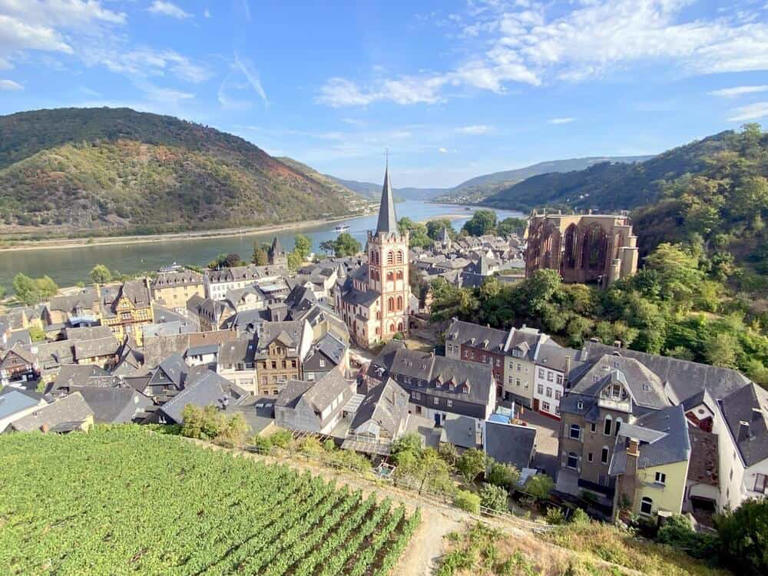

IMAGES
VIDEO
COMMENTS
Let's explore the best things to do in Nuremberg: 1. Kaiserburg. Source: tichr / Shutterstock.com. Kaiserburg. On the steep sandstone cliffs over the north side of Nuremberg's Altstadt is a castle that carried real power in the times of the Holy Roman Empire.
11. DB Museum (German Railway Museum) 679. Speciality Museums. Having opened its doors in 1882, the DB Museum is now the world's oldest museum devoted to the railways. Its main building is located in Nuremberg, and it also has two other branches - one in Koblenz and the other in Halle an der Saale.
The historic medieval city of Nuremberg (Nürnberg) is one of Germany's most important centers for arts and culture, and one of the country's most popular tourist destinations. ... be sure to read through our comprehensive list of the top attractions and things to do in Nuremberg. See also: Where to Stay in Nuremberg. On This Page: 1. Take a ...
10. Climb Nuremberg Castle & see the view. No Nuremberg travel guide would be complete without including Nuremberg Castle. Things to do at this royal residence dating back to 1050 include wandering the courtyard, visiting Castle Chapel, admiring the rose gardens, and exploring Sinwell Tower and the Deep Well.
Kaiserburg (Imperial Castle) Also referred to as Nuremberg Castle or the Imperial Castle, Kaiserburg is a big castle complex above the Old Town that should be one of your top Nuremberg places to visit. Always the heart of Nuremberg, this castle once was the centre of power in this region of the Holy Roman Empire.
For over three centuries the Nuremberg hangmen lived in the tower just beyond the bridge named for their iniquitous vocation. 7. Learn About Germanic Culture at the German National Museum. Visiting the German National Museum (Germanisches Nationalmuseum) is one of the best things to do in Nuremberg.
Top Things to Do in Nuremberg, Middle Franconia: See Tripadvisor's 149,989 traveller reviews and photos of 439 things to do when in Nuremberg. ... Europe. Germany. Bavaria. Franconia. Middle Franconia. Nuremberg. Nuremberg Attractions. Top Things to Do in Nuremberg, Germany. ... See what other travellers like to do, based on ratings and number ...
Address. Am Tiergarten 30, 90480 Nürnberg, Germany. Phone +49 911 54546. Web Visit website. Tiergarten Nürnberg (Nuremberg Zoo) is one of the largest zoos in Europe at nearly 70 hectares. Founded in 1912 and located in the Nuremberg Reichswald just east of the Altstadt, the zoo is in a former sandstone quarry.
8. Visit the Nuremberg Dockumentation Center. One of the standout highlights from my first trip to Nuremberg was a visit the to the city's Dokumentation Center, which houses a permanent exhibition that describes in eye-opening detail the atrocities that happened in Nuremberg and Germany during the Nazi regime.
6. Visit the Documentation Center Nazi Party Rally Grounds. Nuremberg has a darker 20th-century history. You may already know that the city played a prominent role in the rise of the Nazis and was the scene of the infamous Nuremberg Trials in the aftermath of World War II.
1. Nuremberg Castle - Imperial Castle of Nuremberg. One of the first things to do in Nuremberg is to make your way to Nuremberg Castle. The Imperial Castle is the symbol of Nuremberg and has been standing since the middle ages dating back to 1050. Nuremberg played a significant role in the Holy Roman Empire and the castle symbolizes that power.
Planning Your Trip. Best Time to Visit: For the best weather, come from May to September: The skies are fairly dry and the sun is out—the perfect weather for days spent wandering Nuremberg's picturesque Old Town and checking out the nature in the region. Language: German is, of course, the main language spoken here, and there are three main ...
Top Things to Do in Nuremberg, Germany. Places to Visit in Nuremberg. Explore popular experiences. See what other travellers like to do, based on ratings and number of bookings. See All. Walking Tours (49) City Tours (28) Historic Sites (42) Historical Tours (54)
Nuremberg is also a great, centrally located town for making a "home base" while traveling since there are almost endless day trips from Nuremberg Germany, especially if spending a lot of time in Bavaria (Here are 16 Reasons Why You Need to Visit Bavaria). A few of my favorite day trips from Nuremberg are:
21. German Railway Museum. Just to the south of the Old Town's extensive walls is the excellent German Railway Museum. Full of fascinating artifacts, equipment and, of course, old trains, it covers the history of the railways in the country from the 1800s up to the present day.
Take a ride to the White Tower. The White Tower (Weisser Turm) is one of the oldest structures in Nuremberg. Originally built around 1250, the tower and gate originally served as a tollbooth and were formerly part of the second city wall. It is one of the few remaining such towers in the city of Nuremberg.
When looking up Nuremberg, this city will pop up often in association with World War II and the trials that took place thereafter. On the rally grounds outside the city, you can find an in-depth museum about the Nazi regime, right at the Nazi congress hall.Actually, over 90% of Nuremberg was completely destroyed by air raids carried out by allied forces and thousands of civilians lost their lives.
The castle in its current form was built in the 13th century. Wander around the lavish Imperial Hall, admire the views from the Sinwell Tower or peer 48m (158ft) into the Deep Well. 2. Learn about Nuremberg's history at the Weinstadel. Historical Landmark.
6. Wander down Nuremberg's prettiest street. 7. Visit Nuremberg's Hauptmarkt. 8. Pick up a traditional Bavarian souvenir in Handwerkerhof. How to get to Nuremberg, Bavaria, Germany. Bavaria is one of Germany's most beautiful regions, alongside the Black Forest and Romantic Rhine Valley. Nuremberg is located in the north of Bavaria, in the ...
See the Gothic landmark Heidelberg Castle and the bustling Old Town district that runs for one mile along the Neckar River. Then visit the medieval city of Nuremberg. Munich and Nuremberg Day Trip from Frankfurt: Explore two of Bavaria's beautiful cities in one day on this Munich and Nuremberg day trip from Frankfurt.
Top Things to Do in Nuremberg, Germany - Nuremberg Must-See Attractions. Things to Do in Nuremberg. Explore popular experiences. See what other travellers like to do, based on ratings and number of bookings. See All. Walking Tours (48) City Tours (27) Historic Sites (42) Historical Tours (54)
Watch our first-hand perspective from visiting this incredible city from the ViaTravelers YouTube channel. What We Cover. Things to Do in Nuremberg, Germany. 1. Visit the Nuremberg Castle. 2. Tour the Documentation Center Nazi Party Rally Grounds. 3. Check the Nuremberg Trials Memorial.
Here are my top 12 picks of the best places to visit in Germany with kids… Berlin The capital of Germany, Berlin offers a fantastic blend of historical and family-friendly attractions.